





Enabling the energy transition Gas Networks Ireland’s Cathal Marley Informing Ireland’s decision-makers... €5.95 June/July 24 issue 64 Transport • Future of policing • Digital government European Commissioner for Energy Kadri Simson on the renewables revolution HSE National Director of Procurement John Swords talks healthcare procurement PENDR Minister Paschal Donohoe TD assesses the Irish economy
Environment Ireland® is Ireland’s major environmental policy and management conference. Now in its 20th year, this important event features a range of focused sessions highlighting the pressing issues facing the environment in Ireland and further afield.
Don’t miss Ireland’s major annual environment conference…
Hear local industry leaders and visiting experts
Connect with policy-makers and practitioners
Exhibition area
Important high-level plenary and focused sessions
300+ delegates
The must attend event for anyone in the sector
Networking opportunities
Important overview of Ireland’s environment
Interactive Q&A session with expert speakers

Speakers confirmed so far…
Andrew Muir MLA, Minister of Agriculture, Environment and Rural Affairs
Chris Hewitt, Director of the Climate Services Branch, World Meteorological Organization
Francesca Racioppi, Head of the World Health Organization European Centre for Environment and Health
Presented by Coillte
Danielle Conaghan, Head of the Environment and Planning Group, Arthur Cox
Presented by PwC
Geoff Dooley, Head of Sustainability Services Antaris Consulting
Christopher Hammond, Chief Executive, UK100
Presented by The Irish Centre for High-End Computing (ICHEC)
Fearghal Reidy, Director of Services, Strategic & Economic Development Directorate
Cork City Council
Claire Downey, Policy and Research Director The Rediscovery Centre
Kevin O’Sullivan, Environment and Science Editor The Irish Times
Lorna McAdoo, Group Director Environment, Social and Governance, Version 1
Conor Murphy, Professor at the Irish Climate Analysis and Research Units (ICARUS), Department of Geography, Maynooth University
Mark Horton, All-Ireland Director, The Rivers Trust
Contact Fiona McCarthy on +353 (0)1 661 3755 or email fiona.mccarthy@environmentireland.ie for further information on how to feature your organisation at the conference.
partnership with Sponsorship and exhibition opportunities available!








3
passes available for the price of two! By telephone +353 (0) 1 661 3755 Online www.environmentireland.ie By email registration@environmentireland.ie
Thursday 17 October 2024 • Croke Park, Dublin
for 2: Three
Laura Díaz Anadón, Professor of Climate Change Policy, University of Cambridge
Register now
In
Digital Events Publications
Democracy deteriorates...

“Abuse in political life is prevalent, problematic, and target disproportionately against women and minority groups,” concluded the Task Force on Safe Participation in Political Life in its recently published report.
Accelerated, in part, by the anonymity afforded by social media platforms and digitalisation generally, the key drivers of abuse include misogyny, racism, and intolerance. It amounts to what task force chair Nóirín O’Sullivan describes as a “palpable sense of menace” aimed at those participating in public life.
Established by the Ceann Comhairle and Cathaoirleach, the task force determined that abuse could inhibit participation in Irish political life, undermining the diversity of representation. Nominatively described as ‘democratic backsliding’, this contributes to a declining quality of democracy.
Among female politicians specifically, the task force heard that the impact of abuse “is to communicate to women that they do not belong in politics, this deterring them from participating fully in political life”.
Meanwhile, a recent UCD survey on Abuse of Members of the Houses of the Oireachtas and Political Staff quantified that, among respondents, 94 per cent of members and 72 per cent of political staff had experienced abuse. Discourse around immigration, women’s rights, LGBT+ rights, housing, and environment provoked the greatest frequency of abuse. These figures are complemented by an Association of Irish Local Government survey which found that 50 per cent of respondents had considered or were considering leaving their role because of abuse.
While not a new phenomenon, in recent years, attacks on elected representatives have grown in intensity. Most prominently, in September 2023, when the Dáil resumed after the summer recess, members were subjected to violent protest emanating from a mercurial smörgåsbord of far-right agitators. More broadly, the erosion of civil discourse mirrors a trend of intense political polarisation across the western world.
In this context, it is essential that people – whether political candidates or otherwise – are supported to participate at every stage of the democratic process. This is caveated by an obligation on all those participating in said process, including elected representatives, to remain within the parameters of acceptable engagement through their interactions in political debate. Including, as the task force emphasised, in online settings.
Ciarán Galway Editor
Editorial
Ciarán Galway, Editor ciaran.galway@eolasmagazine.ie
David Whelan david.whelan@eolasmagazine.ie
Fiona McCarthy fiona.mccarthy@eolasmagazine.ie
Joshua Murray joshua.murray@eolasmagazine.ie
Chloé Murray chloe.murray@eolasmagazine.ie
Advertising Sam Tobin sam.tobin@eolasmagazine.ie
Design
Gareth Duffy, Head of Design gareth.duffy@eolasmagazine.ie
Jamie Hogan jamie.hogan@eolasmagazine.ie
Events
Lynda Millar lynda.millar@eolasmagazine.ie
Become a subscriber!
Annual subscriptions:
€30.00 + €5.00 P&P
Contact: Sharon Morrison Email: subscriptions@eolasmagazine.ie Online: www.eolasmagazine.ie/subscribe
eolas Magazine
Owen McQuade, Publisher owen.mcquade@eolasmagazine.ie
bmf Business Services
Clifton House Lower Fitzwilliam Street Dublin, D02 XT91
Tel: 01 661 3755 Web: www.eolasmagazine.ie X: @eolasmagazine
eolas issue 64 June/July 2024 www.eolasmagazine.ie
FSC® is an acronym for the Forest Stewardship Council®, which is an independent, non-governmental, not-for-profit organization that was established to promote the responsible management of the world’s forests. The FSC® system provides an assurance that products such as wood and paper have been harvested in a socially and environmentally responsible manner. The FSC’s Chain of Custody certification provides a way in which the material can be tracked from the certified initial source through the manufacturing process to the end user and other controlled sources.


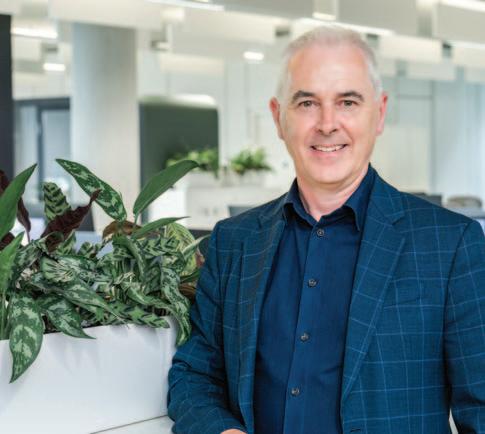
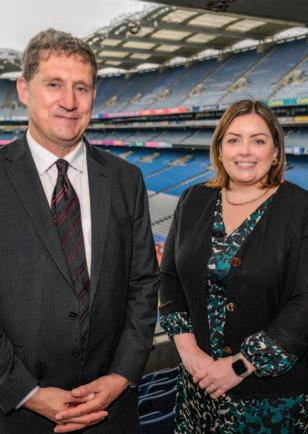


04 08 08 Issues 08 DPENDR Minister Paschal Donohoe TD outlines progress being made on the National Development Plan 12 Cover story: GNI’s Cathal Marley on enabling the energy transition 18 Round table discussion: A macro view of Ireland’s decade of infrastructure delivery 24 The HSE’s National Director of Procurement John Swords on four decades of delivery 38 Housing deficit requires emergency action 41 Digital Events Publications 04 Matters arising 07 Cúpla focal 41 Transport 42 Transport Minister Eamon Ryan TD outlines a new approach to transport 46 The IEA’s Shane McDonagh discusses transport in a net zero future 52 Moving Together: Demand management 56 Transport and Environment’s Lucien Mattieu discusses Europe’s EV slowdown 80 The Department of Transport’s Caoimhín Ó Ciaruáin outlines the development of alternative fuel infrastructure 12 contents Hosted by Sponsored by 16
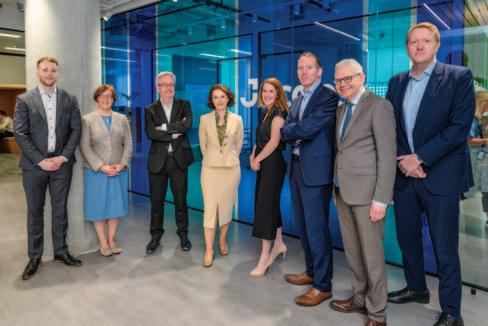



87 Future of policing
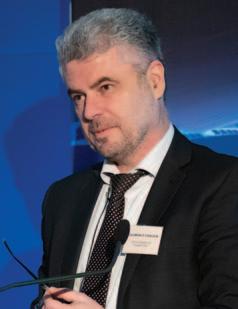


Sponsored by

88 Minister Helen McEntee TD on new policing legislation
98 Policing, Security and Community Safety Act 2024
100 Assistant Commissioner Justin Kelly on policing organised and serious crime
Sponsored by
108 Government CIO Barry Lowry on the challenges and opportunities of Web 3.0
112 The National Cyber Security Centre’s Brendan Ring on strengthening Ireland’s cyber resilience
128 The State of the Digital Decade
132 Kristian Vengsgaard offers a Danish perspective on world leading public services
Europe
154 European Commissioner for Energy Kadri Simson on a sustainable energy future
156 European elections 2024 initial glance
160 Safeguarding and future-proofing democracy
162 Local election results 2024
166 DCU’s John Doyle: The fiscal position in the early years of a united Ireland
168 From college dropout to Taoiseach: Simon Harris TD
176 Back Page: Palestinian Ambassador: The people of Ireland see us

100
87
103 Digital government
103 153
153 160 Public affairs
160 108 154 80 18
An Garda Síochána Ireland’s NaƼonal Police and Security Service
88
arising

New Dublin City Taskforce announced

The Taoiseach has appointed a new taskforce to take a holistic approach in rejuvenating Dublin city centre, aiming to make the area a “more thriving, attractive and safe cityscape; and a desirable location to live, work, do business and visit”.
Aiming to make recommendations within a 12-week timeframe, the high-level taskforce will take full account of existing initiatives such as Dublin’s North East Inner City Initiative and the Dublin North Inner City Local Community Safety Partnership.

Comprising of 12 members, the Independent Chair of the Taskforce will include David McRedmond, CEO of An Post. Other members will include those within the public service, business and trade union representatives, community and service representatives as well as cultural and art providers.
Speaking at the launch, Taoiseach, Simon Harris TD, said: “I very much look forward to receiving the Taskforce’s report and recommendations to return Dublin’s city centre to the vibrant, safe destination we all want it to be.”
HEALTH
Irish National ICU Audit states system is
‘under
pressure’
The Irish National ICU Audit states that the system is under pressure due to a shortage of ICU beds. Despite these pressures, most measures of quality of care, including mortality, remain within the expected range.
The sixth national report documented 11,008 admissions of 10,423 patients to 26 adult Intensive Care Units (ICUs) and High Dependency Units (HDUs) in 22 hospitals during 2022.
This report echoes that ICUs continue to have high levels of bed occupancy and illness severity. Furthermore, there has been an increase in the number of individual units with measures of ‘quality indicators’, outside the expected range.
Key findings include the average length of stay was 6.2 days. Additionally, the delays in discharge have increased with 27 per cent of patients spending more than 24 hours waiting for a ward bed for discharge from ICU.
Barbara Egan, Patient and Public Interest Representative for the Irish National ICU Audit Governance Committee stated: “In 2022, 29 per cent of transfers occurred at weekends and bank holidays, up 3 per cent from the 2021 report. Much needed staff have to leave the unit to assist with transfer, this means a depleted staff number on the unit and this impacts patient care and leaves staff overburdened once again.”
ISSUES matters
4 eolas matters
Credit: Douglas O’Connor.

New penalties in Lobbying Act
The Regulation of Lobbying and Oireachtas (Allowances to Members) (Amendment) Act 2023, aimed at former ministers, political advisers and proscribed public servants states that failure to comply with the post term employment “cooling off” period could result in a penalty of €25,000 and a ban on lobbying.

• Making failure to comply with section 22 cooling-off provisions a ‘relevant contravention’, bringing civil and administrative sanctions operated by SIPO, such as cautions, monetary penalties up to €25,000, and lobbying prohibitions up to two years.
The Minister for Public Expenditure, NDP Delivery and Reform, Paschal Donohoe TD, has signed the commencement order for the 2023 Act, which aims to “build on the existing strong legislative foundation and further strengthen Ireland’s lobbying laws, thus ensuring that the regulation of lobbying framework remains up to date and fit for purpose”.
Effective from 1 June 2024, key provisions include:
• Introducing a ‘relevant contravention’ for actions aimed at avoiding registration or submission of lobbying returns to the Standards in Public Office (SIPO) commission.
Minister Donohoe said: “I believe that lobbying is a vital component in maintaining a healthy and well-functioning democracy.
“However, transparency around this lobbying activity is critically important to allow citizens to follow the activities and potential influence of interest groups, representative bodies and industry and civil society organisations on policy and funding discussions and decisions.”

Homelessness in Ireland has risen by 14 per cent in the past 12 months.
Latest data published by the Department of Housing in April 2024 has found that 14,009 people were recorded as being homeless; including 9,803 adults and 4,206 children in emergency accommodation.
Comparing monthly, the data states that there are 15 more families homeless in April and 59 total children homeless compared to March 2024.
Responding on RTÉ’s Prime Time, Housing Minister Darragh O’Brien TD said the biggest challenge was assisting those with no home and who are in emergency
Homelessness numbers surpass
14,000
accommodation, and that the key of resolving the crisis was increasing housing supply.
“We have seen significant increases in the numbers of households prevented from entering and assisted in exiting emergency accommodation in Q1 this year, but we know that the reasons people present are varied and complex,” he said.
Labour leader Ivana Bacik TD states that the figures offer “just a glimpse” into the true scale of the housing crisis and stated that sky-high rents, inadequate legal protections for renters, and personal circumstances such as domestic violence had made the lives of people precarious.
PUBLIC AFFAIRS HOUSING matters arising 5 eolas matters

Commencement of €102 billion commitment to Narrow Water Bridge
Construction work on a cross-border bridge between County Down and County Louth, as part of the Shared Island Fund, has been welcomed by ministers north and south.

Taoiseach Simon Harris TD, Tánaiste Micheál Martin TD, and Minister Malcolm Noonan visited the site of the Narrow Water Bridge, joined by Northern Ireland Minister for Infrastructure John O’Dowd MLA.
Narrow Water Bridge is a commitment of the Government within the Programme for Government and the northern Executive’s New Decade, New Approach agreement.
The 195m cable-stayed bridge will connect Cornamucklagh, County Louth with Narrow Water, County Down, providing a direct link between the Mourne Mountains and the Cooley Peninsula. Designed for vehicular, cycle, and pedestrian traffic, it will connect the A2 Newry to Warrenpoint dual carriageway
with the R173 Omeath. It will also have the ability to open to allow for the passage of ships through and on to the Newry Canal.
Taoiseach Harris said: “The Shared Island Unit was set up by the coalition for this very reason – to bring about visionary projects for the whole island that had long been sought after but not yet realised…The mountains meet the sea all along this stretch of stunning coastline and this bridge will be a gamechanger for commerce, daily life and tourism in this part of our shared island.”
Minister O’Dowd added: “The bridge will provide a poignant symbol of connection between the north and south. It will play its part connecting communities on both sides of Carlingford Lough and in doing so it will create opportunities for local tourism, as well as the local economy by providing an increase in visitor footfall and employment levels.”
New Framework to deliver national ‘climate resilience’
Ireland’s second statutory National Adaptation Framework (NAF) outlines the potential impacts of climate on Ireland, along with a “national strategy” to develop “adaption measures”.
The NAF will also require government departments, infrastructure providers and local authorities to prepare a new cycle of adaptation plans for key sectors including agriculture, forestry, biodiversity, transport, flood risk management and tourism – which has
been included for the first time.
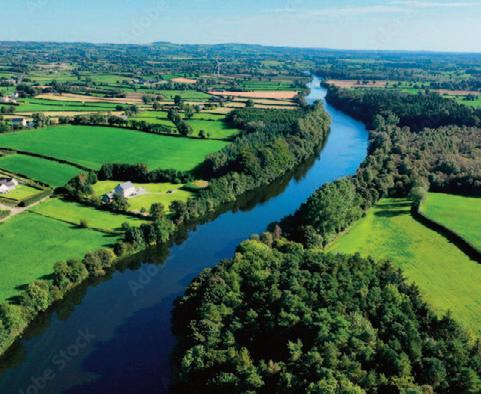
Establishing the new NAF for delivering climate resilience in Ireland, the Framework also takes account of progress made since the first NAF in areas of climate policy, research, sectoral and local adaptation planning, as well as recommendations made in the 2022 NAF review.
The Framework also outlines how the NAF will be implemented, revised
governance and reporting arrangements, and key actions under the Framework.
Minister Ryan stated: “The challenges presented by climate change are unprecedented, both in terms of the potential scale of the impacts and the transformation required to prepare for them… Our response to climate change is not just about dealing with future impacts – we must also be prepared for the here and now and the more immediate challenges that present.”
matters arising
INFRASTRUCTURE 6 eolas matters
ENVIRONMENT

cúpla focal
“You’d almost think there was an election coming up.”
GAA President Jarlath Burns on senior government figures’ remarks on GAAGO.


“I didn’t play camogie growing up to get boxed in.”
An exhilarated Ciara Mageean on her dramatic finish to claim gold at the European Athletics Championships in Rome’s Olympic Stadium.
“Countries like Ireland, with no meaningful hydrocarbon resource have little to lose by moving away from fossil fuels...”
Paul Deane, energy expert, University College Cork
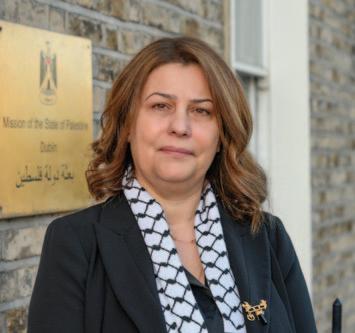

“The recognition by Ireland on the 28 May is a clear and direct message... that the people of Ireland see us.”
Ambassador of the State of Palestine to Ireland, Jilan Wahba Abdalmajid
7 eolas matters eolas cúpla focal
Credit: Sandro Halank

PENDR Minister Paschal Donohoe TD: ‘It’s always
pressure’
Ciarán Galway speaks with Minister for Public Expenditure, NDP Delivery and Reform, and Eurogroup President, Paschal Donohoe TD, about his portfolio, Budget 2025, ambitions, and the approaching general election.
Discussing the priorities of his portfolio, Donohoe identifies three:
1. determining how to “continue to deliver the spending plans that the Government has agreed to inside the parameters that were agreed as part of Budget 2024”;
2. working to deliver the National Development Plan; and
3. identifying the role of technology in better delivering public services.
In April 2024, Tánaiste and Minister for Foreign Affairs, Micheál Martin TD, suggested that some ministerial portfolios are “overloaded” with too many responsibilities.
Donohoe denies that this is a critique that can be applied to the Department of Public Expenditure, NDP Delivery and Reform. “I think the portfolio and work of the Department of Public Expenditure is nearly perfectly apportioned,” he suggests, adding: “Our job is to focus in on spending and public service reform. It is our sole mandate, and it is an essential cog in how the machinery of government turns.”
Better Public Services
One year on from the publication of Better Public Services, the new transformation strategy for the public
service, the Minister indicates that he is most excited about “the progress that I think we are about to make in our Digital Wallet, in how we can bundle public services together and bundle that important information people have about their lives as citizens in a single place”.
“This is going to be a really, really good change,” he predicts.
NDP delivery
Speaking with eolas Magazine earlier in 2024, the Minister said that “the overall level of capital funding is now at an alltime high. In 2024, €13 billion will be made available for investment”. Likewise,


issues eolas 8 eolas issues


“Corporate tax receipts are not falling; they are just not rising with the speed they used to.”
Minister for Public Expenditure, NDP Delivery and Reform, Paschal Donohoe TD
he recently indicated that the updated Project Ireland 2040 Progress Tracker and the updated MyProjectIreland interactive map “demonstrate the many successes we have had in the delivery of the NDP”.
However, in May 2024, comments made by the chair of the National Competitiveness and Productivity Council, Frances Ruane, cast doubt on this progress. “To be globally competitive, your domestic infrastructure must be high quality, well delivered, and predictable… So we need to be globally competitive. And actually, quite frankly, we’re not,” she said, adding: “To me a real worry is the government has signed up to things and they are not delivering. The delivery of the NDP and the speed of the delivery of the NDP is a real problem.”
Asked to respond to these comments, the Minister acknowledges that the views of the National Competitiveness Council “are always listened to and I always find them very helpful”.
“But we are an economy at full employment, we are an economy that has capacity constraints, and that is a pretty significant factor in the challenges that we have had in the pace of delivering the NDP. That is a challenge which is very difficult for any government to try to quickly change,” he adds.
Asked how government intends to address the challenges highlighted by Ruane, Donohoe indicates that there are two particular pieces of work.
“The first one is the changes that the Oversight Board of the National Development Plan have made, changes that we have made in relation to the Public Spending Code, changes that we have made in terms of looking at the resourcing that is available to organisations like An Bord Pleanála.
“The second significant change that we have made is the allocation out of €2.25 billion for this year [2024], and the next two years, to ensure that government departments have adequate funding in place to deal with the impact that
higher levels of inflation have had on important capital projects,” he says.
Stability Programme Update
In April 2024, Donohoe published Stability Programme Update (SPU) 2024 alongside Minister for Finance, Michael McGrath TD. Asked what role the SPU plays in the budgetary calendar; the Minister indicates that it establishes the baseline for the forthcoming budget.
“It says that if no further decisions were to be made, what is the starting point for Budget 2025 – and of course we are going to make further changes. That is why we will have a Summer Economic Statement and it says that this is the starting point in the journey for delivering next year’s [2025] budget,” he explains.
Commenting on the SPU’s projections, Minister McGrath said: “Available evidence suggests the economy is in reasonably good shape.” Asked to outline his own assessment, Donohoe remarks that he has “a very similar assessment”.
“What it means positively is that we have never had more people at work in Ireland. What it means in a positive way too is the rate of inflation is quickly falling. The difficulties that are there are the challenges that small and medium sized businesses are facing at the moment and the challenges that many employers face in getting the right numbers of people with the right skill level to do work that is important in our economy and our society.
“So, we are in a reasonable condition, but with everything that is going on in the world at the moment, we are in reasonably good shape.”
Anticipating external headwinds
In relation to government’s anticipation of the impact of external headwinds – such as the continuing Russian invasion of Ukraine – on budgeting for public expenditure, Donohoe emphasises the additional funding being
issues eolas 9 eolas issues
4



allocated to the NDP, and the Government’s establishment of the Future Ireland Fund – to help deal with future recognised expenditure pressures – and the Infrastructure, Climate and Nature Fund – to deal with the procyclicality of capital spending.
These national reserve funds are, the Minister says, intended to “ensure that we have the safety nets in place” so that “if and when shocks begin to intensify” the State can “bounce back again”.
Though the Minister for Finance is leading on the Future Ireland Fund and Infrastructure, Climate and Nature Fund Bill 2024, Donohoe indicates that he expects the legislation to be enacted “by the summer [recess]”.
Exchequer figures
Upon publication of Exchequer figures to end-April 2024, the PENDR Minister suggested that current expenditure risks are emerging. Indeed, end-April 2024, current expenditure was at €30.1 billion, or 12.1 per cent (>€3 billion) ahead of the first four months of 2023.
Donohoe acknowledges that “as we began the year [2024], public spending was significantly ahead of what we had planned it to be”. However, addressing the potential challenge for public services, he emphasises that by April, the “positive and good news” is that many government departments had “taken the actions required to bring public spending back into line with our plans”.
“We still have a number of government departments in which we have further work to do, which we will do as the year goes on,” he concedes, adding: “In terms of the challenge that means, the further we are ahead of our budget day plans in any given year, the more difficult it is to do a budget for the following year.
“It means we end up with a smaller surplus. It means we have less money available for new policy decisions next year. I do not want to see either happen and that is why I am working closely with all colleagues in government.”
Corporation tax receipts
Amid potentially reduced corporation tax revenues, following a significant dip in March 2024, departmental spending over profile, and a coming general election, it could be suggested that Donohoe’s control of current spending is under pressure.
“It’s always pressure. It is just the nature of the pressure that changes,” he observes, elaborating: “Corporate tax receipts are not falling; they are just not rising with the speed they used to. They are actually fully in line with our expectations.
“Yes, of course, there is a general election coming up. The people of Ireland will evaluate the performance of this government over the five budgets we have done, not just one. I will be keeping that in mind when doing the budget. We took a sensible approach to the last four
budgets, and I am sure we will do the same for the next.”
Capital underspend
A total of €532 million in capital spending was carried over into Budget 2024 from 2023 across 15 government departments and state bodies, particularly in housing, transport, and health. Asked to account for this, the Minister insists that there is “no underspend anymore”.
“All government departments are ahead of what they spent last year [2023] and will be on profile for this year. Virtually nobody last year – very few government departments – handed back [capital allocations]. The days of big capital underspends are now in the past.”
Budget 2025
In April 2024, Taoiseach Simon Harris TD used his first leader’s speech at the Fine Gael ard fheis to restate his belief that nobody earning below €50,000 should pay the higher rate of income tax.
“Everybody knows that Fine Gael stands for lowering the tax burden,” he proclaimed.
Meanwhile, both the Taoiseach and the Minister’s party colleague, Senator Maria Byrne, Fine Gael’s Seanad Spokesperson on Finance, wryly commented: “It is most welcome to see other Government parties are finally accepting that tax cuts and more money back in people’s pockets is the correct way forward.”
Unfazed by the – relatively early –discourse, Donohoe assesses that “is a regular feature of budgets that there is always lots of speculation. It has just happened slightly earlier in the year than normal”.
Pushed on what citizens can expect in terms from the coalition parties in terms of tax cuts in Budget 2025, the Minister insists that they will “be collaboratively preparing a budget together”.
“It is an inevitable feature, before a budget is done, that there is speculation regarding what is going to be in it. It has been a feature of every single budget that has happened in Ireland that I can remember, and I do not expect it to change this year,” he responds coyly.
issues eolas 10 eolas issues


Ambitions
Asked about his personal ambitions for the remaining lifetime of this government, Donohoe is more forthcoming.
“For the final budget to be a sensible budget that gets the balance right between meeting the needs of today and not creating risks tomorrow. If I have learned anything in politics now, it is that we never know what is around the corner.
“What is around the corner is not always a bad thing, it can sometimes be an opportunity we never considered, and the way to deal with the risks and make the most of the opportunities is to have public finances that are in good condition,” he asserts.
Donohoe’s ambitions beyond the lifetime of this government have been the subject of much speculation. Speaking with schoolchildren in the week before this interview, the Minister had indicated that “earlier in my youth I wanted to be a writer”.
“I have a few books in me,” he says, qualifying: “But I think it will be some time before I get to writing them.”
General election
At the recent Fine Gael ard fheis, former Taoiseach and party leader, Enda Kenny suggested that the coming general election would be “the mother and father of elections”. Discussing the prospect and the durability of his famously positive relationship with Fianna Fáil cabinet colleague, Michael McGrath TD, the Minister speaks with confidence.
“My relationship with Michael McGrath is far deeper than congeniality and I am certain that it will be able to deal with the challenges that later on in the year will bring us.
“This is going to be probably the most important election in my political lifetime, and we will be putting our best foot forward, going into the contest with confidence, and looking forward to making the case. It is still some time away though, and we have plenty to do before we get there,” he says.
Commenting on whether he will stand for re-election, Donohoe responds abruptly: “Yes.”

Excerpts from Minister Donohoe’s speech at Public Services Conference 2024
On Better Public Services:
“This transformation programme will enhance the resilience of the Public Service to face future challenges; apply modern working methods and digital tools; improve evidence-based decision-making; strengthen innovation strategies; improve policymaking and delivery of public services; and increase the capacity and efficiency of the public service.”
On digital government:
“I was pleased to announce earlier this year that Ireland placed in the top 10 of international performers in the 2023 Digital Government Index published by the OECD.
“One of our flagship projects to drive access to innovative digital public services under Better Public Services is the life events programme and the government digital wallet... In collaboration with partners across the public service, this will be further tested and rolled out this year [2024] and I look forward to providing further updates on the launch and roll out.”
On a design-led approach to public service delivery:
“Taking a service design-led approach will help us to innovate, improve, and constantly reimagine how we serve the public. It offers a pathway to a more dynamic, responsive, and people-centric future for Ireland and ensures our solutions are not just technologically sound but also offer
value for money, are socially responsible and contribute to a better society
“My department is leading on work to embed design and other innovative methods to support policy and service development working closely with colleagues across government departments and the wider public service to ensure we use the best available approaches, evidence, research and data to support transformation.”
On artificial intelligence:
“Public service bodies have already begun to use and integrate AI in the development and delivery of their services, in areas such as taxation, social protection, health, and justice.
“The prevalence of AI across a variety of sectors provides an inflection point that allows the public service to take stock, review and reimagine the workforce of the future; one in which technology can become a core delivery partner in transforming and providing better public services for the people of Ireland. Our ability to use AI to its full potential, also relies on the availability and quality of our data.”
Summary:
“I would like to commend the work of civil and public servants who every day strive to do the best job they can to serve all of the people who rely on their services every day. That commitment and public service ethos is key to enabling better public services and our workforce who operate in every sector of the public service is one of our greatest assets.”
issues eolas 11 eolas issues


Enabling the energy transition

Strategy, Gas Networks Ireland Chief Executive Officer (CEO) Cathal Marley speaks with eolas Magazine about his organisation’s centrality to the energy transition, ensuring resilience in the energy system, and embracing the potential of renewable gases.
In 2018, government determined that the two principal subsidiaries of the Ervia Group – Gas Networks Ireland and Uisce Éireann – would be separated into standalone, publicly owned, and commercial utilities. Upon the appointment of a new Gas Networks Ireland executive team in 2022, CEO
Cathal Marley observed that it was the “ideal time to stand back and review our strategy”.
Discussing the strategy, Marley outlines its three core elements: continued performance; enabling the energy transition; and transforming the gas network.
Firstly, the new strategy outlines that Gas Networks Ireland will continue to contribute to Ireland’s energy system, supplying 30 per cent of the State’s overall energy demand, 40 per cent of all heating needs, and an average of up to 50 per cent of total electricity generation.
12 cover story cover story

“As such, Gas Networks Ireland remains at the heart of Ireland’s energy landscape,” the CEO remarks.
Secondly, the strategy recognises Gas Networks Ireland’s role in the energy transition. “Gas-fired power stations are absolutely necessary,” he asserts, adding: “While Gas Networks Ireland does not generate electricity, it connects power stations to the gas grid. As we speak, we are in the process of connecting 10 new gas-fired power stations by the end of the decade.
“In the previous 10 years, we connected a single station. That demonstrates the rapid expansion that is now under way. Gas Networks Ireland is committed to playing its part in ensuring that those new stations are in place. Without them, and in advance of offshore wind energy at scale, the energy transition is not going to happen.”
Thirdly, the strategy is cognisant of the centrality of the gas network to the energy transition and the need to transform it, over the next 20 or 25 years, to carry renewable gases rather than natural gas. “As such, the volumes of biomethane that Gas Networks Ireland will carry will increase exponentially in the next five to 10 years,” he forecasts.
Gas network
Ireland’s only indigenous natural gas supply, the Corrib gas field, currently supplies about 20 per cent of demand, while the remaining 80 per cent of natural gas is imported primarily via the interconnector pipeline at Moffat, Scotland.
Over the next eight years, the supply from Corrib is anticipated to deplete to between 3 per cent and 5 per cent of demand. Biomethane has the potential, therefore, to replace Corrib with an indigenous and renewable source of gas.
Indeed, Gas Networks Ireland anticipates that the target of 5.7TWh of biomethane by 2030 – which is about 10 per cent of Ireland’s gas demand – will be almost tripled to around 14TWh, equating to between 25 per cent and 30 per cent of required gas as natural gas demand reduces.
“Consequently, we are preparing our gas network for that change,” Marley advises, noting: “Ireland’s 14,725km gas network is relatively young, with pipes installed from the mid-1970s onwards. The network is in incredibly good condition relative to our UK or European counterparts.”
“The National Biomethane Strategy is a fantastic starting point.”
Cathal Marley, Chief Executive Officer, Gas Networks Ireland
Emphasising that it is important to distinguish biomethane from hydrogen, the CEO explains that the former is structurally identical to natural gas, whereas “the hydrogen molecule is much smaller”.
“Biomethane is indistinguishable from natural gas, and we do not have to make any adjustments to our natural gas network. We can transport biomethane up to any volume on our natural gas network,” he says.
Biomethane potential
Biomethane is a carbon neutral renewable gas produced from farm and food waste through a process known as anaerobic digestion (AD).
“Recognising the potential of biomethane early on, we were the first people in Ireland to hold discussions about its significance, engaging with partners across Europe, particularly in Denmark,” the CEO outlines.
In September 2023, this culminated in the publication of Gas Networks Ireland’s Biomethane Energy Report which identified 176 expressions of interest for potential biomethane projects equating to around 15TWh of biomethane.
“While we understand that not all of these projects will be delivered, it was an incredible demonstration of the level of interest. Industry was signalling that it is ready to go but also that it needed certainty from government.
“That inspired government to develop the National Biomethane Strategy which in turn demonstrates its commitment to the role that biomethane will play in decarbonising the gas network. Providing an indigenous source of renewable energy, and enhancing Ireland’s energy
security, biomethane will also diversify farm incomes,” he says.
Biomethane strategy
In late May 2024, Minister for the Environment, Climate and Communications, Eamon Ryan TD and the Minister for Agriculture, Food and the Marine, Charlie McConalogue TD announced the publication of Ireland’s National Biomethane Strategy. Focusing on a framework of five interlinking pillars and 25 aligned actions, the strategy is the initial step in delivering as much as 5.7TWh of indigenously produced biomethane by 2030.
Welcoming the publication of the National Biomethane Strategy, and its vision that “Ireland will have developed a sustainable biomethane industry of scale” by 2030, the Gas Networks Ireland CEO’s enthusiasm is evident.
“It is really welcome,” Marley remarks, adding: “We have been working on this for around six years. In fact, we commissioned our initial reports on biomethane back in 2018. These were very comprehensive and not dissimilar to the Government’s strategy.”
Financial supports
Emphasising that a dominant focus for the biomethane industry has been on government’s implementation of the right financial supports to stimulate development. Marley outlines the three possible levers open to government.
“The first is capital support to help AD producers to build plant. Given the number of AD plants required to achieve the 2030 targets, this is a relatively small amount of money, around €40 million, but government has indicated that this is only the beginning.
13 eolas issues 13 agenda issues cover story 4 cover story


“The second lever is an obligation on end-users to receive renewable gas. This will increase over time up to 10 per cent of their usage.
“The final lever, which has not been used, is a feed-in tariff which would guarantee AD producers a price for their renewable gas. Often such a tariff is necessary to enable banks to finance investment in the renewable energy industry and as such it may be implemented in the future. That is what has been deployed to pronounced effect in Denmark, for instance, accelerating the development of the biomethane industry there,” he clarifies.
Overall, from Gas Networks Ireland’s perspective, “the National Biomethane Strategy is a fantastic starting point” with government “exhibiting clear commitment” against an ambitious delivery target.
Gas Networks Ireland’s role
Equipped with an unrivalled expertise and knowledge of transporting gas, Gas Networks Ireland’s role in achieving the Government’s vision for biomethane is delivering connections to ensure that renewable gas can be transported to wherever it needs to go.
Having already connected Ireland’s first renewable gas central grid injection (CGI) in Cush, County Kildare, Gas Networks Ireland is now developing a larger CGI facility in Mitchelstown, County Cork, which will be entering construction by the end of 2024 and commissioned in early 2025.
“In 2019, Gas Networks Ireland successfully injected indigenous biomethane into the gas network at the first purpose-built facility in Cush. While it is a relatively small volume, equating to less than 1 per cent of Ireland’s total gas supply, we have treated it as a pilot project, demonstrating our expertise.
“We have learnt a huge amount from that in terms of control and quality. By the end of 2024, we will also have 10 larger plants directly connected into the network, equating to 12 per cent of the 5.7TWh target set by government,” Marley illustrates.
EU exemplars
Elsewhere across the EU, there are around 1,300 biomethane plants in operation. Biomethane industries are burgeoning across France, the Netherlands, and in Denmark, where close to 40 per cent of gas consumed is biomethane.
“In the last year, Gas Networks Ireland has organised three trips to visit to biomethane stakeholders, including a major biomethane plant in Denmark. The first included our own staff, the second brought together policymakers, and the third delegation will comprise industry customers. The rationale is to develop a comprehensive understanding of how biomethane works elsewhere,” Marley explains.
Green hydrogen potential
Alongside biomethane, the transition to renewable gases will be accompanied by
green hydrogen. Identifying the potential for green hydrogen in Ireland as being “very significant”, the Gas Networks Ireland CEO makes two observations.
“Firstly, unlocking Ireland’s hydrogen potential hinges on the speed at which offshore wind energy capacity is developed. We will require a significant amount of offshore wind energy to produce adequate volumes of hydrogen; multiples of what is required to meet our electricity demand. I think that will happen, but it will take time,” he says.
“Secondly, once hydrogen is being produced in an adequate volume, it must then be stored. Surplus renewable energy from offshore wind will be converted to hydrogen, stored, and then used in power stations – to generate electricity at times when there is now wind – and/or directed to high-heat industry which cannot be electrified because it requires high-density energy. Another potential use is in HGVs that cannot be electrified.”
However, while fully cognisant of the potential of green hydrogen, the CEO has doubts on “the speed at which it can be delivered”. In a scenario where Ireland does not produce enough indigenous green hydrogen in the immediate future, he emphasises interconnection with the Britain where “they may be moving faster on hydrogen production”.
“In Britain, National Gas is set to begin blending volumes of hydrogen – up to 2 per cent – into its network in the next five years. As such, I anticipate that the first hydrogen in Ireland will be delivered via the interconnectors rather than offshore
14 cover story
cover story

wind. Gas Networks Ireland must ensure that our interconnectors and our network can carry up to 2 per cent hydrogen,” Marley insists.
Blending
Acknowledging that a Gas Networks Ireland technical and safety feasibility study that determined transporting blends of hydrogen and natural gas via the gas network was both safe and feasible, the National Hydrogen Strategy recognises that “blending may offer an initial demand sink in the short term”. Notably, however, it concludes: “Overall, blending is not seen as a high priority end-use for renewable hydrogen.”
The end-use for green hydrogen, Marley acknowledges, is not blending for industries or in residential heating which can be electrified. Instead, blending will be a transitional end-use.
“We have been fully aligned with that, so there are no surprises there. However, the National Hydrogen Strategy also recognises that hydrogen must be blended initially, during a transitional period. This transitional period is undefined. However, until significant volumes of green hydrogen are produced, hydrogen is likely to be blended with natural gas in the gas network.
“The Hydrogen Strategy also recognises that the gas network is the optimal infrastructure for transporting green hydrogen around the country. Similarly, if in the long term, we produce surplus volumes of hydrogen, the gas network can enable green hydrogen export to European markets via a repurposed interconnector.”
Collaboration
In anticipation of hydrogen being imported into the Irish network, Gas Networks Ireland is investing enormous resource into ensuring the feasibility of safely transporting these hydrogen/natural gas blends.
Working in collaboration with third-level institutions, such as University College Dublin and Ulster University, Gas Networks Ireland is seeking to ensure that there are several programmes in place to enable the network to safely carry hydrogen up to blends of 20 per cent.
On top of this, Gas Networks Ireland is working alongside other energy companies to develop the Celtic Hydrogen Cluster in east Cork to demonstrate end-use and stimulate the development of a hydrogen valley.
“The Celtic Hydrogen Cluster is designed to leverage the existing concentration of energy producers and consumers in close proximity to an existing natural gas network. In essence, it is small-scale model of Ireland.
“We are working with other to demonstrate the viability of hydrogen across a complete value chain. It is a really important project, and it is the beginning of what must happen at scale; collaboration across energy companies.”
Resilience
As Ireland unlocks the potential of zero carbon gases, such as biomethane and green hydrogen, the role of the natural gas network will shift.
Today, Gas Networks Ireland supplies significant amounts of gas equating to 50 per cent of power generation. However, in time, increasing renewable generation capacity will come on stream.
“Given the intermittency of weather dependant renewable energy, Gas Networks Ireland role will increasingly shift to transporting gas when the sun does not shine and the wind does now blow, thereby enabling the energy transition and ensuring the continued resilience for the Irish energy system.
“Over the next 20 years, and beyond, there will be a transition to increasing renewable electricity with gas as a backup. Following that, renewable electricity will be used to generate green hydrogen which will in turn begin to
displace the need for natural gas. Meanwhile, biomethane will emerge as a significant contributor to the energy mix over the next five years,” Marley articulates.
Ultimately, this will unlock an enhanced energy mix, with increasing renewable electricity, the introduction of biomethane, a gradual reduction in natural gas, and the gradual introduction of hydrogen.
Eventually, it is expected that biomethane and hydrogen will assume the backup role currently played by natural gas amid greatly increased electrification. There is speculation as to how quickly this will happen and the final composition of that energy mix.
“If I was to predict what will happen over the next 15 years, there will be increasing renewable electricity, a relatively small amount of green hydrogen, an acceleration of biomethane, and still a fair proportion of natural gas,” Marley summarises.
“At some point in the future,” the CEO projects, “possibly by 2050, there will be a tipping point whereby zero carbon gases accelerate to the point whereby hydrogen and biomethane accelerate to the point where the reducing amount of natural gas required to support the energy system will be completely renewable.
“Gas Networks Ireland’s future role is assured in that we will be transporting biomethane and hydrogen instead of natural gas. Once natural gas is totally displaced, it is possible that we will split our networks into a hydrogen network and a separate, dedicated network for biomethane. Our vision, therefore, is defined by a continued need for the gas network, though it will undertake a different role, with different gases,” he concludes.
Profile: Cathal Marley, Chief Executive Officer

Cathal Marley is the Chief Executive Officer of Gas Networks Ireland, the semi-state organisation responsible for operating Ireland’s €2.8 billion, 14,725km national gas network, serving over 720,000 customers nationwide. He has over 20 years’ experience in the utilities and infrastructure sector, having previously worked in senior roles across the electricity and water industries.
15 eolas issues
15 cover story
cover story

















Ministers outline visions for Ireland’s energy future
Energy ministers –
north
and
south
– have
outlined their visions
for achieving a sustainable energy system with a prominent all-island dimension.
Speaking at the Energy Ireland Conference in late May 2024, Minister Ryan warns that climate indicators point to “a truly frightening time in the world”, adding that global temperatures have risen in a manner “higher than predicted”.
“The tipping points about which we have been concerned are looming even larger than they ever did before,” he states.
As part of its response, Ireland must pursue a renewable energy system and transform its power supply.
“It is cheaper, it is ubiquitous, and all the technological innovation and advancement is going in the direction towards an electrified, balancing, and renewable system,” he explains.
Ryan announced the Small-Scale Renewable Electricity Support Scheme at the Energy Ireland Conference, which he believes will expand renewable generation options for small businesses and local communities, as well as present an


issues eolas 16 eolas issues


opportunity for decarbonisation in the agricultural sector.
“We want to broaden the energy revolution so that it feeds into every village, parish, and community right across this country so there is ownership of the change which is coming,” he states.
Energy efficiency in Ireland
Ryan believes that there are two branches which enable a sustainable energy system: energy efficiency and renewable generation, both of which must be underpinned by public buy-in.
Emphasising the importance of the Government’s retrofit programme in enhancing energy efficiency of buildings, Ryan characterises the SEAI retrofit scheme, supported by government, as “probably the best in class across the EU”.
He also explains that the carbon tax has proved “hugely beneficial” because one-third of the revenue generated being earmarked for social welfare spending. 55 per cent of the revenue generated also goes to retrofitting spending which, Ryan asserts, “gives the industry real confidence that the funding is going to be there and it will continue to expand”.
On wider efficiency measures, Ryan acknowledges that there are key developments which must be enhanced in the Climate Action Plan, including accelerating the introduction of district heating.
“We need to scale district heating up at speed, and more broadly we need to see the much wider introduction of heat pumps both domestically and in commercial buildings, and with industrial heat,” he says.
Ryan states that the Government’s sustainability measures will survive in the long term as they are entrenched by the supernational regulation and are part of a shared endeavour.
Generation
The Minister believes that Ireland must capitalise on its competitive advantage in the development of renewable power.
He characterises the State’s 2030 targets for renewable energy generation as the ‘seven, eight, nine’ model: 7GW of offshore wind generation – of which 2GW is earmarked for the production of green hydrogen; 8GW of solar; and 9GW of onshore wind.
The rollout of solar energy, which Ryan highlights was “seen as impossible” by key industry figures when initially outlined, is now a “revolution” which “is now really taking hold in our energy system”, according to the Minister.
Ryan states that the key to acceleration of the rollout of solar and onshore wind is with the passage of the Planning and Development Bill 2023.
Acknowledging critiques expressed by industry leaders about the complexity of the Bill, he nonetheless states that it is needed to “realise our vision of a planning system which does not get projects stuck in expensive, litigious processes”.
On offshore wind, Ryan says that although Ireland is seen as being “late to the party” when compared to the expansive construction across Europe, there is “broad recognition in Europe that the Irish approach is now probably one of the best, most consistent, most predictable approaches in line with achieving offshore wind generation targets”.
Bringing these initiatives to local communities, Ryan believes, is dependent on an all-island grid: “It will not work if we have two energy systems on this island. It has to be all-island and that is what we are committed to in the remaining nine months of this government’s term, and we will keep going after that,” he concludes.

Minister for the Economy, Northern Ireland Executive
Minister Ryan was joined by the North’s then-Minister for the Economy, Deirdre Hargey MLA, who became the first northern energy minister to accept an invitation to address and jointly launch the Energy Ireland Conference in its 28 years of existence.
Hargey called for an end to the “injustice of energy poverty” and emphasised the need for more allisland collaboration on meeting the decarbonisation targets, a vision shared by her southern counterpart, Eamon Ryan TD.
“As a small region, the North is already leveraging our strengths in innovative engineering and advanced manufacturing alongside capitalising on our unique dualmarket access to deliver low and zero carbon solutions that are in global demand. The solutions this island needs to deliver net zero are the solutions that the rest of the world needs too. It only takes a tiny proportion of this global market opportunity to deliver significant prosperity for citizens across Ireland.”











Hargey concluded by committing to work in partnership with “Minister Ryan, government, business, and academia across the island on the investments needed to realise our renewable energy aspirations so that the whole island can be a beacon in the delivery of net zero”.




















issues eolas 17 eolas issues
A macro view of Ireland’s decade of infrastructure delivery
Jacobs hosted a round table discussion with key critical infrastructure providers from across several economic sectors to explore their perspectives on Ireland’s decade of infrastructure delivery against a backdrop of relatively high economic development, a tight labour market, and ambitious national climate objectives.
How can infrastructure delivery keep pace with Ireland’s ambitions for economic development?
Richard Sanderson
From Jacobs’ perspective, we understand the challenge through two lenses: the need to have the infrastructure in place to attract foreign direct investment in the first instance alongside the need to develop critical infrastructure to meet the demands of a growing economy. Infrastructure delivery requires three things: people, planning, and pipeline. Firstly, while the talent that we have in Ireland is extraordinary, we are at virtually full employment, so ensuring a strong talent pipeline and
leveraging technology to support delivery is vital to us. Secondly, we must streamline the planning process, improve consenting, and deliver infrastructure as quickly as possible. Finally, regarding pipeline, a government commitment to an ambitious capital programme in the coming decades provides certainty for Jacobs and others to invest and provide adequate capacity alongside colleagues elsewhere in our industry.
Anne Graham
In terms of Ireland’s ambition, it is absolutely crucial that the development of infrastructure is linked to economic development and to ensure that we have a good quality of life for all. The delivery of high quality local, regional, and
Round table discussion hosted by



international connectivity will be key to ensuring that Ireland is an attractive investment proposition for both internal and external markets. Sustainable transport plays a key role across all tiers of the economy and driving lower costs in delivery is vital. Public transport initiatives are key to the sustainable delivery of infrastructure and wider development, including in housing and employment. We must also recognise that we have recently experienced a decade of nondelivery so we must sustain the pace of delivery, not just in this decade, but into the future to ensure our infrastructure catches up with our economy.
Dearbhla Lawson
In supporting our ambitions, the provision of sustainable and affordable housing is a critical social and economic infrastructure that is not just an enabler of growth, but necessary for continued cohesion and prosperity. Housing is fundamental in relation to Maslow’s Hierarchy of Needs and important to plan for this as a priority as necessary infrastructure. The LDA is well placed to support with addressing
round table discussion
18
key challenges, through building up the pipeline, optimising state lands in the right locations and developing on private lands in the near term to deliver housing to meet the growing needs. Ireland is to continue to be an attractive destination for economic growth and future investment; the provision of affordable and social housing supply is critical to support our ambitions, wellbeing, and quality of life for all.
Following a period of unparalleled economic growth over several years now – one of the highest rates of economic growth in Europe – we need to be optimistic and ambitious about the future to ensure that infrastructure supports our future sustainable growth ambitions. From the Land Development Agency perspective, there is an opportunity now, through the review of the National Planning Framework to take a more holistic and coordinated approach to planning for infrastructure delivery to support the extent and pace of growth.
Michael Mahon
We cannot plan in isolation. From a housing perspective, an electricity connection is required and EirGrid and ESB are critical to that. Similarly, for transport, projects such as MetroLink and DART+ West have a huge requirement in terms of electricity. As such, stakeholders must work together and understand what is needed and when. We must align our delivery objectives. We have always looked at 2030 as being a key target year for delivery, but the time between now and the beginning of 2030 is less than 300 weeks. We must seek to understand what each other’s ambitions are now and then work backwards from there.
Nigel O’Neill
From a TII perspective, the consenting infrastructure is crucial. By that I mean the State’s exercise of its power in regulatory activity; providing planning permissions for capital projects. In recent years, that has been a bottleneck. Between 2000 and 2010, the project lifecycle for the major interurbans corridors – totalling around 750km of motorway – was around eight years. Today, the lifecycle of equivalent projects would be 15 years. It still takes the same amount of time to design, procure, and build, processes which are now the safest and least risky aspects of what we do. However, the planning stage is taking too much time. The NDP review is an opportunity to reevaluate where the State wants to be in 2030.


Round table participants
Anne Graham
Anne Graham is Chief Executive Officer with the National Transport Authority (NTA). The NTA is responsible for the provision, regulation and integration of public transport services, the provision of supporting infrastructure for sustainable transport and for driving the greater use of sustainable transport as a mode of choice. She previously worked with the NTA as Director of Public Transport Services on the regulation and provision of public transport services nationally. Prior to joining the NTA, she worked in the Dublin local authorities as a chartered civil engineer in the drainage, roads, and traffic divisions.
Dearbhla Lawson





Dearbhla Lawson is an experienced strategic planner who leads the Land Development Agency’s (LDA) planning, public lands, and sustainability function, working with partners to optimise state land usage, build the pipeline, and progress plans to regenerate and deliver compact and sustainable growth. Prior to her current role, Dearbhla worked in public and private sector roles most recently as Director of Services with Dún Laoghaire-Rathdown County Council and before this as Head of Transport and infrastructure and Strategic Planning with Cambridgeshire County Council.
Michael Mahon
Michael Mahon is Chief Infrastructure Officer with EirGrid. Having joined EirGrid Group in August 2019, Michael is responsible for planning and consents for grid infrastructure across the island, including public consultation processes and landowner engagement. Michael previously held the position of General Manager, ESB Smart Energy Services. Michael has 20 years’ experience with ESB, with significant leadership experience in major project delivery.
Nigel O’Neill
Nigel O’Neill is Director of Capital Programme with Transport Infrastructure Ireland. Nigel is a chartered engineer and member of the Institution of Engineers of Ireland. Nigel has more than 30 years’ experience in the private and public sectors including civil engineering, project management, public procurement, strategic transport planning, Public Private Partnerships (PPP), tolling operations, and light railway operations.
Peter O’Shea
Peter O’Shea was appointed Head of ESB Corporate and Regulatory Affairs in 2018. Prior to this, Peter was Head of Regulatory Affairs and Corporate Strategy at ESB. He is Chairman of the Electricity Association of Ireland and an advisory board member with the International Energy Research Center at the Tyndall Institute and former board member and president of the British Irish Chamber of Commerce. Before joining ESB in 1999, Peter spent 12 years working with the CEGB and National Grid Company in the UK in a range of technical and commercial roles, including programme manager for the development of the new electricity trading arrangements.

Richard Sanderson
Richard is the Head of Jacobs' Transportation Operations in Europe, responsible for 1,500 colleagues and projects across the highways, rail and aviation sectors. A transport planner by background, Richard has over 25 years’ experience in the appraisal and evaluation of transport infrastructure projects. Working for public and private sector clients, across transportation modes, he has worked in Australia, North America, Europe, the Middle East, and South East Asia.
round table discussion
4 19

“Staff retention is just as important as recruitment, and demonstrating our purpose is very important to our workforce...” Dearbhla Lawson
Peter O’Shea
Economic development is fundamentally dependent on infrastructure; it is not simply about keeping pace. Planning and people are important, and alongside those I would add capital and incentives to ensure that we get the right people, engagement, and plans in place to deliver. In the energy sector, there has been huge delivery in the decade. From a virtual standing start in 2010 to 2020, 40 per cent of all electricity consumed in Ireland is now renewable and that requires grid systems and generation systems. It has been a huge challenge and a huge success. However, the wind does not blow every day and the sun does not shine every day, so we need more. ESB is planning on the basis that between now and 2040, electricity demand will double. The fundamental principle that we must change is that until now, the electricity system has been planned on a demand-following basis. We must move to demand-leading and get ahead of it.
In a challenging labour market, how is your organisation seeking to ensure adequate skills capacity for delivery?
Peter O’Shea
In the immediate term, ESB has recruited almost 1,000 people over the last 18 months against a base of between 8,000


and 9,000. Central to this recruitment has been establishing ESB as an organisation with a very clear purpose. People prefer to work for organisations that have a purpose. ESB’s purpose is totally aligned with responding to the challenge of climate change.
In the long term, we have an initiative called ESB Science Blast which is a noncompetitive education programme for primary schools aimed at encouraging whole-class science investigations to pique the scientific curiosity among many children. It is hoped that some of these children will then embark on 10, 15, or 20-year journeys contributing to engineering competence in Ireland.
Michael Mahon
Partnership is key. The days of having all the expertise in a single organisation are gone. We must be open to bringing partners into an organisation and not distinguishing between those who are paid, for example, by EirGrid, and those who are paid by someone else. That has worked very well within the infrastructure team in EirGrid where we have increased our numbers from 80 to 240 in 18 months. Much of this increase has been delivered through partnership. The challenge now is retaining this new talent. This links in with Peter’s emphasis on purpose; the answer to why we do what we do.
Dearbhla Lawson
As a relatively new organisation, the Land Development Agency established in statute in 2021, has grown from a workforce of 10 to 150 over the last four years and is set to double in size again as we deliver on our mandate. In this regard, staff retention is just as important as recruitment, and demonstrating our purpose is very important to our workforce: delivering affordable homes and creating sustainable communities. That resonates very strongly with colleagues coming into the organisation, as does the strategy and LDA’s business plan which demonstrates our commitment and pipeline for delivery for the next four years of around 14,000 affordable and social homes. The breath of work that the agency does is also attractive, as is the collaboration and opportunities to innovate which is important for us. In terms of partnership working, we work closely with stakeholders, such as local authorities,
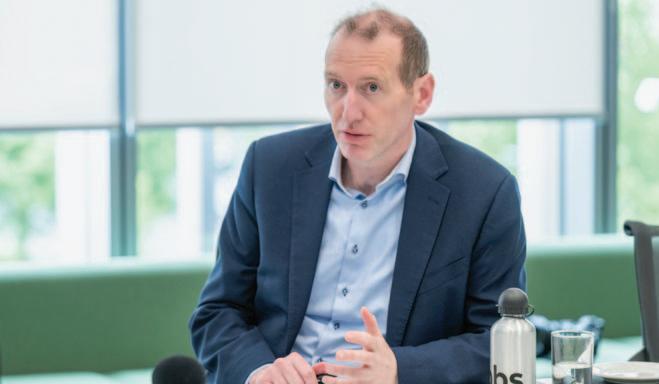
“There must be enhanced cohesion between infrastructure delivery partners.” Michael Mahon
round table discussion
20
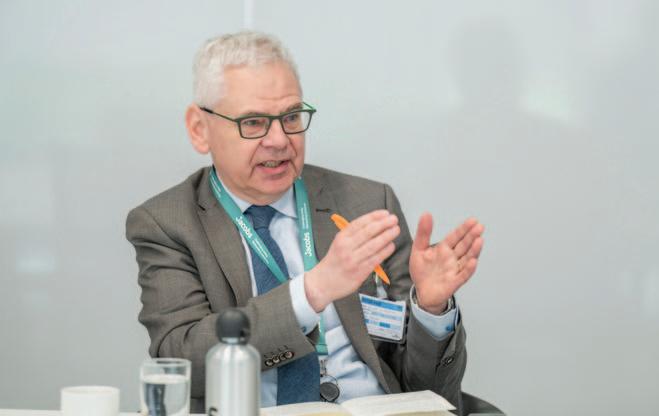
“The NDP review is an opportunity to reevaluate where the State wants to be in 2030.”
Nigel O’Neill
state agencies, utilities and the development industry including ConstructInnovate whom we partner with, Ireland's national construction technology centre, to explore opportunities to innovate and trial efficiencies through digitalisation and modern methods of construction.
Anne Graham
A pipeline of projects is crucial to talent retention as well as the retention of good client partners. The NTA has operated a partnership model since its establishment during the economic crisis when it was limited in its direct employment scope. We have always sought strong partnerships – including consultants and designers – to assist us in developing our programme. Now, we are engaging with government and public sector bodies to identify opportunities for the development of skills. For instance, in April 2024, we launched our first graduate programme to recruit new talent that will grow with us. The NTA is fortunate in that its purpose and values resonate with many young people in terms of active travel and enhanced mobility. This means that we are an attractive employer.
Richard Sanderson
Graduate development and apprenticeships are crucial for Jacobs. Many of the skills we will require in the future are very different from traditional demand. Jacobs’ global footprint also offers access to expertise from around the world to work with our local teams. Elsewhere, including in the UK, we are now focusing on reskilling long-term staff who have spent a decade focused on, for

example, highway construction. We are providing them with new purpose to ensure that we have the skills to meet future demand, for instance, in the delivery of water and energy infrastructure.
Nigel O’Neill
TII has 293 people within its organisation. We oversee national roads, greenways, and Luas on behalf of the NTA. In our overall ecosystem, there are around 3,000 people. That figure fluctuates depending on the number of construction projects underway. However, there is a wider challenge. I am in contact with the heads of schools of engineering across the colleges and anecdotally, there are fewer people undertaking civil engineering courses. There has been a withdrawal on behalf of the State away from investment in large civil engineering projects. I am optimistic about the second half of the NDP, but the reality is that parents and young people have received a signal that the State has deprioritised investment in certain types of infrastructure. The message I have for senior civil servants is that there is a need for stability in policy-making; please do not assume that civil infrastructure is a cost that can be switched off and switched on again after five years; the skills must be continuously cultivated and nurtured.
What have the recently published Infrastructure Guidelines meant for the delivery of capital projects?
Anne Graham
The Infrastructure Guidelines have led to
a more streamlined approach to government approval of major capital projects by introducing the mandatory €200 million threshold and reducing requirements for certain approval rates. Under the Public Spending Code, we experienced approval waiting times of up to 18 months for preliminary business cases. It is still too early to say whether the Infrastructure Guidelines will address that.
Michael Mahon
The Infrastructure Guidelines are complementary to what we are already doing as a regulated body. There are a lot of aspects which will enable streamlining, but the Infrastructure Guidelines will also introduce other elements, such as project assurance, which will be beneficial.
Dearbhla Lawson
We welcome the streamlined support access and approval gateways. The LDA has its own approval system which aligns with the principles of the Public Spending Code and as such the Infrastructure Guidelines. While the guidelines bring certainty regarding the approval gateways and criteria, it would be helpful to have clarity regarding the key infrastructure projects on the horizon needed to support major housing and economic growth projects for example. I would love to see outcomes-focused approach to infrastructure prioritisation projects, considering the wider socioeconomic benefits for projects support Policy priorities such as affordable and social housing. We must rethink planning in respect of long-term sustainability, and low carbon development and not just in terms of the hard infrastructure but also nature-based options including the green and blue infrastructure projects.
Nigel O’Neill
The Infrastructure Guidelines raise the threshold from the Public Spending Code figure of €100 million to €200 million, which is welcome. However, even one of our big national infrastructure projects alone far exceeds these figures. Overall, it gives me the impression of more control being leveraged on something which is viewed as a cost, and not enough focus on benefits. What we need is professionalisation and cooperation between the public and private sectors if we are to push forward.
Peter O’Shea
We must focus on the realisation of 4

round table discussion 21

“Jacobs’ global footprint also offers access to expertise from around the world to work with our local teams.” Richard Sanderson
benefits that infrastructure projects can bring because this is a major driver catalysing delivery in respect of shared outcomes.
Richard Sanderson
The Infrastructure Guidelines provide welcome detail on construction productivity as well as climate and environmental performance. The independent review mechanism may slow things down to an extent, but it is also an important feature and the way it has been formatted is excellent. However, it will be a missed opportunity if the Infrastructure Guidelines do not resolve planning delays.
What are the most significant trends emerging in infrastructure delivery?
Michael Mahon
There must be enhanced cohesion between infrastructure delivery partners. If we work in isolation, then progress in infrastructure delivery will grind to a halt. Communication is key to maintaining momentum; it is about every person involved in the project understanding the rationale behind a project as well as the benefits it unlocks for the State and its people. If you understand and communicate the ‘why’, then it is much easier to engage wider society on that journey.

 Dearbhla Lawson
Dearbhla Lawson
Taking a low-carbon development and sustainability approach is necessary to achieve our vision for the future. The Land Development Agency’s purpose is to maximise the support of affordable and social homes in a financially sustainable manner supporting community development and positive social impact. One way we do this is looking at how we can best optimise underutilised brownfield public land, where the State has already invested in infrastructure and services and there is potential to deliver affordable and low carbon housing and deliver wider benefits for the town or city centre. We published the first Report on Relevant Public Land in 2023 to identify public lands that could potentially be used for the development of more affordable and social housing not the future. This is a useful tool to explore potential optimal use of public land, recognising that this is a finite resource. The use of land may need to evolve in the future, particularly in our cities to support a low-carbon and climate resilient future. If we want to help create a truly sustainable future, then we need to holistically examine how people can be enabled to live more sustainability. We need to take a long-term approach where we establish a shared vision, and priorities. Collaboration is key to that.
Peter O’Shea
Climate action and sustainability are the anchors which determine everything that ESB Group does. Our simple vision for the future is focused on decarbonising the electricity system and then using green electricity to displace fossil fuels in heat and transport. While 40 per cent of
all electricity consumed is now green, the challenges ahead are massive. By the end of this decade, we must ensure that 80 per cent of electricity consumed in Ireland is generated from renewable sources. To meet our net zero targets by 2050, we need our electricity system to be at net zero by 2040. To do that, we need a multisector plan, and we need to explain that vision to citizens.
Anne Graham
Sustainability is a key trend. Within this, we must give more consideration to embedded carbon. We must understand emissions in the context of the supply chain, particularly in relation to transport fleets. We must also have a much wider acknowledgement of the role of equality, diversity, and inclusion in our designs, whether that is with consideration in planning, or in building the workforce of the future necessary to meet our infrastructure delivery targets.
Richard Sanderson
I agree that sustainability and collaboration are key; this includes collaboration between organisations and across sectors. Another key trend is digitalisation, including artificial intelligence – although we are still in the early stages of its development. There is much we can do as an industry to ensure that we deliver many elements of our service – whether that is planning, documentation, or design – all with the purpose of enhancing efficiencies for our construction colleagues to deliver the infrastructure that Ireland requires. There is a broad need for digital overlay to improve efficiency in delivery and achieve more with the resources available to us.
Nigel O’Neill
Digitalisation enhances efficiencies across supply chains, broad delivery targets, contractual obligations, and early warning notices, as well as monitoring these different elements. Collaboration is another trend. Historically, we have worked in siloes; we should not ignore the importance of our corporate governance responsibilities, but collaboration is essential and must be driven from the top. As such, I would like to see the establishment of a cabinet subcommittee on infrastructure to lead this.
What is your organisation’s vision for the decade of delivery?
Dearbhla Lawson
For the Land Development Agency, we have a clear vision, defined by delivery which is the critical outcome for the next
round table discussion 22
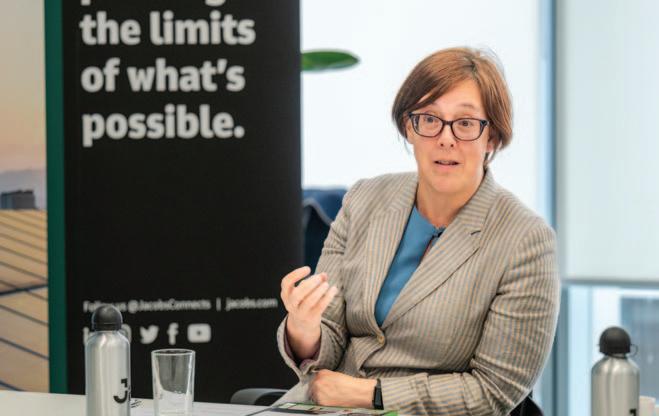
“Public transport initiatives are key to the sustainable delivery of infrastructure.”
Anne Graham
10 years, maximising the affordable and social housing supply in a financially sustainable manner and supporting the creation of sustainable, affordable communities. This also means building a stable and secure pipeline into the future – whether on state land or via the acquisition of land in the near term –particularly in an area of high housing demand so that we can help to build in stability and ensure more affordability through the economic cycles.
Peter O’Shea
ESB’s vision is to decarbonise the electricity system. We have committed ourselves to be net zero by 2040 in all operations across scope one, two, and
three emissions. We are starting to make progress on that. At the same time, we want to ensure a system which is resilient. Electricity provides 20 per cent of our overall energy mix, but resilience will be key if we are to meet future projections of electricity accounting for up to 80 per cent.
Michael Mahon
In the long-term, we have a new roadmap document, Shaping Our Electricity Future, which looks beyond 2030. We are delivering for 2030 and will pose questions to government for 2040 and 2050 outlining how to get to our net zero targets. We are well underway in delivering the Celtic Interconnector with

“Economic development is fundamentally dependent on infrastructure; it is not simply about keeping pace.”
Peter O’Shea

work underway in County Cork and in France which will allow us to sell 700MW of electricity to France when we have a surplus of electricity. We will have a surplus of offshore wind energy, the question is what we will do with is, whether that is hydrogen production, exporting it, storing it, or another enduse.
Anne Graham
Our vision is to connect people and places with sustainable transport infrastructure. To do that, we need to collaborate across the public and private sectors, exploit opportunities to delivery infrastructure and deliver better value for money. We have undertaken consolidated market engagement. We know that we and many different sectors and companies, both inside and outside of Ireland, have a role to play and we need to enable this.
Nigel O’Neill
My vision is to get our projects in the planning pipeline with planning approved and shovel-ready. When the second half of the NDP hits, we aim to be ready to go. That is challenging but that is my vision. This, if delivered, will consist of Metrolink, more Luas (Finglas and Cork), greenways, the National Cycle Network, and the TEN-T network in Donegal where it is badly needed.
Richard Sanderson
We are very excited for the decade of delivery. Last year, Jacobs hosted a trade visit by officials from New Zealand in London looking at our delivery of mega projects. When a delegation came over this year, they wanted to see infrastructure delivery in countries of a similar size to New Zealand, so they travelled to Ireland. The New Zealand officials remarked positively on the collaboration between entire government departments in delivering infrastructure as per the National Planning Framework. Speaking as an observer, I can say that Ireland’s infrastructure delivery is on the right track and we at Jacobs are very excited to play a role in that.

round table discussion 23


HSE Procurement: ‘A
serious player’
As he prepares to step down later in 2024, National Director of Procurement for the Health Service Executive (HSE), John Swords, reflects on a career in health spanning four decades with the navigation of major procurement challenges in an ever-evolving health service with increasing patient care demands.
Currently overseeing the work of the largest purchaser in the State, an annual procurement spend of €4.9 billion, and supporting the delivery of public health services, Swords wryly quips that an ostensibly temporary deployment to the HSE’s finance department in 1983 has led him on a “winding and highly enjoyable path”.
Among his major achievements sits the development and delivery of the Procurement Sourcing Plan, compliance improvement, professionalisation of procurement staff and the roll-out of the National
Logistics Service, alongside support for the national finance reform and stabilisation programmes.
Illustrative of the nature of the work undertaken by HSE Procurement and the health service in general, Swords is not easing into retirement. Instead, he continues to oversee the procurement service to support the Sláintecare rollout of six new HSE health regions introduced to replace hospital groups and community healthcare organisations.
It is a move which Swords describes as “progressive
issues eolas 24 eolas issues


and brave” but one he believes will be immensely beneficial.
“Before now, focus and attention was on central management out to the Hospital Groups (HGs) and Community Healthcare Organisations (CHOs). The emphasis of Sláintecare is to bring those services closer to the patient through the six regions.
“The six Regional Executive Officers (REOs) now have the authority within their areas but also act as a collective authority. While those areas grow services will evolve as the health sector landscape changes. The National Distribution Centre (NDC) in Tullamore, County Offaly, our sourcing element of contracts, compliance improvement and business systems will play a big role in supporting the REOs in patient-focused service delivery.
In the context of this change, procurement will remain centralised, something Swords describes as “positive” with maximised opportunities to support patient care. However, he recognises that major system change, and the introduction of a single financial system is not without its difficulties.
The new Integrated Financial Management and Procurement System (IFMS) is the national single, integrated financial management and procurement system for the health sector.
“The marketplace has had to live with us through the change and initial disruption, but the IFMS brings structure to the process that we are introducing internally.”
Reflecting on the implementation of change, Swords acknowledges: “It has been challenging and it has required a lot of investment at all levels internally and externally, but overall, it has been a success.
“The IFMS is at an early stage, yet it has had a significant impact already and we have started to achieve management reports in a way that we did not have before. I am a believer in the IFMS – and have been from day one, it will become the single source of information for procurement to assist the supply base and position our requirements in an accurate way to the market and benefits accrue both sides with that in achieving maximum value supporting patient care delivery
Remit
The remit of HSE Procurement is broad, encompassing four main functions: sourcing and contracting; logistics and inventory management; corporate procurement planning and compliance improvement; and business systems.
While Swords will not oversee the final publication of the 2025 Corporate Procurement Plan, he has been heavily invested in the plan’s creation which will shape the delivery of ensuring supply, compliance, coordinated purchasing, and green procurement.
Future planning
Reflecting on the importance of the forthcoming plan, as a foundation of good governance, Swords points to the impact of Brexit as an example of when HSE procurement excelled and expressed his pride in the response to major disruption.
He estimates that the HSE required companies to amend standards on some 2.5 million line items to ensure supply in the country.
“We worked proactively as a State and began planning some two years before Brexit. We secured a lot of our
25 eolas issues 4
issues eolas


stock that we would require in the immediate term and in some areas, we doubled up to make sure things did not go wrong. This proved to be the correct approach, particularly when you looked at what happened in the North, where many products, including food, were initially unavailable on shelves.
“We had ample product within the State, but more importantly, we had it in our health service. Therefore, we did not suffer a major knee-jerk reaction.”
The National Director of Procurement admits that this planning was not without its own challenges. In a reality whereby many distribution companies did not understand the source of origin for products, Ireland secured contingencies to enable products to come directly from the European Union, and not through the UK.
Swords chairs the EU-funded Procurement CAWT (Cooperation And Working Together) Group, a partnership between the HSE and the Health and Social Care (HSC) in the North and emphasises the centrality of a positive working relationship between north and south as critical to our future.
Swords believes that recognition of the experience of contingency planning for Brexit served as a model for the HSE’s approach to the pandemic.
Offering a sense of what was required, Swords points out that at one point, the HSE had a contingency plan that anticipated a significant loss of its workforce. While this contingency planning was vital, it also had to be deployed alongside dynamic challenges and uncertainty coupled with unprecedented demand on supply and vital life-
saving products and services across the entire State.
“The centralisation of our procurement response was important in this regard,” he says. “It was important also to have a collective approach in government both public and civil services who worked together to ensure decisions were made to protect our population. We were able to look at securing supplies from an Ireland Inc perspective, rather than overseeing local competitions. Ireland acted as one.”
Logistically, Swords oversaw the opening of a warehouse in Ballycoolin, Blanchardstown, near Dublin Airport which enabled product distribution from the runway to across the country in around three-and-a-half hours. In total, HSE procurement managed some 298 flight deliveries filled with medical products.
Swords is the health representative on the board of GS1 Ireland, which delivers global standards across multiple sectors, including healthcare. With a stated intention of retaining the voluntary position after his retirement from the HSE, such is his belief in the track record of a global standardised system for traceability – from product manufacture to patient treatment – to continue to raise health standards post-pandemic.
“We built a system in a very short space of time to track the various types of vaccines, knowing where they were, and where they were being administered in a live environment,” he explains
“It turned out to be a tremendous success because we could track the vaccine from its manufacture,
issues eolas 26 eolas issues

through distribution and then to end use. It also meant we minimised wastage. In a live environment, we were able to see when a vaccine was not being used, and move it, through various temperature requirements, to ensure it could be used. That is something we are very proud of and something that is now being adopted in other jurisdictions across Europe and beyond.
Other examples of success in this area are blood management programmes maintaining efficacy of the product and maximising the efficiencies of blood stock management ensuring minimum wastage of a scarce resource.
Sustainability
Swords is also a member of the HSE Climate Action Steering Group and is leading two key programmes of work in relation to green procurement and procurement decarbonisation trajectory.
In 2023, the HSE launched its Climate Action Strategy 2023-2050, which puts an emphasis on HSE Procurement to reassess the sustainability of the products it purchases. However, as Swords explains, his colleagues recognise their responsibilities and are working in collaboration with markets to maximise the use of sustainable products in patient care.
“In our endeavours to promote sustainability we see many examples of where people are making genuine efforts not to use or use less of certain products and replace them with more environmentally friendly products.
“Our role is to coordinate those innovations and reflect them in our award criteria to encourage the marketplace to adopt and promote sustainable products for patient care.
“We are working hand in glove with the marketplace to improve awareness and use of sustainable products in our services.
Asked to reflect on the most challenging times of his long-standing career, Swords admits that the early days of developing HSE Procurement as a central service were challenging.,. However, he indicates very

few “low-points” in an accomplished career.
“I reflect on it as an achievement that HSE Procurement is now recognised as a serious player in the wider health service and put it down to several influencing factors,” Swords states. “Procurement is an enabler, and I would like to think it is seen as a responsive respected support service in delivery of patient care across all disciplines within the health service.
A critical factor is supporting our colleague professionals in the various disciplines in providing professional procurement advice and consistent services. Professional consistency is not success unless it is replicated as and when required supporting patient needs.”
On the journey he would like to see HSE Procurement take after his departure, Swords concludes: “On my departure I reflect on the numerous occasions where my colleagues responded above and beyond their normal duties to support people internally and externally, patients, and colleagues, at a particular time of need. This was something I was particularly proud of and I would hope this ethos of goodness will be retained and encouraged.
On reflection with the numerous changes that have happened in health care during my career I ponder on the challenges of change and my belief is while change is challenging it brings opportunity which is good. Reflecting on the people that I have worked with and the good and goodness I have come across and matching the two, lends itself to compassionate patient care.
Speaking of his retirement from the HSE, Swords remarks: “In making a decision to retire my heart tells me that I want to stay but my head says it is a time for change and I regard it as a reset.
“On reflection on the past years in the public sector, I think of all the wonderful people that I have come across and I thank them for the support they gave me during my career. “On reflection, it has been a privilege”.
Profile: John Swords
Outside of work, Swords regards himself as being lucky in life and has interests in sport and also enjoys walking. He places an emphasis on the significance of “giving something back” hence his involvement in numerous associations including schools, residents, businesses and local clubs, some of which will be continued in retirement.
issues eolas 27 eolas issues

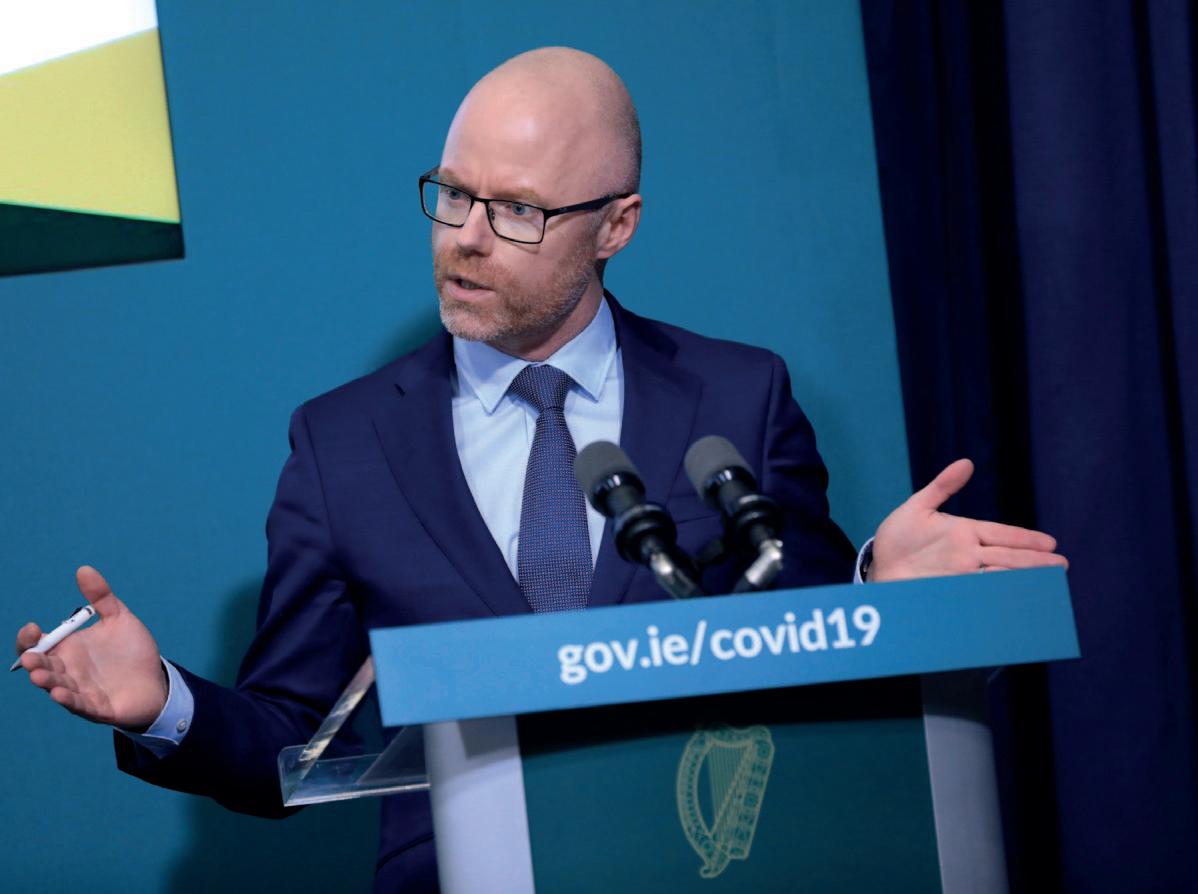
Government claims Sláintecare progress
Sláintecare remains the policy guiding the Department of Health. While HSE performances have improved and some structural changes have taken place, the vision of a universal healthcare system by 2031 remains an ambitious one.
Sláintecare was launched in 2019 following the publication of a report by the Oireachtas Committee on the Future of Healthcare in Ireland in 2017, led by former Social Democrats co-leader Róisín Shortall TD, which outlined a vision for “a universal health and social care system where everyone has equitable access to services based on need and not the ability to pay”.
The progress made in some areas, while significant for future health outcomes, can be broadly analysed as a continuation of the recovery from the backlog taking place throughout the health service from Covid-19-induced challenges.
On the objective of improving access, the Sláintecare Progress Report 2021-2023 outlines that a 32 per cent reduction in the number of patients on waiting lists was achieved in 2023, when compared with 2022, and that the number of patients on trolleys in 2023 is down versus 2022 – a 22 per cent reduction for the second half of 2023 versus the same period in 2022.
The Government can claim incremental progress on free healthcare coverage, with around 500,000 (out of a state population of just under 5.3 million) now eligible for a GP visit card. The Department of Health states that more than half of the population are now eligible for either a medical or GP visit card.
issues eolas 28 eolas issues

In addition, the progress report states that savings for patients have been achieved with the abolition of public hospital inpatient charges, which were abolished in April 2023 and can patients up to €800 per year. These charges were abolished for children under the age of 16 in 2022.
Free contraception is another measure introduced which the Department attributes to Sláintecare. In 2023, the free contraception scheme – which was introduced in September 2022 – was extended in a phased approach throughout the year making it available to all women aged between 17 and 30. Since then, the Department further expanded the scheme to include women aged 31 from January 2024. Approximately 189,000 women availed of the scheme in 2023.
Capacity
The Department of Health has further heralded progress on hospital capacity, as, since the formation of the Government in 2020, 1,182 new acute inpatient beds have been added, with ambitions for a further 91 acute beds to open in 2024. At the time of publication of the report, 330 critical care beds are now available, 72 more beds than in March 2020.
The Department further states that an increased workforce is enabling better capacity, with 145,985 staff working in the health service as of the end of December 2023. The report further details a 26,000 increase in healthcare workers to the end of December.
Employment levels at the end of March 2024, show there were 148,293 whole time equivalent (WTE) [equating to 166,997 personnel] directly employed in the provision of Health and Social Care Services by the HSE and Section 38 hospitals and agencies.
GP training
In terms of building a future workforce which can handle demographic changes and increased demand, the report outlines how the number of doctors entering GP training has been increased “significantly” in recent years, with 286 new entrants in 2023 and 350 places for new entrants for 2024.
Annual intake to the GP training scheme has been increased by over 80 per cent between 2015 and 2023, and the number of new entrant places to be available in 2024 is a 22 per cent increase on last year’s intake. In addition, GP recruitment is ongoing under the joint non-EU GP Training Programme between the HSE and Irish College of General Practitioners (ICGP). 112 non-EU GPs were recruited in 2023 under the training programme and it is planned to recruit up to 250 more non-EU GPs to Ireland in 2024.
The placement of GPs under the programme is targeted to rural and underserviced areas. Internal DoH statistical analysis indicates that between 1.5 and 3.1 GPs will exit training for each retiring GP “over the coming years”.
Reforming the health service
Under Sláintecare, fundamental reform of the principles of the health service remain a way off, but there have been some reforms to the Health Service Executive (HSE) and its operational structure.
The most significant reform to the health service under the auspices of Sláintecare has been the through the establishment of six HSE health regions ostensibly aimed to replace hospital groups (HGs) and community healthcare organisations (CHOs) and “enable the provision of better and more integrated care along regional lines”.
Under the HSE Health Regions Implementation Plan, published in July 2023, six regional executive officers have now been recruited and are in place.
A number of other incremental programmes have taken place such as the introduction of enhanced community care and the Chronic Disease Management (CDM) Community Support Team (CST) programme. However, it is unavoidable to observe that over the course of the Government’s term, there has been a diminution in the momentum of the healthcare strategy, as exemplified with the high-profile resignations of former chief executive Laura Magahy, who expressed her frustration at the slow pace of the implementation of the programme.
Anthony O’Connor’s resignation from the council of Sláintecare echoed this perspective, with O’Connor writing in a letter to Minister Stephen Donnelly TD that the original culture of Sláintecare had been “bulldozed”.
Response
Minister Donnelly, on the publication of the Sláintecare Progress Report, claimed that the health service has had “significant improvements that are delivering better health services to patients and the public, on our road to delivering universal healthcare for all”.
However, while Sláintecare remains the overriding health policy of the Government, the lack of fundamental changes beyond organisational structures mean that it is difficult to envisage a universal, free-at-the-point-of-use healthcare system emerging in this State by 2031 which is less than 342 weeks away at the time of writing.
issues eolas 29 eolas issues



HealthTech Ireland Symposium 2024
In early May 2024, HealthTech Ireland hosted its annual symposium. Ciarán Galway attended and spoke with organisers and participants.
Organised by Susan Treacy, CEO of HealthTech Ireland, the HealthTech Ireland Symposium takes place every one to two years. A members’ association, HealthTech Ireland’s primary objective is to represent its members and is currently aiming to build on this established network that by enhancing engagement and collaboration.
Addressing the event, Treacy said: “In shaping the day, we strive to demonstrate and reflect the hard work of our members, our collaborators, and our strategic partners, to discuss the pressing issues and resolve large and small challenges, ultimately ensuring that collectively, we bring immense value to the ecosystem and patients.
“Our world is undergoing a revolution in all sectors, and healthcare is no exception. From remote virtual hospitals to AI-driven diagnostics, from surgical robotics to blockchain-enabled
data sharing, the landscape is shifting.
On her broad vision for what digitalised healthcare can deliver for people, she says: “It is important that in delivering for service users we are not just spectators but architects of this transformation through strategic engagement, education and deliverable initiatives. We are creating an ecosystem on our island where we are defining our positions and working hand in hand, aligning for collective success.
“Commitment to continue to work across the sector forging partnerships, to lead us toward a healthier, more connected future. It is one that delivers value to improve lives for the patients we serve. This is at the core and the north star of the work we do. Every decision, every innovation, impacts lives and it is our collective responsibility to build a healthcare system where compassion, transparency, and excellence prevail.”

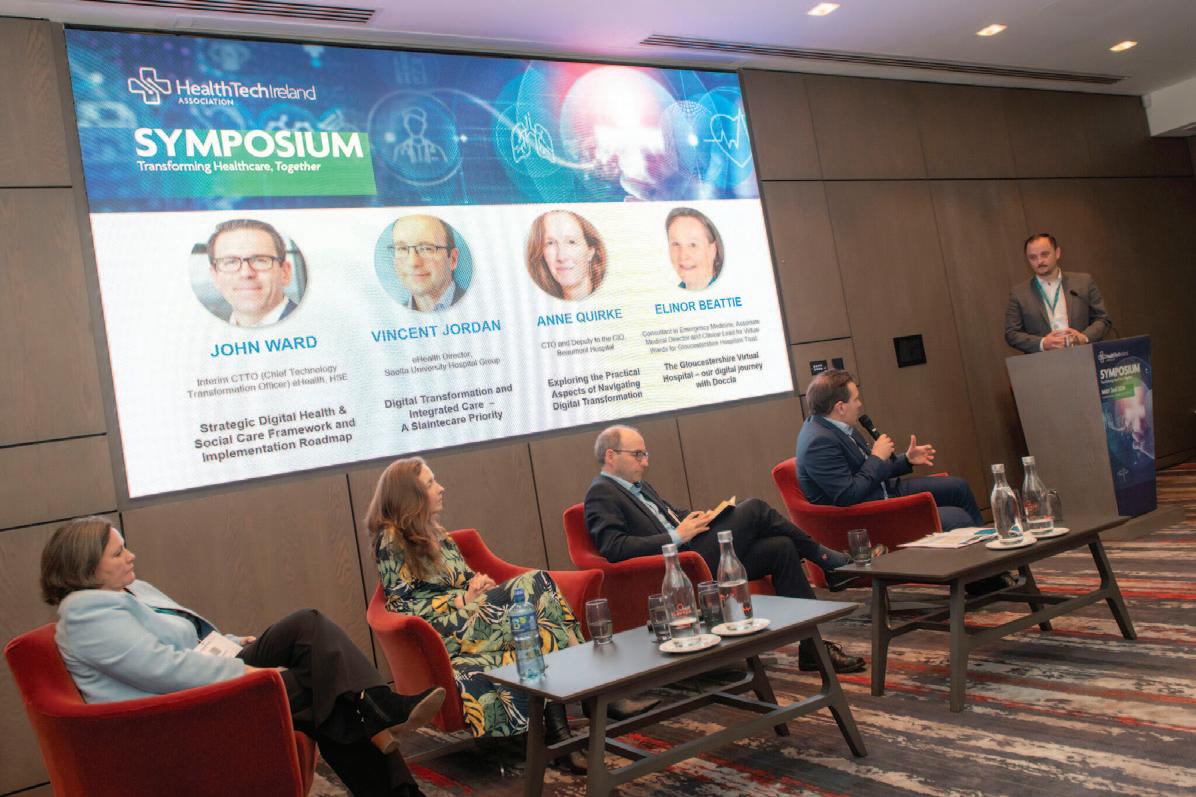
32 eolas issues issues eolas

issues eolas


Susan Treacy, CEO, HealthTech Ireland
“Our primary objective is to represent our members, but our mission now is to build on that and enhance engagement and collaboration in several areas, all with the overall purpose of moving the dial with collaborators and stakeholders. A lot of the progress being made is happening under the radar, and days like this serve to highlight what is taking place.
“We are seeing a real willingness to collaborate. Organisations are confident in the expertise we possess and with the enhancement of trust between organisations by bringing everyone together in an open and trusted space, then progress can be achieved.”

John Mark O’Sullivan, Managing Director, Biomnis Ireland
“I am here to represent industry in terms of the provision of laboratory diagnostic services to the HSE and to private hospitals in Ireland and to look at what we can offer into the future with respect to the Strategic Framework Document now being circulated for discussion.
“We have a pretty ambitious investment and expansion programme in Ireland over the next three to five years. We want to create more jobs in Ireland; we are currently in the process of setting up a number of different sites, including a bespoke clinical genetics laboratory and expanding our suite of specialised tasks within Ireland so that they are not being outsourced out of the country.
“Collaboration between industry and the health sector – public and private – is key. Digital solutions, digitisation from a diagnostics perspective is really important, for example, digital pathology, digital pathways are really important in terms of patients owning their healthcare data from end-to-end and clinicians having easy and real-time accessibility no matter where they are in the country.”

John Swords, National Director of HSE Procurement
“It is very important that we have collaboration with the companies that we work with. HealthTech has done a fantastic job at bringing everybody together in the right environment of openness, collaboration, and with questions being asked. We must be more open with each other, and this is the right environment in which to do that.
Significant change is happening in the sector, and I have had the opportunity to make the case of the needs of the HSE from a procurement perspective.”

Gwynne Morley, Board Chair, HealthTech Ireland
“With medicines and patient outcomes from treatment, there is a convergence of science, data, technology and what we need is the collaboration right across the sector so that we can deliver better health outcomes for our people.
“I am all about bringing stakeholders together and enhancing public-private partnership. Ireland is a hotbed for MedTech and pharma, and we need to do as much as possible to reap the benefits of that, because we are a small country which has access to one of the top levels of global subject matter expertise and a top level of investment.
“We have heard from a lot of different stakeholder groups at this event and what we are getting from this is an increased level of trust. From that, we can better work together and work towards this shared endeavour of delivering for people in Ireland.”

Molly Carroll, Executive Healthcare Administrator, HealthTech Ireland and patient advocate
“Autoimmune conditions are systemic in this country and can lead to health complications in a multitude of areas. As someone who has worked in virtually all aspects of healthcare – public, private and community care – I have a broad experience of the challenges we face as a country.
“Technology can drive progress which delivers for the patient. I can see the outcomes which come from that having been a patient as well as a healthcare professional. The work people across sectors are doing is changing health outcomes for people.
“What we need is to continue to further enhance the collaboration which is taking place. There is a real willingness from people from a diverse array of areas to get involved and enhance the digital progress taking place in our healthcare system.”
33 eolas issues

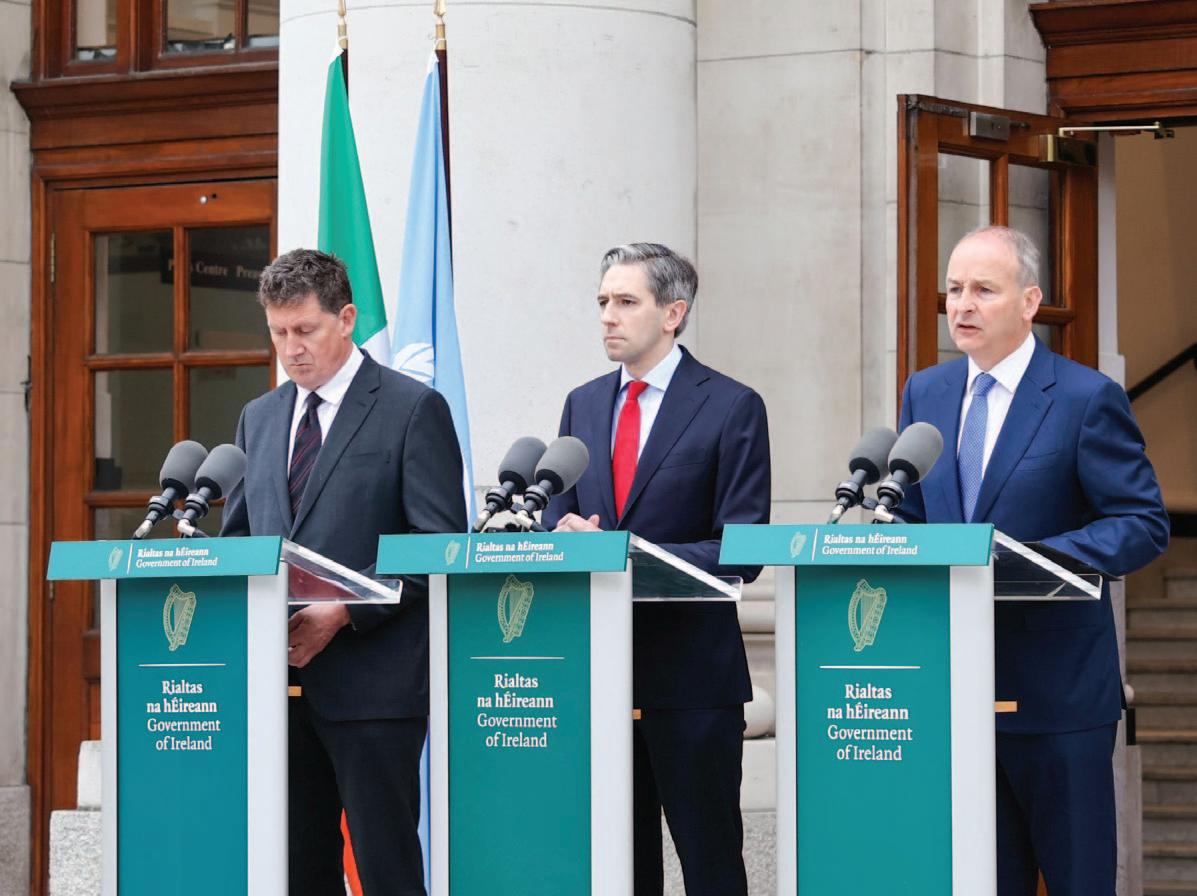
Ireland recognises the State of Palestine
On 28 May 2024, in light of the ongoing Israeli invasion of Gaza, Ireland formally recognised the State of Palestine – 10 years after motions were passed in both Houses of the Oireachtas calling for recognition.
On 22 May 2024, 44 years after becoming the first EEC/EU member state to adopt a two-state solution foreign policy, Ireland alongside Norway and Spain announced its plan to recognise Palestine effective from 28 May. After “months of consultation with like-minded countries across Europe and the Middle East”, Taoiseach Simon Harris TD, Tánaiste Micheál Martin TD, and Minister Eamon Ryan TD – flanked by the national flag of Ireland and the flag of the UN rather than that of the EU – made the announcement at Government Buildings, Dublin.
Committing to “undertake whatever national steps are necessary to give effect to that [recognition]”, Harris asserted: “In the lead up to today’s announcement, I have spoken to a number of other leaders, and I am confident that further countries will join us in taking this important step in
34 eolas issues issues eolas
Ireland’s triparty government leaders, Taoiseach Simon Harris TD, Tánaiste Micheál Martin TD, and Minister Eamon Ryan TD, announce the decision to formally recognise the State of Palestine.

Government leadership comments

“We had hoped to recognise Palestine as part of a two-state peace deal but instead we recognise Palestine to keep the hope of that two-state solution alive.”
Taoiseach Simon Harris TD

“Recognition of Palestine is not the end of a process; it is the beginning. It is our conviction that the two-State solution remains the only viable option to secure a just and lasting peace, and a better future.”

“Palestine has every right to be recognised internationally as a state and it is only right that Ireland should take this step today. We hope that more countries will follow us in doing so.”
Minister Eamon Ryan TD
the coming weeks. This is an historic and an important day for Ireland and for Palestine.”
Ireland, Spain, and Norway now join the 142 other United Nations member states which already recognise the State of Palestine.
Describing recognition as “an act of powerful political and symbolic value”, Harris said: “Our step today, taken with Norway and Spain, is further recognition of the legitimate right to statehood. It is a statement of unequivocal support for a two-state solution – the only credible path to peace and security for Israel, for Palestine, and for their peoples... We take it to offer hope and encouragement to the people of Palestine in one of their darkest hours.”
That evening, the Taoiseach spoke with President of the State of Palestine, Mahmoud Abbas, and articulated to him that he was recognising Palestine, on behalf of the people of Ireland, “to keep the hopes of a two-state peace solution between Israel and Palestine alive”.
The Palestinian Ministry of Foreign Affairs and
Expatriates responded: “Recognising the State of Palestine is a victory for Palestinian rights and an important practical step towards protecting the twostate solution based on ending the Israeli occupation and embodying the Palestinian state with its capital in Jerusalem.”
In response to the announcements, Israeli Foreign Minister Israel Katz ordered the immediate return of the Israeli ambassador to Ireland, Dana Erlich, for consultations and warned of further unspecified “severe consequences”.
The Government’s recognition is of a State of Palestine on the ‘1967 borders’. However, this border recognition could be subject to change if a settlement is met in the Israel-Palestine conflict.
Context
In advance, the Taoiseach had spoken with the Prime Minister of Spain, Pedro Sánchez, on 6 May and the Prime Minister of Norway, Jonas Gahr Støre, on 18 May 2024.
Tánaiste Micheál Martin TD 4
35 eolas issues issues
eolas
issues eolas

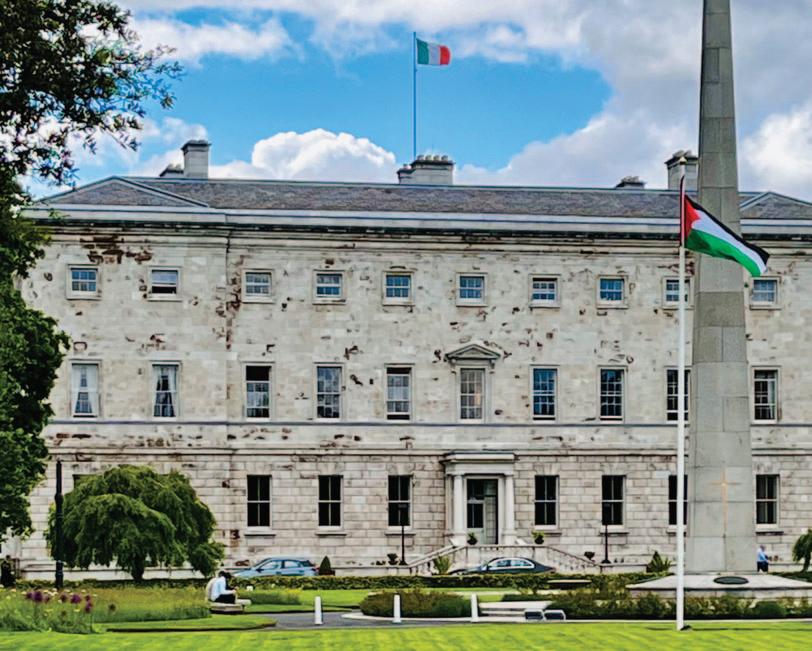
Having discussed “the dire situation in the Middle East and particularly in Gaza” and “our ongoing work together on recognising the State of Palestine” with Sánchez, the Taoiseach observed: “We reaffirmed the wish for both Spain and Ireland to recognise Palestine, agreeing that formal recognition is an important part of acknowledging that a two-state solution is the only way to bring about peace and stability in the region.”
Similarly, the Taoiseach updated Støre on Ireland’s plan to imminently recognise the State of Palestine, as well as ongoing work with Sanchez of Spain. A government press release recorded: “The pair agreed that the deteriorating humanitarian conditions in Gaza underscored the need for an immediate ceasefire and for unhindered access for aid.”
In the intervening time, on 10 May, 143 out of 193 UN member states voted to determine that the State of Palestine is qualified for membership in the United Nations in accordance with the Charter of the UN.
Palestinian Ambassador
As a result of the State’s recognition of Palestine, the Mission of the State of Palestine in Dublin is now formally recognised as an embassy, and the Government has changed the classification of its office in Ramallah, Occupied West Bank, to that of an embassy.
Talking to eolas Magazine earlier in January 2024, the Palestinian Ambassador to Ireland, Jilan Wahba Abdalmajid, referenced the granting of non-member observer state status in the UN General Assembly. “Ireland recognised and voted in favour of recognition in 2012,” she highlighted, adding: “This is a reflection of the practical measures on the ground to recognise the State of Palestine.”
In response to a question posed on the significance of formal recognition, she referenced the European countries, such as Cyprus and Sweden, among the 139 UN member states (out of a total of 193) which have recognised Palestinian statehood and asserted: “We want recognition from the international
community. We are a state. When we sit at the table, we want to be equal. We were given the recognition of this right in the UN in 1947 and we want to have it activated [under UN General Assembly Resolution 181 (II)].”
Practically, this recognition, she suggests, enables Palestine to engage and access UN and international agency funding, as well as placing it on an equal footing as its occupier under international law, for instance, as a state party of the Rome Statute of the International Criminal Court (ICC).
“We managed to access and be recognised within the jurisdiction of the ICC, and we are part of the International Court of Justice (ICJ),” Wahba Abdalmajid explained, adding: “There should be a legal limit on the occupation in Palestine. Since 1967, the occupation has violated every aspect of international law and every aspect of UN resolutions with impunity. We have to take this occupation to a different level of accountability. The status of being a state will help us in any future negotiation with Israel – to not be less than equal to the State of Israel.”
36 eolas issues
In light of recognition, the Palestinian flag was raised at Leinster House on 28 May 2024.

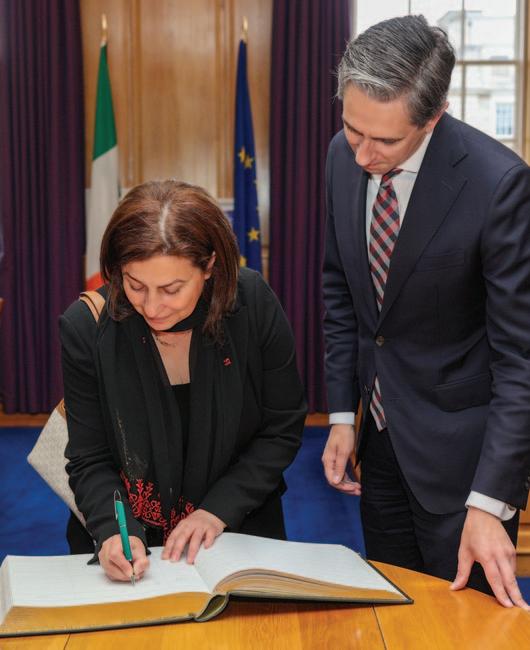
Opposition
On the formal recognition of Palestine, something previously flagged as a foreign policy priority by his party leader, Sinn Féin’s Foreign Affairs spokesperson, Matt Carthy TD told eolas Magazine in early October 2023 that a Sinn Féin government would seek to pursue it “as a matter of priority”. “I think it will be preferable, obviously, if we could do that in conjunction with other countries around the world,” he added.
Subsequently, Carthy welcomed the announcement of formal recognition and speaking in the Dáil he said: “I commend all those who have campaigned for this moment, all those who marched, who petitioned, who have stood up for international law, and for the reality that the only route to a lasting peace in the Middle East lies with a free, independent and sovereign Palestinian state...
“I expect that government will take the next logical steps. Israel must be held to account and meaningfully sanctioned for the ongoing gross violations of international law in Gaza and across Palestine.”
Similarly, Social Democrats leader Holly Cairns TD said: “The Irish people’s solidarity with the people of Palestine is unbreakable. It is long past time this solidarity was formally acknowledged by our government with recognition of the State of Palestine – my only regret is that it did not happen sooner...
“The Irish Government must now take the next step and enact diplomatic and economic sanctions against Israel.”
Historical context
On 10 February 1980, in a major foreign policy decision taken by the Charles Haughey-led Fianna Fáil government, Ireland became the first EEC/EU member state to affirm that any resolution of the Israel-Palestine conflict must include the establishment of a fully sovereign and independent Palestinian state, coexisting alongside Israel. In other words, Ireland endorsed the two-state solution.
In a joint statement – which became known as the Bahrain Declaration – with the foreign minister of Bahrain, the late Brian Lenihan senior, as Ireland’s then-Minister for Foreign Affairs, asserted that the Palestinian “had a right to self-determination and to the establishment of an independent state in Palestine”, while also recognising “the role of the PLO [Palestinian Liberation Organization] in representing the Palestinian people”.
However, while both Houses of the Oireachtas passed motions calling on the Fine Gael-Labour government to formally recognise the State of Palestine in late 2014, it took a decade for Ireland to recognise the State of Palestine.
In March 2011, then-Minister for Foreign Affairs Eamon Gilmore responded to a Dáil question posed by Sinn Féin TD Pádraig Mac Lochlainn on Ireland’s proposed recognition of the State of Palestine insisting: “I share the commitment of successive Irish governments to this policy [the two-state solution] and will be working towards its realisation. It would be premature to declare such recognition now in advance of actual control of the territory in question, a condition to which we in Ireland attach great importance.”
The implication was, therefore, that Ireland had been reserving its recognition of the State of Palestine until a time in which the Palestinian Authority has control of the entirety of its claimed territory – potentially as a component of a two-state solution deal.
However, to date, the Palestinian Authority exerts only partial control of the Palestinian territory. In Area A of the West Bank, it exercises full civil and security control, while in Area B it exercises only civil control. In Area C, which comprises 60 per cent of the West Bank, Israel is in total control. The PA has no control of its capital, East Jerusalem, which was annexed by Israel in 1980 and, along with West Jerusalem, is claimed by Israel as a ‘unified’ capital. Beyond the West Bank, Gaza has been administered by Hamas since 2007.
Meanwhile, as recently as December 2023, thenTaoiseach Leo Varadkar TD responded to Labour leader Ivana Bacik TD during Leaders’ Questions in the Dáil, saying: “We don’t believe that the best way to do it [recognise Palestinian statehood] is unilaterally. That will be dismissed. It will be ineffectual, and we will be seen as an outlier, acting unilaterally, at a European level. What we would like to do, is do it as part of a group of European countries. I think that will be a more significant statement.”
37 eolas issues
issues eolas
Ambassador Wahba Abdalmajid signs a guest book in Government Buildings.

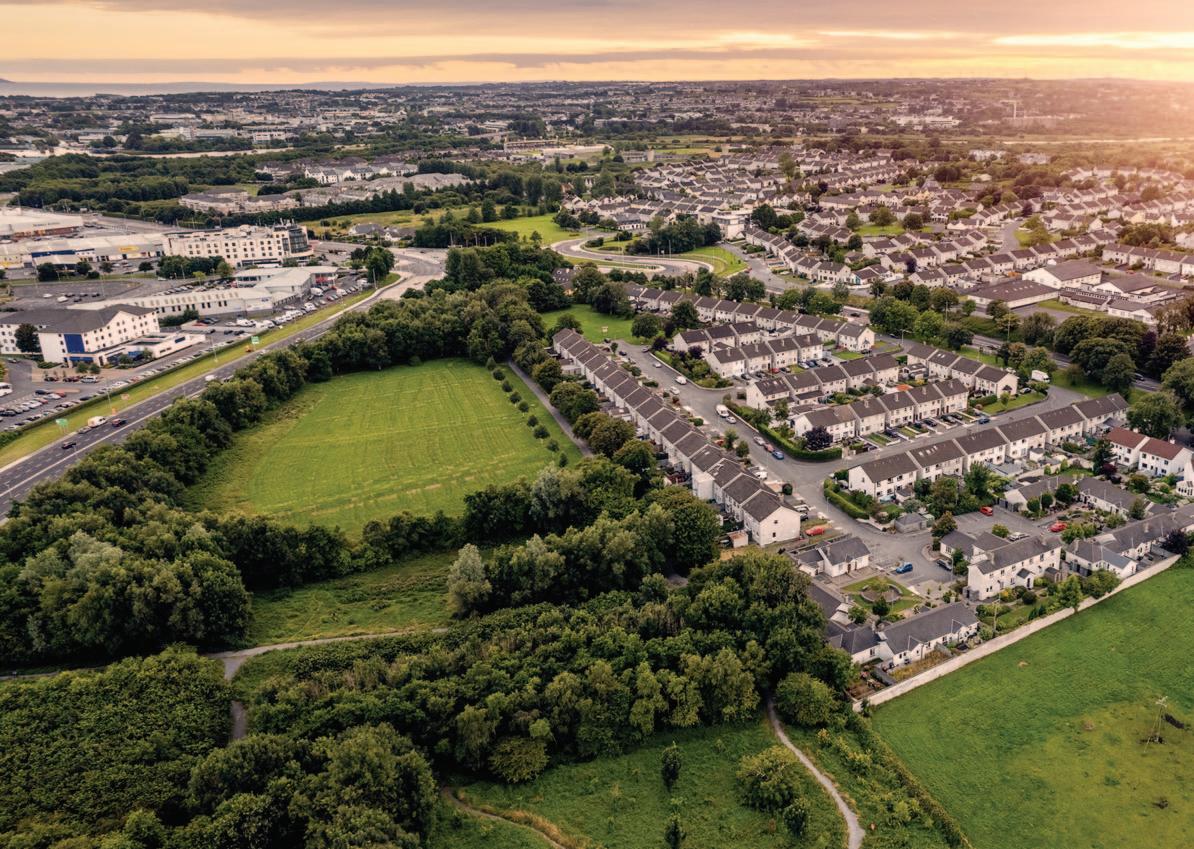
‘Emergency action’ needed to tackle housing deficit
Minister for Housing Darragh O’Brien
TD has
published
The Housing Commission’s report, alongside two reports on proposed wording for a referendum on housing.
The Housing Commission states that it is “cognisant of several pressing issues currently affecting housing in Ireland, such as high inflation in the construction industry, delays in the planning system and acute pressures on the availability of accommodation”.
Within The Housing Commission’s report, there are 83 recommendations outlined that focus on shaping housing policy into the future.
Recommendations
The major challenge identified by the Commission is Ireland’s housing deficit.
To tackle this, the report states: “It is critical that this housing deficit is
addressed through emergency action.”
Key recommendations include implementing measures to end homelessness, recognising and dealing with Ireland’s housing deficit, and establishing a housing delivery oversight executive in legislation as a decisionmaking body – something that Minister O’Brien has already ruled out.
The Commission’s report also suggests supporting high-yield Housing Delivery Zones, a Central Construction Supply Unit, and diverse sources for finance, such as stable public financing and collaborative development of standard house and apartment types, to “drive efficiency, reduce costs and support viability”.
Furthermore, The Housing Commission Report aims to conduct a National Housing Condition survey every five years, reform the housing assistance payment system and rental accommodation scheme and use appropriately targeted equity loan schemes to support first-time buyers to purchase a home.
The report acknowledges that it would be highly beneficial to increase the size of the social and cost-rental housing sectors to 20 per cent of the national housing stock, and also increase capacity in the AHB sector.
Government’s preliminary review of The Housing Commission report suggests
issues eolas 38 eolas issues


around 65 of the recommendations are already advanced or at varying stages of implementation, with some more advanced than others.
Additionally, the review states: “Comprehensive consideration will be given to those remaining to be implemented.
“We need to embrace a different risk and decision-making environment across the administrative system. The legacy of the current system of control must be replaced by a strong focus on outcomes.”
Article 40A constitutional change
The 2020 Programme for Government (PfG) committed to establishing a Commission on Housing to examine issues such as tenure, standards, sustainability and quality-of-life issues in
the provision of housing. The PfG also made a commitment to hold “a referendum on housing”.
As such, the Minister for Housing, Local Government and Heritage assigned the Commission with the specific task of making a recommendation to the Government on the potential wording for a constitutional amendment on housing. The Commission developed its recommendations and proposed wording of an amendment based on giving effect to that position. However, a second minority report was also published.
In considering the wording for a referendum, the Referendum Subcommittee examined “the right to housing in international human rights law and in the domestic legal systems of several different jurisdictions with a view to informing how a right to housing might operate in Ireland”, including Canada, Finland, India, Portugal, Scotland and South Africa.
Following lengthy consideration, the Commission has proposed potential wording for a referendum on housing which includes an explicit recognition by the State of the fundamental importance of having a home to both individuals and society; and a specific guarantee for access to housing. The proposed wording has been suggested as an amendment to Article 40:
1°: The State recognises that having a home is of fundamental importance to quality of life and that access to adequate housing, by facilitating the development of family, social and community relationships, promotes the common good.
2°: The State therefore guarantees to every citizen a right of access to adequate housing and pledges, as far as practicable, by its laws to protect and vindicate that right.
The first sub-article serves to acknowledge and affirm the fundamental importance of having a home to one’s quality of life. It also recognises that access to adequate housing promotes the common good by facilitating the development of family, social and community relationships.
The second sub-article provides for a
constitutional guarantee of a right of access to adequate housing. This commits the State to guaranteeing access to adequate housing to all citizens. It is intended to place an obligation on the State to secure the conditions in which access to adequate housing can be realised.
Suggesting that several questions were left unaddressed in the report, commissioners Ronan Lyons and Michael O’Flynn produced a minority report and stated that the “appropriate remedies to address it ought to be systemic, rather than founded on individual rights”.
Furthermore, the minority report suggests that an amendment of Article 45 of the Constitution is also necessary, and states there should be an “obligation on the state” to view housing as a “societal problem” rather than an “individually enforceable right”.
The Commission’s reports will be submitted to the Joint Oireachtas Committee for its consideration. An interdepartmental group will also be convened to develop policy recommendations for Government on foot of the Commission’s work. The advice of the Attorney General will also be sought before recommendations are brought to Government.
Reaction
Commenting on the report, Minister O’Brien said: “The publication of these reports is the culmination of two years of work by the members of the Commission and I thank them most sincerely for this work.
“There is much more work to be done and the work published today will contribute to a robust and informed policy debate and will certainly inform the direction of housing strategy into the future.”
Contrastingly, Sinn Féin spokesperson on Housing, Eoin Ó Broin TD said the Government are “taking people for fools” with the housing progress report and stated that it had no detail on progress from January to March on the delivery of Government housing programmes.
issues eolas 39 eolas issues
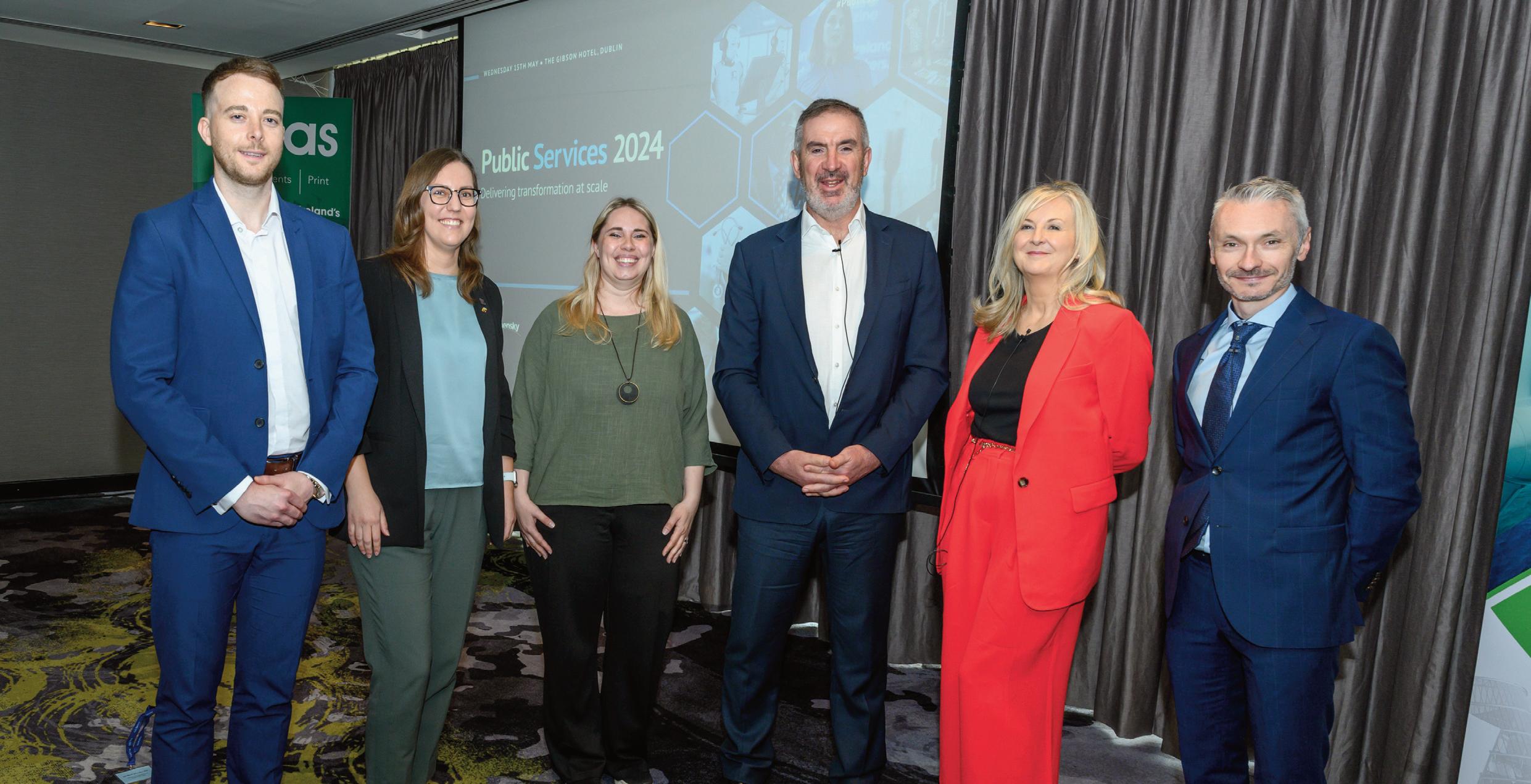
Public Services Conference 2024

The 2024 Public Services Conference recently took place in The Gibson Hotel, Dublin. Sponsored by Deloitte and OpenSky the conference brought together key stakeholders from across Ireland’s public service to look ahead to what’s next and how we can deliver transformation at scale.
The top line up of expert speakers, both local and visiting included Paschal Donohoe TD, Minister for Public Expenditure, NDP Delivery and Reform; Damien McCallion, Chief Operations Officer, Health Service Executive; Laura Yarrow, Head of Design, Government Digital Service, UK; and Kamila Gasinska, Strategic Partnerships Lead, GovTech Lab Lithuania.
We would like to take this opportunity to thank the 2024 conference sponsors, Deloitte and OpenSky, all speakers, exhibitors, and delegates who joined us in The Gibson Hotel, Dublin and made the conference a huge success.
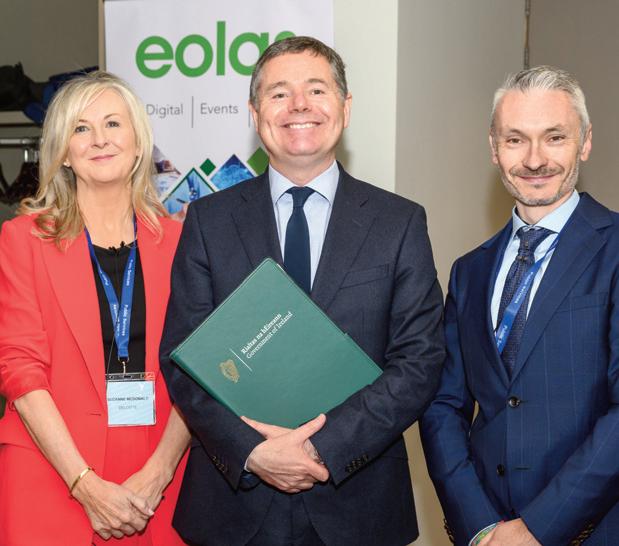
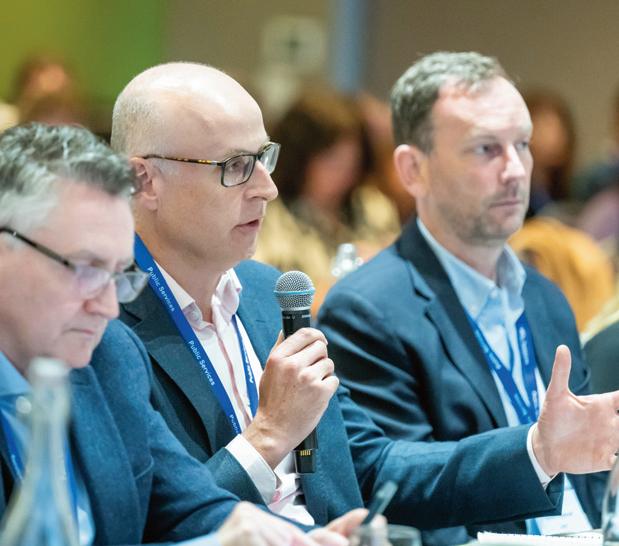


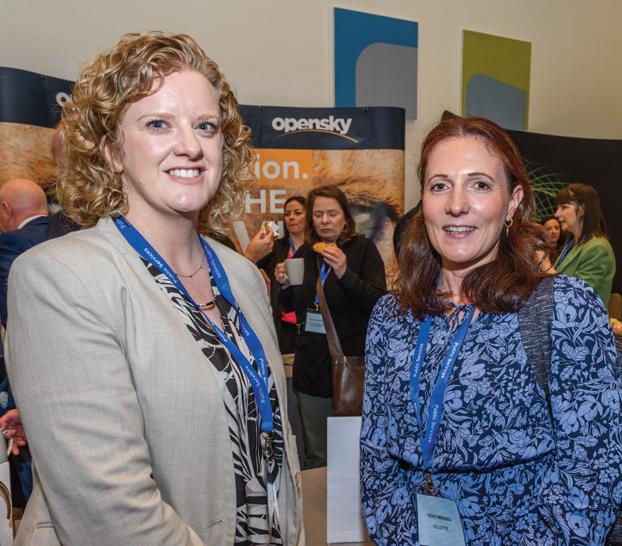

conference report 40
(L-R): Ciarán Galway, eolas Magazine; Kamila Gasinska, GovTech Lab Lithuania; Laura Yarrow, Government Digital Service, UK; Damien McCallion, Health Service Executive; Suzanne McDonald, Deloitte; and Kieran O’Neill, Deloitte.
Suzanne McDonald, Deloitte; Paschal Donohoe TD, Minister for Public Expenditure, NDP Delivery and Reform and Kieran O’Neill, Deloitte.
Eileen Jackson, National Shared Services Office; Dermot O’Loughlin, MyPay (Laois County Council); Saragh Fitzpatrick, Houses of the Oireachtas Service and Joe McQuaid, Food Safety Authority of Ireland.
Gerald Craddock, National Disability Authority with Conor O’Dwyer, Grant Thornton.
Gavin Ross, Department of Transport asks the panel a question.
Alan Copeland and Ciara Tobin at the Access Ireland exhibition stand.
Michelle Tritschler, Pobal with Vicky Menzies, Deloitte.
Shaping Possibilities




Transport report
Sponsored by

Shaping Possibilities
Transport Minister Eamon Ryan TD:
‘Changing our approach to transport means changing lives for the better’
Our daily lives are hugely impacted by our travel experiences, writes Minister for Transport Eamon Ryan TD.
Having a bad journey or getting caught up in traffic can affect your mood, your productivity, your social life, and your health. The Climate Action Plan sets targets to reduce transport emissions, but there are so many other reasons for wanting to improve our transport system and to make it more efficient for everyone.
In recent decades, and as in most other countries, the car and road-based freight have become the dominant means for moving people and goods within Ireland. Through urban planning and roadbuilding programmes, we supported this trend by allocating more and more of our public and civic spaces to cars, vans and trucks.

Congestion does not work for anyone
In hindsight, knowing what we know now, I think we may have adopted a different approach to supporting mobility and connectivity. However, there is still a lot to be learned from our past. Before motorised transport was all pervasive, people walked and cycled to local shops, supported local businesses, and lived in a way that limited waste and used resources efficiently. Our towns were thriving marketplaces, as well as vibrant centres for community living. Today, however, many of our historic medieval and market towns, are choked with traffic. Narrow streets means that space is at a premium. As well as
we need a new approach. In its 2022 report, Redesigning Ireland's Transport for Net Zero, the OECD advised that Ireland is unlikely to achieve its climate goals without a systemic change in its transport system and substantially different patterns of travel behaviours than those observed today. The OECD called for policies with a high transformative potential such as road space reallocation.
A new approach to transport
To this end, I recently launched a new transport strategy for public consultation. Moving Together: A Strategic Approach
“With a growing population, and a buoyant economy, the transport sector is now at a critical juncture.”
Minister for Transport Eamon Ryan TD
causing localised pollution and health implications, congestion makes it difficult to access shops and services. Equally, it makes it difficult for people to move about safety. This particularly affects children and the elderly, which has implications for independence and community life.
While this made sense from several perspectives, it did give rise to some problems: not least, a cultural shift in how we think about public space and prioritise its use. Motorised transport became the priority, and spaces for pedestrians, cyclists, the elderly, wheelchair users, families, and children were inadvertently demoted. Communities became severed by heavily trafficked streets, and active transport became a greater challenge.
So, with a growing population, and a buoyant economy, the transport sector is now at a critical juncture. The current system is struggling, and across the world there is growing recognition that our car-centric model is reaching the limits of its efficiency.
Congestion does not work for anyone –not for drivers, not for users of public transport, and certainly not for people who want to walk, wheel or cycle. So,
to the Improved Efficiency of the Transport System in Ireland has been developed to help alleviate the impacts of car dependency on the economy, the environment and the health of our society. This strategy is about putting people, rather than vehicles, at the centre of our urban and transport planning systems.
This does not mean that people will be unable to drive. For many people, particularly in rural or isolated areas, cars and other motor vehicles will continue to be crucial. Similarly, in urban areas tradespeople are particularly dependent on vans. Cars, vans, and trucks will continue to be a vital part of our transport mix, but we must plan for their use in a better way.
42 transport report
Shaping Possibilities


This strategy is all about finding new approaches to making travel, by whatever means, more efficient and pleasant for everybody. While decarbonising transport is absolutely crucial in fighting climate change, the benefits of transport efficiency reach much further. Changing our approach to transport means changing lives for the better.
Supporting better and more liveable towns and cities
Moving Together goes hand-in-hand with the extensive range of government investment and supports already in place or planned. It makes clear that the benefits of current and future government investment and supports in public transport, walking, cycling and electric vehicles cannot be fully realised while current levels of congestion remain. Heavy traffic makes public transport less reliable, often discouraging people from using it. It also makes the environment for vulnerable road users, such as pedestrians and cyclists, less safe.
This, too, discourages people from using active travel, particularly for shorter journeys. Ultimately, the aim of this new strategy is to support better and more liveable towns and cities, cleaner air, timely public transport, and safer spaces for walking and cycling.
The strategy is high level in nature and touches on a vast array of government policies and programmes. It proposes 35 recommendations, which are outlined in more detail in its accompanying Implementation Plan. The strategy will also ensure that the necessary guidance is in place for local authorities and local council representatives to develop plans for their own areas – plans that are tailored to best suit the bespoke needs of each individual community. A newly launched Sustainable Mobility Academy will also assist local authorities in this undertaking.
I really believe that the approach advocated in this strategy, which is open for consultation until 21 August 2024, has the potential to unlock transformative change in how we move around our country, our towns and our cities. But what do eolas Magazine’s readers think? I would love to hear your views in our consultation.
Sustainable Mobility Academy
The Sustainable Mobility Academy is an online platform dedicated to effective communication and collaboration across the sustainable mobility sector. It was launched at the National Sustainable Mobility Forum in Portlaoise, County Laois on 23 May 2024.
As of April 2024, the Academy hosts more than 150 registered users and has been visited nearly 2,500 times. Visitors can access 97 Irish and European use cases, 65 public-sector resources, as well as links to latest research, news and events.
The Academy helps accelerate the implementation of sustainable mobility projects by acting as a ‘go-to’ location for sharing practice and insights among sustainable mobility practitioners.
The Academy covers a wide range of topics including active travel infrastructure, roadspace re-allocation, shared mobility modes, mobility hubs as well as data analytics, public engagement and behaviour change initiatives. Explore the Sustainable Mobility Academy and sign up at: www.sustainablemobilityacademy.ie
43 transport report

Shaping Possibilities


Celebrating how the Dunkettle major junction reconfiguration in Cork improves capacity, safety, and travel times
Jacobs’ Project Manager Patrick de Feu managed the Works Monitoring team and technical advisory deliverables on this considerable project, which was delivered on budget and ahead of programme within challenging constraints including construction during the Covid-19 pandemic.
The new Dunkettle Interchange in Cork is a major junction reconfiguration to create a signal-free junction between the strategically important M8, N25 and N40 to the east of the city, reducing travel times and improving capacity and safety.
Transport Infrastructure Ireland (TII) aimed to significantly improve the existing junction layout for all users, including the junction safety, operation and capacity at this strategically important interface. Located in an intertidal area of conservation with important flora and fauna, all works had to be undertaken while maintaining full operation of the junction and the railway line running through the site.
Over 12 years, Jacobs has been TII’s trusted consultant to cover a range of complex challenges on the Dunkettle Interchange project. These have spanned a range of delivery phases, each with their own unique requirements.
Credit: Transport Infrastructure Ireland.
44 transport report Advertorial
Shaping Possibilities

Working in partnership with Cork County Council and Cork City Council to deliver the scheme, TII’s mission is to deliver transport infrastructure and services, which contribute to the quality of life for the people of Ireland and support the country’s economic growth.
“Jacobs’ involvement in this project has spanned over a decade, and it has allowed us to truly put our stamp on it. We have been given the opportunity to help create a major interchange that handles four key roads, sees up to 120,000 vehicles pass through it each day, and has removed all traffic signals on the main interactions, providing free flow movements and reducing travel times in the region.”
The challenge was complex: The volume of traffic and outdated junction configuration was severely impacting traffic into and out of Cork at the intersection of four key national routes. The importance of the interchange to regional traffic was equalled by the sensitivity of the surrounding flood plain and foreshore, sensitive interlinked intertidal ponds which manage daily sea level changes, and the Cork Harbour Special Protection Area which the site sits in. In addition, Jacobs supported in ensuring the site work could start and continue throughout the Covid-19 pandemic, with all associated on-site health and safety requirements.
The solution included a major reconfiguration of link upgrades and structures: This encompassed direct road links, a grade separated junction arrangement to the east of the existing Dunkettle Interchange, four new roundabouts, 52 structures of various forms, intelligent transport systems, pedestrian and cyclist facilities, and several culverts where the scheme crosses watercourses or intertidal areas.
From the very start of the early design, statutory consenting and regulatory body consultations, our approach has been full and open engagement with all stakeholders. This has built a project ecosystem which encourages direct communication, early engagement around risks, and an openness to challenge how best to deliver a project of this scale and complexity.
Acting as the employer’s representative on site, our strong client relationship enabled all project and business risks to be dealt with pragmatically. Similarly, we worked collaboratively with the contractor and their designer, always focusing on the key project objectives. Crucially, our site team invested in building a relationship with all local stakeholders and the wider users of the interchange in advance of and throughout construction. This communication and engagement
focused on early sharing of works plans, timely traffic impact updates and being conscious of and managing the impact our scheme may have on the local population.
Our key technical challenges related to the complex intertidal drainage regime already in place, the challenge around the sensitivity of the current drainage and land layout to flooding, the difficult ground conditions our geotechnical team had to work with, and the structures team input to developing major interchange solutions in challenging ground. Our team developed and optimised a complex traffic model which considered the regional importance of this interchange. In addition, we ensured it could all be constructed safely while maintaining full junction operation with a live railway running through the site.
During the procurement process and subsequent construction monitoring and contract administration, this approach of open engagement and willingness to work as a larger team ensured the project completed on site ahead of schedule, which was an achievement in itself, given the working restrictions that Covid-19 placed on works throughout the construction.
Sustainability elements of the project were key: For example, over 2,400m3 of planings were taken from the runway at Cork Airport for reuse in temporary haul routes on site. Similarly, over 134,000m3 of earthworks fill were taken from local housing projects for reuse on site.
As key enablers and providers for transport infrastructure upgrades in the Cork region, we support a range of projects bringing industry-leading technical solutions and deep experience to help deliver outcomes that improve quality of life for communities, and support sustainability, social equity and the economy.
W: www.jacobs.com



45 transport report Advertorial


Shaping Possibilities
Transport in a net zero future
Shane McDonagh, an International Energy Agency research analyst and former researcher at UCC’s MaREI, talks about the global transport sector in a net zero future.
Overall, McDonagh outlines that electrification is the main lever for reducing emissions in the transport sector.
“Technology performance such as efficiency improvements and behaviour measures are also important in the near term with hydrogen and hydrogen-based fuels becoming important levers after 2030,” he adds.
Electrification
According to McDonagh, rail is “fairly easy” to electrify and is “already electrified in many places”. “By 2050 over 90 per cent of rail lines will be electrified and the segment is almost fully decarbonised,” he says.
In addition, although the overall objective is to reduce car usage through better public transport and active travel enabled by better planning, McDonagh expresses optimism for the progress made in the transition to electric vehicles (EVs).
In a broader global context, in 2023 EVs accounted for 18 per cent of all car sales, up from 14 per cent in 2022.
McDonagh states that: “Beyond 2024, we see sales further increasing across the board, even as subsidies are progressively phased out like in China or several European countries.
“In China, EVs are relatively affordable, and there
46 transport report
Shaping Possibilities
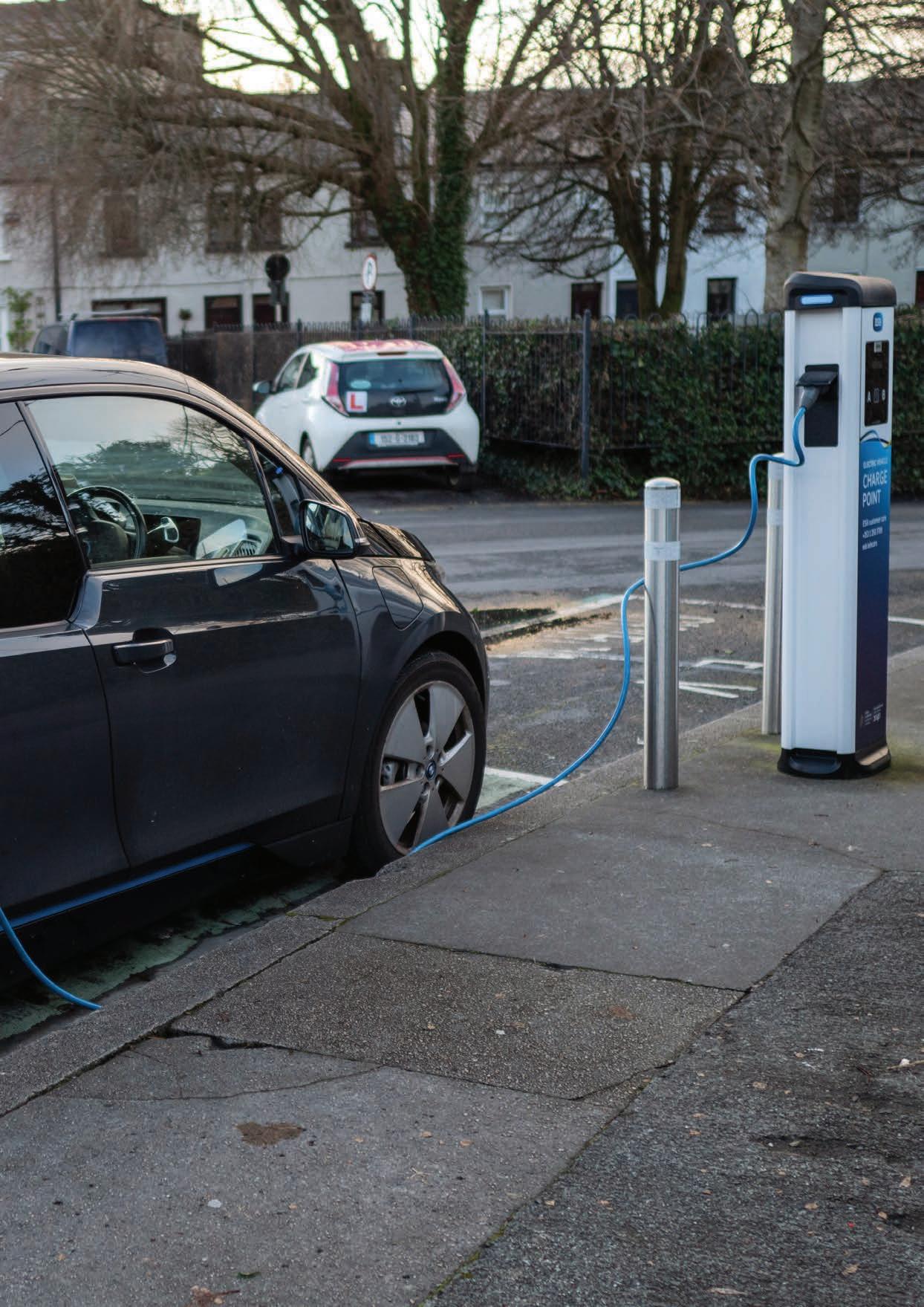

is still support at the regional and city level. In the EU, the increased CO2 emissions standards, backed by the Net Zero Industry Act and other legislation have increased ambition to 2035. In the USA, the Inflation Reduction Act (IRA) has set new incentives for carmakers to produce EVs in North America. Countries like Australia are now also setting ambitious CO2 standards which will drive EV sales.”
Shipping and biofuels
In shipping, biofuels are to be increasingly used, reaching about 20 per cent of fuel demand, but due to limits on sustainable biomass availability and competition with the aviation industry, McDonagh asserts that though much of the early progress has been made in methanol, ammonia could emerge as the most dominant low carbon emission fuel in 2050, meeting about 50 per cent of fuel demand.
“Hydrogen, which is not as well suited as ammonia or biofuels for long, transoceanic journeys, is used for shorter range coastal vessels. Hydrogen reaches 15 per cent of shipping fuel demand in 2050, and the other 15 per cent of fuel still comes from oil.”
McDonagh states that it looks likely that any low or zero carbon fuel suitable for shipping will be “more expensive than the fossil fuels currently used”.
“The adoption of low and zero carbon fuels is likely to require setting some form of price mechanism that aims at creating greater market equality.”
Changing behaviour
Although he acknowledges that behavioural change is an “important tool,” McDonagh says that “the scale of the effect [of behavioural change] though significant, can be easily overstated”.
“The vast majority of the heavy lifting comes from electrification, and in places where behaviour is key such as aviation, options like high-speed rail present an often better – or at least more palatable – approach than cutting flights.
“I believe many flights can be cut with little effect on people such as business flights, but in general modal shift is more effective. I think France’s law that prioritises trains over planes is a good example of this.”
“Reducing business travel and long-haul flights (over six hours flying time), predominantly in advanced economies, saves around 170 MtCO2e, or 40 per cent of the remaining emissions from this sector in 2050,” he says.
This also reduces demand for modern bioenergy by 1.5EJ, or 3 per cent, in 2050, which McDonagh analogises as “planting a land area roughly the size of Greece”.
Although 60 per cent of car sales being electric vehicles by 2030 is achieved in the IEA’s net zero emissions by 2050 scenario, four-out-of-five cars on the road are still internal combustion engines. In the net zero emissions by 2050 scenario, behavioural changes such as restricting the use of conventional vehicles in large cities cuts CO2 emissions from road transport by 15 per cent or 700 MtCO2e in 2030.
Achieving the necessary emissions reductions in end-uses without such behavioural changes would require “ramping-up low carbon technologies at even more staggering speeds”.
Concluding, McDonagh reiterates that the key to achieving a sustainable transport system which can support a net zero future remains electrification and its supporting infrastructure, with hydrogen and biofuels playing a large role in the medium to long term, all the while supported by the adoption of behavioural change.
47 transport report
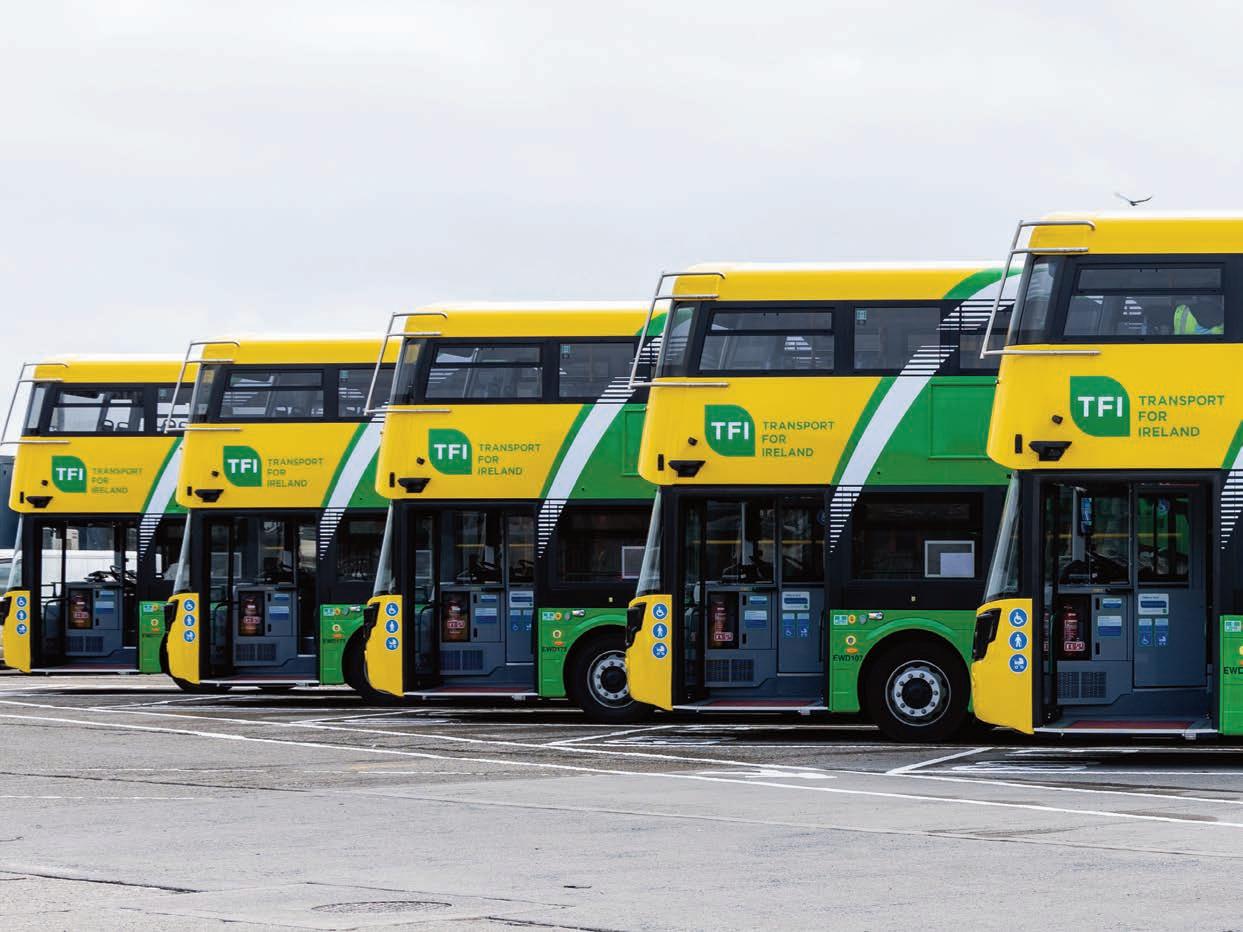
NTA driving progress on BusConnects plans
NTA’s ambitious BusConnects programme is starting to make an impact with real progress across all aspects of the plan. As planning applications for infrastructure are granted, and as new routes and improved services are developed and implemented, we are beginning to see BusConnects deliver for people and communities in our cities, writes Anne Graham, NTA CEO.
The BusConnects Programme is a strategic national-level programme aimed at enhancing sustainable transport across five regions in Ireland— Dublin, Cork, Limerick, Galway, and Waterford.
The vision of the BusConnects Programme is to connect people and places through an enhanced bus system while also improving cycling and pedestrian facilities.
The scale and transformative potential of the BusConnects Programme reinforces its central role in influencing the future roadmap of Ireland’s transport system.
It delivers on commitments within the National Development Plan 2021-2030,
the Transport Strategy for the Greater Dublin Area 2022- 2042, the Climate Action Plan 2023, and the National Planning Framework 2040
Details of the Programme were announced in 2018, and now the plans are coming to fruition. Since January, An Bord Pleanála has approved the development of four new bus corridors in Dublin, marking a significant milestone for NTA. These corridors are part of our overall strategy to enhance the efficiency and reliability of the bus network in Dublin and its surrounding areas.
Each of these corridors: Clongriffin; Liffey Valley; Ballymun/Finglas; and Belfield/Blackrock are designed to address specific areas of need by
making bus services more useful for more people.
These bus corridors will not only benefit passengers by providing faster and more reliable bus services but will also help to reduce congestion and air pollution in Dublin. By encouraging more people to use public transportation, the NTA is contributing to a more sustainable and environmentally friendly transport system.
Overall, the approval of these four bus corridors marks a significant step forward for public transportation in Ireland, and the NTA’s efforts to improve the bus network are sure to benefit passengers and the environment for years to come.
It is expected that the first two contracts will commence construction in the first half of 2025, followed subsequently by the award of an additional two schemes for construction.
Implementing the redesigned network of bus services for Dublin, a related but separate part of BusConnects, is making even more progress.
48 transport report Advertorial
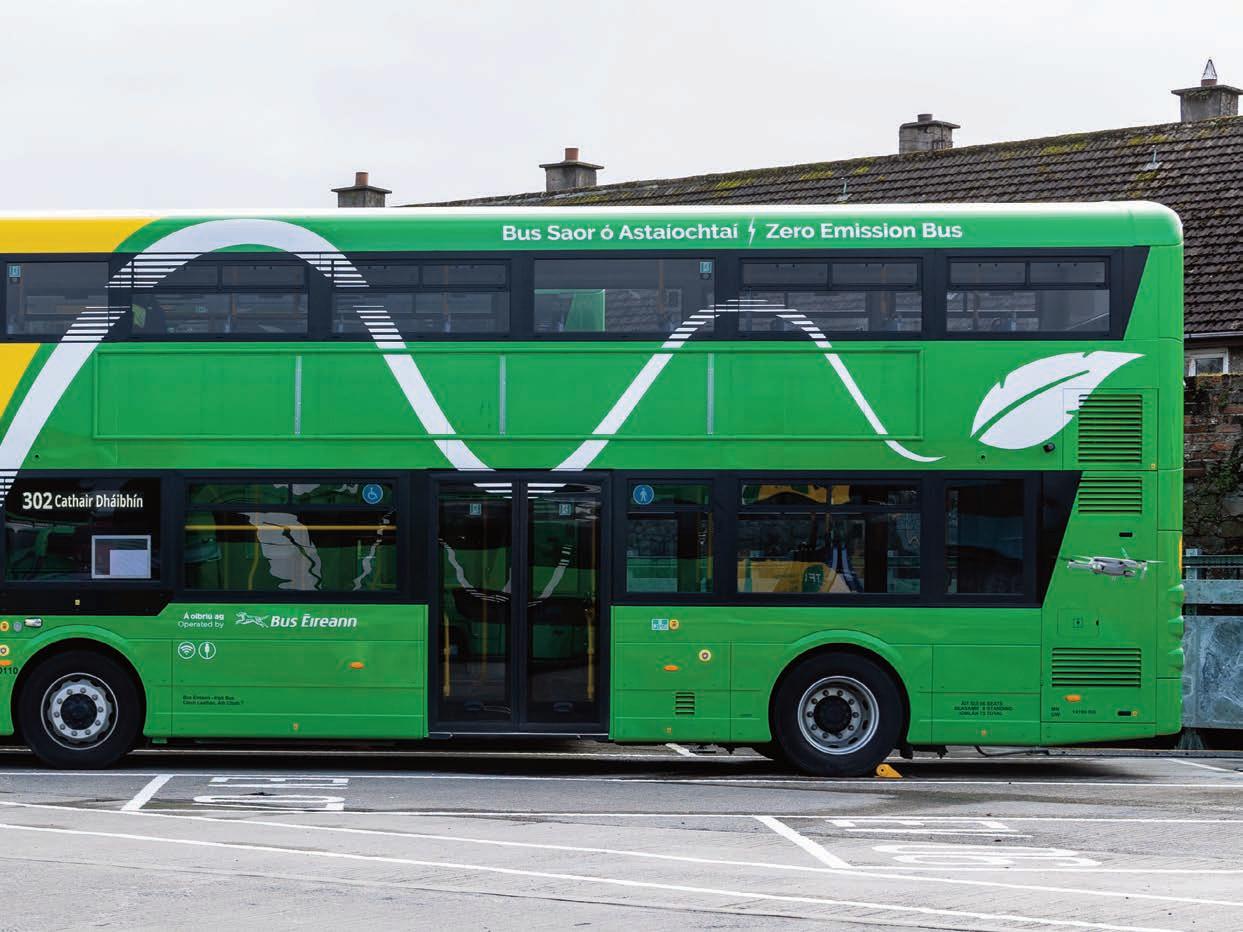
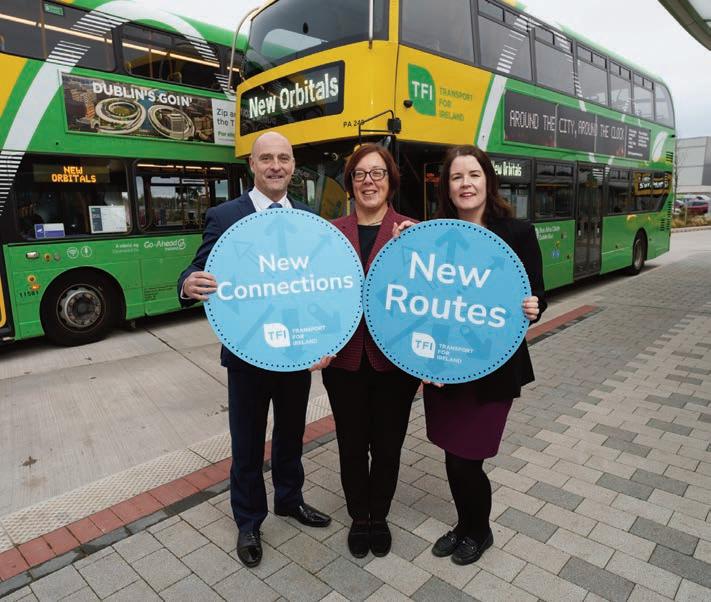
The re-imagined network is based on a structure of eight high-frequency spines, augmented by new local, orbital, and radial routes.
This will mean more frequent services particularly at off-peak and at weekends, new 24-hour services, and better connectivity and coverage including more orbital connections.
Following three rounds of public consultation that began in 2017, the NTA finalised and published the new Dublin area bus network in September 2020. The overall objective of the new network is to provide a network that better meets the needs of the overall region, taking into account the growing population and changing travel patterns.
Key characteristics of the proposals include a simpler network centred on eight main spines labelled A to H, more frequent services, particularly off-peak and at weekends, plus better coverage of the city including more orbital connections.
This new bus network plan took into account feedback provided by over 72,000 submissions at various stages of public consultation.
Key performance indicators (KPIs) are being used to measure the progress and realisation of network redesign and the broader BusConnects Dublin Programme benefits as the project rolls out. These KPIs include passenger boardings, punctuality, regularity, reliability, and access to opportunities, with improvements reported across the board as the phases are rolled out.
The increased coverage and frequency of services associated with the Network Redesign Phases introduced to date have resulted in a large increase in the number of people in Dublin who have access to frequent public transport services to avail of employment, retail and social opportunities.
The new network is being implemented over 11 phases. Five of those are already complete, with two more to be delivered by the end of 2024.
The response by the travelling public has been very positive, with passenger growth in areas where the new network is in place substantially outperforming the growth on the rest of the network.
We hope to provide similar improvements to networks in our regional cities.
After two rounds of public consultation in Cork city, we are planning to increase overall services by over 50 per cent starting in 2025. This will include two 24-hour bus services, seven all-day high-frequency bus routes, and brand new routes to previously unserved areas such as Upper Glanmire, Waterfall, and Kerry Pike.
The new network for Limerick city is scheduled to be introduced in 2025. Under this plan, service levels are to increase by 70 per cent, thanks to the extension of bus services to new areas, more routes with frequent services, and an enhanced Sunday timetable. We also want to introduce a new 24-hour bus service operating between University Hospital Limerick, the city centre and the University of Limerick.
4 49 transport report Advertorial

For Galway city, the new bus network will enable more people to avail of public transport resulting in increased access to a greater number of schools and workplaces across Galway city, Bearna, and Oranmore. Under the new plan, 67 per cent of residents will live within 400 metres of a high-frequency bus route.
Meanwhile, public consultation for a new network in Waterford city is getting underway in July 2024.
Transitioning to zero-emission vehicles is a core aspect of the BusConnects programme and there are now battery-electric buses operating in three centres, with NTA taking the lead in procuring and purchasing the vehicles to be deployed on our city and town services.
Bus Éireann’s town service in Athlone became fully-electric in January 2023, and earlier in 2024, thanks to €54 million investment by NTA, a total of 34 new state-of-the-art double-deck battery-electric buses became operational on their city services in Limerick, with a further 21 to follow. Progress is also being made with Dublin Bus. At the end of last year, NTA investment enabled the electrification of their Summerhill depot, followed earlier this year, by the Phibsboro depot. By August 2024, some 100 zero-emission vehicles will be operational in the Dublin fleet, offering a better experience for customers and cleaner air for the city.
The NTA intends that 85 per cent of the Dublin Metropolitan Area urban bus network will be operated by low and zero-emission buses by 2032, and solely by zero-emission buses by 2035.
BusConnects also provides for a major
programme of investment in Next Generation Ticketing (NGT). The ticketing system on rail and bus is approaching the end of its useful life and requires updating to a more modern, faster and more efficient system.
As part of the BusConnects Programme, a new ticketing system will be introduced which will incorporate the latest developments in accountbased ticketing technology, including allowing the use of credit/debit cards or mobile devices as a convenient means of payment. It will also facilitate more ticketing innovations which cannot be currently provided in the existing system, as well as allowing for a more efficient process of altering fares.
Following a highly competitive procurement process, the NTA awarded, in April 2024, an overall framework contract for the design, supply, installation and operation of a new multimodal ticketing system to a Spanish information technology company – Indra Sistemas S.A. –who have designed, installed and operated similar systems internationally.
This is a large and complex technology project and it is likely to take three to four years to fully roll out the new system. Exact timelines will be finalised in the coming months as the newly appointed supplier commences the detailed design stage of the project.
BusConnects also promised a simpler fare structure, and for the Dublin area, this was introduced in November 2021.
The central component of the new structure is a 90-minute fare (TFI-90) that allows customers to seamlessly switch between any combination of bus, DART, commuter rail and Luas services at
to zero-emission buses 50 transport report Advertorial
Transition

no extra cost subject to commencing the last leg within 90 minutes of first boarding.
The new system has dramatically improved the ease and convenience of movement between different modes of transportation and different services of the same transport mode, opening up exciting new travel opportunities for many people.
The TFI-90 fare currently stands at €2, offering unprecedented value to all users.
The BusConnects Dublin Programme includes the construction of enhanced bus stops and shelters across Dublin to align with the redesigned network and Core Bus Corridors.
Along the 12 Core Bus Corridors, enhanced bus stops, most to be equipped with bus shelters and real-time passenger information signs, will be provided as part of the construction of the individual corridors.
Along the other sections of the new bus network, new TFI bus poles are being installed in tandem with the roll-out of the different phases of that network.
The BusConnects Programme represents a transformation of the city bus service. Rather than focusing solely on individual projects, BusConnects adopts a holistic approach for the Programme to deliver outcomes that
exceed the sum of its parts. By seamlessly integrating bus corridors, cycling infrastructure, pedestrian pathways, new routes, fares, livery, stops and shelters, zero-emission fleet and a new ticketing system, the Programme aims to improve the bus service in a way that brings more value to the user than benefits from individual projects.
Although benefits have already been realised on components of the BusConnects Programme initiated to date, it will continue to deliver for the public well into the future.
While the implementation of the various aspects of BusConnects is only now gathering pace, the benefits are already being felt.
Zero-emissions vehicles now in operation offer a better experience for customers and cleaner air for communities.
The new network is already providing earlier starts and later finishes, more 24hour services and new orbital routes. This enhanced connectivity is creating a public transport system that is more useful to more people, with members of the public responding by using city bus services in greater numbers than ever before.
The TFI-90 fare has made it easier than ever to interchange from one service to
another or one mode to another and offers great value to all users.
And there is more to come.
The completion over the coming years of our core bus corridors, with the bus priority they offer, will lead to faster bus journeys, along with greater punctuality and reliability, making the bus an even more attractive option.
The new network, when completed, will mean that whether it is for work, learning or socialising, all users will benefit from greater connectivity and integration, encouraging more people to get on board.
This is what BusConnects is all about. Connecting people and places by putting the bus at the heart of our cities.
T: +353 1 879 8300
E: info@nationaltransport.ie
W: www.nationaltransport.ie
51 transport report Advertorial

Shaping Possibilities

‘Decreasing congestion’ key to reducing transport emissions
The demand management strategy focuses on transport-oriented development to achieve national climate objectives.
Moving Together: A Strategic Approach to the Improved Efficiency of the Transport System in Ireland aims to alleviate the economic and social costs of congestion and car-dependency in tandem with investment and scale-up in public transport, active travel, and EV infrastructure. With the number of licensed vehicles having increased by 215 per cent from 915,000 in 1985 to 2.9 million in 2021, the strategy unsurprisingly highlights the car as the most dominant form of inland transport in Ireland.
Recognising that the car will remain the dominant mode of transport for many people, the Strategy states that the Government is mindful of the needs of people for whom the car is the only viable transport choice, namely “captive car-users”.
Focusing on the impetus arising from commitments in Climate Action Plan 2023, which sets a target of achieving a reduction in 20 per cent in total vehicle kilometres and a reduction in fuel usage of 50 per cent by 2030, Moving Together intends to improve journey times for car drivers, public transport users, business, and freight, thus leading to “improvements in local air quality and reduced stress with associated health benefits for drivers and non-drivers alike”.
Furthermore, the Strategy aims to form a key part of the Government’s decarbonisation pathway for the transport sector and states that it “aims to go hand-in-hand with government investment and supports already in place or planned for public transport, walking, cycling, and electric vehicles”.
Whilst the strategy does not contain a prospective series of actions, there is acknowledgment that it instead “provides a firm policy direction and suite of options –such as road space reallocation, progressive taxation, freight efficiency, or behavioural incentives”.
In respect of this, the recommendations intend to provide guidance needed for local authorities and local council representatives to develop plans for their own areas.
On a broader context, the strategy states that it aims to provide an overarching framework for the development and delivery of potential demand management.
The strategy outlines: “In the Greater Dublin Area, congestion was estimated to cost the economy €336 million in 2022, rising to about €1.5 billion by 2040. Nationally, congestion is projected to cost €2 billion by 2040. There are also many significant environmental, health and social costs, including poor air quality and the negative impacts of stress, inactivity, or time away from family or community.”
However, the strategy also states that the benefits of current and future government investment and supports in public transport, walking, cycling and electric vehicles “cannot be fully realised while current levels of congestion remain”.
52 transport report
Shaping Possibilities


According to a recent OECD report, Ireland’s transport system is “car dependent by design” and requires systemic transformation to reverse a car-centric model which has dominated planning and settlement patterns for decades. The recent National Household Travel Survey 2022 (NHTS) reported that almost seven in 10 (69 per cent) journeys in Ireland are made by car, with trips below 3km accounting for over a third (35 per cent) of all journeys nationally.
Reducing travel demand
Aiming to be high level in nature, the strategy sets out 35 specific recommendations to reduce travel demand across society and the economy.
The recommendations are spread across the following themes and include:
• strengthening implementation of demand management across the national planning system;
• embedding the polluter pays principle in taxation policy over the medium to long-term;
• empowering and supporting local authorities to develop local-based transport plans;
• driving efficiency in the freight sector;
• strengthening supply side measures in public transport and active travel to complement demand management;
• providing enabling legislation to support appropriate measures to be taken;
• embedding demand management principles and practices across the public sector, making it a leading institution for change.
• engaging with education and sports sectors to embed demand management principles and practices;
• engaging with the business sector to embed demand management principles and practices;
• building the evidence base to inform policy choices and demonstrate success.
Minister for Transport Eamon Ryan TD says: “This strategy is a critical piece in the decarbonising jigsaw for transport, but its benefits are much wider than climate. It is about re-imagining and re-allocating our use of space, and about putting people, rather than cars, at the centre of our urban and transport planning, ensuring better and more liveable towns and cities. This does not mean that cars will not continue to be a vital part of our transport mix – for many people, particularly in rural or isolated areas, they will continue to be critical. However, what this strategy is about is finding innovative approaches to making travel, by whatever means, more efficient and pleasant for everybody.”
The Irish Planning Institute President Gavin Lawlor says: “Transportoriented development is key to us achieving our national climate objectives, however delivering on this ambition requires the acceleration of overdue planning guidelines and the delayed revision of the National Planning Framework, with more analysis of the reasons why urban sites are not being brought forward for development.
“All of this means that we need more coherence across local authorities, including parking standards for new developments, and delivering alternatives to car dependent housing.”
53 transport report

Shaping Possibilities

How
do you drive
social value and sustainability in transport infrastructure projects?
Jacobs Senior Stakeholder Engagement and
Communications Professional Matthew Nebbett shares his project insights with using stakeholder engagement to drive a triple bottom line in major infrastructure.
Spoiler alert: There is no simple answer. Achieving social value and sustainability in transport infrastructure projects demands a meticulous blend of talent, technology, and strategy. Each project is a unique puzzle, shaped by the local context and the client’s needs. When you factor in the influences of climate change, economic pressure and political uncertainty, you are faced with one of the most formidable infrastructure challenges in the world.
However, we do know one of the greatest ingredients for success –stakeholder engagement. It is both the fuel and the glue for these projects; it lays a deeper, more resilient foundation for collaboration and innovation across partners and communities. If done
correctly, it also uncovers more opportunities for social value and sustainability.
I have been privileged to work on several major infrastructure projects. These types of projects require massive construction at scale, which can heavily impact local communities in the short term, especially in urban areas.
Navigating this disruption requires strategies built on industry experience and data-driven insights and upgraded with the latest digital tools for communications, consultations, planning and engagement. It also requires a sustainability and social value lens in all decision-making. These are the lessons I have learned from over 30 years of engagement with local authorities,
multinational companies, and, most importantly, the public.
Take stakeholders on a journey, starting with the ‘why’
The motivation for better urban transport is clear: the most successful cities by any measure – including economic, environmental and social value – have efficient, sustainable and affordable public transport and insight-led transport infrastructure. This is bolstered by active travel options and inclusive design.
Improving these veins and arteries of a city has a knock-on effect, as it drives up productivity and economic opportunities. It has proven to make life
54 transport report Advertorial
Shaping Possibilities
better, cleaner and healthier for all citizens in the long term, but there is an asterisk. Achieving it requires disruption in the short term, and this needs to be carefully explained. All stakeholders need to understand the ‘why’ behind the project and be constantly reminded about the triple-line benefits. This is where multimedia communication technology, especially the remote, visually-based options, can help easily share the stories and narratives behind the long-term vision and changes needed.
Steer clear of silence and location silos

to engage their constituents more effectively by providing them with the answers they need. Get this right, and they will become positive ambassadors for your project.
Instant feedback and data insights are gifts
“Building sustainable transport infrastructure that offers lasting positive outcomes is a massive, complex challenge, but it is also arguably the most effective way to upgrade cities.”
Silence on a project will be filled up with either fake news or speculation – both drive unnecessary friction. On a previous major project over two years, we constantly drove community education and engagement, and it meant we received just under 300 complaints across the lifespan – which is very low considering the scale of the project. We always gave the worst-case scenario and ensured there were no surprises – critical on any project.
The goal is to help the stakeholders plan their lives better. In most cases, it is not just the residents you are speaking to. For example, on a street closure, you must let the local resident’s association and council know and put notices up for anyone using the road. It unlocks a ripple effect – you cannot have a mindset that your work only occurs within set boundaries. Share that information more widely, and you will reduce the disruption.
Share a tailored toolbox of information
Your stakeholders will have different motivations, so you need to offer a selection of information triggers to satisfy them all. For some, it will be cost (cheaper transport) or ease of use (less traffic or transport time), while others will be focused on the environment (cleaner air and zero carbon options).
Early in my career, I picked up an apt description for this: Your information should be offered like a chest of drawers. Start with a menu, then provide detailed information in a drawer to suit the need. This information can also help educate and empower government officials (Teachtaí Dála [TD] and key community figures), as they will be able
I am old enough to remember a time of slower communication thanks to landline phones and letters. Everything is now instant, and while it is more time and attention-intensive and drives up scrutiny, it also offers the huge gift of fast, recordable feedback. This offers a treasure trove of information and can lead to more innovation – especially within social value and sustainability.
We can also safely and responsibly store anonymised, aggregated data on stakeholders, which makes it much easier to build relationships and raise collective project awareness. An example of that was with a pensioner in a neighbourhood where we were closing a road for construction. She recently had major heart surgery and was worried that she would not have access to her medical appointments due to the road closure.
She contacted us through one of the project channels, and thanks to our bespoke digital engagement tools, we captured all her medical appointments in our secure system. That meant anyone on the team could step in and help get her to her appointments, ensuring that our equipment and diggers were turned off and the road was clear as workers took lunch breaks over her appointment times.
Building sustainable transport infrastructure that offers lasting positive outcomes is a massive, complex challenge, but it is also arguably the most effective way to upgrade cities. These projects offer a proven formula for making citizens’ lives easier, better and healthier. The secret to getting that right is connecting and collaborating with stakeholders to make the right changes happen and unlock more social value and sustainability opportunities.
W: www.jacobs.com



55 transport report Advertorial

Shaping Possibilities

Explaining the EV slowdown in the EU
Lucien Mattieu, Cars Director, Transport and Environment, Brussels, talks about the slowdown in the adoption of electric vehicles (EVs) currently taking place throughout the EU.
Although, in 2023, electric vehicles (EVs) accounted for 18.6 per cent of overall car sales in Ireland – a statistic which makes Ireland stronger in this area than all other countries in western Europe and the Nordic states with the exception of Belgium – there has been a slowdown in purchases throughout the EU following an initial sales boom.
Following the approval of the European Green Deal in 2020, sales of EVs spiked. Road transport accounts for a majority of EU emissions within the transport sector, and industry has been encouraged to adapt to long-term net zero obligations, with grants being offered to many EU citizens to encourage them to buy EVs.
However, the acceleration of this growth has slowed. This, according to Mattieu, is down to a number of factors, among which he describes as “inadequate” emissions reduction targets for 2029.
He explains: “Industry was sprung into action as there were new targets in 2020/2021. That is why there was an initial increase in EV sales. Unfortunately, the emissions reductions targets to 2029 are not very stringent, which means that interim emissions reductions targets can be met with just 22 per cent electric car sales.”
In the long term, EU car sales must be at least 60 per cent electric from 2030, with a 2035 target of ensuring that all car sales are electric vehicles.
In the two years where there is available data, Mattieu states that there has been a “sudden drop in the sale of small electric car models”. He rationalises: “In the last couple of years, car manufacturers have been prioritising the sales of larger car models such as SUVs which is being driven by a desire to make more profits.”
56 transport report
Shaping Possibilities

The EV market outlook (EU27)

Source: Transport and Environment.
Affordability
Referring to a survey of European car drivers carried out by Transport and Environment, Mattieu claims that if a smaller, affordable electric car was available on the market, this could significantly increase demand for electric cars from the current figure of 25 per cent of EU citizens interested in EVs to 35 per cent.
“We must reflect on what we consider affordable, because the average consumer in the EU does not have the ability to buy an electric vehicle, which costs minimum €25,000. People have this aspiration, so it is important to ensure that the EV market meets demand with production levels in the right volumes.”
Increasing the affordability of electric vehicles is an approach being taken by the Government of France. Mattieu explains: “What the French Government is doing, in a nutshell, is providing low income households with the opportunity to have an electric car for €100 per month. The [French] Government is essentially introducing a state-backed sponsorship scheme with subsidies that are targeted and ensuring that the people who have the lowest income have the ability and affordability to access these cars.”
Conclusion
Looking at the transport sector more broadly, Mattieu reflects that the overall objective of the transport sector throughout the EU is to ensure that all member states are able to meet net zero obligations.
He states that electric vehicles are “part of the solution”, but also outlines that other measures which decrease the volume of vehicles on the road is another branch of this wider strategy.
He states that while there is an EV slowdown, that the French Government provides the finest example of “perseverance” with the decarbonisation of transport.
With the French Government introducing both EV grants which make the vehicles affordable for lower-income French citizens, as well as a trebling parking fees which aims to disincentivise wider vehicle use in the French capital, Paris, he is optimistic that the road to net zero in the transport sector is “going in the right direction”.
“We know that a lot of cities are looking very closely at what Paris is doing and could aim to replicate it, so it sends an important signal. We need this kind of wide policy toolbox to ensure that every transition in the EU is affordable and environmentally responsible,” he concludes.
57 transport report

Bringing the vision to reality: Iarnród Éireann rail and port investment powering ahead

Capital investment in rail and Rosslare Europort has firmly moved from planning to delivery stage says Jim Meade, Chief Executive of Iarnród Éireann.
Our vision of being the backbone of Ireland’s sustainable transport network is clear and has rapidly moved from the vision to the planning stage, and now with the support of government and the National Transport Authority for the capital investment to achieve this, we are firmly in delivery mode.
Across all aspects of our business – for passenger and freight services on our rail network, and as Port Authority for Rosslare Europort – the decade of delivery is underway.
DART+ Programme
Already, 185 carriages of the new DART+ fleet are on order from Alstom –construction of the first two 5-carriage trains are well advanced, and they will arrive in September 2024. A detailed testing and regulatory approval process must follow for the first trains in the fleet,
which will see them entering service from late 2025 / early 2026.
The order could potentially increase to 750 carriages over the decade as the DART+ Programme develops, and as options for supporting infrastructure for battery-electric versions of the train are considered for rail services in Cork, Wicklow and elsewhere.
The fleet order is an integral part of DART+, an investment will see double the passenger capacity and treble the electrification across all Greater Dublin Area rail services.
National network
Investment in infrastructure in the Dublin area will also grow our ability to operate services right around the country. Targeted line speed improvement works are also taking place. Construction of
the new National Train Control Centre at Heuston Station has been completed, with train control systems being developed for full commissioning by 2025, to deliver more efficient train management across the network, to cater for the expanded network and services.
Regional cities
€185 million is to be invested in the Cork commuter rail network, under the EU-funded Recovery and Resilience Plan, allowing Iarnród Éireann to treble the Cork commuter rail network’s capacity through:
• double-tracking Glounthaune to Midleton;
• developing a new through platform at Kent Station for through running for Mallow to Midleton/Cobh; and
• resignalling the Cork commuter network.
All three elements are now underway. Additionally, in May of this year, the planning process for the next phase of the Cork Area Commuter Rail Network investment began. Multi-disciplinary consultants have been appointed to support a railway order application process for eight new commuter stations, a new fleet maintenance depot, and the electrification of the Cork network.
In Galway, funding under the Urban Regeneration Development Fund (URDF) includes:
• investment for a 1km section of second track and a new platform at the existing Oranmore Train Station, which will allow the busy commuter link between Athenry and Galway to grow – a planning application was submitted in May 2024.
• Ceannt Station is being regenerated as part of a major Galway City Council Transport Connectivity project, with works underway since January 2024.
58 transport report Advertorial
The new National Train Control Centre will manage the entire rail system, improving safety and performance, and allowing for future expansion.

In Limerick, the completion of the city’s own transportation hub centred on Colbert Station will also boost services, and the Limerick Shannon Metropolitan Area Transport Strategy has detailed the opportunities provided by the network of rail lines around Limerick City. Plans for new stations at Moyross and Ballysimon are currently progressing, and capacity studies are underway for Limerick Junction to Limerick to Ennis.
Waterford’s Plunkett Station is being relocated to be part of an integrated transport hub under plans to develop the city’s North Quays.
Rail freight and Rosslare Europort
Iarnród Éireann’s Rail Freight 2040 Strategy aims to achieve:
• a five-fold increase in the number of rail freight services;
• a resulting reduction of 25,000 tonnes of CO2 emissions annually; and
• avoiding the requirement for 140,000 HGV journeys on our roads annually.
Works to reinstate the Limerick to Foynes rail line for freight services are underway following funding from the Department of Transport, a clear commitment to the goals of Rail Freight 2040, with a 2025 completion date planned.
Iarnród Éireann is also port authority for Rosslare Europort, and its status as Ireland’s Gateway to Europe has been confirmed with 36 services operating
Project Serving Update Next steps
DART+ West Maynooth/M3 Parkway to City, including new depot West of Maynooth
DART+ South West Hazelhatch to Heuston and Phoenix Park Tunnel
DART+ Coastal North Connolly to Drogheda
Railway order hearing held November 2023
An Bord Pleanála decision pending
Railway Order application lodged March 2023
Government approval to move to railway order phase
DART+ Coastal South Connolly to Greystones Emerging preferred option being developed
DART+ Fleet New trains for all DART+ routes above
directly between the port and Europe each week.
As well as investment in the Port Masterplan, the OPW’s Project T7 for a permanent border control post, and the new TII N25 Rosslare Europort Access Road, an ambitious €200 million plan to become Ireland’s offshore renewable energy hub, with the port uniquely placed to support the development of the industry in the Celtic and Irish seas.
185 DART+ carriages ordered
An Bord Pleanála decision pending
Railway order application expected to lodge imminently
Public consultation Q3 2024
First carriages arrive September 2024 enter service after testing and approval process late 2025/early 2026
Our journey to our sustainable future is to a destination which will benefit our country, our environment, our communities and our society as a whole, and everyone is welcome on board.
W: www.irishrail.ie X: @irishrail
Investment is progressing in all major cities on the network, with Ceannt Station in Galway works under way to transform the station into an integrated transport hub in the heart of Galway City.
59 transport report Advertorial

Shaping Possibilities
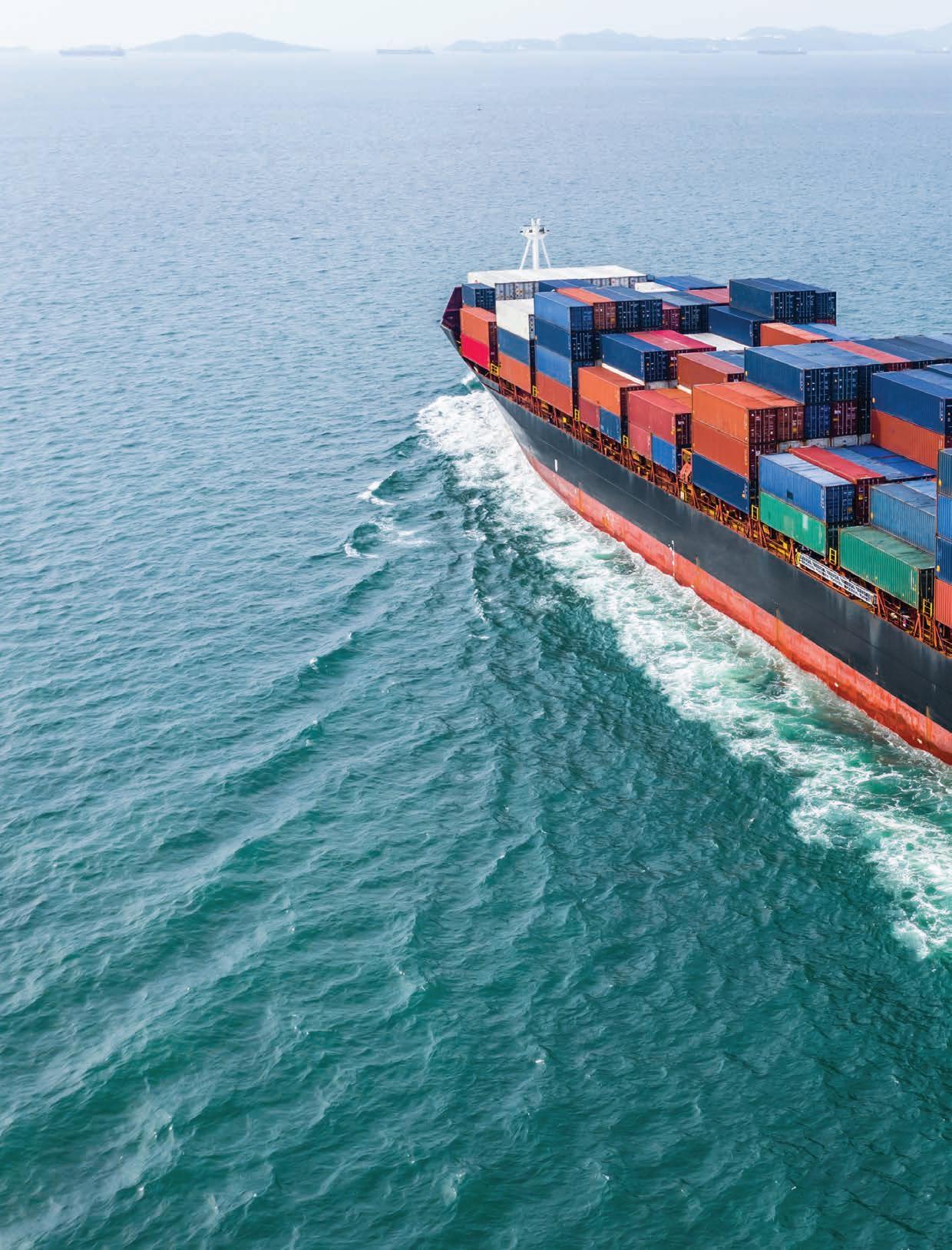
EU targets major maritime emissions reduction
In January 2025, the FuelEU Maritime Regulation will enter into force, setting maximum limits for the average greenhouse intensity of the energy used by ships at European ports above a gross tonnage of 5,000.
Targets will ensure that the greenhouse gas intensity of fuels used in the sector will gradually decrease over time, starting with a 2 per cent decrease by 2025 and reaching up to an 80 per cent reduction by 2050.
The European Commission states that the targets will become “more ambitious over time” to stimulate and reflect the necessary developments in technology, as well as uptake in the production of renewable and low-carbon fuels.
Underpinning this is a proposed new incentive regime to support the uptake of renewable fuels of nonbiological origin (RFNBO) with a high decarbonisation potential, as well as the exclusion of fossil fuels from the regulation’s certification process.
The targets cover not only CO2 but also methane and nitrous oxide emissions over the full lifecycle of the fuels used onboard, on a well-to-wake (WtW) basis.
The Regulation also introduces additional zero-emission requirements for ships at berth, mandating the use of on-shore power supply (OPS) or alternative zeroemission technologies in ports, by passenger ships and containerships, to mitigate air pollution emissions in ports, which are often close to densely populated areas.
By taking a life-cycle, goal-based, and technology-neutral approach, the Commission is confident that FuelEU Maritime allows for innovation and the development of new sustainable fuels and energy conversion technologies, offering operators the freedom
60 transport report
Shaping Possibilities


to decide which fuels to use based on ship-specific or operationspecific profiles.
The Regulation also provides for different flexibility mechanisms, aimed at supporting existing fleets to find suitable compliance strategies and incentivising companies by rewarding first-movers for early investment in energy transition.
The FuelEU maritime initiative is part of the Fit for 55 package. Presented by the European Commission on 14 July 2021, the package aims to enable the EU to reduce its net greenhouse gas emissions by at least 55 per cent by 2030 compared to 1990 levels and to achieve climate neutrality in 2050.
FuelEU Maritime will enter into force from 1 January 2025 except for Articles 8 and 9 on monitoring plans which shall apply from 31 August 2024.
International Maritime Organization strategy
In July 2023, shortly prior to the passage of FuelEU as part of the EU’s Fit for 55 package, the International Maritime Organization adopted a revised strategy for the reduction of greenhouse gas emissions from ships internationally, which forms the basis of the EU regulation.
The IMO strategy includes a provision for an economic element on the basis of a maritime GHG emission pricing mechanism.
With the support of Minister for Transport Eamon Ryan TD, global governments are in agreement, with the revised Strategy setting a goal of net zero greenhouse gas emissions from ships by or around 2050. This is a significant increase in ambition compared to the initial 2018 strategy which targeted a 50 per cent reduction compared to 2008 levels.
The IMO strategy has introduced important indicative checkpoints along this 2050 pathway. The 2030 checkpoint is set at reducing GHG emissions from ships by at least 20 per cent, while striving for 30 per cent. For 2040, this stands at 70 per cent while striving for 80 per cent in 2040. Both checkpoints are in comparison to 2008 levels.
Significantly, the strategy includes a basket of candidate mid-term GHG reduction measures including an economic element on the basis of maritime GHG emissions pricing.
Speaking following the negotiations resulting in the IMO strategy, Minister Ryan said: “It is really encouraging to see that this globally agreed strategy, which will accelerate the sector’s transition away from polluting fossil fuels, now also, significantly and bravely, provides for a pricing mechanism.
“The key thing now is to go to the next steps, turning this agreed strategy into action.”
61 transport report
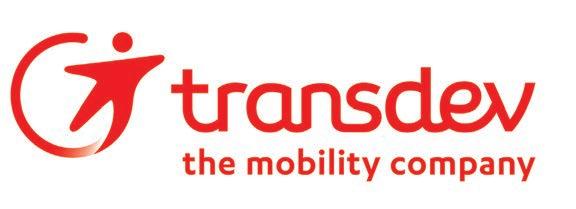
Transdev Dublin Light Rail: A track record of delivery

Marking 20 years of operating and maintaining Luas in Dublin, Eoghan Sweeney, Deputy Managing Director and Dave Rooney, Director of Operations with Transdev Dublin Light Rail (TDLR) speak with eolas Magazine about post-pandemic recovery, recruitment, and network extension.
Luas was launched in Dublin with the opening of the green line on 30 June 2004 followed by the red line three months later on 26 September. Following the official opening, 430,000 passengers availed of four days of free travel. Then-Minister for Transport, the late Séamus Brennan, remarked: “Today, Luas returned a tram service to Dublin, 45 years since it finished. It reflects a new vibrant Dublin and the country as a whole.” Brennan’s comments proved prescient.
Reflecting on this 20-year journey, the Deputy Managing Director expresses his pride that Transdev has operated and recently maintained the Luas for the entirety of its existence. “Luas has been hugely successful due to the really positive delivery by Transdev, with total passenger journeys increasing in 12 out of the 20 years,” Sweeney says, adding: “Today, one-in-five public transport journeys in Dublin are now taken via Luas, exceeding all targets that we had initially set.”
“Transdev is a great business to grow in.” Rooney observes, adding: “In fact, the driver of the very first tram in passenger service, Eddie Byrne, remains with the business today as a senior trainer.”
Having originally worked as a traffic supervisor in 2004, Rooney himself now sits in the same control room, as Operations Director. Likewise, Sweeney started his Transdev career interning as an infrastructure and vehicle maintenance coordinator in 2010.
Remarking on the low turnover of staff in Transdev – many of whom, like himself, have been with the company for 20 years – Rooney attributes this to the close relationships TDLR cultivates. “We are very much a trusted partner, not only with our clients, but also with the communities in which we operate and our staff, many of whom emanate from those communities.
“There is very much a family atmosphere within TDLR. It is palpable. Visitors to our Red Cow depot often remark on the huge enthusiasm exhibited by our people, both for light rail itself and for what we do: moving people. That is our defining mission.”
Agreeing with this assessment, Sweeney adds: “With an average of 150,000 passenger journeys delivered each day, everyone here is incredibly proud to work for Transdev and Luas to deliver that service.”
20th anniversary
Marking 20 years of TDLR and Luas in Dublin, the Minister for Transport will meet with Transdev, Transport Infrastructure Ireland, and the National Transport Authority for a celebration event at the St Stephen’s Green Luas stop on 30 June 2024. Internally then, TDLR will run a series of events to celebrate the last 20 years.
However, cognisant that the continued pursuit of its mission comes first, TDLR
62 transport report Advertorial
Eoghan Sweeney, Deputy Managing Director, TDLR
is not resting on its laurels. In fact, the day before the anniversary, 29 June, will be the busiest day in the Luas calendar year. “With the Dublin LGBTQ Pride parade coinciding with several other public events, we will carry in excess of 150,000 people in one day. After that we can celebrate,” says Sweeney.
Community engagement
With more than 400,000 people living within 1km of its network, Luas serves communities across Dublin – north, south, east, and west. Transdev is cognisant that public transport networks can act as a catalyst for environmental, economic, and social development.
As such, through its wider community engagement programme, TDLR seeks to support some of Dublin’s most disadvantaged communities through partnerships with Fettercairn Community, Ballyogan, and St Patrick’s Athletic Football Club, as well as 16 local schools.
“We have an ongoing project there with St Pat’s Athletic and the Football Association of Ireland whereby we educate young people about the Luas and its benefits, and also supporting them in their education and career journeys. For instance, we facilitate work experience and conduct mock interviews.
“Likewise, when partnering with Business in the Community Ireland’s Skills @ Work Programme, TDLR linked with St Aidan’s Community School in Tallaght. The programme comprised a series of workshops held in the Red Cow Luas depot, providing insight into how we operate, the experience of a typical working day, and how to prepare to leave education,” Sweeney outlines.
International footprint
Operating in 19 countries across five continents, Transdev employs over 100,000 people and is the leading operator and maintainer of light rail systems globally. “TDLR can draw on that expertise at any time if there is a challenge or a technical issue,” Sweeney explains.
“In 2022, for instance, as part of our business transformation we deployed 15 international experts across Dublin in support of Luas delivery. On the other hand, networks such as Sydney Light Rail have learnt a lot from Luas. Indeed, Brian Brennan, a previous Managing Director of TDLR is now the CEO of Transdev Australasia. It is a virtuous circle.”
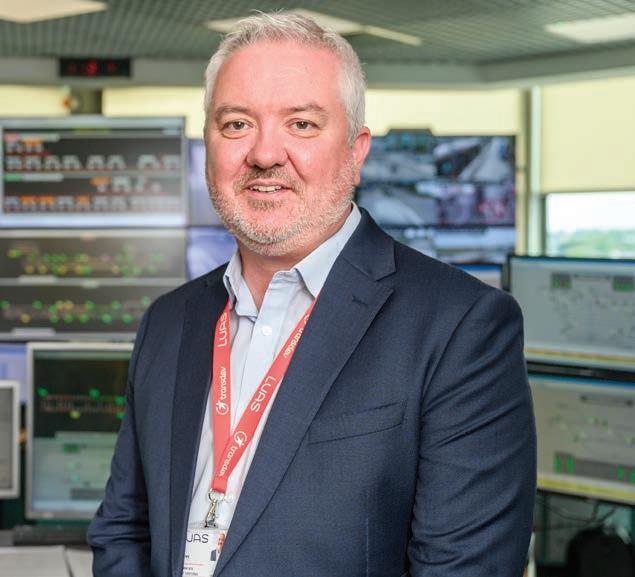
“TDLR recognises that for public transport to be a viable option for people in the Greater Dublin Area, it must be seamless.”
Dave Rooney, Director of Operations, Transdev Dublin Light Rail
Emphasising the role of this international experience and the support of the wider Transdev Group, the Operations Director believes that Luas would not have achieved the same level of success it enjoys today.
“Joining a company like Transdev, which has a significant international footprint of light railway operations elsewhere in the world and bringing a tram system back to Dublin after a 45-year absence was an incredible experience,” Rooney concurs.
Post-pandemic recovery
The Covid pandemic had a significant impact on Luas services. In 2023, however, a total of 48.2 million
passenger journeys signalled a return to the pre-Covid 2019 peak “well ahead” of other European light rail transit (LRT) systems.
Conceding that the Covid pandemic was “quite a challenging time” for TDLR, Sweeney emphasises that “we continued to deliver Luas services for essential workers throughout that time”. Emerging from the pandemic, Transdev Ireland then launched a comprehensive business transformation strategy.
“We transformed the business,” he asserts, adding: “This ensured that we delivered across each of our metrics, and we are now exceeding our performance targets.”
TDRL has also responded to the new
Dave Rooney, Director of Operations, TDLR
63 transport report Advertorial 4
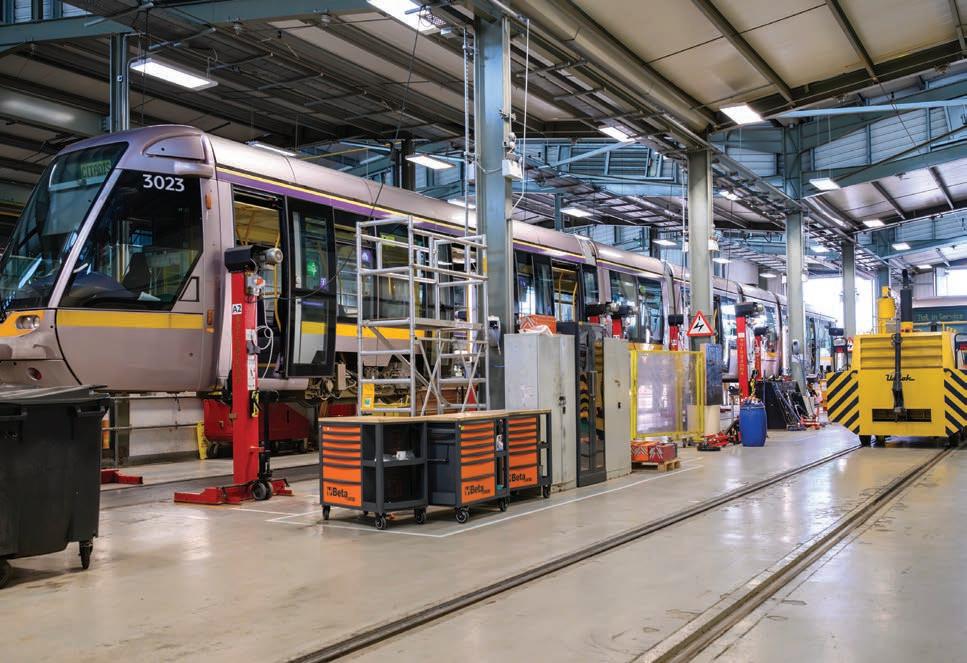
“We are second only to Dublin Bus when it comes to total passenger journeys taken on the island of Ireland.”
Eoghan Sweeney, Deputy Managing Director, Transdev Dublin Light Rail
post-Covid travel patterns which have resulted in “increased off-peak and weekend travel”. “We have responded by reviewing the frequency of services in the evenings and at weekends and are set to implement these changes later in 2024,” Sweeney states.
Recruitment
Post-Covid, recruitment also became a major priority for Transdev Ireland. With increased activity in maintenance alongside three major overhauls in the Luas fleet, TDLR recruited more than 150 staff between 2022 and 2023, bringing the net total to over 650. However, in a tight labour market, achieving this was a challenge.
“Previously, Transdev Ireland had a bank of applications from prospective drivers and maintenance technicians on file. Now, with the economy operating at virtually full employment, we have had to recruit elsewhere due to a talent shortage in the State,” Sweeney explains.
Success
Overall, while Luas came under intense scrutiny prior to its launch in 2004, the project has been a runaway success in terms of passenger growth. That popularity brings its own challenges, and while the initial trams were 30 metres in length, today the trams on the green line are among the longest in the world at 50 metres in length.
“As the economy has grown, more people need to move around Dublin. Luas is now the heavy lifter when it comes to moving those people. In fact, with a relatively small footprint, we are second only to Dublin Bus when it comes to total passenger journeys taken on the island of Ireland,” Sweeney indicates.
Discussing the success of the Luas, Rooney remarks on its global reputation.
“One thing people probably do not realise about the light rail tram system in Dublin it is how well regarded it is internationally, among other public transport authorities.
“For example, if we compare Luas to Manchester Metrolink – which is twice as large in terms of track, rolling stock, and stations – we are carrying significantly more passengers each year.
“Similarly, many people will be unaware that at peak hours we carry as many as 400 people on a single green line tram. Running at a peak frequency, that is the equivalent of a Boeing 747 landing at St Stephen’s Green every three minutes. Luas demonstrates an unrivalled ability to move people across Dublin, especially when compared to other modes of transport.”
Network extension
Commenting on TDLR’s “proven track record” in delivery network extension, Rooney references the period between 2009 and 2011 when three major
Maintenance work on a Luas tram in the Red Cow depot.
64 transport report Advertorial
extensions to the Luas network took place within 18 months.
“That type of delivery is complex. It involves significant collaboration with clients to support system integration and testing. It also requires recruitment of drivers, engineers, and maintenance technicians to service the additional fleet,” he says.
Indeed, the Deputy Managing Director stresses that the success of the Luas network extensions to date “would not have been possible if we did not work in a partnership with our clients, with other transport providers, local authorities, and with the emergency services”.
“We are a partner in terms of public transport delivery in Dublin. In TDLR, public service takes primacy. That, to me, is one of our unique selling points,” Sweeney says.
Reinforcing this theme, the Operations Director notes that “we work very closely the other public transport operators in the State”.
“TDLR recognises that for public transport to be a viable option for people in the Greater Dublin Area, it must be seamless. In Dublin, each of the operators exhibit that ability to collaborate to achieve this,” Rooney says.
Further planned extensions to the network include Luas Finglas, which is expected to enter operation between five and seven years from now, followed by Luas Lucan. At the same time, Transport Infrastructure Ireland (TII) is in the process of procuring a new fleet of trams to replace those currently in operation on the red line.
Luas Cross City experience
Previously, Sweeney had served as department manager for the Luas Cross City extension to the green line. “Towards the end of the construction phase, TDLR began mobilising the extension. That meant commissioning and stress testing the installed systems followed by tests with rolling stock. We brought trams through the system to ensure all functions were working as designed. After running the frequency and headway that the system had been designed for, we then began comprehensive training along the new route for every single driver.
“The challenge of Luas Cross City was cutting through the heart of city, particularly around historic areas of the city. That was a technical challenge. As such, much of the work was completed

and assessed overnight,” he recalls.
While its construction was disruptive to the city, Luas Cross City was opened ahead of schedule and on budget. “Like the original system it was massively successful from day one and it really changed the system. Beforehand, we had two light rail lines with a short walk between them. Now, we have a tram network with people beginning journeys on the red line and completing them on the green line. The use of those connections has been a massive transformation.”
Following its opening, customer satisfaction with the new network exceeded 90 per cent. “Traditionally, the Luas has topped the Transport for Ireland customer satisfaction surveys ahead of other modes of transport. That is something to be proud of, though we cannot take it for granted. We work every day to ensure that we deliver the best possible service with the network we have in place,” observes Rooney.
Vision
Discussing the TDLR vision from an operations perspective, Rooney emphasises service quality. “Our priority is to deliver the quality of service that our customers expect while simultaneously supporting TII to surpass the 50 million
passenger per annum mark, an objective we expect to achieve in 2024.
“If we continue to deliver a reliable, frequent, and safe service as well as we have done, then we will continue to grow passenger numbers,” Rooney concludes. Taking a longer-term view, Ben Dwars, CEO, TDLR, states that he is “looking forward to the future network growth, the introduction of the new red line fleet, maintenance, and digital enhancements which will deliver for Luas passengers and Dublin city an excellent customer experience”.
“With passenger numbers continuing to grow alongside the planned expansion of the network, our organisation will also grow and likely double over the next 20 years. We are looking forward to embracing this growth and delivering a high-quality light rail service in Dublin for the next 20 years,” Sweeney summarises.
For more information:
Transdev Dublin Light Rail, Luas Depot, Clondalkin, D22 C5P3 T: 014614910

65 transport report Advertorial
Ben Dwars, CEO, TDLR

Shaping Possibilities

ESRI: Active travel outcomes
‘have more positive effects than people expect’
A study by the Economic and Social Research Institute (ESRI) states that if the benefits of cycle lanes in cities are to be maximised, that these must be enabled by traffic calming measures and segregation infrastructure.
66 transport report
Shaping Possibilities

The study highlights enabling infrastructure that would provide an increase in the already relatively successful phenomenon of active travel.
“Dedicated infrastructure that allows cyclists to complete full journeys while feeling safe increases cycling, particularly among women and older people who are otherwise less likely to cycle,” the ESRI states.
“Cycle lanes that are segregated from other traffic, painted and are given priority by lights at intersections boost real and perceived safety for both cyclists and pedestrians. These benefits are greater when initiatives are accompanied by traffic calming measures, such as reduced speed limits and raised crossings at intersections.”
Asserting that the impact of active travel schemes is “often more positive than people expect”, the study, undertaken by the ESRI’s Behavioural Research Unit, reviews international evidence on the effects of infrastructure changes designed to promote cycling and walking, including the impact on communities and public opinion.
The ESRI further finds that there is strong international evidence that improving active travel facilities boosts rates of cycling and walking.
“Knock-on effects on local food and retail businesses tend to be positive or neutral, while such schemes can also reduce traffic congestion.”
Overcoming initial public opposition
Despite benefits of reduced emissions, better air quality, and improved public health, the ESRI is cognisant of the fact that proposals to alter existing infrastructure to facilitate active travel frequently face opposition from communities, usually based on negative expectations about the effects on businesses and traffic.
The report authors state that active travel infrastructure “has large potential to decrease car dependency and promote healthier, more sustainable communities”.
“Planning and design decisions determine the scale of effectiveness. Achieving the goal of behaviour change is made more likely by incorporating evidence from psychology and other behavioural sciences,” they state.
On the phenomenon of negativity towards the construction or promotion of new active

travel infrastructure, the review points to multiple psychological biases that it asserts “may hinder support”, including what it describes as “status quo bias” i.e. the preference for things to remain the same even if change is proven to be beneficial.
The report further cites “primary effects” i.e. overweighting of the first piece of information based on who it comes from rather than what it contains; “messenger effects” i.e. evaluations of information based on who it comes from rather than what it contains; and “collective illusion”, i.e. belief among supporters of schemes that they are in a minority, as possible explanations for the failure to maximise public support for schemes likely to be beneficial.
The report asserts that there is “strong evidence” that connectivity, proximity, and safety should be “prioritised over other design elements”. “Segregated, painted, one-way cycle lanes, dedicated priority lights at intersections, advance stop lines, traffic calming measures and direct routes accessible only by walkers and cyclists are ways to maximise perceived and objective safety – and in turn usage,” the report states.
In light of this, the ESRI authors called for the early planning new active travel schemes which they say “needs to begin with early communication undertaken within an open and fair consultation”.
“Ideally, messages should aim to challenge status quo bias and would aim to help local citizens to make up their minds about the benefits and disadvantages of change based on accurate perceptions and expectations. In particular, impacts on traffic, local businesses, and safety should be addressed.”
The study, formally titled, Active travel infrastructure design and implementation: Insights from behavioural science, was authored by Shane Timmons, senior research officer with the ESRI’s Behavioural Research Unit, and was commissioned by the National Transport Authority and Fingal County Council.
Speaking following the publication of the report, Timmons said: “In multiple countries, research finds that people become more positive about changes once they are implemented. Open and fair consultations with communities to address concerns about traffic, local businesses and safety are helpful.
67 transport report

RSA increases advertising and education awareness to help reduce road deaths and serious injuries
As Ireland grapples with a surge in road fatalities, the Road Safety Authority (RSA) has intensified its efforts to curb dangerous driving behaviours and promote road safety through a series of targeted campaigns and collaborations.
By 29 May 2024, 79 lives have been tragically lost on Irish roads, an increase of 8 lives lost compared to the same period last year. In response to this, and with additional funding, the RSA has increased its advertising and education awareness initiatives over the last six months to help reverse this alarming trend.
In recent years, the RSA has evolved its advertising strategy to be more targeted, more focused, serving the right message to the right audience at the right time. This means that there is
less wastage and not everyone will see all the messages all the time.
Already this year, the RSA ran a number of awareness campaigns that targeted the young male cohort. These include a late-night audio campaign delivering messaging on speeding, phones and driving, seatbelt wearing, driving under the influence of drink and drugs, at a time when road fatalities had increased. The activity ran in conjunction with a social media campaign with the same messages and allowed for upweighting in counties that
has seen an increased in road fatalities. A campaign that provided weekly/monthly road safety figures also aired across national radio in a bid to remind road users of the increase in fatalities and serious injuries.
The third phase of its Vision Zero campaign aired earlier this year, urging all road users to adopt safer practices to protect themselves and others. It emphasised the need to work together and also the changes each road user can make to help Ireland achieve Vision Zero.
68 transport report Advertorial
(L-R): Liz O’Donnell, Chairperson, RSA; Minister of State at the Department of Transport, Jack Chambers TD; members of the Youth Forum – An Dinh, Jack Fagan; and Sam Waide, Chief Executive of the Road Safety Authority.
A new campaign advocating for a 30km/h speed limit in urban areas also aired this year. The campaign was a strategic measure backed by substantial evidence showing its effectiveness in reducing traffic fatalities. Lower speed limits make streets safer and more pleasant for children and adults alike, encouraging more active travel such as walking and cycling. The RSA also collaborated with Joe.ie featuring vox pops at Technological University Dublin and interactive activities like trying on beer goggles to simulate the effects of alcohol on driving. The RSA’s Driver Attitudes and Behaviour Survey 2023 highlighted a troubling trend: one in four motorists think it is acceptable to drive short distances after drinking.
A new SAY IT campaign was developed with Urban Media, which ran across radio, print and social media encouraging the public to Don’t Just Think It Say It, if you are concerned about a loved one’s driving behaviour.
Professional cyclist, Imogen Cotter, allowed her experience to be the focus of a safe cycling campaign, which reminded drivers of the safe passing distance when over taking cyclists. This initiative was driven by alarming statistics from the RSA’s report on cyclist fatalities and injuries, revealing that the majority of serious injuries occur in collisions with cars or light goods vehicles. Imogen Cotter, who survived a severe cycling collision in 2022, has been a poignant advocate for this cause. Her campaign, which aired on TV and digital platforms, reminded motorists to share the roads responsibly. This campaign will appear in sporting finals throughout the summer months as part of a significant upweight of road safety advertising awareness initiatives.
Last month the RSA launched a highprofile campaign to educate the public about new regulations for e-scooters. This multi-channel campaign, which included TV, radio, social media, and out-of-home advertising, aimed to integrate e-scooter safety into the broader road safety narrative. The campaign’s creative approach, set in an office environment with characters representing different vehicles, highlighted the main rules for e-scooter use. By familiarising the public with these regulations, the RSA aims to ensure the safe coexistence of escooters with other road users.
In April 2024, the RSA held its inaugural

Youth Forum which consists of 20 young people between the ages of 12 and 25. It aims to start a conversation and provide a safe space for young people to discuss their common road safety concerns and influence decision making.
Coinciding with the subsequent May Bank Holiday, the RSA introduced the Time to Talk campaign, a poignant initiative urging individuals to discuss safe driving practices with their loved ones. Featuring stark imagery of a hearse and funeral notices, the campaign aimed to evoke the emotional weight of losing someone to road trauma. This campaign highlighted the devastating impact of dangerous driving habits and encouraged families to engage in honest conversations about road safety with their loved ones.
With the support of additional funding, there are a number of new mass media campaigns, focusing on dangerous driver behaviours that are in the pipeline at the moment and will air later this year. These include new mass media campaigns focusing on disqualified driving, drink and drug driving and a speed. A significant upweight of advertising around sporting activities will be evident throughout the summer months. An increased RSA presence at
festivals and local events can also be expected in the coming months. This additional support also allows for a refresh of some of the RSA education resources in time for the new school term.
The RSA’s comprehensive road safety activity in 2024 reflect a determined effort to address the rising fatalities on Irish roads. By promoting safer driving behaviours, advocating for lower speed limits, and raising awareness about the importance of vulnerable road user safety, being present on the ground at community events, the RSA is working tirelessly to make Ireland’s roads safer for everyone. These initiatives, supported by strong collaborations with partner organisations and informed by recent research, are crucial steps in reversing the troubling trend of road deaths and serious injuries. The RSA remains committed to its vision of zero fatalities on Irish roads, but it cannot be achieved alone, road safety is a collective responsibility and we all must play our part in creating safer roads.
W: www.rsa.ie
69 transport report Advertorial
Imogen Cotter, professional cyclist.

Shaping Possibilities

National Cycle Network plan launched
The National Cycle Network (NCN) plan proposes a cycle network of approximately 3,500km, connecting more than 200 settlements and 2.8 million people nationally.
Developed in the context of national policies which recognise Ireland’s declaration of a climate emergency in 2019, the NCN plan aims to facilitate increased cycling and walking amongst leisure users, tourists, and commuters, as well as alleviate greenhouse gas emissions and facilitate implementing the commitments under the Climate Action and Low Carbon Development (Amendment) Act 2021.
Furthermore, Climate Action Plan 2024 highlights the need to facilitate a 50 per cent increase in daily walking and cycling journeys as part of the transport sector’s decarbonisation pathway.
Produced on behalf of the Department of Transport (DoT) and Transport Infrastructure Ireland (TII) with the support of AECOM Ltd, the NCN plan aims to “link cities and towns of over 5,000 people with a safe, connected and inviting cycle network”.
On a broader scale, the plan also has a vision to: “Develop a safe, connected, and inviting cycle network between urban areas and key destinations to achieve accessible, sustainable, and high-quality routes that will help reduce the carbon impact of transport and promote a healthy and inclusive society.”
To achieve the overall vision, the development of the plan was informed by an assessment of the existing and planned cycle of networks, an analysis of population densities, and likely travel demand.
The NCN plan aims to ensure that 80 per cent of households and 89 per cent of jobs are located within five kilometres of the network. Furthermore, the plan aims to provide “an excellent level of connectivity nationally”. With 400 kilometres of the NCN
70 transport report

Shaping Possibilities

currently in use as existing greenways and cycling infrastructure, and over 900 kilometres included in the National and Regional Greenways Programme, the remaining 2,200 kilometres will require new infrastructure outside of current programmes and funding.
Community commitments
As well as contributing to Ireland’s commitments to sustainability and decarbonisation, the NCN plan states that successful implementation will provide many benefits for cyclists and communities, including:
• ensuring delivery of a high-quality cycle network which will promote safety, comfort, and increased participation in cycling;
• improving sustainable connectivity nationally through providing links with other networks such as CycleConnects, EuroVelo, and networks in the North;
• supporting both urban and rural economies through increased leisure and tourism cycling;
• improving public health through the well-documented benefits of active travel;
• guiding how local authorities prioritise investment in cycling infrastructure nationally; and
• making use of existing infrastructure wherever possible including greenways, road infrastructure and declassified roads where safe and appropriate cycle experiences can be achieved.
Focusing on the design principles for the NCN, the defining characteristic of the preferred infrastructure is that routes are all segregated, thus “allowing cyclists to travel in their own space, away from road vehicles with a higher level of safety and comfort”.
Implementation
The NCN will be planned and delivered as a single programme, rather than a series of inter-related projects. This method aims to ensure an integrated approach to delivery. The focus of the delivery programme will be on providing a coherent network, with regional balance.
An indicative cost estimate for the delivery of the NCN is between €1.49 billion and €1.91 billion, depending on the infrastructure types used across the network.
Approximately €30 million will be required to upgrade the existing infrastructure to the NCN design standard, including additional signage. The cost of planned greenways is €940 million while the remaining infrastructure would cost between €520 million and €940 million, depending on the type of infrastructure required.
Evaluation and delivery
The aim for delivery of the NCN is due to be across three phases from 2023 to 2040. To achieve this target, various corridors have been assigned to each delivery phase based on the results of a multicriteria assessment, which considered a range of factors, including “potential demand along each corridor, corridor length, network coherence, safety, and social benefits”.
The NCN plan states that “environmental considerations and evaluation were integral to the development of the NCN Plan”. Strategic Environmental Assessment (SEA) and Appropriate Assessment (AA) will aim to guide development to achieve its ambitions.
Commenting on the NCN plan, Minister for Transport Eamon Ryan TD stated: “This national cycling network will act as a core spine, connecting towns, cities, and destinations across the country with safe, segregated cycling infrastructure wherever feasible. I think this will really help to encourage cycling confidence and in turn the number of trips taken by both walking and cycling amongst locals, leisure users, and tourists alike.”
Peter Walsh, Chief Executive of Transport Infrastructure Ireland, said: “The national cycle network will open in phases throughout the country in the coming years. It will provide a safe and enjoyable way for people to travel, and it will support a more sustainable future for the country.”
71 transport report


Trams are key to transport transformation
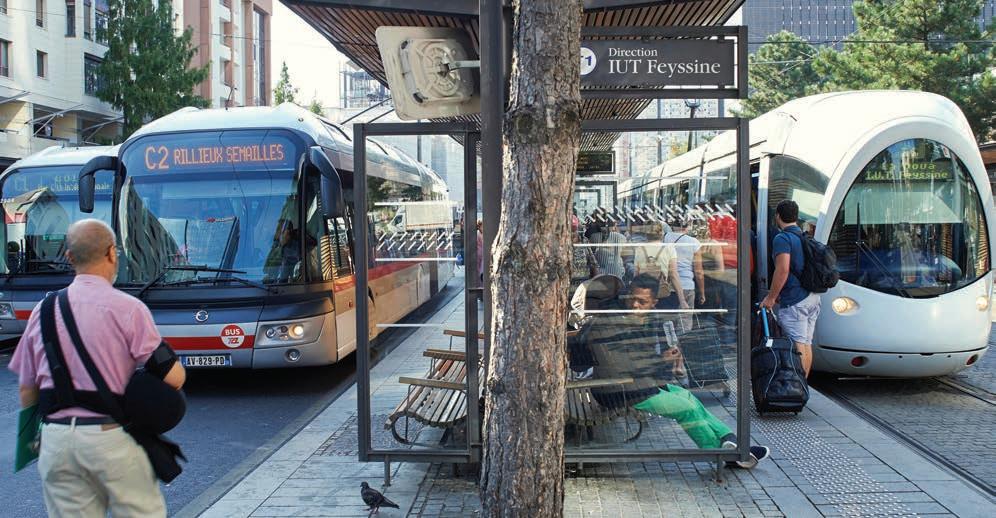
Tram systems are experiencing a remarkable resurgence in the 21st century.
That is because they are indispensable to multimodal transport networks, seamlessly integrating with a city’s metro, bus, and train systems. This integration not only expands travel options but also enhances connectivity between neighbourhoods, delivering substantial social and economic value.
At Keolis, we excel in managing and maintaining multimodal transport networks, with trams playing a central part in this work, ensuring we can offer seamless passenger experiences. Our expertise allows us to design tailored mobility solutions that meet the specific needs and financial scope of each town, city, or region – providing a smart solution to meet the demands of modern cities.
Our unparalleled success in supporting the development, operations, and maintenance of these networks is evident in cities like Lyon, Bordeaux, Dijon, and Lille in France; Newcastle, Australia; and both Manchester and Nottingham in England, to name a few. With urban populations on the rise, connectivity has never been more crucial. In 2023, cities were home to 57 per cent of an average country’s population, and by 2050, it is
72 transport report Advertorial
Keolis has worked closely with PTAs to ensure that their tram operations provide a complement to local bus networks.
projected that 70 per cent of the world’s population will reside in cities. This upward trend underscores the importance of enhancing urban connectivity to accommodate growing populations, making forward-thinking planning essential for future social prosperity.
So where to begin? Keolis leads the way in planning and developing integrated networks, with trams at their core.
Cutting edge insights
Keolis gains a deep understanding of evolving transport needs through its Keoscopie mobility think tank. Keoscopie provides valuable insights into current lifestyles, helping us create nextgeneration mobility solutions. This knowledge is further enhanced by data collected by Hove, a Keolis digital company. Hove produces intelligence that our teams use to innovate and develop attractive, integrated transport solutions.
At Keolis we have also established a Centre of Excellence for trams, which connects our global experts, in support of PTAs at every stage of a project’s lifecycle. This partnership ensures continuous improvement in our tram systems, helping us maximise their integration within our networks.
The perks of a tram
The tram’s appeal lies in its comfort, capacity, and user-friendly nature, serving as a handy option for those looking to transition effortlessly to soft modes of getting around like bikes or scooters. This versatility consistently appeals and draws in new customers.
To fully capitalise on the system’s popularity, Keolis has worked closely with PTAs to ensure that their tram operations provide a complement to local bus networks – even where it may only be a single mode provider. This is crucial because certain bus routes are able to mirror tram standards in terms of frequency and quality and provide critical connectivity to wider areas beyond the city’s limits.
This coordination means riders can easily switch between modes and provides an opportunity for better social cohesion between city and suburbs.
For instance, trams are ideal for connecting outlying municipalities located between 15 and 20km from the city centre through fast lines in less dense areas, as seen with Keolis’ work in
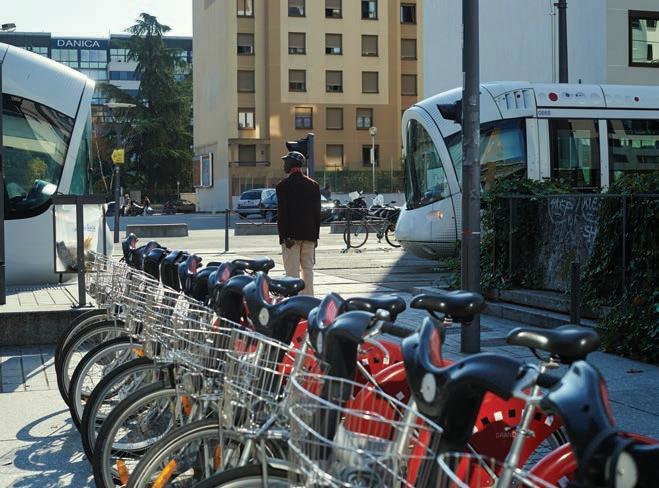

Manchester and Dijon. From these tram stops hyper-local buses can be teed up to take passengers even further to their desired destination.
Our operations of the tram network in Dijon, for example, is fully interconnected with local bus networks and feeder systems, making most neighbourhoods accessible.
We have also implemented contactless payment terminals on all of Dijon’s trams to enhance the passenger experience.
With the introduction of a Mobility as a Service (MaaS) app, Keolis worked with the transport authority to enhance the passenger experience even further by integrating all public transport options in Greater Dijon, including the tram, into a single platform. This app facilitates bookings, route searches, and real-time timetable updates. Additionally, the Bouquet Libertés, which Keolis launched in September 2021, allows users to combine their transport tickets - including buses, trams and car parking – and incentivises multimodal travel.
These initiatives distinguish Keolis, working in collaboration with its PTAs, as a leader in creating attractive, easy-touse integrated networks, which is crucial given burgeoning urban populations both now and in the future.
Where trams and trains unite
Alternatively, Keolis seamlessly integrates tram networks with metro and urban train systems to maximise their potential. Take
Paris, for example, where our Ile-deFrance Tramway Line 9 (T9) links the Porte de Choisy Paris Metro station to Orly city centre, forming part of a comprehensive transit network. This light rail system operated by Keolis is the world’s second busiest after Tokyo, offering connections to suburban train lines, metro lines, bus routes and the Grand Paris Express rapid transit lines.
More recently, Keolis’ tram operations in Bordeaux were extended by a 5km branch line on Route A to reach the city’s Mérignac Airport. With approximately 6,500 daily passengers, the tram now offers essential connectivity not just to buses, metros and trains, but also to planes, facilitating convenient travel for both tourists and businesspeople.
The economic boom
Keolis’ efforts to increase the ease of movement of local populations yields secondary economic benefits for PTAs and the communities they serve by fostering business confidence and expediting inward funding cycles.
We know at Keolis there is no one-sizefits-all solution for how to operate a multimodal transport network, but looking to international best practice, learnings and tram systems is a good place to start.
www.keolis.com
73 transport report Advertorial
Keolis has a passion to support the creation of attractive, easy-to-use integrated networks across the globe.

Shaping Possibilities

Progress on Ireland’s Road Haulage Strategy
2023 saw the establishment of the Road Freight Forum, the commissioning of a data quality study, and active advocacy for stricter EU emission standards under the auspices of Ireland’s Road Haulage Strategy 2022 to 2031.
Published in January 2024, the first progress report of the Road Haulage Strategy states that one of the initial actions was the establishment of a Road Freight Forum.
Including representatives from various government departments, agencies, and industry stakeholders such as the National Transport Authority (NTA), Road Safety Authority (RSA), Transport Infrastructure Ireland (TII), Freight Transport Association Ireland (FTAI), and the Irish Road Haulage Association (IRHA), the forum convened four times in 2023, with the last meeting before publication of the review held in January 2024.
Furthermore, the Department of Transport commissioned a study on data availability and quality which aims to identify data gaps, benchmark Ireland’s data against international standards, and suggest improvements. This report was published in May 2024.
Environmental Initiatives
The progress report outlines that regarding EU regulations on heavy-duty vehicle (HDV) emissions, Ireland supported the European Commission’s proposals for stricter limits on non-CO2 emissions, such as NOx and particulate matter.
Additionally, Ireland advocated for maintaining the European Commission’s CO2 emissions reduction targets for HDVs.
In line with environmental goals, the strategy includes the development of the National Hydrogen Strategy, considering hydrogen’s role in decarbonising heavy goods road freight. This is complemented by ongoing work by the Zero Emission Vehicles Ireland (ZEVI) office, focusing on infrastructure and energy requirements to facilitate electric heavy goods vehicles (HGVs).
Infrastructure
On infrastructure, key actions undertaken in 2023 include ensuring that the National Roads 2040 strategy addresses the needs of the haulage and road freight sector and mapping existing infrastructure to identify priority projects. Additionally, the All-Island Strategic Rail Review aims to explore the strategic use of the rail network for freight.
The strategy also emphasises integrating the road freight sector’s importance into all transport strategy documents, including the National Ports Policy and the review of the National Aviation Policy.
A notable initiative to support hauliers is the review and potential reform of the driver CPC (Certificate of Professional Competence) programme to ensure its relevance and usefulness. Additionally, a new IT system for processing road transport operator licenses is being developed to enhance digital and customer service capabilities, and due to go live Q3 2024.
The strategy also addresses the potential for license exchange agreements with North Macedonia and Argentina, with work progressing on drafting memoranda of understanding and relevant legislation. Furthermore, the progress report states that Ireland has initiated the negotiation process with Bosnia and Herzegovina for similar agreements.
The Logistics and Supply Chain Skills Group (LSCSG) has also organised the first Logistics and Supply Chain Skills Week in 2023 and a second early 2024.
Ireland’s Road Haulage Strategy
Published in December 2022, Ireland’s Road Haulage Strategy 2022-2031 focuses on aiming to generate efficiencies, improve standards, as well as help create secure employment and
assist the sector to move to a lowcarbon future.
The strategy sets out measures and supporting policies needed to deliver on these objectives, in particular for decarbonisation and in developing the skills base to ensure the long-term viability of the industry.
Looking Ahead
For 2024, key priorities include completing the procurement process for national standards for eco-driving, advancing feasibility studies for freight consolidation centres, and continuing the work on the National En-Route Electric Vehicle Charging Network Plan. Monitoring of all strategy actions will continue through regular meetings of the Road Freight Forum.
74 transport report
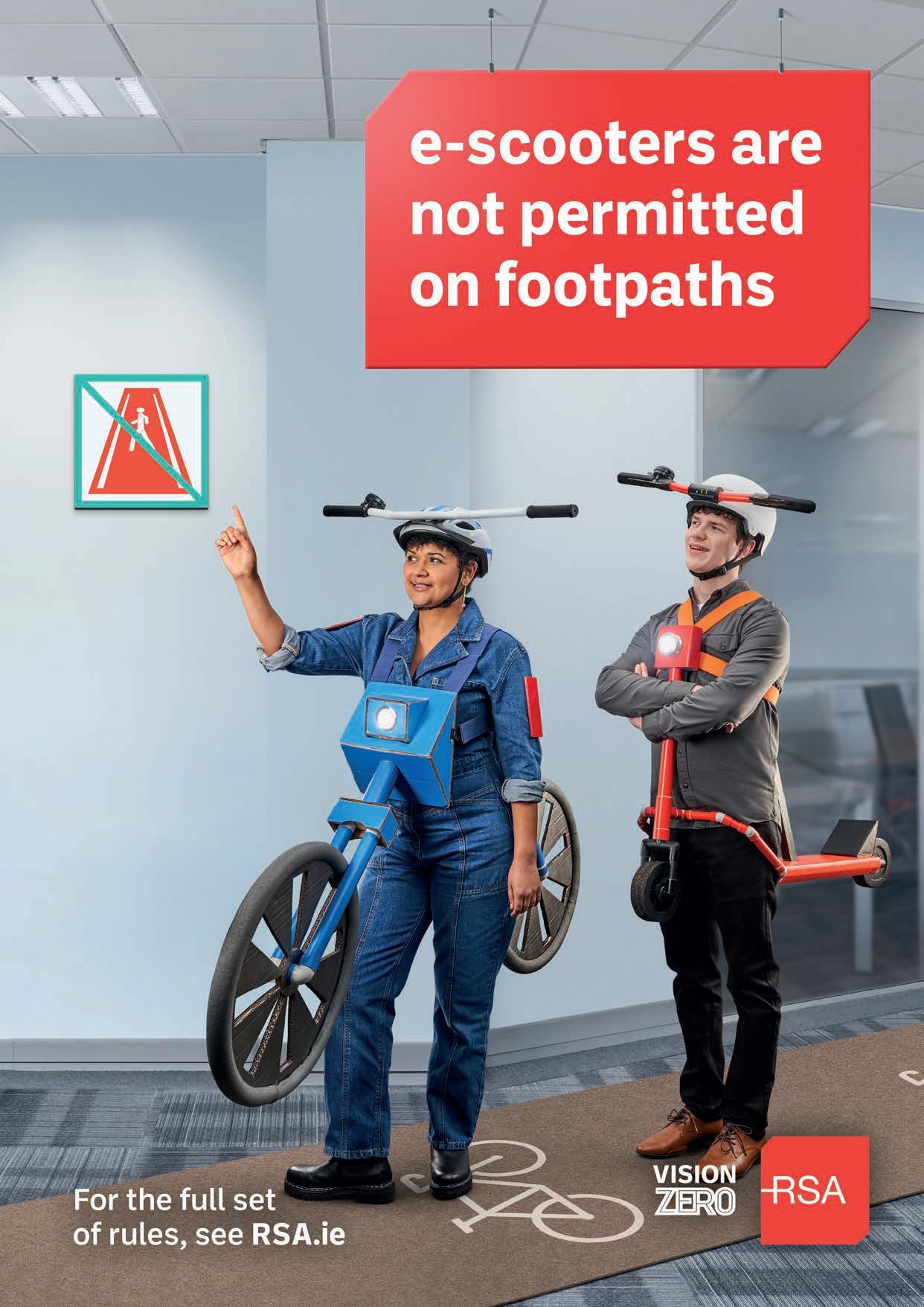
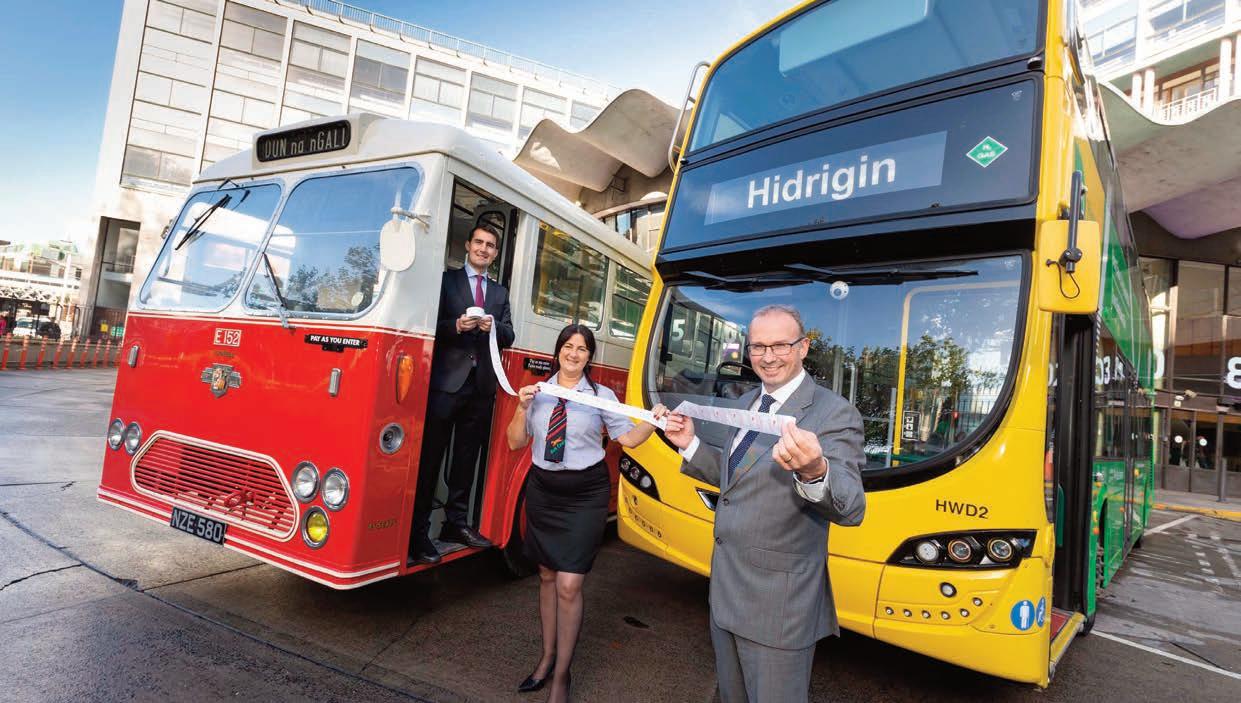
Bus Éireann: Connecting communities
2023 was a transformative year for Bus Éireann as we reported a recordbreaking 107 million passenger journeys across all services. This remarkable milestone, marking a 19.5 per cent increase from the previous year, not only signifies sustained growth but also reflects the resounding success of our Destination 2023 strategy, writes Stephen Kent, CEO of Bus Éireann.
For the first time, we surpassed the 100 million passenger journey mark, a testament to our unwavering commitment to excellence.
Under the Destination 2023 strategy, we focused on providing a best-in-class user experience achieving a customer satisfaction score of 93 per cent, surpassing our strategic target of 90 per cent. Our dedication to enhancing passenger journeys led to a 28 per cent increase over the five-year period,
showcasing our ability to deliver safe, reliable, and punctual services across the board.
Looking towards the future, our focus remains steadfast on sustainability and innovation. Through future-focused “forever” projects, we are poised to deliver over 2.6 million emission-free kilometres per year, supporting our mission to connect people and communities and helping to make life better.
Building on this foundation of success, we aim in our new corporate strategy, Horizon 28 – Our Vision for Green Growth, to double passenger journeys while managing growth sustainably. Central to this effort are the close partnerships and collaborations we have fostered with stakeholders and partners, including the National Transport Authority (NTA), CIÉ, the Department of Transport, and the Department of Education.
76 transport report Advertorial
Caption
Sustainability
Early in 2023, we launched the first project under the Government’s Pathfinder Programme, the first allelectric town bus service in Athlone, eliminating over 400,000kg of annual tailpipe CO2 emissions. Building on that success, we launched in April this year the first regional city electric bus service in Limerick. This service represents a monumental shift towards a cleaner, greener future, with over 2.1 million emission-free kilometres projected for the city per year.
These landmark investments into the future of public transport infrastructure would not be possible without the support of the NTA. Their collaboration has been instrumental in propelling our electrification efforts forward.
In line with evolving sustainability reporting requirements, we are preparing to report under the Corporate Sustainability Reporting Directive (CSRD) in 2025, while continuing to align with international frameworks such as the Carbon Disclosures Project and the Task Force on Climate-related Financial Disclosures. We are also committed to social responsibility, with clear improvement targets in gender equality, wellbeing, diversity, and inclusion.
Connecting communities
As Ireland’s national bus company, we proudly operate the most extensive public transport network in the nation. Our recent success in winning an open market tender for services on the Eastern Commuter Corridor and Carlow Town underscores our commitment to expanding our reach and impact. We are particularly excited to have launched the first-ever town bus service in Carlow and its surrounding areas, a testament to our dedication to serving communities where transportation needs are paramount.
Ensuring our services are accessible to all, we have introduced a Travel Assistance Scheme in Cork, Limerick, Galway, and Waterford which has been hugely successful. I am deeply proud of the work of our travel assistants who have supported over 1,000 passengers so far in undertaking their journey with confidence.
The School Transport Scheme which Bus Éireann operates on behalf of the Department of Education, already the largest such scheme in Europe, is experiencing unprecedented growth. With the Department's recent
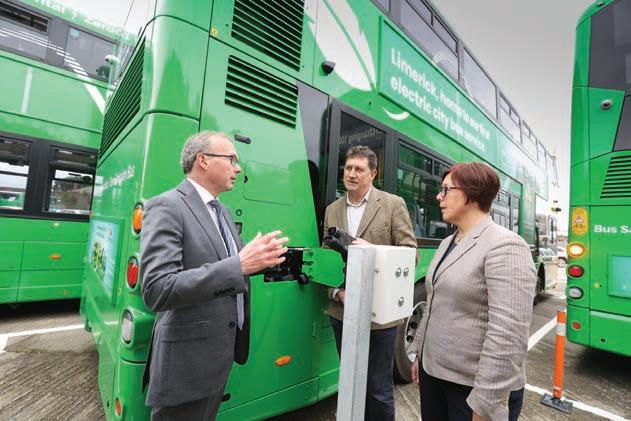
announcement to expand access to an additional 100,000 children by 2030, we anticipate continued growth in demand. Each school day, the scheme oversees the transport of over 162,500 children, our nation’s most precious resource, safeguarding their future by ensuring reliable access to quality education.
Future growth
Our continued enhancements of services under the Connecting Ireland Rural Mobility Plan and initiatives such as Bus Connects will lead to significant expansion of the network for the people of Ireland. Working in strong partnership with the NTA, we will provide greater regional and urban connectivity while delivering on our Climate Action Plan goals.
In 2023 alone, we undertook over 80 timetable reviews in conjunction with the NTA. These reviews were complemented by the introduction of 12 enhanced routes and services as part of Connecting Ireland. This resulted in an additional 2.1 million road passenger kilometres, reflecting the growing demand for our services and the effectiveness of our efforts.
I am optimistic about the future for Bus Éireann, with substantial investments planned for the coming years under BusConnects and Connecting Ireland. I also recognise the significant effort needed to achieve our ambitious goals.
We are determined to improve gender balance among our employees, to better reflect the customers we serve. Since 2022 the overall number of female
employees has increased as we work to double female participation to a fifth of all employees by 2030. Concurrently, we aim to increase fivefold the number of female supervisors to 10 per cent. We must do this by recruiting more women drivers and mechanics, supporting their growth in the company to supervisor level and beyond.
Successful recruitment of drivers and staff in a full employment economy will be key to delivering on our targets for the years to come. Over seven of 10 staff at Bus Éireann say it is a great place to work and I am committed to building on that employee engagement.
Our latest strategy sets out not only our potential for the next five years, but crucially the principles by which we achieve our goals. I am confident that we can continue to operate to the high standard of customer satisfaction that we hold ourselves to, while growing access to our services. For Bus Éireann, and the people of Ireland, success is on the horizon.
T: 01 703 3446
E: info@buseireann.ie
W: buseireann.ie
77 transport report Advertorial
Launch of Limerick EV fleet.

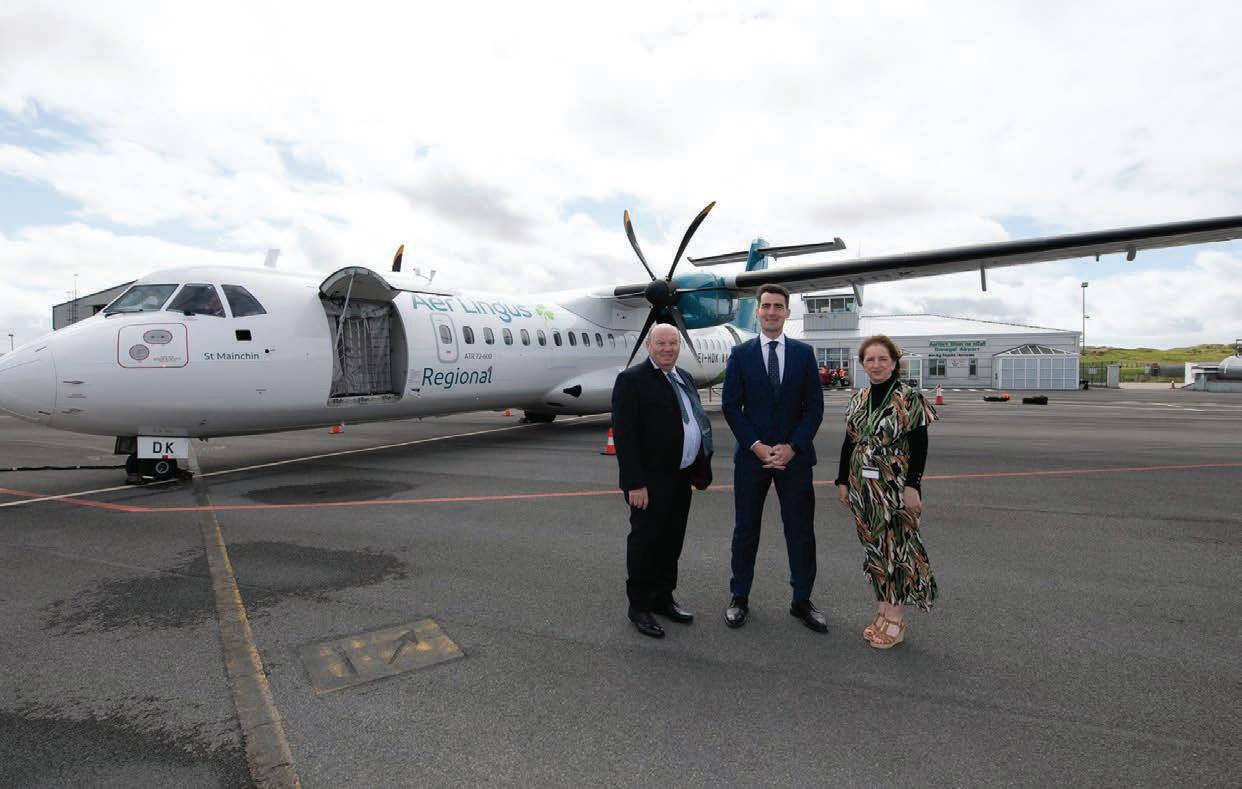
Shaping Possibilities
Regional airports granted marginal funding increase
As part of the Regional Airport Programme 2021-2025, the Government has increased funding for regional airports by €5.6 million.
On 25 April 2025, Minister of State at the Department of Transport, Jack Chambers TD, announced combined funding of over €5.6 million to support eligible regional airports in Donegal, Kerry, and Ireland West (Knock).
The other regional airports in Sligo and Waterford were not granted funding as they do not have any active routes.
Post-Covid, the aviation sector has rallied in Ireland, with close to record passenger numbers in Dublin Airport (which is subject to a passenger cap), increases recorded in Shannon, Cork, and the two Belfast airports, with Knock Airport experiencing a record year in 2023.
However, the regional airport sector in Ireland – north and south – has largely failed to recover from the crash caused by the decline in passenger traffic in the 2008 financial crisis.
This has resulted in the closure of Galway Airport, which in 2008 offered 16 routes and served over 300,000 passengers. The airports in Waterford and Sligo similarly both served zero passengers in 2023. In the North, the City of Derry Airport continued its stagnancy with a marginal decline in traffic recorded in 2023.
The airports in Kerry and Knock currently handle international traffic, and even the domestic route between Kerry and Dublin is operated on a commercial basis without government subvention. Waterford Airport is also likely to expand its capacity to be able to handle large jets such as the Boeing 737 and Airbus A320.
However, the regional aviation sector has never recovered from the post-2008 downturn, and this remains likely to largely remain the case, as is necessary if the transport sector is to play its part
in enabling the Government to meet its Climate Action Plan targets for emissions reductions.
Speaking at Donegal Airport, where he announced the funding grant, Minister of State Chambers said: “This funding represents significant investment in our regional airports. Among the 32 projects being supported this year are an aerodrome ground lighting project here at Donegal Airport.
“While many of the projects being supported have environmental aspects to them, ten of the projects approved for funding, amounting to €1.2 million, have a fundamental sustainability focus. These include carbon reduction plans here at Donegal and at Ireland West [Knock] Airport. Other projects include the upgrade to electric vehicles at Kerry Airport and Ireland West Airport.”
78 transport report
Credit:
Minister of State Jack Chambers TD made the announcement at Donegal Airport.
X/Donegal Airport


Shaping Possibilities
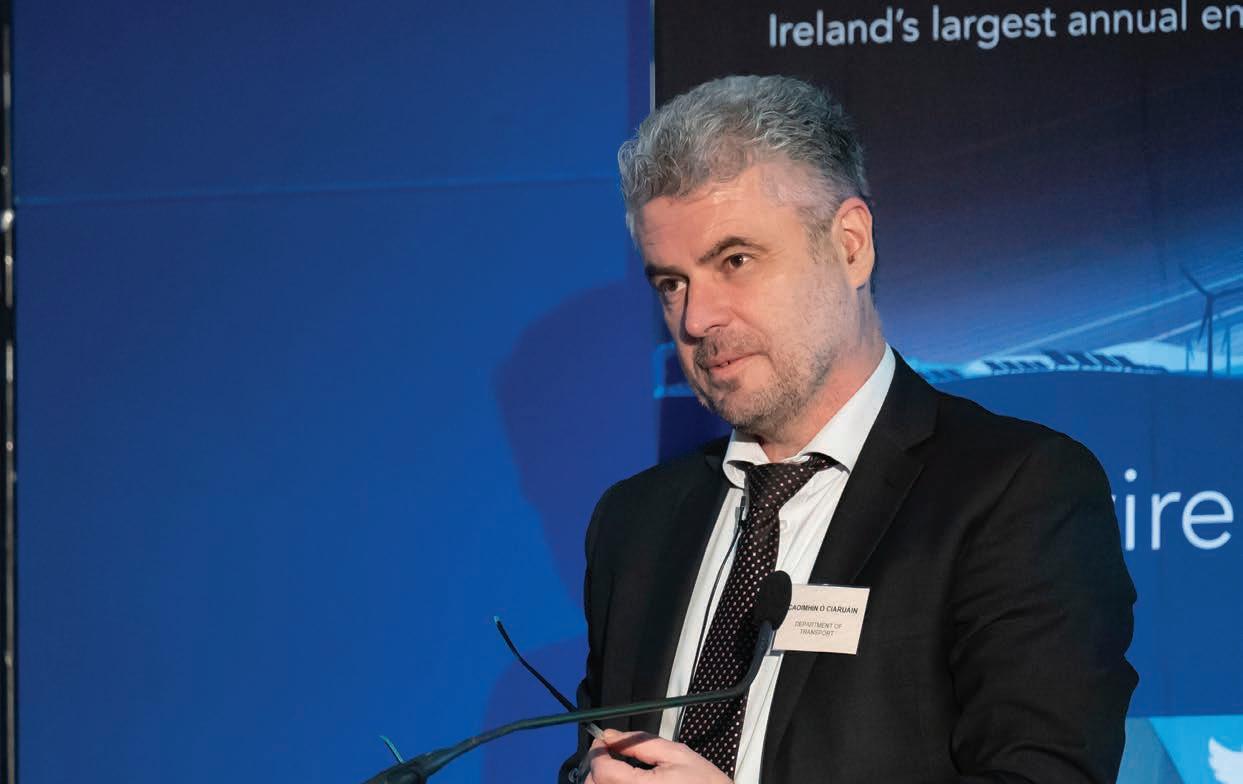
Developing alternative fuels infrastructure
Caoimhín Ó Ciaruáin, Assistant Secretary, Head of Climate Action and EU/International at the Department of Transport discusses Ireland’s progress in decarbonising transport and
the implication of the EU’s
Alternative Fuels Infrastructure Regulation (AFIR).
Ó Ciaruáin believes that the scale of transformation is so enormous that it will only been achieved by aggressively pursuing policy actions across the avoid, shift, and improve approach to the decarbonisation of transport.
Ireland’s climate ambitions are heavily reliant on the co-dependent decarbonisation of energy and transport, sectors which the Assistant Secretary highlights will do the “heavy lifting”, both nationally and in the context of the European Green Deal.
National climate targets require a 50 per cent reduction in transport emissions and a 75 per cent reduction in emissions from electricity by 2030. Outlining the scale of the challenge in meeting this ambition, Ó Ciaruáin points out that currently, fossil fuels represent 95 per cent of Ireland’s fuel mix in transport.
Analysis by the SEAI shows that in 2022, the transport sector emitted 14.5 MtCO2eq, equating to 40 per cent of Ireland’s total energy-related CO2 emissions, including international aviation. The sectoral emissions ceilings have established a 6 MtCO2eq ceiling for transport for 2030.
Breaking down the avoid, shift, improve approach to transport decarbonisation to date, Ó Ciaruáin says that progress has been achieved.
He highlights that the avoid approach –reducing or avoiding the need to travel –will be the most challenging but likely most transformative measure, with benefits that go well beyond carbon reduction. In March 2024, the Government published a new draft demand management strategy which provides a firm policy direction and a suite of options, such as road space
reallocation, progressive taxation, freight efficiency, or behavioural incentives, that can be taken at national, regional, and local levels to bring about the systems changed needed.
As expected, the co-dependency with the decarbonisation of energy lies mostly within the shift and improve paradigms, where the benefits of a shift to sustainable modes of transport and active travel modes are already being seen, particularly around public transport. In 2023, patronage of public transport had risen by 24 per cent on the previous year and under the improve measure, there are advances on the electrification of the fleet and the options for increased blending of biofuels.
Ó Ciaruáin summarises: “The first two carbon budget reduction targets will lean heavily on electrification, biofuel
80 transport report
Shaping Possibilities
blending, and alternative fuels to do the heavy lifting, however, beyond that, I think we are looking at a much wider transformation of how we travel.”
The Assistant Secretary explains that progress to date has been driven by a carrot-and-stick approach. Citing one of the most generous sets of incentives for EV take up across Europe as an example of the carrot, he explains that the complex regulatory landscape also requires a stick approach, and has, for example, driven investment and planning in the delivery of charging infrastructure.
Highlighting the significant evolution of the policy landscape in the last decade, Ó Ciaruáin points to the Renewable Transport Fuels Policy Statement 202325 as the key national policy lever for the increased supply of alternative fuels within the transport system.
The statement provides a framework towards meeting targets set out in the Climate Action Plan, such as at least B20 (biodiesel equivalent) in diesel and E10 (ethanol) in petrol by 2030 (with an interim B12/E10 by 2025 target), and European obligations for renewable energy supply for use in transport.
“The level of ambition here is significant. It is the invisible piece of what we do in terms of the Renewable Transport Fuel Obligation (RTFO), but it is also one of the most effective ways of delivering carbon abatement in the transport sector and we depend quite heavily on it.”
Similarly, sub-targets exist for the supply of renewable fuels from non-biological origins and advanced biofuels and biogases. Separately, obligations are in place for the maritime and aviation sectors. For land transport, the shift towards alternative fuels is being accelerated at EU level through regulations banning the sale of fossil fuel cars and vans from 2035, and the recently adopted phase-out of heavy good vehicles by 2040.
From April 2024, the Alternative Fuels Infrastructure Regulation (AFIR) was applicable and sets a minimum set of mandatory infrastructure requirements for alternative fuels across the TransEuropean Transport Network (TEN-T).
“Within the Department of Transport, and in relation to the development of alternative fuels, given the variety of policies, regulations and supports that are available, we need to ensure that
the kind of policy coherence across the system, but also increasingly across government. We need to work with our colleagues to focus those interventions that deliver the most optimal policy objectives, both nationally and internationally,” he says.
To this end, Ó Ciaruáin explains that the Department has established a working group looking specifically at alternative fuels. The Alternative Fuels for Transport Working Group aims to facilitate greater visibility on policy development and delivery across the transport and energy sectors in relation to the development of alternative fuels in transport.
The group will also coordinate a variety of ongoing actions concerning alternative fuel infrastructure and renewable energy across the transport sub-sectors, land, aviation and maritime, and is expected to produce a report by the end of 2024.
In addition, the Department has established a Sustainable Aviation Fuels (SAF) Task Force to help inform a new national SAF policy roadmap, targeted for delivery by the end of 2024.
Alternative fuel infrastructure
Turning to the implications of the Alternative Fuels Infrastructure Regulation (AFIR), Ó Ciaruáin offers a context whereby the regulation’s predecessor was not mandatory and delivery across Europe was “patchy”. As a result, several member states, including Ireland, are playing catch up on what is required.
The objective of the regulation is to set minimum mandatory infrastructure requirements and timeframes, with severe penalties outlined for those who do not deliver on their obligations.
While delivery on the ambitions will be challenging, Ó Ciaruáin acknowledges the “level of certainty” the regulation offers to sectors, markets and the public that projects will be advanced.
In relation to electrification, it is estimated that the first AFIR target for 2025 will require a 300 per cent increase of charging capacity.
“We have to show and be clear that we are pursuing this aggressively in order for that takeup to happen, and people feel confident that they have the public charging infrastructure available.”

Additionally, AFIR requires significant investment in the hydrogen space over the next decade. A requirement of refuelling stations that can serve both light and heavy-duty vehicles in every urban node on the TEN-T network, at intervals of every 200km on the TEN-T corridor translates into a hydrogen refuelling station in Dublin, Cork, Galway, and Limerick, which are capable of dispensing one tonne of hydrogen per day.
The first deployments of this type of infrastructure are scheduled for 2027, which will be majorly challenging for Ireland. However, the Assistant Secretary points to work under the Shared Island Initiative to progress research and feasibility studies with the Department for the Economy in Northern Ireland, and alignment with the National Hydrogen Strategy, as the groundwork which is being laid for rollout on a larger scale.
The AFIR also sets strict infrastructure development regulations in relation to liquified methane, maritime, and aviation.
The Assistant Secretary summarises: “AFIR targets are hugely challenging, and with infrastructure deployment expected to be ahead of demand in some instances, the ‘build it and they will come’ perspective at EU level is not without significant risk and operational challenges for member states.”
Ireland’s approach to these areas will be set out in the AFIR National Policy Framework. Currently in development, Ireland, along with other member states, must submit a draft National Policy Framework to the European Commission for review by the end of 2024. A final national policy framework must be set by the end of 2025.
A public consultation seeking submissions from wider transport and energy sector stakeholders to inform the development of an updated National Policy Framework for Alternative Fuels Infrastructure in Transport launched in May 2024 and closed on 14 June.
The Department of Transport expects to advance and publish an updated draft policy framework for further consultation in the second half of 2024, with final policy frameworks required to be submitted to the European Commission by 31 December 2025.
81 transport report

Shaping Possibilities

REFuelEU: Highly ambitious long-term aviation sustainability targets
Sustainable aviation fuel (SAF) is still at an early stage of development, but between 2025 and 2050, airlines and governments will be legally obliged to ensure that it grows from 2 per cent of minimum share to 70 per cent, as outlined in the REFuelEU aviation initiative.
The main objective of the REFuelEU aviation initiative, as a key part of the EU’s Fit for 55 package, is to “increase both demand for and supply of sustainable aviation fuels (SAF), which have lower CO2 emissions than fossil fuel kerosene, while ensuring a level playing field across the EU air transport market”.
The new legislation aims to put air transport on the trajectory of the EU’s climate targets for 2030 and 2050, as SAF is well-established as one of the key short- and medium-term tools for decarbonising aviation. Currently, the rollout of SAF is being hindered by low supply and prices much higher than prices of fossil fuels.
82 transport report
Shaping Possibilities

The new regulation contains six main provisions:
1. aviation fuel suppliers must ensure that all fuel made available to aircraft operators at EU airports contains a minimum share of SAF from 2025 and, from 2030, a minimum share of synthetic fuels, with both shares increasing progressively until 2050. Fuel suppliers will have to incorporate 2 per cent SAF in 2025, 6 per cent in 2030 and 70 per cent in 2050. From 2030, 1.2 per cent of fuels must also be synthetic fuels, rising to 35 per cent in 2050;
2. aircraft operators must ensure that the yearly quantity of aviation fuel uplifted at a given EU airport is at least 90 per cent of the yearly aviation fuel required, to avoid tinkering practices which would bring additional emissions from extra weight;
3. the scope of eligible sustainable aviation fuels and synthetic aviation fuels includes certified biofuels, renewable fuels of non-biological origin (including renewable hydrogen) and recycled carbon aviation fuels complying with the Renewable Energy Directive (RED) sustainability and emissions saving criteria, up to a maximum of 70 per cent, with the exception of biofuels from food and feed crops, as well as low-carbon aviation fuels (including low-carbon hydrogen), which can be used to reach the minimum shares in the respective part of the regulation;
4. rules on the competent authorities, to be designated by the member states to enforce this regulation, and rules on fines;
5. The creation of an EU labelling scheme about environmental performance for aircraft operators using SAF, which will help consumers make informed choices and will promote greener flights; and
6. data collection and reporting obligations for fuel suppliers and aircraft operators enabling to monitor the effects of this regulation on the competitiveness of EU operators and platforms.
The REFuelEU aviation initiative is part of the Fit for 55 package. Presented by the European Commission on 14 July 2021, the package aims to enable the EU to reduce its net greenhouse gas emissions by at least 55 per cent by 2030 compared to 1990 levels and to achieve greenhouse gas emissions neutrality in 2050.
On 2 June 2022, the EU’s Transport, Telecommunications and Energy Council (TTE) reached a general approach to the proposal. Following interinstitutional negotiations between the European Council and the European Parliament (trilogues), the two co-legislators reached a provisional political agreement on the file on 25 April 2023.
Emissions from aviation
Policy actions and the efforts of industry have led to improvements in fuel efficiency over recent years. For instance, the amount of fuel burned per passenger dropped by 24 per cent between 2005 and 2017. However, these environmental benefits have been outpaced by a sustained growth in air traffic, with passengers in 2017 flying on average 60 per cent further than in 2005.
In the EU in 2019, direct emissions from aviation accounted for 3.8 per cent of total CO2 emissions. The aviation sector creates 13.9 per cent of emissions from transport, making it the second biggest source of transport GHG emissions after road transport. If global aviation were a country, it would rank in the top 10 emitters.
Someone flying from Lisbon to New York and back generates roughly the same level of emissions as the average person in the EU does by heating their home for a whole year.
Before the Covid-19 pandemic, the International Civil Aviation Organization (ICAO) forecasted that by 2050 international aviation emissions could triple compared with 2015.
Sustainable aviation fuel (SAF) is a greener jet fuel, the use of which seek to reduce the lifetime emissions of engine burn, acting as a drop-in fuel that can be blended in increasingly high proportions with conventional Jet A1. Widespread use of SAF has the potential to cut aviation’s greenhouse gas emissions by up to 80 per cent compared with traditional jet fuels.
November 2023 saw the first ever example of a transatlantic flight powered by SAF, as a Virgin Atlantic Boeing 787 Dreamliner successfully flew from London Heathrow to New York’s JFK Airport. On the flight, the plane was filled with 50 tonnes of SAF. Two types were used, with 88 per cent derived from waste fats and the rest from the wastes of corn production in the US.
Commercial viability remains a stumbling block for widespread use, but the fact that the technology is proven to be useable and theoretically commercially viable means that, in the long term, the scope for progress is significant.
83 transport report

Shaping Possibilities
Developing a national EV charging network

Teresa Fallon, High-Power Infrastructure Lead at Zero Emission Vehicles Ireland (ZEVI) outlines the development of Ireland’s National EV Charging Infrastructure Plan.
Set up in July 2022, ZEVI is a dedicated office within the Department of Transport charged with supporting consumers, the public sector, and businesses to make the switch to zeroemission vehicles.
The office’s work is an ambitious target within Climate Action Plan 2024 to have an expected 30 per cent of the country’s private car fleet switched to electric by 2030. Supplementing this target is an ambition to have 195,000 plug-in EVs on the road by 2025, and a
300 per cent increase in charging capacity in the same timeframe.
Offering an assessment of Ireland’s positive EV progress to date, Fallon points out that there are currently over 114,000 EVs with a plug on Irish roads. Market choice has also increased, with over 31 brands (over 70 models) available, and price points reduced, meaning price parity with internal combustion engines is getting closer. The Alternative Fuels Infrastructure
84 transport report
Shaping Possibilities

Regulation (AFIR) mandates the need for 1.3KW of battery electric vehicle charging per vehicle and 0.8KW of charging per plug-in hybrid. To meet these power targets for infrastructure charging for light good vehicles, Ireland will need to increase charging capacity by at least 300 per cent by 2025.
“That is a tall order, especially in a country where we have so much home charging,” says Fallon. “The amount of public charging is a challenge to deliver and effectively means that we need to go from 71MW of charging to 214MW by the end of 2025.”
Also required, as outlined in the draft National Road EV Charging Network Plan, Ireland will need to increase the number of charge points from 2,100 to between 3,200 and 6,210 nationally (depending on need). For light good vehicles, a charging pool is required every 60km on the motorway network, while for heavyduty vehicles between 1.4MW to 7MW will be required every 60 to 100km.
The Draft Regional and Local EV Charging Network Plan is the second element of the National EV Charging Network Plan and follows the development of the National Road Network EV Charging Plan, which was launched for public consultation in September 2023.
The National Road Network EV Charging Plan is being delivered in close collaboration with TII and ESB to increase EV charging infrastructure on motorways, as well as national primary and secondary roads. Meanwhile, the draft Regional and Local EV Charging Network Plan is being developed in conjunction with local authorities.
ZEVI launched the National En-Route EV Charging Network Plan for Consultation in September 2023, setting out the quantum and frequency of charging power along the major roads network. Fallon explains that extensive international research, alongside detailed modelling, highlighted that simply meeting the requirements of the Alternative Fuel Regulation would fall short of what was needed on Ireland’s national road network.
“Importantly, within our modelling, we looked at the personas who would be using the network and compiled eight categories, resulting in targets for both light-duty and heavy-duty vehicles.”
The draft plan also addresses potential market enablers, such as financial supports, grid applications for heavy-duty vehicles, battery technologies, and a review of planning requirements. In relation to standards, it builds upon the Universal Design Guidelines for Electric Vehicle Charging Infrastructure published at the end of 2023, while also bringing forward measures included in the Alternative Fuel Regulation such as ad-hoc payment, data sharing, and interoperability.
Regional and local EV charging
Currently in development, Fallon explains that the priority aim of the Regional and Local EV Charging Network Plan will be a shift from a business-led approach to a demand-led approach beyond 2030.
Currently, local EV charging infrastructure has largely been rolled out through private investment, with some public support. However, there is a recognition of the risk being taken on by businesses because of the absence of a fully formed EV market. As part of the plan, ZEVI will task local authorities to develop their own strategies, transitioning towards a planned-led approach.
“From 2025 we intend to be rolling out plan-led infrastructure, which is not solely based on private investment. Delivery of that infrastructure will also enable is to collect data and gain more certainty as to where infrastructure should be best located, which will enable future delivery to be demand led,” Fallon concludes.
85 transport report

DIGITAL MARKETING DUBLIN
Friday 27 September • The Marker Dublin Hotel
Register today at the early bird rate!
Now in its third year, Digital Marketing Dublin will feature expert speakers from across the spectrum of digital marketing including a focus on targeting specific audiences through tools such as SEO, paid search and email marketing.
#DMDublin will get to the heart of digital planning and strategy. Leading digital marketing experts will examine best practice and achieving results, giving examples of successful campaigns.

Key issues to be examined:
• Digital marketing strategy and planning
• Data and analytics
• AI and technologies for digital marketing
• SEO
• Email marketing
• Content marketing
• Paid search advertising
• Influencer marketing
• Social media
• Video • UX
Speakers confirmed

Darragh


Register
Aoife McIlraith



Dr Dónal Mulligan


Doyle Head of Communications, Marketing and Audience Development Dublin City Council Culture Company
Owner Luminosity
Deputy
Digital Sascha O’Toole
Head of Communications Department of Children, Equality, Disability, Integration and Youth
Chair
Ethics Committee, Faculty of Humanities & Social Sciences DCU
Director & Co-Founder Part Three Digital
Carr Digital Marketing Manager Dogs Trust Ireland
Senior SEO Product Manager Indeed
Digital Communications Specialist Irish Human Rights and Equality Commission
of Faculty Research
Hannah Bryans
Claire
Gus Pelogia
Linda Coyne
now Online: www.dmdublin.ie By phone: 01 661 3755 By email: registration@eolasmagazine.ie
Future of policing report


Sponsored by
 An Garda Síochána
Ireland’s NaƼonal Police and Security Service
An Garda Síochána
Ireland’s NaƼonal Police and Security Service

Keeping People Safe

Keeping People Safe

Justice Minister Helen McEntee TD: ‘The next chapter in Irish policing, security, and community safety’
Policing, Security and Community Safety Act 2024 provides for the most significant policing reform in 20 years, writes Justice Minister Helen McEntee TD.
When we think of the Irish criminal justice system, An Garda Síochána is probably what first comes to mind for most of us. We all recognise the Garda logo, our local Garda station, or gardaí that we see at various community and sporting events in our towns and villages, or on foot patrol in our urban areas. We know that An Garda Síochána is available to us if we need its assistance.
Less visible is the work required behind the scenes to ensure that An Garda Síochána, like any other large public service organisation, is fully supported, equipped and accountable to deliver policing services to the public and the communities it serves.
At the beginning of 2024, the Policing, Security and Community Safety Act 2024 was passed by the Houses of the Oireachtas. This landmark Act provides an important new framework for policing, security, and community safety in the State and introduces a new internal governance, external oversight, and accountability policing framework. Many of these changes are based on recommendations made by the Commission on the Future of Policing (CoFPI) who published their report in 2018.
Internal governance of An Garda Síochána is being strengthened by the introduction of a new nonExecutive Garda Board.
Independent external oversight will be provided by the new Policing and Community Safety Authority, which will merge the broad-ranging oversight functions of the existing Policing Authority and the inspection functions of the Garda Síochána Inspectorate. GSOC is being restructured as Fiosrú – the Office of the Police Ombudsman with an expanded remit to investigate complaints against Garda members.
We are also establishing two new Offices – the National Office for Community Safety and the Office of the Independent Examiner of Security Legislation.
88 future of policing report
Keeping People Safe

“The most significant benefit for ordinary people will be the changes we make to community safety structures.”
Minister for Justice Helen McEntee TD
National Office for Community Safety
The National Office for Community Safety will promote inter-agency collaboration and community engagement to improve community safety nationwide. It will also work closely with local community safety partnerships (which we have piloted in Dublin’s north east inner city, Waterford, and Longford), setting and overseeing targets to evaluate their effectiveness.
Ensuring that people are safe and feel safe in their own community so that communities can thrive, and flourish is a priority for me. Community safety goes beyond traditional, high visibility policing. It requires a whole-ofgovernment approach, and the input of those within communities who know best the dynamics, strengths and challenges of their localities, working together to build safer and stronger communities.
I recently opened the call for applications to the Community Safety Fund for 2024. This Fund reinvests the value of proceeds of crime seized by the Criminal Assets Bureau directly back into communities via projects that support and improve community safety.
This year, total funding of €3.75 million is available in grants ranging from €20,000 to €150,000 for groups on issues relevant to community safety and youth justice. I encourage groups to consider making an application before the fund closes on 26 July 2024.
Office of the Independent Examiner of Security Legislation
The Independent Examiner of Security Legislation is an entirely new role and represents a significant development in enhancing our national security infrastructure – providing for an independent review of security legislation and security arrangements. Preparations for the establishment and restructuring of these bodies is well underway in the Department of Justice. Working closely with our key Programme Partners – An Garda Síochána, GSOC, the Policing Authority, and the Garda Síochána Inspectorate – our implementation team has been planning for the commencement of this legislation in parallel with its passage through the Houses of the Oireachtas.
The Act requires 24 office holders, senior executives, and board/authority members to be appointed for
commencement. The necessary recruitment and appointment processes are coming to a close and I expect to be announcing successful candidates in the coming weeks. I want to thank our colleagues in the Public Appointments Service for their support during this intensive process.
There will then be a short period for on-boarding new personnel and to operationalise the new and reconstituted bodies in preparation for commencement of the Act. This additional time will also be utilised to finalise some of the more complex pieces of secondary legislation required for commencement, including the necessary consultations.
Our Programme Partners are working hard to ensure that the necessary processes and procedures are in place to support the new and restructured organisations and appointed personnel from the outset.
Benefits
I know that the benefits of changes to the structure and working procedures of large organisation such as An Garda Síochána can seem intangible to those from the outside. So, I understand when people ask: What will this new legislation do for me?
Outside of improving the performance and accountability of our police service, I think the most significant benefit for ordinary people will be the changes we make to community safety structures. I truly believe these changes, overseen by a National Office, will make a tangible difference to those working on the ground and will help communities tackle headon some of the challenges that have arisen in recent times, including anti-social behaviour.
This new legislation provides for the most wide-ranging and coherent reform of policing in the last 20 years. The changes that are happening will really make a positive and material difference to our policing services now and into the future.
It is the result of an enormous amount of research and collaborative work with the aim of developing a new approach to ensuring modern and dynamic policing in Ireland.
I very much look forward to this next chapter in Irish policing, security, and community safety.
89 future of policing report


An Garda Síochána
Ireland’s NaƼonal Police and Security Service
Keeping People Safe

Drew Harris has held the position of Garda Commissioner since September 2018, and here he discusses An Garda Síochána’s Community Policing approach, and how policing in Ireland is adapting to respond to the needs of a modern and diverse society.
An Garda Síochána has a long established tradition of working closely with communities all across Ireland.
By fostering and maintaining effective community partnerships, An Garda Síochána works to reduce crime and the fear of crime in communities.
The general direction and control of An Garda Síochána is the responsibility of the Garda Commissioner who is appointed by the Government.
In the very early days of An Garda Síochána, 102 years ago now, the first Garda Commissioner delivered the following words that changed policing in Ireland for ever:
“The Garda Síochána will succeed not by force of arms or numbers, but on their moral authority as servants of the people.”
That statement by Commissioner Michael Staines in 1922 was in the midst of a bloody civil war that split families and at time when armed groups were pledged to overthrow the newly founded State and were as prophetic as they were brave.
Those words have been An Garda Síochána’s guiding star ever since.
We police with the people for the people. We police with their consent.
For An Garda Síochána, this means that outside of detectives and specialised armed response units, we are a largely unarmed police service. Being unarmed led An Garda Síochána to become trusted by both sides of the civil war as the independent guardians of the peace. This led to An Garda Síochána becoming embedded in communities, where they were seen as an integral part of the community, and that, I am glad to say, continues today.
Gardaí are members of local sports clubs; visit schools; volunteer with
Safe 90 future of policing report Advertorial
Keeping People
Keeping People Safe

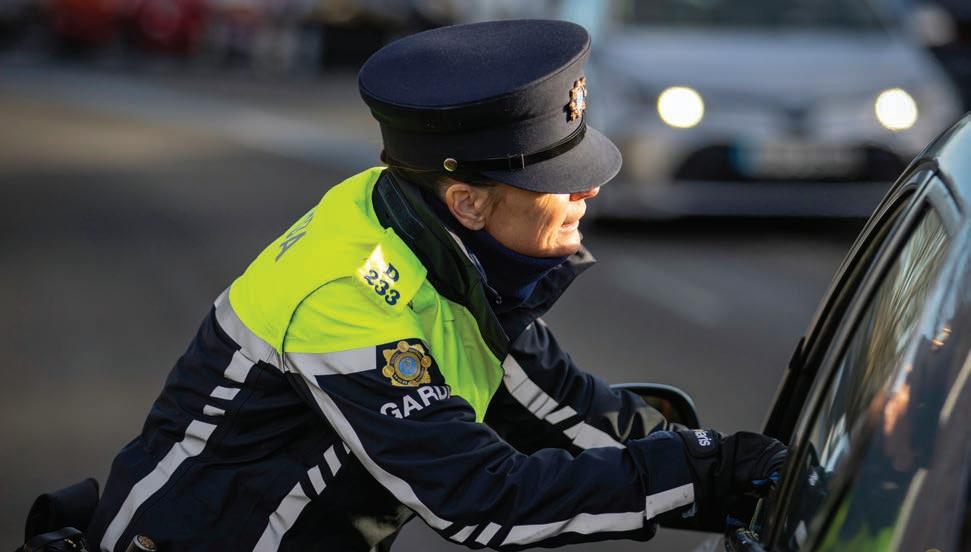
community groups. They lend a helping hand to the needy. They treat individuals with empathy and respect, and they try to sort out issues before an arrest or criminal justice intervention is required.
This activity came to the fore during Covid-19 when there was significant public fear and concern, and rapidly changing rules and regulations. Our role in policing the public health situation brought with it the potential to erode those strong bonds with communities. However, in providing public reassurance, supporting the vulnerable, being highly visible and available to people – with enforcement as a last resort, we saw public trust in An Garda Síochána increase.
I must stress though, that it is important not to confuse community policing with being ‘soft and fluffy’.
It is true that community engagement involves attending events, having a cup of tea and a chat with people, but this enables our gardaí to build a relationship with communities, earning their trust. It enables us to do what needs to be done to best serve those communities, whether that’s through community groups flagging concerns, or individuals coming to us in confidence about suspected criminal activity.
Now, at a time when policing legitimacy is under intense scrutiny, having the public’s trust is vital. We understand this more than most, because public trust in
“I consider myself very fortunate to lead an organisation with such dedicated, committed and professional personnel who on a daily basis go above and beyond.”
Drew Harris, Garda Commissioner
An Garda Síochána was not always as high as it is currently. We have had to rebuild that trust, through a major policing reform programme.
Under that reform programme, we have placed a strong emphasis on humanrights in policing. Garda personnel respecting and protecting the human rights of all individuals we come into contact with, actively enables us to keep people safe and helps ensure a just outcome for all.
Further to this, approximately 4,000 personnel will have completed a human rights and policing course we have developed with the University of Limerick, by the end of 2024.
Also through the Government reform programme we continue to strengthen
our community links through our local community policing teams. These are made up of local Gardaí and community groups and work to identify and tackle crimes impacting their locality.
Meanwhile, community engagement units work within communities to tailor responses to their needs. And now, under the biggest restructuring of the organisation in its history, we have Superintendents in each Garda Division dedicated solely to community engagement.
This restructuring is also seeing police services that were solely delivered by national units now provided at local level in areas such as sexual crime and child abuse; cybercrime; and economic crime. This provides a higher quality of service
4
91 future of policing report Advertorial 4

Keeping People Safe
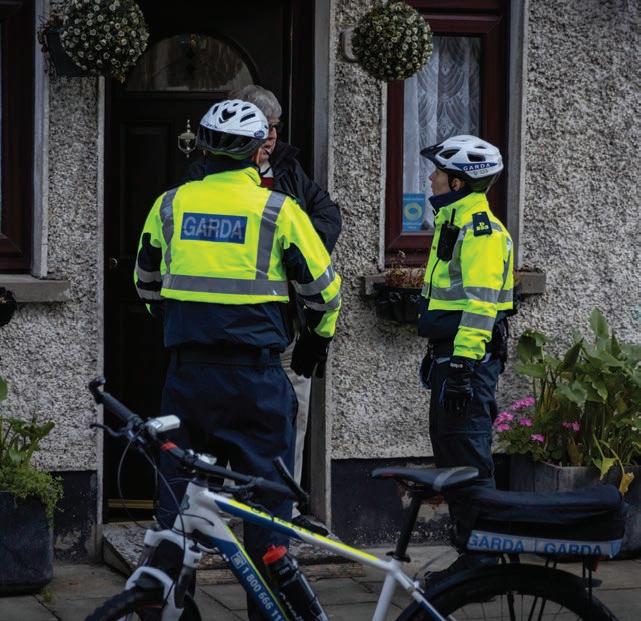
locally delivered by highly trained experts in these fields.
One key element of community engagement not to be overlooked is victim support. While statutory obligations set out how we must deal with victims, we recognise we need to go beyond this.
In 2015, we introduced victim liaison offices across the country to ensure victims get key information on their cases and available support services.
However, we do know from our Public Attitude Survey, many victims are not satisfied with the service we provide to them. This is something we are working to address.
One example is in the area of domestic abuse, where we know victims of crime are suffering behind closed doors and are reluctant to disclose to us.
In recognition of this, An Garda Síochána has introduced a policy where all those who report as a victim of domestic abuse receive a call-back within five working days.
Last year, we received nearly 60,000 domestic abuse calls, which represents a 10 per cent increase on the previous year. This indicates to us that confidence in reporting domestic abuse has gone up.
We have also invested in tailored training and more than 90 per cent of Gardaí who are first line responders to domestic abuse incidents are now trained to identify coercive control.
Of course as criminality evolves in a modern society, we too must be cognisant that in our ultra-connected world, local crime is often linked to international crime.
For instance, an online fraud that sees a pensioner in Dublin robbed of their life savings could be run by an international crime gang operating outside of Ireland, or a cyber-attack that cripples a local business might be orchestrated by hackers working from multiple foreign locations.
It is vital, therefore, that we work in partnership with our international policing colleagues to accelerate the sharing of intelligence and information, and utilise our combined expertise and experience, because as I have said many times, it takes a network to defeat a network.
One such example is our ongoing work with international colleagues in the US, UK, Spain and Europol to bring an end to the Kinahan Organised Crime Gang.
This OCG began in the 1980s as a small drug dealing gang in inner-city
Dublin but has grown into an organised crime cartel operating in multiple countries with an estimated worth of €1 billion.
This wealth has been accumulated through murder and violence, and has brought misery to individuals and communities not only in Ireland, but in many other countries through drug dealing, intimidation, forced prostitution and human trafficking.
In recent years, An Garda Síochána has made significant in-roads into the gang through arrests of key figures and large drug seizures, cash and firearms. However, given its international scale, we knew that we would really impact on the very top of the organisation through co-operation with colleagues abroad.
In 2022, close to where the Kinahan Crime Gang first started to operate in Dublin, we announced a transnational effort to put this gang out of business including financial rewards for information leading to the arrest of its leadership.
Collectively, working closely with international colleagues including the Dubai Police, we continue to make major inroads towards bringing them to justice.
Of course, this is not to say that An Garda Síochána is perfect. We are not.
There are challenges we still need to address. Ireland is a rapidly changing society and we need to keep up with this. For instance, it is clear that the personnel make-up of An Garda Síochána is not reflective of the society we police.
We know when minority communities look at us, they go not see themselves reflected back, and for us this is something we are keen to address.
An Garda Síochána was one of the first police services in the world to establish a dedicated Diversity Unit, and today there are more than 500 diversity officers throughout the country actively engaging with minority communities and individuals, providing re-assurance and working to address concerns.
Meanwhile, our uniform policy has been updated to allow the wearing of official headwear for religious, cultural reasons and beliefs including the turban and hijab.
We have a Pride community car showing support for the LGBTQ+
92 future of policing report Advertorial
Keeping People Safe

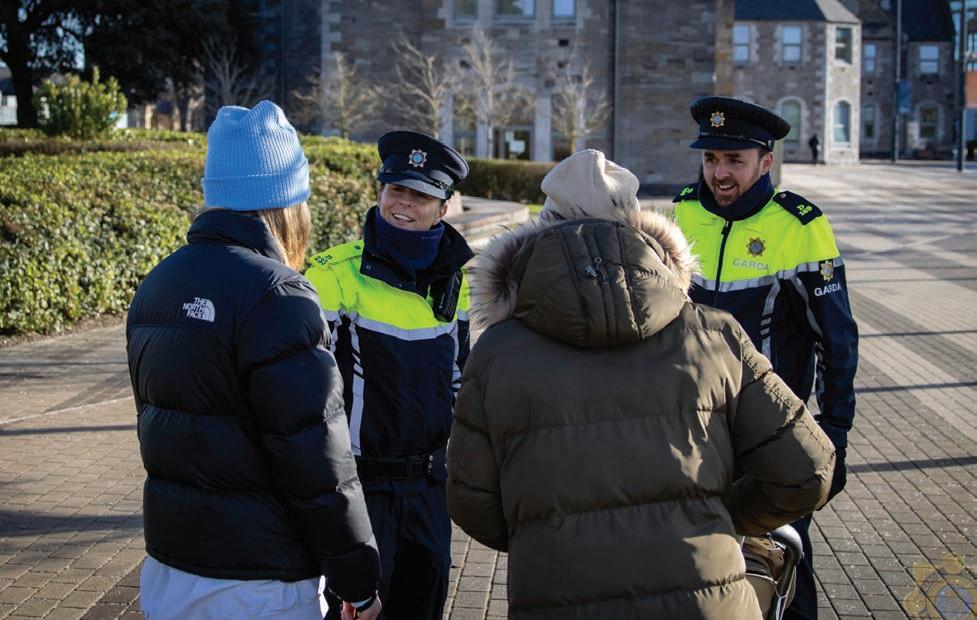
community, and we have produced public safety information in multiple languages.
But the biggest difference we could make is to have more people from different communities and backgrounds join An Garda Síochána.
Our recent recruitment campaigns have placed a strong focus on attracting diverse candidates and it is starting to make a difference, but the reality is that it will take time before we can be truly reflective.
Of course the type of crime we are dealing with is changing too, and increasingly we are responding to threats posed to community harmony by the far-right, including the November 2023 riot in Dublin which, saw looting, vandalism, arson, and attacks on Gardaí, but thankfully no loss of life.
We are also seeing an increase in public disorder linked to sites and locations intended to house migrants.
We are having to adapt to respond to these situations, where we are working with local communities, community leaders and political representatives to marginalise the far-right’s impact, particularly to mitigate against the spread of mis- and dis-information.
As society changes and we see
increasing numbers moving away from rural communities to urban areas, there is the potential for greater rural isolation. And we are committed to ensuring that vulnerable people do not get left behind.
This is why we are looking to modernise how we connect with communities. Be it face-to-face or in-station, contact remains critical and hopefully always will. However, we do need to provide an avenue for those who want to connect with us online. For instance, providing a mechanism for the public to send footage of road traffic incidents to us.
We are making improvements in this area and our world-leading mobility app is in the hands of every front-line officer, giving them instant access to a range information while on patrol.
We have also begun a proof-of-concept for body-cams that will provide protection to citizens and Gardaí. And when proposed legislation is passed, a digital evidence management system

will enable the public to upload videos. At the same time, we cannot and will not lose the human touch.
An Garda Síochána has built trusted relationships within communities by listening and learning; by engaging with empathy and respect; by being approachable and open and by ensuring our engagements are of the highest ethical standard that protects the human rights of all.
But, none of this is possible without having the right people. And in this regard, I consider myself very fortunate to lead an organisation with such dedicated, committed and professional personnel who on a daily basis go above and beyond.
W: www.garda.ie
An Garda Síochána
Ireland’s NaƼonal Police and Security Service
93 future of policing report Advertorial

Keeping People Safe

An Garda Síochána trials body-worn cameras
An Garda Síochána has commenced a pilot phase of body-worn cameras for frontline members.
On 31 May 2024, An Garda Síochána launched the first phase of its proof of concept for body-worn cameras as well as the supporting Digital Evidence Management System (DEMS).
Each body-worn camera has the capacity to record footage to its own internal encrypted storage, which will be uploaded when the garda docks the camera in a Garda station. Body-worn camera footage is uploaded at the end of a shift with the objective of ensuring that it can either be used as evidence at court or is deleted after an agreed time period if it is not required as evidence.
As recommended in the Commission on the Future of Policing in Ireland report: “Modern policing organisations around the world have found that body cameras can help to improve front line capability with the accurate recording of incidents, expedite analysis, enhance situational awareness, and sometimes protect police from harm.”
94 future of policing report
Credit:
An Garda Síochána
Keeping People Safe

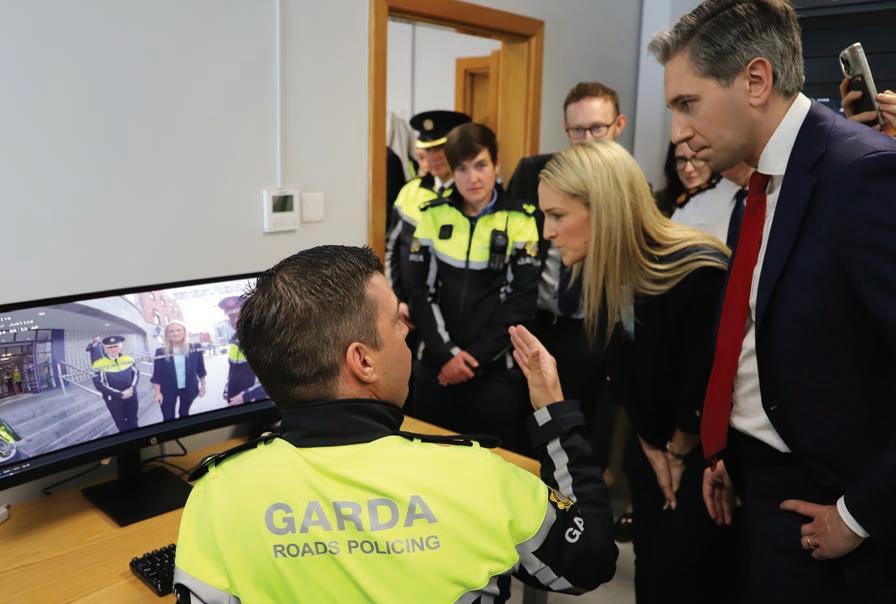
The Garda Síochána (Recording Devices) Act 2023 was signed into law on 5 December 2023. Subsequently, the Garda Síochána (Recording Devices) Act 2023 (Code of Practice) Order 2024 was signed by the Minister for Justice. An Garda Síochána has since been working to introduce body-worn cameras for members in accordance with this Code of Practice.
An Garda Síochána is undertaking three phased introductions as part of its proof of concepts stage. Each phase involves the use of a range of body-worn cameras by frontline gardaí in specific locations throughout the State.
The three proof of concept phases are designed to test the technical aspects of each camera, how they will be used operationally in addition to the training, Code of Practice, and governance of their use.
Phase one of these three phased introductions has now commenced in Dublin. There are currently 100 frontline Gardaí working at Pearse Street Garda Station, Kevin Street Garda Station, and Store Street Garda Station respectively who are fully trained in the use of body-worn cameras, and the cameras are now both visible on their uniforms and in use while on-duty.
It is anticipated that by the end of June 2024, between 350 and 400 frontline gardaí in Dublin will be fully trained and have the cameras in use.
An Garda Síochána states that it continues to engage with stakeholders and the communities it serves as it develops its Codes of Practice and in advance of the full deployment of body-worn Cameras.
At the launch, Garda Commissioner Drew Harris said:
“From today [31 May 2024], gardaí in three Dublin stations – Store Street, Pearse Street and Kevin Street –will begin using
body-worn cameras, with two other stations in Limerick and Waterford cities to follow in the coming months.
“The ability of An Garda Síochána to securely acquire and process digital evidence is a key feature of modern policing.”
He said that the launch of a proof of concept for bodyworn cameras and the supporting digital evidence management system (DEMS) is “an important milestone for An Garda Síochána towards the implementation of information-led policing”.
“Body-worn cameras, supported by the underlying legislation, technology and training will act as an important evidentiary tool. International experience has also shown that body-worn cameras will increase safety for gardaí and the public. Now through this proof of concept we will be able to refine our systems and processes for body-worn cameras based on experience and feedback.”
The Garda Commissioner Harris was joined at the launch at Store Street Garda Station by the Taoiseach, Simon Harris TD, and the Minister for Justice, Helen McEntee TD.
The Taoiseach said: “Body-worn cameras are vital to protecting gardaí on the beat as they experience an increase of attacks which will not be tolerated.
“Too often, gardaí find themselves in situations where they are being recorded in tense situations with footage often edited to suit a particular narrative. This technology will offer protection both to gardaí and to the public with accurate recording of incidents.”
The pilot roll-out of body-worn cameras is a first step which, it is hoped, will continue later this year in Limerick and Waterford. When complete, the three-phased pilot will inform their introduction in garda stations nationwide.
95 future of policing report
Credit: An Garda Síochána
Taoiseach Simon Harris TD and Minister for Justice Helen McEntee TD were in attendance as An Garda Síochána launched its new body-worn camera pilot.

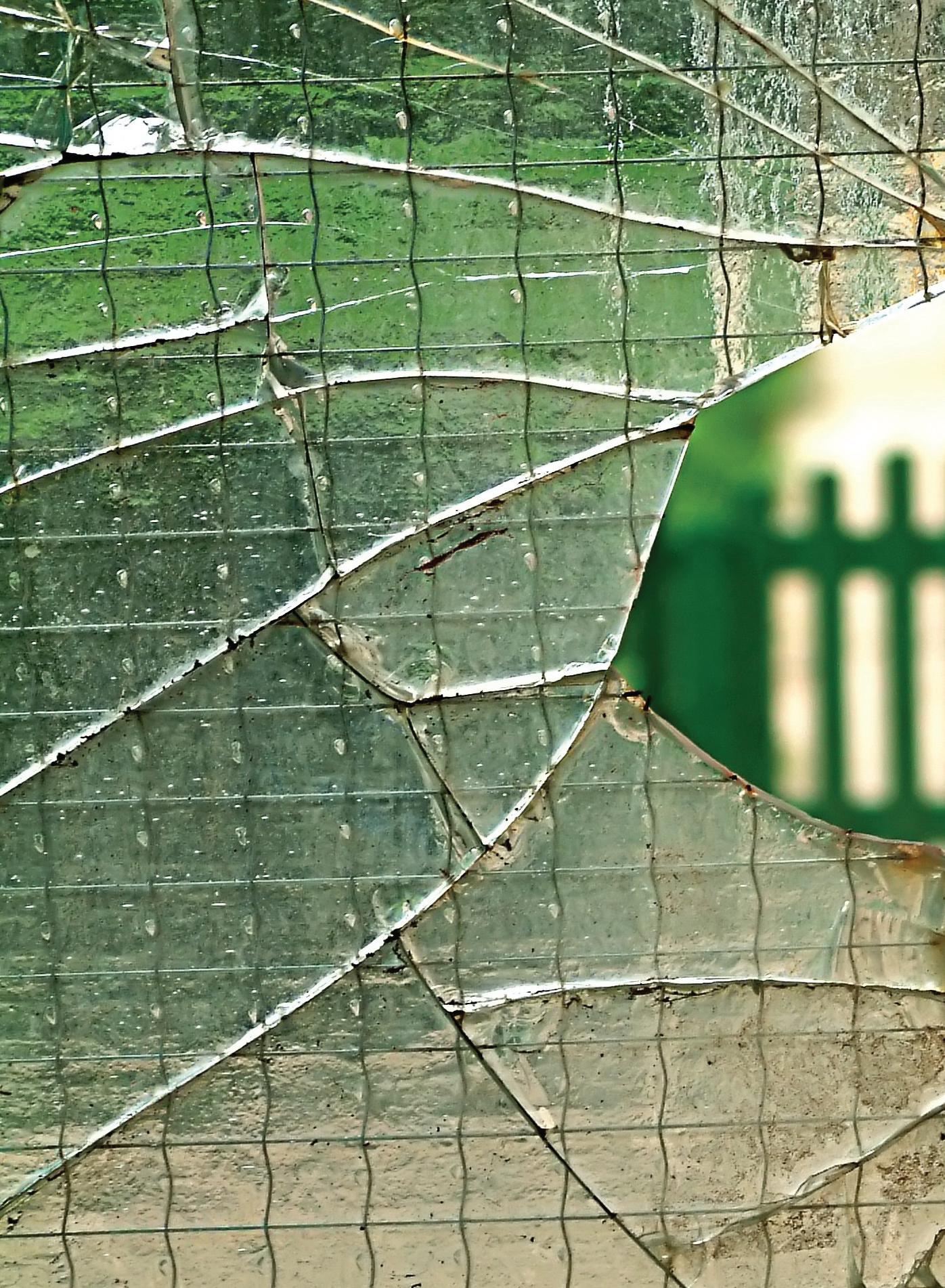
Crime and policing statistics
Recorded crime victims 2023
Murder or manslaughter
• 67% male
• 33% female
Physical assault and related offences
• 60% male
• 40% female
Sexual offences
• 19% males
• 81% females
63% or sexual crimes reported in 2022 occurred in the previous 12 months, whilst 21% occurred more than ten years prior
In 2022, one-fifth of sexual offence crimes had a male offender and a male victim
Source: CSO, April 2024.
96 future of policing report Keeping People Safe
Keeping People Safe


Crime between 2022 and 2023
20% decrease in homicide and related offences
1% decrease in attempts/threats to murder, assaults, harassments, and related offences
3% decrease in fraud, deception and related offences
12% increase in theft and related offences
Virtually no change in incidents of controlled drug offences between 2023 and 2022
Source: CSO, March 2024.
An Garda Síochána in 2022
€57 million in drug seizures by the Garda National Drugs and Organised Crime Bureau
54,000 domestic abuse incidents attended to by An Garda Síochána during 2022 compared to just under 50,000 incidents in 2021
There has been increase of 36% of property crime observed in 2022
During 2022 fatal road traffic collisions increased by 20%, with over 7,750 drivers for Driving while intoxicated offences.
Source: An Garda Síochána, Provisional Crime Statistics 2022, March 2023
97 future of policing report

Keeping People Safe

Passed by both Houses of the Oireachtas in February 2024, the Policing, Security and Community Act has created a new board of An Garda Síochána. In another significant change, the Act provides for the independence of the Garda Commissioner in relation to the performance of their functions.
The Policing, Security and Community Safety Act aims to:
• make community safety a whole-ofgovernment and multi-agency responsibility;
• strengthen and consolidate independent, external oversight of An Garda Síochána;
New Policing Act brings in sweeping reforms
The recently-passed Policing, Security and Community Safety Act 2024 aims to “strengthen the governance of An Garda Síochána and to provide for clear and effective oversight and accountability of An Garda Síochána”.
• enhance the internal governance of An Garda Síochána by establishing a new non-executive board, Bord an Gharda Síochána, which is a corporate governance standard across the public and private sectors; and
• strengthen independent review of security legislation and the delivery of security services by providing for the establishment of an Independent Examiner of Security Legislation.
Other key features
The new Act aims to establish a suite of new institutions to account for the transfer of powers.
The new Local Community Safety Partnerships (LCSPs) aim to provide a forum for state agencies and local community representatives to “work together to act on community concerns”. These groups will have a broader remit and broader membership than the joint policing committees they will replace. Three pilot LCSP schemes have been running since 2021 in Dublin’s north inner city, Waterford, and Longford.
The Department of Justice states that learnings from these pilot programmes have informed the drafting of the Bill and the plans for the rollout of the LCSPs across the country.
98 future of policing report
Keeping People Safe

The new legislation introduces independent external oversight of An Garda Síochána through the establishment of An tÚdarás Póilíneachta agus Sábháilteachta Pobail (the new Policing and Community Safety Authority), which will combine the existing oversight function of the Policing Authority and the functions of the Garda Inspectorate.
A reformed police complaints body – Fiosrú – Oifig an Ombudsman Póilíneachta (the new office of the Police Ombudsman) will be established to replace the Garda Síochána Ombudsman Commission (GSOC) and reformed processes and procedures will be put in place relating to the handling of complaints and the conduct of investigations into allegations of wrong doing on the part of members of Garda personnel.
The Act also aims to support the internal capacity of An Garda Síochána to manage itself effectively, deliver reform, increase diversity, and improve outcomes for communities.
Journey to passage and principles
A report by the Commission on the Future of Policing in Ireland identified that much of the work of Gardaí relates to the non-crime activity of “preventing harm to people with addiction or mental health conditions, resolving issues for those who are homeless, the elderly, children and others at risk”. Under the new legislation, the prevention of harm will be a specific statutory objective of An Garda Síochána.
In tandem with this, the new Act embeds a key principle from the Commission’s report that preventing crime and harm and making communities safer does not rest with An Garda Síochána and the Department of Justice alone.
The Department of Justice states that when it comes to the prevention of crime, there will be a “whole of government responsibility” with departments and agencies such as health and social services, education authorities and local authorities, the Gardaí and the wider community working in tandem with shared objectives.
Speaking in January 2024, when the then-Bill had been voted for by the Houses of the Oireachtas but prior to final sign-off from President Michael D Higgins, Minister for Justice Helen McEntee TD said: “This Bill recognises that responsibility for community safety does not rest with An Garda Síochána alone but requires other government departments and state agencies to work together.
“Importantly, this legislation has communities at its heart, recognising that it is the people living in a community who know that community best.”
New bodies created under Policing, Security and Community Safety Act 2024
• Bord an Gharda Síochána (Board of An Garda Síochána)
• An Oifig Náisiúnta um Shábháilteacht Pobail (National Office for Community Safety)
• An Grúpa Stiúrtha Náisiúnta um Shábháilteacht Pobail (National Community Safety Steering Group)
• An tÚdarás Póilíneachta agus Sábháilteachta Pobail (Policing and Community Safety Authority)
• Coimisiún Ombudsman an Gharda Síochána (Garda Síochána Ombudsman Commission)
• Oifig an Scrúdaitheora Neamhspleách um Reachtaíocht Slándála (Office of Independent Examiner of Security Legislation)
99 future of policing report

Keeping People Safe
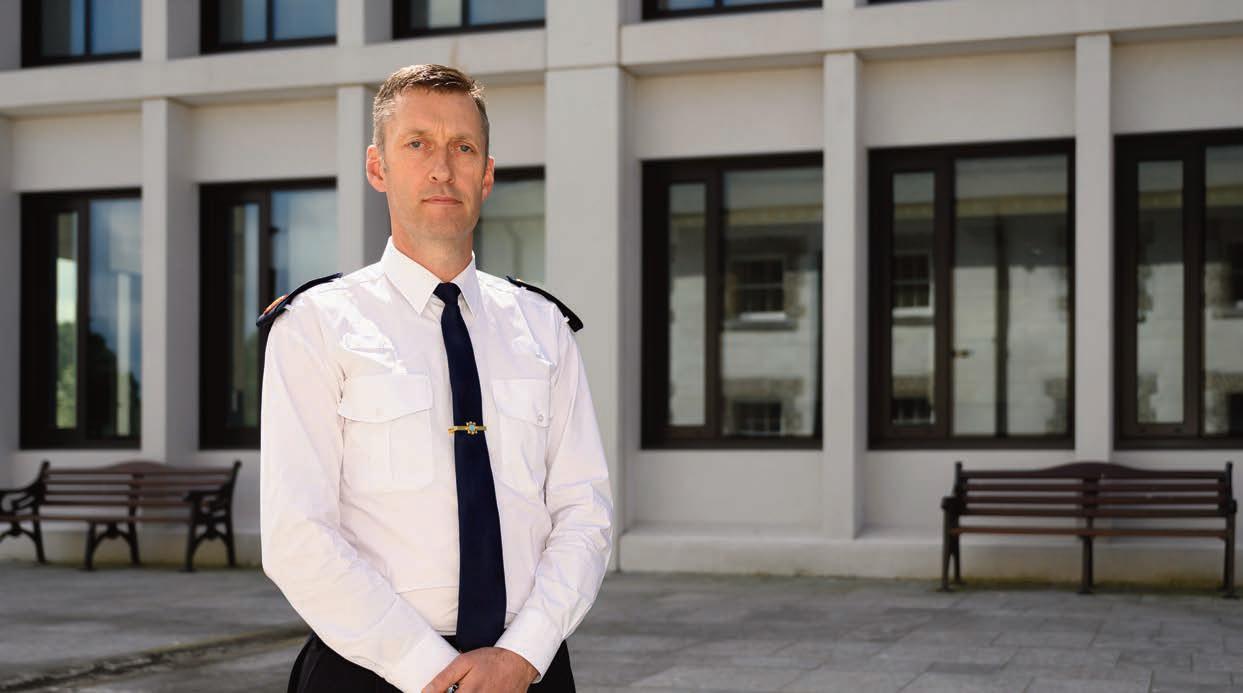
Garda Assistant Commissioner Justin Kelly: Policing organised and
serious crime
Ciarán Galway visits Walter Scott House to discuss policing priorities, talent management, leadership, and ambition with An Garda Síochána’s (AGS) Assistant Commissioner for Organised and Serious Crime (OSC), Justin Kelly.
Named after an Honorary Commissioner of the New York City Police who, in 1923, presented An Garda Síochána with a $1,000 gold bond (which would perpetually fund the gold Scott Medal for Valor), Walter Scott House was officially opened in November 2022.
A stone’s throw from Heuston Station in Dublin 8, the ultra-modern building is home to most of the specialised national bureaux under the Organised and Serious Crime umbrella.
Heading up Organised and Serious Crime, Kelly is now in his 32nd year of service with An Garda Síochána and was appointed to his current role as Assistant Commissioner in May 2022.
A native of Dublin, Assistant Commissioner Kelly served as a frontline Inspector in Blanchardstown and Clondalkin in Dublin, then as a Detective Inspector in the Drugs and Organised Crime Bureau before ascending to the rank of Detective Superintendent in the Garda National Protective Services Bureau, and most recently served as Detective Chief Superintendent, in the AGS’s Special Detective Unit.
“Previously, I had worked in several areas across the organisation at different ranks. Upon being appointed Assistant Commissioner, I was struck by the quality of expertise we have working within OSC across all the different ranks,” he observes.
Reflecting on his career trajectory, Kelly expresses a preference for operational service. “As is the case in any organisation, the more senior you become, the further you move away from operational activity,” he says, adding:
“However, I am lucky in that all the units within OSC are operational in nature. As such, while I do not have the same level of input in operational activity, I still have considerable understanding of what is going on in the organised crime area both nationally and internationally. That is somewhat unique relative to the roles of other assistant commissioners.”
Equipped with nine postgraduate qualifications, including three master’s degrees, the Assistant Commissioner places significant emphasis on education and specialist training.
“I have been fortunate to have had several of these qualifications supported by An Garda Síochána, for instance, a master’s in criminal justice from John Jay College of Criminal Justice in New York City. That was particularly useful in gaining perspective beyond AGS and Ireland,” he says.
“Completing an MBA at Dublin City University was hugely significant from a personal development perspective, and most recently I completed the Strategic Command Course at the College of Policing in the UK.”
Evolution of policing
Reflecting on the evolution of policing over the last three decades, Kelly remarks that the change is “immeasurable”. “When I started frontline policing in 1993, how we were trained and equipped was relatively basic. Previously we would not have had a nuanced understanding of particular crimes, such as domestic violence and child sexual abuse. There was little
100 future of policing report
external oversight but there has been a sea change in policing since then,” he recalls.
“Unlike today, professional development was partially down to circumstances. I was lucky, for instance, in that when I started in Tallaght, I had some exceptionally strong leaders and mentors. When I think back to specific role models, Andy Callanan comes to mind. He was a Sergeant when I started out and was murdered in Tallaght Garda Station in 1999. We recently remembered the 25th anniversary of his death at our annual memorial day in Dublin Castle.
Strategic priorities
Within Kelly’s OSC remit, there are around 1,000 people working across eight bureaux:
1. Garda National Bureau of Criminal Investigation;
2. Garda National Cyber Crime Bureau;
3. Garda National Drugs and Organised Crime Bureau;
4. Garda National Economic Crime Bureau;
5. Garda National Immigration Bureau;
6. Garda National Protective Service Bureau;
7. Garda Technical Bureau; and
8. Operational Support Services.
Within this enormous remit, each of the bureaux have their own specific priorities and the Assistant Commissioner offers a snapshot of some of the work being undertaken.
Firstly, when people think of organised crime, they most commonly call to mind the work of the Garda National Drugs and Organised Crime Bureau. “Its major focus is preventing the circulation of illegal firearms and the importation of controlled drugs, particularly cocaine, into the State. In recent years, this focus has revolved around investigating and disrupting organised criminal groups, thwarting their targeting of rivals, and the associated murders,” he explains.
In the sphere of cybercrime and cyber dependent crime, a major challenge is ensuring that the technology and training deployed by AGS keeps pace with developments in cyber threats.
Keeping People Safe
“Cybercrime requires constant vigilance because if we do not stay on top of it, the implications are extremely costly, not just for individuals and businesses, but for the State itself. From that perspective, we must retain the right expertise in the Garda National Cyber Crime Bureau,” the Assistant Commissioner asserts.
In the context of the establishment of the Garda National Protective Service Bureau, there have been significant developments in work to protect the vulnerable, particularly women and children, over the past decade. “We still have so much more work to do, particularly in the area of domestic violence,” Kelly acknowledges, adding: “Another major challenge we have relates to online child exploitation given the explosion in the frequency of cases that we are observing.
“For us, the most significant risk in the online child exploitation reports we receive is that sometimes that content involves Irish children. The identification of those children is a key priority for us.”
Given the breadth of his remit, there is an obvious and perhaps inevitable challenge around resource allocation across the competing demands within An Garda Síochána. Currently, this is exacerbated by events such as rioting in Dublin in late 2023, increasing street protests, and challenges relating to immigration.
“Immigration, specifically offences relating to illegal immigration and deportation, is another area which requires my increasing attention. That has become hugely topical with a significant influx of people seeking international protection in Ireland,” the Assistant Commissioner says.
Borderless crime
Today, almost every serious crime type is transnational in nature, most obviously cybercrime, human trafficking, organised prostitution, and the importation of controlled drugs. “These crimes have connections to transnational organised crime groups all over the world, alongside non-state actors who have the potential to harm Ireland’s critical infrastructure from across the world,” he explains.
“However, unlike our geography, policing in Ireland is not an island. The only way

that we can confront transnational crime is to work with partners such as Europol, Interpol, Frontex, and MAOC-N, which assists us in relation to maritime drug interdictions.
Similarly, AGS works very closely with its counterparts in the UK, including the National Crime Agency, as well as participating in daily interactions with the PSNI in the North. “Each week, we have people from the different bureaux across OSC working abroad, involved in joint investigation teams across Europe. Likewise, we often host personnel from external partners or international police forces, to work towards shared objectives.”
Cocaine
Despite significant seizures made by AGS and Revenue, there is no shortage of cocaine in Ireland. Explaining the prevalence of the drug, which chiefly emanates from South America, Kelly bluntly states: “Consumption drives demand.”
“According to United Nations Office on Drugs and Crime figures, Ireland’s consumption of cocaine is joint fourth highest in the world as a percentage of the population,” he outlines, elaborating: “So, on one hand you have significant demand for cocaine in Ireland and on the other you have – for various geopolitical reasons – massive supply in south America.”
With Europe the number one market for cocaine globally, the logistical challenge for drug cartels in south America is transporting it from A to B, and, in Ireland’s case, landing it on the island. This is the vector by which the drug interdictions operations of AGS can have a major impact.
“The effect of policing is reflected in fluctuations in the wholesale price of cocaine and its availability in correlation with our successes. At various times, we have observed that tangible impact.
“The overarching objective of the National Drugs and Organised Crime Bureau is to make Ireland as hostile an environment as possible for the importation of controlled drugs. We try to make it as difficult as we can.”
Emphasising the time and effort that is invested in successful drug interdiction operations which have resulted in 10s and sometimes 100s of kilograms of drugs being seized, Kelly stresses:
101 future of policing report
4

Keeping People Safe

“What eolas Magazine readers see on the Six One news is simply the sharp end of drug interdiction operations –where we actually intercept and arrest people – however, most of the work has already taken place over several months and involved hundreds of people.
“International relations can be a significant aspect of this, particularly in relation to the sharing of information between our partners in the NCA and the DEA in the UK and US, respectively. The networks that our international law enforcement partners have is vast, so we try to leverage them as much as possible.”
Organised crime groups
While two major organised crime groups (OCGs) have dominated the public consciousness since a feud erupted between them in 2015, Kelly emphasises that the organised crime landscape is much broader, with other sophisticated OCGs emerging.
“We have different OCGs at varying levels of sophistication. Some of these specialise in particular crime areas, while others span across several different crime areas. However, any of the groupings that are in any way significant are international in nature. They have the capacity to move money, product, and people transnationally,” he explains.
AGS’s focus is on identifying all the groupings and conducting a threat assessment of each one in order the prioritise resource allocation. “That helps us focus our strategies on which OCGs we will target. That changes all the time,” the Assistant Commissioner says, adding: “We are undertaking a lot of work with Europol around organised crime threat assessments. Among the trends identified by Europol are
prevalence of Irish OCGs. They are the ones in which we are most interested.
“There will always be more people committing crime than there are police personnel. As such, we must deploy our resources intelligently. That is determined by the level of threat posed by a particular OCG to society.”
Avoiding reference to any specific OCG, Kelly emphasises the “significant inroads” made into investigating and disrupting highest risk organised and serious crime in recent years, particularly in relation to high-profile threat to life (TTL) operations.
“At our peak, we were running TTL operations on a weekly basis amid feuding between OCGs. For AGS, that means running major surveillance and armed response operations. In 2024, the frequency of these operations is greatly reduced. We interpret that as an indicator of our success and a demonstration that we have degraded the abilities of the relevant OCGs.
“From top to bottom, we have incarcerated individuals organising, facilitating, and directing assassinations, as well as the potential murderers themselves. There are many people serving sentences for such crimes, some of them of very lengthy,” he asserts.
Talent management and recruitment
Given the skilled nature of many of the roles across the OSC bureaux, talent retention is a challenge. “Within AGS, we invest considerable time and money on training people up to the highest standards. Given that their skillsets are sought after, this talent is then headhunted by private entities or even other public service bodies.
“At a senior leadership level, we have undertaken significant work with our HR department around talent retention. Unfortunately, in the public service, there is a limit to what we can do relative to the private sector. But we are working hard to avoid losing people to alternative careers,” Kelly acknowledges.
Resourcing and leadership
Conceding that there are several units within OSC’s remit that are functioning below optimal strength, the Assistant Commissioner is keen to consolidate their operational capacity. “We must determine what strength is required and get to that point. That is a constant priority,” he notes.
“The Garda Commissioner [Drew Harris] is incredibly supportive of OSC and in fairness to government and the Department of Justice, we have had significant investment across several areas. For instance, we have two helicopters in service and a brand new one in production at Airbus in France. That is a huge investment. Similarly, all our Cyber Crime Bureau and Technical Bureau personnel can require very expensive training and equipment.”
Discussing leadership within OSC, Kelly expresses an ambition to continue to ensure that the highest calibre of talent is leading each of the bureaux.
“Currently, we have six detective chief superintendents who are supremely dedicated professionals with ample experience. They really know their roles,” he says, elaborating: “It is important that I can provide them with everything necessary to do their jobs and that we ensure that we retain that quality of talent in positions of leadership.”
Personal ambition
From a personal perspective, Kelly is keen to continue to contribute at a senior leadership level. “I want to continue to support the Commissioner through the organisational challenges that we are working through within AGS.
“For those of us at assistant commissioner level, it is important that we do not develop a silo mentality. My own policing interests, for example, are far broader than organised and serious crime. The senior leadership team meets as a collective on a weekly basis and it is important to devote time to those other spheres,” the Assistant Commissioner concludes.
102 future of policing report
Fresh Thinking


Digital government report
Sponsored by

Where to now for successful digital government in 2024?
Two years ago, the Government introduced the Connecting Government 2030 strategy, aiming to create a trusted, human-driven, intuitive, and inclusive digital government service by 2030. The ambitious objectives include having 90 per cent of applicable services consumed online and 80 per cent of eligible citizens using MyGovID by 2030, writes Aine McCarthy, Head of Project and Portfolio Management, Fexco Advisory Services.

Fresh Thinking 104 digital government report Advertorial
In November 2023, Fexco hosted a round table with key stakeholders from the public, semi-state, and private sectors to discuss enhancing citizen and business engagement amid pervasive digital disruption. The focus was on the steps necessary to achieve the vision set out in the strategy.
In December 2023, the Government followed up with the Designing Better Public Services action plan prepared by the Department of Public Expenditure, NDP Delivery, and Reform in Ireland. It outlined a comprehensive roadmap for embedding design principles and practices into public service delivery from 2024 to 2025. The plan emphasises a human-centric, collaborative, and innovative approach to redesigning public services to address contemporary challenges such as fiscal constraints, climate change, social inequality, and evolving demographics.
Where are we now? With so much change and disruption as new technologies make their presence felt, what does that mean for designing these engaging services for the public?
Designing for public buyin
Evolution is crucial. Whether for public or private sector services, expectations are changing at an unprecedented pace. At its core, these expectations revolve around the human experience.
Citizen and business engagement thrives when the human experience is prioritised in service design, allowing technology to enhance personal human experiences rather than replace them. Providing good service involves not only convenience but also personalisation. Governments and semi-state agencies must design scalable services that cater to individual experiences.
During our session in November, participants discussed how citizens now expect personalized services across all sectors, driven by advancements like generative AI, which require robust data and processes to be effective and secure. They also emphasized the need for agility and openness to change from both technological and cultural perspectives.
How do you reflect these decisions in
Fresh Thinking

“Governments and semi-state agencies must design scalable services that cater to individual experiences.”
Aine McCarthy, Head of Project and Portfolio Management, Fexco Advisory Services
designing services for the public? From a Fexco perspective, we would suggest the following principles as the top 10 rules for designing services:
• Put people first in design.
• Design services to be inclusive.
• Design our services together with key stakeholders.
• Design for user trust.
• Design in such a way that knowledge can be reused and shared.
• Challenge assumptions and design with evidence.
• Design from the top down and bottom up.
• Design to deliver value in all its forms.
• Always build, test, learn, and iterate.
• Design to make things simpler.
A good example is the Passport Service home and renew their passports within a week, improving trust and satisfaction. The service builds on these principles and has seen demand rise with over 480,000 passports issued already in 2024.

Key design drivers: Enhancing user experience
As Ireland continues to digitally transform its public sector, several key trends shape the landscape, with a focus on designing to enhance user experience, promoting sustainability, and ensuring inclusive access to digital public services. These trends highlight the importance of customer-centric approaches and practical steps the government can take to drive digital transformation effectively.
Digital infrastructure: The National Broadband Plan aims to provide gigabit connectivity to all Irish households and businesses by 2028 and ensure 5G coverage in all populated areas by 2030. This will be a vital milestone that will see rapid adoption by the public of new services.
Digital skills and literacy: According to the most recent CSO Digital Literacy Report, in 2023, 35 per cent of internet users accessed information stored about them by public authorities, such as checking their pension or employment status. Additionally, 16 per cent accessed publicly available information in electronic databases like property 4
digital government report 105 Advertorial
Fresh Thinking

registers. Over 44 per cent made appointments or reservations via websites or apps with public services, such as library bookings or government appointments. Six in 10 users sought information online about benefits, entitlements, services, and laws, with females more likely than males to request benefits or entitlements. Around 16 per cent requested official documents or certificates.
This report is encouraging. However, any service should not only cater to growing demand but also be accessible to people whose digital literacy levels may fall below the standard, ensuring that elderly and vulnerable adults are catered for. Over time, the Government’s 10-year Adult Literacy for Life Strategy will promote high-level digital skills through higher education and training programs.
Data utilisation and privacy: Effective use of data is crucial for improving public services. The Government plans to implement robust data management structures that respect privacy and enhance the reuse of data to inform policymaking and service delivery.
Optimising customer experience
A central theme in Ireland’s digital government strategy for public service design is creating a usercentric experience, which involves understanding user needs, simplifying service access, and ensuring consistency across various platforms. Prioritising a human-driven digital experience makes services more intuitive and accessible, engaging users to gather feedback and improve service design and delivery. Simplifying service delivery through an ecosystem of standards, resources, and tools, including the “once-only” principle where citizens provide information once for reuse across services, enhances efficiency.

Ensuring digital services are inclusive is critical, with a digital inclusion roadmap supporting those lacking internet access or digital skills to ensure no one is left behind.
Practical frameworks for effective public sector design
To enhance the design of digital government services effectively, several practical steps are essential. First, establishing strong governance structures is crucial to oversee digital transformation efforts. This includes creating cross-sectoral groups and digital leaders’ forums to ensure cohesive and collaborative leadership across all levels of government.
Next, continuous investment in digital skills and literacy programs for both public and civil servants is necessary. This ensures the workforce is wellequipped to handle new digital tools and processes, fostering a culture of innovation and adaptability within government services.
Engaging with stakeholders through regular consultations is another vital step. By gathering feedback from citizens, businesses, and other stakeholders, the Government can adjust strategies to better meet the needs of all users. This collaborative approach helps build trust and ensures that digital services are user-centric. However, despite these steps, this is an enormously complex task and without a clear structure and process, public sector service providers could find themselves overloaded with demands and considerations to balance, and potentially design something that may not achieve any of those needs.
106 digital government report Advertorial
Focusing on digital and user experience is crucial today, as public service consumers’ demands and expectations are at an all-time high as we continue to effectively modernise its public services through a human-centric lens, across a wide range of public services such as an efficient tax system. As an operator of services on behalf of both the public and private sector that interacts with millions of individuals and businesses in Ireland on an annual basis, Fexco has a clear view of what makes a good user experience, and we have defined our definition and framework of what digital is which may help when designing public services.
From our decades of working with both the public and private sector, we have devised a framework can inform and guide critical steps and milestones for successful design.
D.I.G.I.T.A.L Framework
Design for personalised experience, at scale.
• Segment the user base into logical personas or groupings.
• Design services to ensure a positive, personal experience per segment.
• Integrate services and data to personalise the experience to the individual. Involve and learn from your users.
• Hold user focus groups during design and use customer feedback to improve continuously.
• Regularly map the customer journey and be open to adjusting business processes for better experiences.
Gather and use data to determine what is possible in the future but harnessing the power of the past.
• Record and analyse user behaviour to define the optimal journey.
• Track channel shifts to identify broken journeys gather and act on user feedback and insights.
• Use predictive analytics models for future experience requirements.
• Integrate and share systems and data:
Fresh Thinking

1. Design all new services to share relevant data.
2. Seek and integrate relevant systems and data to enhance the user experience and supporting a personalised experience.
3. Continuously challenge and remove barriers to sharing.
• Try new things:
1. As the world around us evolves, so too will the tools and technology around us. AI, IoT, quantum computing are examples of current disruptors, but will be accompanied by many more advancements in the future.
2. Embrace the change and try the new, focusing on identifying real improvements for the user experience.
• Automate:
1. Seek opportunities to automate processes that will improve a user experience, either in an assisted or unassisted capacity.
2. Automate user interactions that are trusted and provide certainty to customers, but design to allow for human interaction if required. Learn and adapt in an agile manner.
3. Continuously review and learn from the past to help shape the future.
4. Leverage learning from other industries to shape your own.
5. Be curious and challenge the status quo.
6. Be agile and change fast if the need arises.
Finally, implementing robust monitoring and evaluation frameworks is essential to track progress and measure the impact of digital initiatives. By ensuring that goals are met and identifying areas for improvement, the Government can maintain a high standard of digital service delivery and continually refine its strategies to adapt to changing needs and technologies.
Conclusion
Ireland’s journey towards a leading digital government is well underway, driven by a comprehensive strategy that prioritises user experience, sustainability, and inclusivity. However, it is always a good idea to sense check that progress aligns with the overarching strategy, and where necessary to be flexible to ensure that the result is readily adopted by the public.
With a rapidly changing environment driven by technology, it is tempting to adopt the latest technology, but without consideration of the public’s needs, you could find yourself in a technologically designed cul-de-sac that will drain resources and not be utilised by the public. This should inform your design framework, to ensure the design process does not flounder due to excessive and competing agendas.
Two years (and three round tables later), we see that with these key trends combined with taking practical steps to implement them, the Irish Government can design and enhance public services, support economic growth, and contribute to a more sustainable future.
W: www.fexco.com
digital government report 107 Advertorial
Fresh Thinking

Web 3.0: Driving digital public services
Government Chief Information Officer (CIO), Barry Lowry, discusses the role of Web 3.0 in driving digital transformation of public services.
Lowry believes that Web 3.0 will pose challenges and opportunities to the delivery of digital public services but, more broadly, will have an impact on every citizen, business, and government body.
Although multiple definitions of Web 3.0 exist, Lowry suggests the one he finds most accurate is as “the third phase in the evolution of the internet, characterised by decentralisation, ubiquity, and artificial intelligence”.
Mapping the scale of change that has taken place in the past 30 years from the emergence of Web 1.0, which was dedicated to users searching for data and made up of static pages connected to a system via hyperlinks, to Web 2.0, which is more focused on the principles of participation and broader contribution with multi-device access, Lowry says that Web 3.0 represents a move away from the centre.
“We have gone through a cycle where
everything has been pushed into the centre, through things like hybrid clouds, but now everything is being pushed out again, driven by the Internet of Things (IoT). That will drive edge computing, edge clouds, and enable the integration of artificial intelligence.”
Two key phrases aligned to Web 3.0, which Lowry believes will present both challenge and opportunity, are: Trustlessness: You do not need to place
108 digital government report
your sole trust in any one stranger, institution, or other third party for a network or payment system to function.
Permissionless: The users and developers of the network do not need permission from anyone to transact and use. Theoretically, anyone can use a permissionless network without access being granted by a centralized authority.
The evolution of Web 3.0 is happening in the context of the European Union’s move to put digital as central to delivery.
Lowry describes the European Commission President Ursula von der Leyen’s State of the Union speech on 15 September 2021, which described digital as a “make or break issue”, as a major milestone.
Two particular pieces of regulation point to the recognition by the EU that digital government is going to be somewhat decentralised. Alongside the single digital gateway, the eIDAS 2.0 regulation is the enabler of the single digital wallet.
“In other words, it is the first step that Europe has made to say that the running of government is going to be decentralised into our own hands and pockets going forward. It is a real gamechanger for how every government service is going to be provided.”
Lowry is somewhat critical of the European Commission’s adoption of a new strategy on Web 4.0, believing that the EU’s desire to lead the conversation can often overshadow the requirement for substantial debate and understanding of policy creation.
“AI is a good example of this. The EU’s AI Act has gotten to a good place but the early iterations included elements that were not plausible. Similarly, before creating policy around Web 4.0, there needs to be an understanding of Web 3.0 and how it can deliver.”
Echoing concerns raised by Forrester’s Principal Analyst, Martha Bennett, in an article entitled Web 4.0? Let’s figure out Web 3.0 first, Lowry says: “Complete decentralisation is neither possible nor desirable. What we need is a constructive debate on what ‘decentralisation’ means and why certain central control points or trusted third parties may be unavoidable, not the pretence of ‘decentralised’ and the seemingly unthinking parroting of those claims.”
A further point raised by Lowry relates to the need to recognise and manage risks
Fresh Thinking
within Web 3.0. Using the assumption of Blockchain as a means to remove fraud as an example, he says: “Phrases like ‘known as the technology of trust’ just perpetuate the myths around the technology. Blockchains are not inherently more secure, and data on a blockchain is only trustworthy if one can be sure that it was truthful and correct at the time of recording.
“We need to set the controls right,” he states, “There needs to be a balance between a good user service, and a really secure, managed user service.”
Lowry says that this approach is central to Ireland’s advances in digital public services. The Digital Decade Policy Programme out to 2030 is underpinned by three key pillars of:
• cultural change: Recognising that an analogue public service is not suitable for a digital 3.0 world;
• EU regulatory adherence: Building on Ireland’s digital influence within the EU and maintaining that influence by acting as a leader in creating and implementing regulation; and
• achieving quick wins: Maintaining political support through demonstrating how the move from eGovernment, which was simply computerising manual process, to
Life Events Programme
digital government, has enabled a rethink of services completely.
Lowry contextualises that often the public’s perception of digital government is centred on life events, which often require multiple public services. “Good public services will enable people to tell us their information once, where that information is managed and as a result, an environment is created whereby more services can be provided on the basis of that information. This approach is very much linked to the design principles for government launched at the start of 2023, which put the person at the core of everything we do.”
Concluding, Lowry points out that the Government is already embracing potential opportunities. At the end of 2023, a pilot scheme of the Government’s digital wallet was launched and includes four credentials.
“The early outcomes show the benefits that exist from the power of government verifying your identity, which can then be used for a multitude of things, is a gamechanger.”
The digital wallet pilot, while not mandatory, is expected to be extended to the wider public service and public across 2024.
On 5 June 2024, Minister for Public Expenditure, NDP Delivery and Reform, Paschal Donohoe TD announced that the Cabinet has agreed to advance the development of the Government’s ‘Life Events’ Programme.
Aiming to make public services to be more accessible, proactive, convenient, seamless both online and in line with the Better Public Services strategy.
The Life Events programme aims to address the disjointed nature of government services around major life events ranging from births to death.
The Minister says that three key initiatives that are underway “will work together to provide a seamless and integrated experience, making public services easier to navigate,” including:
Digital wallet: A secure mobile app that will house digital versions of personal government documents related to various life events. From as early as the end of 2024, the public will begin to have the option to access interactive digital copies on their phones through the Digital wallet.
Life events: An online platform where the public will access services grouped around life events. Users will interact with one services website instead of multiple websites and other platforms.
Service redesign: Work to understand unmet needs, uncover opportunities and redesign key services based on life events. The programme also focuses on simplifying complex services, making them easier to navigate and access.
digital government report 109

Access to the old eTenders website has now been extended into 2025. Public procurement buyers should act now to retain past competition records in advance of this deadline.
In 2023, Ireland’s national electronic tendering website, eTenders, switched to a different service provider and a new eTenders website was launched.
Public buyers and suppliers have since been able to access both the new and old eTenders websites. Following stakeholder engagement and consultation, access to the old eTenders website has been extended into 2025. This will support contracting authorities as they work to complete the archiving process. Public buyers now have until 31 January 2025 to close, archive and download their files on the old eTenders website. After 31 January 2025, all tenders will be automatically moved to an archive state. Public buyers will continue to have the option to download their archived files until 21 May 2025. For more details on specific milestones within that extension timeline, public buyer users should visit gov.ie/ogp
The OGP is encouraging anyone who used the old website to take action now to ensure that they retain the procurement competition files they require. This is particularly important for public buyers.
Maintaining procurement competition records
Each year, thousands of EU- and national-level competitions are posted on the eTenders website. Using the eTenders website allows public buyers to procure electronically in a way that is compliant with public procurement regulations.
Contracting authorities and public buyers have to comply with data protection, data retention and legal and policy requirements. They are tasked with maintaining appropriate records throughout the purchasing process and beyond.
While eTenders was never intended as a facility for long-term record keeping, over the years, many buyers have become accustomed to the convenience of using eTenders to store and access competition files.
With access to the old site ending soon, the OGP is asking public buyers to take three key steps to save their past competition files before the January 2025 deadline so that they can continue to meet their record keeping and data retention obligations.
110 digital government report Advertorial

Key steps to retrieving data from eTenders
1. Close: Close any procurement competition on the old site that you want to retrieve data for.
2. Archive: Move closed competitions to the Archive area on the old eTenders site.
3. Download: Once a procurement competition has been closed and moved to the Archive area, download the archive file to your designated local storage location.
After 31 January 2025, all tenders will be automatically moved to an archive state and public buyers will continue to have the option to download their archived files until 21 May 2025.
A detailed guide with further information on how to close, archive and download procurement competition files from the
old eTenders website is available, visit gov.ie/ogp
The Office of Government Procurement
eTenders is managed by the Office of Government Procurement (OGP). The OGP is the national authority for public procurement and is responsible for driving the public procurement reform programme in Ireland. The OGP is a division of the Department of Public Expenditure, NDP Delivery and Reform.
For further information: W: www.etenders.gov.ie www.gov.ie/ogp nd Reform.

digital government report 111 Advertorial
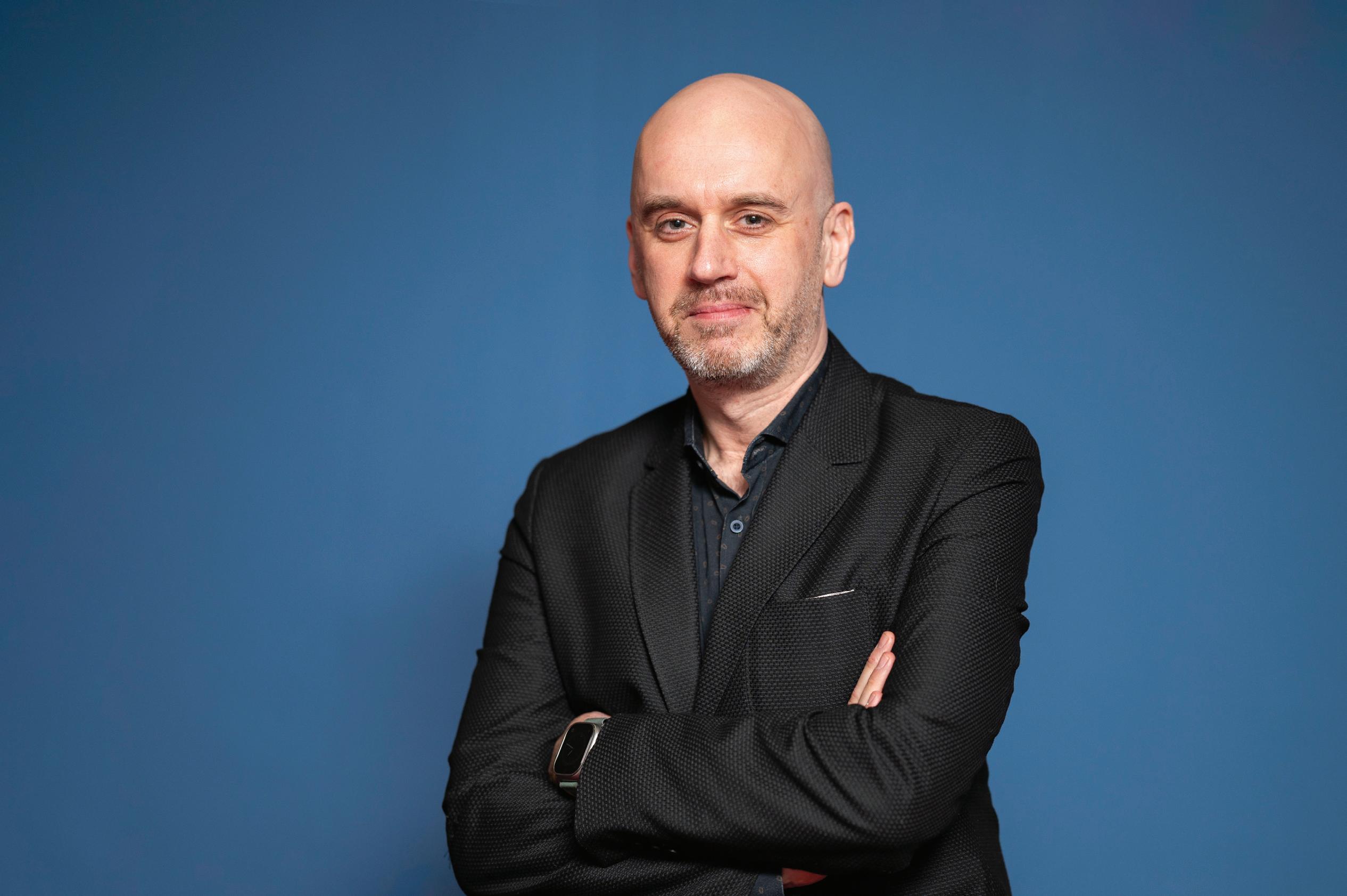
Strengthening Ireland’s cyber resilience
Brendan Ring, Digital Engagement Lead in the National Cyber Security Centre, outlines the challenges of strengthening Ireland’s cyber resilience.
In meeting the challenge of strengthening Ireland’s cyber resilience, Ring cites three key challenges:
1. the changing cyber threat landscape;
2. implementing the NIS2 Directive; and
3. meeting the findings of the National Cyber Risk Assessment.
Cyber threat landscape
Ring states that the cyber threat landscape has “changed significantly in a few short years”.
“We have had Covid, the HSE cyberattack, Russia’s invasion of Ukraine and subsequent supply chain attacks highlighting new and unpredictable threats.”
With the coming of the NIS2 Directive, the specific role and remit of the National Cyber
Security Centre (NCSC) will be altered. The NCSC was formally created by government in 2015, with a mandate which includes:
• reducing the vulnerability of critical systems and networks within the State to incidents and cyber-attacks;
• effectively responding when such attacks occur;
• responsibility for the protection of critical information infrastructure; and
• establishing and maintaining cooperative relationships with national and international partners.
Ring describes the role as “leading Ireland’s response to cyber risks”. “We are defending today, responding to incidents, taking down actors, and building networks. We build these networks nationally, globally, and regionally,” he explains.
112 digital government report
Fresh Thinking
Fresh Thinking
NIS2 Directive
The “comprehensive” NIS2 Directive – which replaces the 2018 NIS Directive – will create national competent authorities for various sectors — such as telecoms and energy — which the NCSC will provide guidance to and oversight, while keeping a direct brief over the Government and key entities.
NIS2 provides that: “Member states shall ensure that the management bodies of essential and important entities approve the cybersecurity risk-management measures taken by those entities… oversee its implementation and can be held liable for infringements by the entities of that Article.”
With Ring citing the cost of implementation as “very significant”, he asserts that meeting the Directive’s obligations will be a challenge as it applies to all businesses classified as medium or above in scope, In other words, those with over 50 employees or a turnover of €10 million.”
National Cyber Risk Assessment 2022
The National Cyber Risk Assessment 2022 report, concluded in May 2022, examined the systemic cyber risks faced by the State’s critical services from a range of threats. It examined espionage, destructive cyberattacks from nation states, and criminal actors.
In terms of the main lessons being drawn from the National Cyber Risk Assessment, Ring lists off the introduction of a suite of legal measures such as the Network and Information Systems (NIS) Directive and its upcoming replacement NIS2, the Cyber Security Act for certifying products and services, and the upcoming Cyber Resilience Act which seeks to embed security into products.
All of these initiatives, he asserts, will “place an emphasis on organisations to ensure services and products are created and delivered with embedded security from the outset”.
The Digital Engagement Lead further outlines that, as a result of the findings of the assessment, “risk profiles of individual suppliers can be assessed on the basis of several factors, notably, the likelihood of the supplier being subject to interference from a non-EU country”.
Such interference may be facilitated by, but not limited to, the presence of the following factors:
• a strong link between the supplier and a government of a given third country, the third country’s legislation, especially where there are no legislative or democratic checks and balances in place, or in the
absence of security or data protection agreements between the EU and the given third country;
• the characteristics of the supplier’s corporate ownership, the ability for the third country to exercise any form of pressure, including in relation to the place of manufacturing of the equipment;
• the supplier’s ability to assure supply; and
• the overall quality of products and cybersecurity practices of the supplier, including the degree of control over its own supply chain and whether adequate prioritisation is given to security practices.
More broadly, Ring states that a trend in recent years is a “blurring of the lines between the three categories of threat actors”. Threat actors can be categorised as: cybercriminals, nation states, and hacktivists.
On this blurring of lines, Ring explains: “The Russian invasion of Ukraine has accelerated this trend; you have the coopting of cybercrime groups with state-sponsored actors featuring strongly, along with hacktivists.
“The rise in the use of indiscriminate ransomware in recent years by cybercriminals is motivated by financial gain and continues to leave a trail of destruction and devastation and has elevated the threat from this group to nation state actors across all our target types from operators of critical national infrastructure, to large and small businesses, to individual citizens.”
He continues: “State-backed actors are expected to continue to pursue their strategic objectives via cyber operations for intelligence gathering for advantages in decision-making, stealing intellectual property, and prepositioning of military and critical infrastructure [preparation of the operational environment] for future conflicts.”
Ring suggests that it is “very likely” that hacktivism will continue to encompass a variety of political ideals, particularly in countries experiencing civil unrest or war.
“Some of these groups will remain active for a longer period of time,” he states, “where others will dissolve, and their members will continue operations under the umbrella of other groups”.
Concluding, Ring states that while there is an increased understanding of the cyber risk landscape, boosting resilience by raising the cybersecurity ‘bar’ across all elements of the technology ecosystem remains the most effective means of reducing risk to critical services.
digital government report
113
Securing the next wave of digital transformation in the public sector

It is crucial that public sector organisations are seeking to leverage technological transformation to enable ongoing transformation of service delivery, writes Gary Comiskey, EY Ireland Government and Health Partner.
Across both public and private sector, today’s modern technology leaders are focused on ensuring that the technology upon which their core business functions operate seamlessly, that their systems are protected from ever more complex cyber threats, and that the correct digital infrastructure is in place so that their organisation can quickly seize new growth and service delivery opportunities. Each year EY Ireland engages with 150 senior tech leaders across the public and private sector, to understand what is front of mind for them right now and what the challenges and opportunities are as they look to the future. This year’s Tech Leaders Outlook Survey uncovered three key trends –cybersecurity, cloud adoption and the potential of artificial intelligence and generative AI (GenAI):
1. Cybersecurity is front and centre
Across all sectors, cybersecurity risks have emerged as the top issue for tech leaders in 2024, with almost four-in-10 (38 per cent) rating this as their most significant challenge.
Turning to the specific elements of cybersecurity, elevated cyber risks and management of data protection and flows were identified by 61 per cent of respondents as a critical challenge. A quarter of respondents pointed to their organisation’s vulnerability to cyberattacks as an area of concern.
Cybersecurity attacks can have a significant and detrimental impact on business operations and public services, as for example, when the HSE suffered the most significant cyberattack on an Irish state agency in May 2021. Lessons continue to be learned from this and in
this context the significantly increasing investment in the National Cyber Security Centre is very welcome. The survey also highlighted that technology leaders are renewing their focus on cybersecurity with hackers and other bad actors now adding generative AI (GenAI) and other advanced tools to their malign arsenal.
2. Confidence in cloud adoption soars
While traditionally the public sector has been cautious in the use of cloud technology, this hesitation is subsiding and, confidence in cloud technology has surged across all sectors, with more than 80 per cent of organisations (public and private) covered in the survey either on the cloud or in the process of migrating to it. These results indicate increased trust and confidence in cloud technology. This rise in cloud adoption underscores the recognition of its benefits, such as scalability, flexibility and cost-effectiveness.
3. Discovering the hidden potential of AI and GenAI.
The public sector is continuing to explore opportunities to improve efficiency and deliver greater value for money and ultimately better service delivery for citizens. The adoption of AI is increasingly viewed by organisations as a key enabler to drive innovation. AI has the potential to change how government works, increasing operational efficiency, automating routine tasks and enhancing citizen service.
Our research finds that organisations are very interested in AI. However, this strong interest is not yet turning to action for the majority of organisations, with more than six in 10 (62 per cent) saying they are not yet investing in AI technologies and do not have an AIrelated strategy in place. To further encourage AI within organisations it is imperative that robust AI policies are developed. Integrating governance with innovative AI applications can also help organisations unlock new opportunities.
114 digital government report Advertorial
Gary Comiskey, Government and Health Partner at EY Ireland.
The most significant challenges facing Irish tech leaders today

Technological transformations
To capitalise on these opportunities, public sector organisations are undertaking a range of technological transformations. Some of the key transformation initiatives where EY has supported government include:
• Modernising and integrating disparate IT systems to foster collaborative and interconnected ways of working – Many government departments and state bodies face challenges with siloed and legacy systems. There is a growing need to adopt a ‘Whole-ofGovernment’ approach to offer joined-up and seamless services. EY are supporting the public sector to develop digital strategies and common standards to integrate siloed data and create common governance frameworks. Once a strategy is developed the next step is to enable interoperability of different systems through a flexible architecture and standards to enable data exchange.
• Embracing data-centricity to better understand and serve changing needs of citizens – Across governments, data-driven insights are increasingly a central part of decision making. All departments –from HR to operations, service delivery to the finance function –are data-hungry and want to be served data that monitors performance and how they can improve. EY is supporting departments and agencies to integrate data into operations to drive better citizen outcomes, offer more tailored services and adopt a human-centric approach for service delivery.
• Investing in digital skills and transforming organisational culture to create a future-fit workforce –Investment is required to adopt dynamic workforce planning through a long-term view of capacity and capability needs which EY has been supporting right across government. There is also a need to scale digital capabilities through partnerships with external experts, to rethink conventional recruitment, onboarding and training methods to foster digital leadership and culture.
There has been a dramatic acceleration in digital service delivery and citizen interactions across many areas of government, in particular since the pandemic. Most citizens see greater use of digital technologies as a key way for government to improve:
• Convenience – more easily accessible services, organised around key life events;
• Personalisation – services that are tailored to meet citizens’ individual needs;
• Equality of access – support for the digitally-excluded and more equal provision of services;
• Transparency – showing citizens how Government is performing and tax money is spent; and
• Responsiveness – a means of providing feedback on public services, policymaking and service delivery.
Successful government departments and agencies will be those that focus on embedding new practices and finding new ways to serve the needs of 21stcentury citizens. Technology and transformation can play a crucial part in this and the time to embrace this is now.
Gary Comiskey, EY Ireland Government and Health Partner
Gary Comiskey is a partner in EY Ireland, working with the advisory team to deliver services to government and health sector clients. He leads a wide range of complex projects enabling public sector and health care transformation initiatives across central government and other public sector bodies.
For more key insights about EY Ireland Tech Leaders Outlook Survey 2024, visit: W: ey.com/ie/TechSurvey


Increased cybersecurity risks Difficulty in attracting, hiring and retaining the right talent
data protection
flows Limited budget Finding the right third parties to support our needs
regulatory changes
Managing
and data
Coping with
Technical debt Other 2% 3% 10% 10% 12% 13% 23% 37% 38%
Inability to adopt new emerging technologies such as Gen AI
Source: EY Ireland Tech Leaders Outlook 2024
digital government report 115 Advertorial

Ireland’s digital decade progress in numbers

















In Ireland, the share of ICT specialists in total employment is 6.2%
• above the EU average of 4.6%
The proportion of graduates who study ICT programmes is 8%





• almost double the EU average of 4.2%
• female ICT specialists, while above the EU average, is less than 20% of all ICT specialists
Digital infrastructure



Fixed very highcapacity network (VHCN) coverage in Ireland grown from 67% in 2020 to 84% in 2022











Digital skills
70% of adults in Ireland have at least basic digital skills
• well above the EU average (54%)
• not far from the EU 2030 target (at least 80%)
€200 million worth of funding committed in the National Development Plan
• EU 2030 target of 100% 5G coverage 84% above the EU average of 81%
• making progress towards achieving the EU 2030 target of 100% coverage
At 56%, Ireland performs better than the EU average concerning 5G coverage on the 3.4-3.8 GHz spectrum band
1 direct participant active in manufacturing Microelectronics and Communication Technologies
Ireland has over 100 semiconductor companies exporting €13.5 billion worth of products annually
116 digital government report
Fresh Thinking
Fresh Thinking
Digitalisation of business
85% of SMEs demonstrate at least a basic level of digital intensity
• significantly higher than the EU average of 69%
• very close to the 2030 EU target of more than 90%
The uptake of digital technologies by enterprises in Ireland:
• big data 23% in 2020
• cloud 47% in 2021
• AI 8% in 2021
Digitalisation of public services
Public services provided to business scored at 100
Public services provided to general public in Ireland scored at 81
Over 1.88 million verified accounts of digital identity service to access digital public services
• 49% of the adult population
Source: 2023 Report on the state of the Digital Decade
digital government report 117


Irish Prison Service: Embedding continuous quality improvement
The Irish Prison Service has identified a business need within its strategic priorities to modernise its services through digital development and transformation.
The new Strategy Statement 2023-2027 provides a roadmap for embedding continuous quality improvement across all areas of the Irish Prison Service. In addition to its vision, mission, and values, the strategy outlines five strategic pillars and a number of objectives. The pillars are:
• prisoner pathways;
• employee experience;
• new business processes;
• digital platforms; and
• governance.
The digital platforms pillar supports the objective that will modernise the Prison Service’s services through digital development that enable more transparent and tailored services, support innovation and improve efficiency and effectiveness in a cohesive and holistic manner.
Aims associated within the pillar include:
1. Employee Digital Tools:
• improve staff experience through reducing non value add manual tasks and enhancing system productivity;
• implement a service wide targeted organisation dashboard as an internal performance enhancement tool;
• provide more autonomy to staff on self-detailing, rosters, schedules, and leave; and
• enable online learning and development for staff.
2. Digitalise Prisoner Services:
• design and implement a digital prison services operating model that enhances the prisoner journey, that balances the digital agenda and the need for human interaction and that improves productivity across the estate; and
• fully leverage digital innovation for the benefit of prisoners and staff while understanding and mitigating for digital abilities.
Digital transformation as a universal phenomenon has created a new reality in prisons. The use of technology in custodial settings transforms rehabilitation and services, promotes digital literacy, digital citizenship, social skills, self-esteem, and re-integration into society. Current rehabilitation practices and policies in our prisons are mostly offline and do not cater for the digital realms.
The use of digital to support rehabilitation will facilitate transition back into society and ensure an improved post-prison quality of life in a technologically advanced society. The technology-dependent world that people exiting custody must now re-enter requires the use of touch screens, computers, and the internet, but many have not received training in how to operate these types of internet-enabled processes.
In recent years, the Prison Service has pivoted its focus to how it can use technology to create and deliver modern services in its prisons. Four broad areas where technology supports a modern service include:
• digital service delivery for people in care;
• digital service delivery for staff and partners;
• electronic security of prisons; and
• digital prison building management.
118 digital government report Advertorial
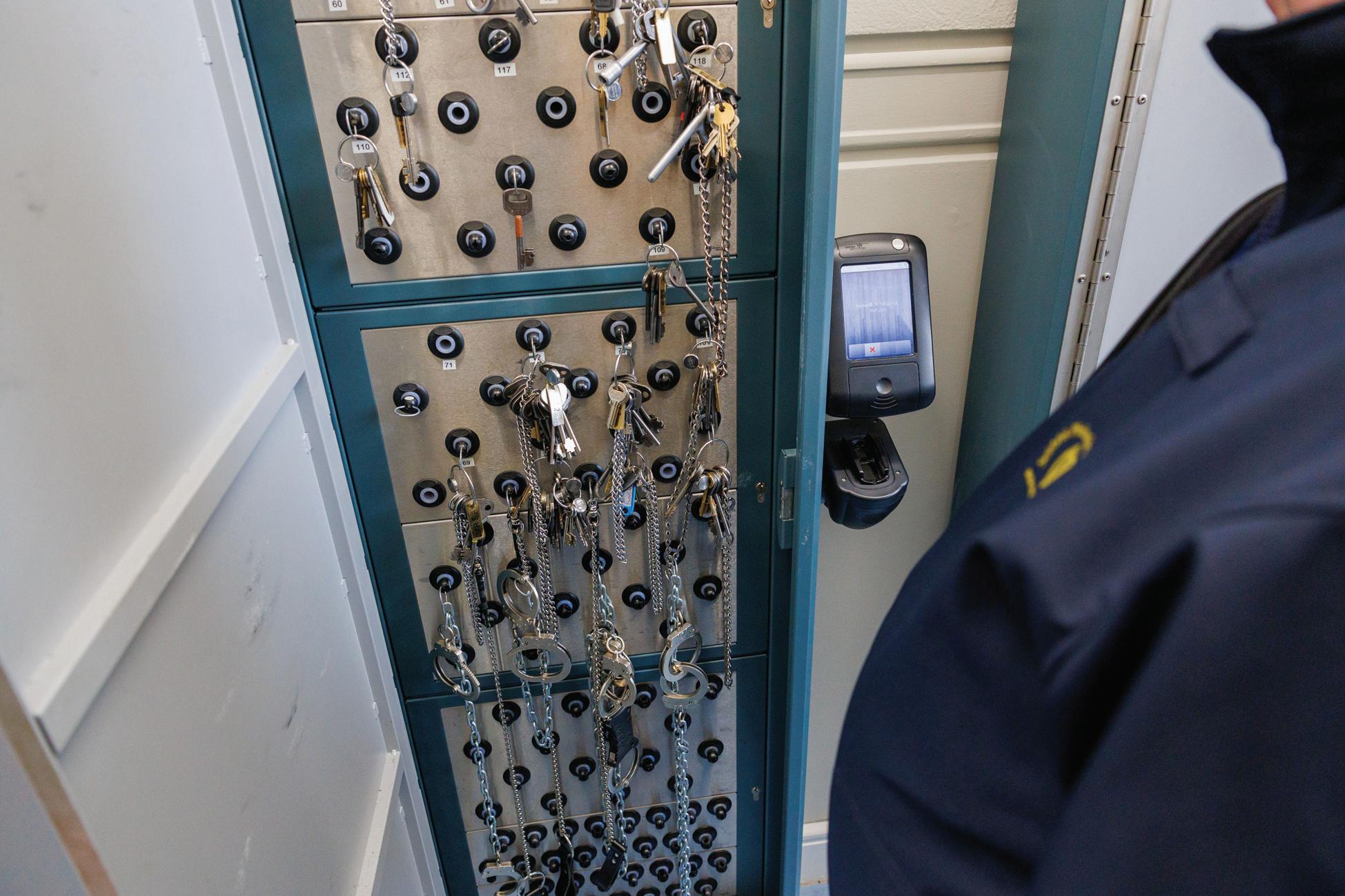
Delivery and access to services for people in custody encompasses health and wellbeing, education, language, culture and identity, prison operations, such as biometric movement; selfserviced kiosks; and visits.
Digital service delivery for staff and partners includes the enablement of digital ways of working for staff and other people onsite in Ireland’s prisons to help them do their jobs more safely and accurately, for processes such as viewing essential prisoner information, prisoner sentence management, building maintenance, and inventory management.
Managing the long-term maintenance and sustainability of a prison, including optimising physical workflow can be supported through the use of digital tools such as monitoring environmental conditions through sensors and enable control and automation of operational processes and optimisation of electricity usage within cells and other spaces.
The benefits under this agenda will support an improved safety environment in the prison through increasing time available for staff to have meaningful engagements with people in their care; enable real-time access to information, reducing time spent completing paperbased tasks. Using digital to support rehabilitation will prepare people in the Prison Service’s care to adapt to a digitally enabled environment and prepare them for using online learning tools and increase connectedness with the outside world and preparation for life outside in an easy to use and accessible format.
The Prison Service’s approach to implementing digitally supported service delivery is about using technology to make services available to people where and when they will make the most impact on that person’s life or work. For people in care, this should mean making the most of services known to have a humanising and rehabilitative impact, and ensuring they are available and accessible. For staff and partners, greater use of technology in day-to-day activities will help improve safety and contribute to the Prison Service’s wider drive to modernise its ways of working.
The Irish Prison Service is currently drafting a technology and change delivery plan for the short, medium, and long term objectives of the Strategy Statement, specifically to include:
• technology, change, and digital transformation development from a holistic perspective;
• digital maturity dimensions;
• IT management and governance strategies;
• innovation and project design supports; and
• project management.
The Prison Service has acknowledged the important role ICT solutions play in the delivery of its mission. Moreover, the increased importance digital technologies play in today’s society and the speed on how those technologies shape the modern society in which prisons operate provoke an urgent need to act more proactive, anticipate the change, and approach digital from a holistic perspective.
Change through digital is often referred to as digital transformation, a process that encompasses an ambition to do better and explore how new technologies can support the organisation in doing so. Organisations that embrace transformation want to do more with digitalisation than just build a better version of their current selves. Therefore, the aimed transformation should be seen as a process that includes an openness to rethink the existing, explore digital possibilities and analyse the impact a digital society has on the organisation and its mission.
Prison services are unique settings which makes this confrontation with a changing society quite challenging: it requires a thorough and balanced investigation into what options exist to use technology meaningfully, purposefully, and safely to support the entire organisation: the people who work in it, the many different stakeholders and the detainees who need support during their journey to return successfully to a digital society.
W: www.irishprisons.ie
X: @IrishPrisons
LinkedIn: www.linkedin.com/company/irishprison-service
Facebook: www.facebook.com/irishprisonservice
Instagram: www.instagram.com/irishprisons

digital government report 119 Advertorial
Fresh Thinking

Transforming public services: A UK perspective
Dan Brember, Deputy Director of GOV.UK Content for the UK Government’s Government Digital Service (GDS), tells eolas about how the UK Government is aiming to reclaim its former status as a pioneer in the delivery of digital services for citizens.
With GOV.UK now over 11 years old and Government Digital Service (GDS) over a decade old, the world at large in a state of flux following the seismic reverberations of events such as Brexit and Covid-19, and the constant progress of both technology and society, Brember says that GDS are taking the opportunity to reflect.
“One of the things that we are asking ourselves at the moment is what are the big things we have perhaps taken for granted or assumed have remained true that we need to revisit and consider whether or not there are opportunities for us to change,” he says.
“One of the big touching points for us has been our relationship with other peers around the world, looking at what they are doing well. Many of them are solving similar challenges to us in their
contexts and we, for a long time, considered ourselves to be among the world leaders and that is probably no longer true, so there is something that we can learn there.”
Considering the recent social, political, technological, economic, and legal developments, Brember says that GDS asks the question: “What should the next generation of government digital services look like?” A redesign of the interface is thus central to GDS’ efforts to improve the citizen digital experience.
“For many people, the main user interface is GOV.UK. The 2012 Digital Efficiency Report said that digital services are very often better for the users and cheaper for the taxpayer. However, internet years are sort of like dog years and 10 years on the internet is probably more like 30 years in any
other sphere. We need to look again at what the central paradigm is for digital services in the UK.”
Central to the improvement of this paradigm are already existing GDS applications within the GOV.UK umbrella, such as GOV.UK Pay, which allows users to make a payment through a separate platform that does not appear to be separate at the point of use. Similar products such as GOV.UK Notify keep users updated on the status of applications.
“GOV.UK remains a wonderful service despite the fact that we are a decade old, and it is something that we need to protect and develop,” Brember says. “Every time we meet peers from other nations, they are envious of the fact that we have managed to consolidate a
120 digital government report
Fresh Thinking

single user experience for the many government services and websites that could potentially exist. There are still thousands of services where a user has to download a PDF and post it. Imagine that you are extremely low income, with no laptop or printer, and you are faced with forms with over 100 questions.
“Services that require you to post in documents that we already have somewhere else are extremely frustrating. People who fill in these forms and send them in at their own expense have got to wait weeks or months for a decision, which is very poor. That being said, digital services across government are mostly good. So, why do we need to reconsider and challenge that paradigm?”
The economic context that these changes are happening within is “obviously changing”, Brember says, with the victor of the next UK general election inheriting “a very challenging economic reality to deal with”, which will mean “continued pressure for more efficiency” in how the civil service delivers services. Against these pressures, the “promise of transformational efficiencies through digital services has not been fully realised”, Brember says.
“The civil service has continued to grow and the cost of running services is still far too high. This is partly because of Brexit, partly because of Covid-19, and the gradual increase in the UK population. It is also partly because we have made the front-end services better while not fundamentally fixing the back end. It takes too long, is too hard, and takes too much energy to do simple things.”
Pointing to broader trends of dissatisfaction and disillusionment with
“A great digital experience is often mobile app-based, highly personalised, ruthlessly simple for the user – which in practice means fewer than 10 clicks to do whatever it is you need to do.”
Dan Brember, Deputy Director of GOV.UK Content
politics and the very concept of democracy, Brember states that there is also a growing satisfaction gap with regard to GOV.UK. This gap does not surprise him: “The in-browser/onplatform experience of the web is a declining medium. Younger audiences are used to apps, personalised experiences, and short-form videos. A large website with forms is fundamentally not a good user experience.
“This trend is not surprising: in 2016, most visits to GOV.UK were on a desktop computer; but by 2021, 65 per cent of visits were on a mobile phone, and for major services such as Universal Credit today, that number is as high as 90 per cent.
“A great digital experience is often mobile app-based, highly personalised, ruthlessly simple for the user – which in practice means fewer than 10 clicks to do whatever it is you need to do – and finally, integration with user data, particularly the data the organisation already holds about the user.”
Falling behind in this regard has led to the UK falling from first in the UN’s
eGovernment Index to 11th, and Brember says that GDS’ “big bet” is a pivot towards a single GOV.UK app. “In GDS, we talk a lot about user needs, asking what the specific problem is that we have to solve. We have had to pivot slightly, and we are now thinking around user utilities: what are the common things that people need to do with government that we can provide through an app?” Such common things would include identification, passport and driving license renewals, MOT, booking for appointments as is already seen on the NHS app, and notifications to remind citizens of pressing matters such as upcoming appointments or Universal Credit [UK social security] balance.
“There is nothing more personal, intrinsic, commonly used by people than their native smartphone, so why can we not release the benefits of that to support people to do things more quickly?” Brember asks, before concluding: “These are the things that we have already got the power to do, we just need to bring things together to make it happen.”
digital government report
121

LocalGov Drupal and why it is so popular with councils

few years.
The rise in popularity of the LocalGov Drupal CMS among local authorities has shaken up the public sector digital sphere. Its numerous benefits are underpinned by the philosophy of Build to Share, which is key to the Government’s digital strategy, writes Stella Power, Managing Director, Annertech.
The innovation, security, flexibility, and economy of the Drupal CMS has ensured its rapid take-up among the public sector over the past few years.
In fact, Drupal was recently named the most popular content management system (CMS) among councils in Ireland and the UK. This is according to the
latest updates to the LocalGov CMS Directory, which lists the content management systems that councils currently use.
One of the driving forces for this increase in popularity is the take-up of LocalGov Drupal. Known as ‘the CMS for councils by councils’, LocalGov
Drupal is built on Drupal but has been customised to serve councils and their users. It is a tried and tested CMS that is based on user research and councils’ needs.
LocalGov Drupal in Ireland
Although LocalGov Drupal started in the UK, it has had a sustained uptake in Ireland, starting with Tipperary County Council.
Carlow County Council, Laois County Council, and Galway City Council have also joined the LocalGov Drupal family. Carlow.ie was the most recent Irish LocalGov Drupal website to go live in January 2024, combining a gorgeous design with custom development to ensure that the new website would be customer-centric and service-orientated.
The LocalGov Drupal project aligns with the Irish Government’s Build to Share initiative, which forms part of the Government’s Better Public Services, the Public Service Transformation 2030 Strategy
Its goal is for the public sector to share code in order to save valuable resources like time and money. And they are – Carlow.ie was designed and built in just 11 months. This included some custom-built features, which allow the council a flexible way to showcase vacancies, present minutes of council meetings and display the county’s leaders.
LocalGov Drupal can reduce the cost of building a new council website by up to 80 per cent. Some councils use the budget savings that they achieve by using this open source CMS to add new features to it.
Carlow funded the addition of the Irish Planning Notices extension to the LocalGov Drupal offering, which will be of interest to any Irish councils contemplating moving over their websites.
122 digital government report Advertorial
The LocalGov Drupal CMS has risen in popularity over the past
This gives councils an easy way to add and manage these notices, and for users to be able to filter the notices by year and week number. It also allows these notices to be posted in Gaeilge, boosting the crucial multilingual functionality of LocalGov Drupal sites.
Other features
Other hallmarks of the LocalGov Drupal project are:
• content and functionality is designed to meet or exceed WCAG 2.1 level AA so it is accessible out of the box;
• because it is an open source CMS there are no licence fees or vendor lock-in;
• its content formats and patterns are based on Government Digital Service standards and user research, and have been tried and tested by the public sector;
• the platform is updated regularly with the latest security updates and features. So not only is it secure, but it uses the latest technology;
• the platform also supports full Irish translations of councils’ services and the website’s content – this was funded by Tipperary County Council;
• LocalGov Drupal has an extension, also funded by Tipperary County Council, that imports the services that a council offers from the Irish Service Catalogue. It gives councils a good launching point for their content, because it lists and imports all the services (and their translations), creates a page for each of them and structures the content throughout the site;
• the HTML Publications extension gives councils the opportunity to finally ditch PDFs and other large document files. PDFs are popular among councils, but they are clunky to use and pose accessibility difficulties for users. Instead, documents can now be presented as web pages. It will make things so much easier for users, especially those on mobile phones or using assistive devices; and
• the standalone Microsites Platform
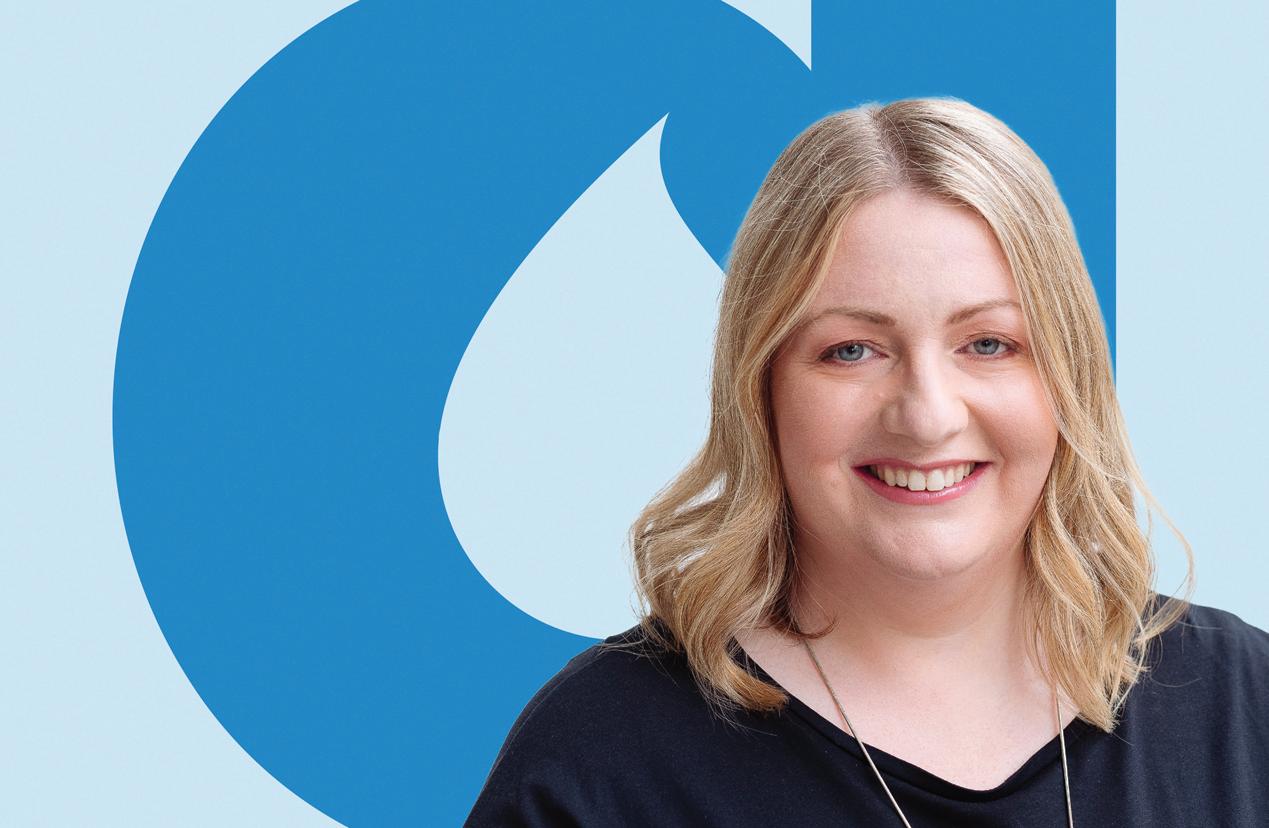
offers users a way of managing an entire fleet of microsites from one place. It is not just for councils – it can be used by any organisation that runs more than one website or microsite.
Conclusion
The LocalGov Drupal philosophy of ‘build to share’ resonates with public sector organisations, who save time and money by pooling their resources.
Currently, there are 45 live council
About Annertech
websites built on LocalGov Drupal, and more are in development. As this CMS continues to thrive and grow, so too does the depth of its offering. New features, based on the real-world needs of councils, are being created all the time.
T: 01 524 0312
E: hello@annertech.com
W: www.annertech.com/localgovdrupal
Annertech is Ireland’s leading open-source digital agency and has become the go to expert for Drupal and LocalGov Drupal. Founded in 2008, Annertech works with many clients in both the private and public sectors.
In 2021 Annertech UK opened to service a growing number of clients and staff members in the UK. Annertech’s mission is to help companies to embrace open-source technology to deliver ambitious digital experiences for their customers.
Their work has won all of Ireland’s most prestigious digital awards, including multiple Spider Awards (including the coveted Grand Prix award), National Digital Awards and Digital Media Awards.
Stella Power is Managing Director of digital agency Annertech.
digital government report 123 Advertorial
Fresh Thinking

Exploratory innovation within the public sector
Strategic Partnerships Lead of GovTech Lab
Lithuania, Kamilla Gasinska, highlights how innovative companies and the public sector can work together to build GovTech solutions.
With the pace of new technologies increasing, thus causing increased citizen expectations on the public sector, Gasinska explains how GovTech Lab Lithuania has successfully ran over 97 projects to adapt and modernise the public sector through exploratory innovation.
Contextualising the need for modernisation within the public sector, Gasinska believes that collaboration with innovative companies is key to the public sector delivering during challenging times and crises. Pointing to crises such as the Covid-19 pandemic and the ongoing conflict in Ukraine, she states that consistent development and modernisation are key to create innovative solutions during unprecedented global challenges.
GovTech Lab Lithuania, established in 2019, is a part of Lithuania’s Innovation Agency under the Ministry for Economy and Innovation. Through its successful experience in creating innovative GovTech solutions, the organisation has produced a process called the GovTech Challenge Series; a “structured innovation process that facilitates cooperation between the public sector and startups/innovative companies to build digital solutions that solve government’s challenges”.
GovTech Challenge Series
Gasinska outlines how the process is successfully implemented in Lithuania to produce exploratory innovation. “At the
124 digital government report
Fresh Thinking
very beginning, we have an open call to look into the current challenges within the public sector. It could be within a ministry or an agency, or it can be in a library, school, or hospital. At the start of this process, we are gathering all of those problems and selecting the most pressing ones.”
The second stage, aims to address the specific problem within the public sector and transform it into an innovative challenge that will “spark the creativity, innovation, and interest of the start-up community”. At this second stage, Gasinska states GovTech Lab Lithuania is also helping to prepare the public sector for innovative procurement.
Stage three, focuses on procurement within the process. Gasinska outlines that during this stage, a design contest is used to produce further creativity within the innovative companies.
Gasinska states: “At this stage, you rate the idea and not the team,” and explains further, “if the idea is great, you can pitch prices for the best ideas and encourage the small teams. Then, you are collaborating with an innovative pilot with the best team and the best idea that you have selected.”
The next stage is called “pilot development”, where considerations are made for the public sector team and the start-up team through team-building exercises. This process typically entails three-to-six months of cooperating on the creation of the pilot solution.
“The public sector is learning about how start-ups work, and at the same time, the private sector is learning how the public sector works.
“From the very beginning, we have been helping the public sector with expertise, with templates for procurement, and with workshops. GovTech Lab Lithuania host workshops with the private sector on how to take part in the procurement. We try to help and guide them through this process,” she says.
Through this process, Gasinska highlights that the private sector in return is further educated on “how the public sector works, why the processes are so long, what the actual bureaucracy means, and why it is there”.
Furthermore, the process encourages the companies to apply for other public
procurements because they can “understand the mindset of the public sector,” according to Gasinska. Due to this, the public sector is more flexible after running this process.
Successful collaborations
To explicate the success of this strategy, Gasinska illustrates challenges that were solved when involving the GovTech Lab Lithuania through collaboration with Lithuania’s public sector and start-up companies, including a project which aimed to make the internet safer for children by automatically detecting illegal content, a collaboration that integrated forest cover monitoring using advanced algorithms, and a solution to automate data collection from market participants necessary for supervision.
“One thing that we are focusing on is pilot solutions. The public sector is normally willing to go for the big budget into full-scale solutions. Here, we are asking them to stop for half a year to see if the solution they are looking for is the solution that is needed.”
Gasinska outlines that the complete process takes around nine months before the organisation is selected. Furthermore, the projects are run in batches rather than case-by-case.
“Projects are coming together from diverse backgrounds and different cities. In this way, they can learn from each other because some have faced similar problems previously. Due to this, both parties can share their experience along the way.”
Progressing digital government
Gasinska outlines that GovTech Lab Lithuania provide funding for experimentation, professional support and operate on common values to ensure that everyone is “on the same page”.
Through the utilisation and collaboration of start-up companies to further modernise and transform the public sector, Gasinska concludes exploratory innovation within GovTech solutions is crucial to produce a progressive digital government in short- and long-term timescales.
digital government report
125
EU Cyber Regulations may overwhelm Ireland’s regulators and service providers
Ireland’s digital services companies are at risk of being illprepared for the approaching tsunami of EU regulations.

These regulations include the Digital Services Act (DSA) and the Digital Services Markets (DSM) which apply to platforms and search engines, (initially those with more than 45 million customers each); the Digital Operations Resilience Act for the fintech sector; and eIDAs which are relevant for e-certificate providers – NIS2 and the Critical Entities Directive (CER) – which apply largely to critical infrastructure providers of essential services, which citizens rely on.
It has been estimated that the scope of NIS2 could encompass between 2,500 and 3,000 entities in Ireland. This scale has the potential to overwhelm
regulators in Ireland, and the companies in the sectors soon to be regulated for the first time. With less than five months until the mandatory implementation date of October 2024, preparations for NIS2 will be intensive, expensive and resource heavy.
The cybersecurity measures included in the Directive are designed to help organisations to protect their data, systems and processes. Compliance will not merely prevent sanctions, but also guide organisations towards achieving a cybersecurity maturity that will shield them from cyberattacks, which could have devastating effects on the company and on its customers. The
objectives are laudable and essential, given the scale and impact of cyberattacks, especially ransomware.
Some of the main provisions of NIS2 include the need for cybersecurity risk management measures which are required for essential and important entities to prevent or minimise the impact of cyber incidents. There will also be increased corporate responsibilities for top management in relation to cybersecurity, as well as a harsher penalty regime. Furthermore, stringent reporting requirements will be imposed for notification of incidents.
126 digital government report Advertorial
Practical steps to strengthen your cybersecurity position
Organisations should begin by performing an inventory or audit of their entire architecture and systems landscape, to establish a foundation for its risk management processes. This includes implementing a risk management framework that ensures continuous assessment, evaluation, and treatment of threats against its data. Additionally, crisis management planning should be initiated to limit the impact and duration of any crisis that may arise.
To further enhance resilience, it is crucial to establish business continuity and disaster recovery procedures, ensuring critical processes can continue operating at an acceptable level during disruptions. Top management must be actively engaged in the cybersecurity strategy of the organisation to prioritise security initiatives. Supply chain risks should be addressed by involving suppliers and service providers in risk assessments.
Finally, a structured incident management process should be defined to document and classify cybersecurity incidents, ensuring a swift response. These integrated measures collectively strengthen the organisation’s cybersecurity readiness to address emerging threats and challenges.
.ie and NIS2
As the trusted national domain registry for over 330,000 domain names, .ie is already designated by the Government as an operator of essential services (OES) under NIS1, the predecessor directive to the imminent NIS2. Its ISO certification ensures that .ie is already compliant with the cybersecurity requirements of the new Directive. In addition, the company has longestablished DNS abuse protocols with many national regulators to assist them in tackling issues with .ie domains that are alleged to engage in technical abuse or criminal activity.
The scope of NIS2 will apply to all toplevel domains for the first time –including .com .net. and .org and to all of the country code top level domains (ccTLDs) across Europe. Accordingly, Ireland’s registrars and resellers which operate cross-border, will need to
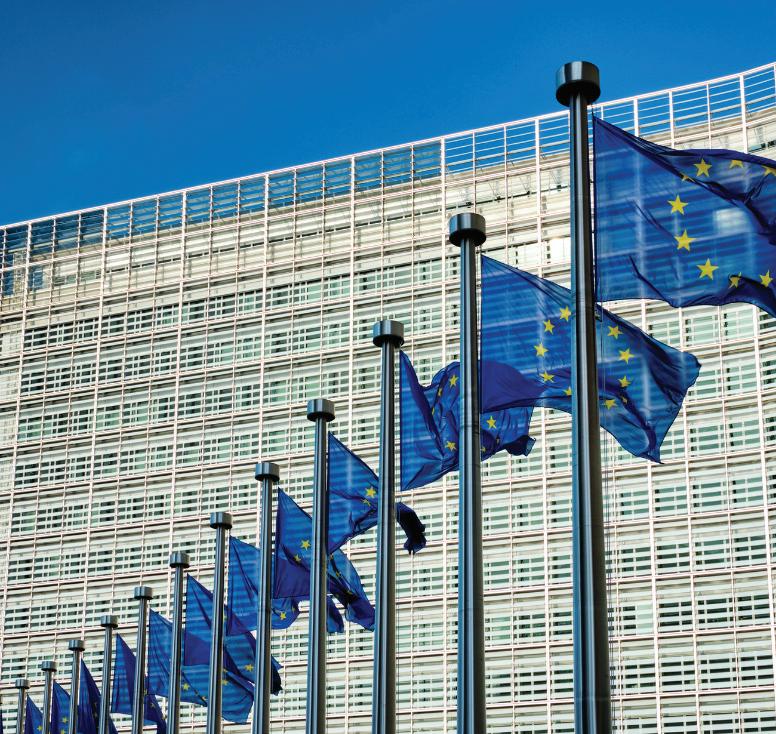
comply with NIS2 legislation applicable in all of those countries. For example, they will need to have a dedicated database of complete and accurate information of any registrant who signs up for a domain name. This also means that registries and registrars will need to have verification processes.
To date, there has been speculation that the National Cyber Security Centre will delegate regulatory authority to regulators in situ, essentially a “federated approach” to regulation, thereby placing much of the regulatory burden on existing regulators, such as ComReg. However, this has not been confirmed by the Government, and it is important and urgent that the intended regulator is identified and commences its work without undue delay.
Conclusion
At .ie we are committed to demonstrating leadership for our sector and providing good governance. This includes meeting all regulatory requirements, including NIS2. It is not an easy task for the channel, but .ie has a multi-stakeholder Policy Advisory Committee that ensures its technical and registration policies and procedures are consensus-driven and will help .ie navigate rough regulatory waters ahead.
On this matter, .ie will leverage its established relationships with government departments to advocate for its stakeholders with national policymakers. Through its international partnerships, the company will continue to liaise and coordinate with crossborder partners and Council for European National Top Level Domain Registries (CENTR) officials to advocate that the concerns of registrars, resellers and internet users are reflected in Europe’s implementing acts and in the national legislation.
W: weare.ie

digital government report 127 Advertorial
Fresh Thinking

Government aiming for 5G in ‘all populated areas’ by 2030
The Government has published its roadmap for a digital decade in line with requirements under the EU Digital Decade strategy, including digital skills targets for the labour force and for all populated areas to be covered by 5G no later than 2030.
128 digital government report

Fresh Thinking
The first Report on the State of the Digital Decade was published by the European Commission on 27 September 2023. The report, which includes EU wide and member state-specific recommendations, takes stock of progress towards a successful digital transformation.
The National Strategic Roadmap for the EU Digital Decade Policy Programme, published in May 2024, sets out targets on skills, digital infrastructure, digital transformation of business, and digitalisation of public services.
Regarding skills, the Government aims to produce a “digitally skilled population” where at least 80 per cent of people aged between 16 and 74 have at least “basic digital skills”, with a further aim of achieving gender balance. Government is also aiming to increase the number of graduates with digital skills to over 12,400.
Within digital infrastructure, the Government states that all Irish households and businesses must be covered with gigabit network no later than 2028. On data, the Government states that there will be 23 public sector edge notes by 2025, and that Ireland will play its part in the EU having its first computer with quantum acceleration by 2025, ensuring that the EU plays a leading role in the innovation of quantum capabilities by 2030.
Additionally, on the digital transformation of business, the Government has outlined targets of 90 per cent of SMEs acquiring a basic digital intensity level by 2030, and enterprise take-up of 75 per cent in cloud computing, big data, and AI by 2030.
The Government is further targeting that at least 800 business are supported by 2026 under the €85 million Digital Transition Fund to support businesses in digitalising. At least 35 per cent of state funding for startup and early-stage businesses are invested in “innovative digital businesses” as of 2022.
Focusing on the vision of the digitalisation of public services, the Government states that 90 per cent of all government services will be available online by 2030.
On eHealth, the digitalisation of public services aims to ensure that 80 per cent of Irish citizens have access to core components of their digital health record. It is also aimed for 80 per cent of citizens to be using MyGovID by 2030.
Speaking on his vision for public services in the decade ahead, Minister for Public Expenditure, NDP Delivery and Reform Paschal Donohoe TD said in May 2024 that Ireland is “using IT to deliver a digital understanding of delivering our public services in an innovative way”. Donohoe has also said that artificial intelligence (AI) must be utilised and that “we need to look at how we can use AI and how we can integrate it into public services”.
“We need to look at how we can use AI and how we can integrate it into public services.”
Minister for Public Expenditure, NDP Delivery and Reform, Paschal Donohoe TD
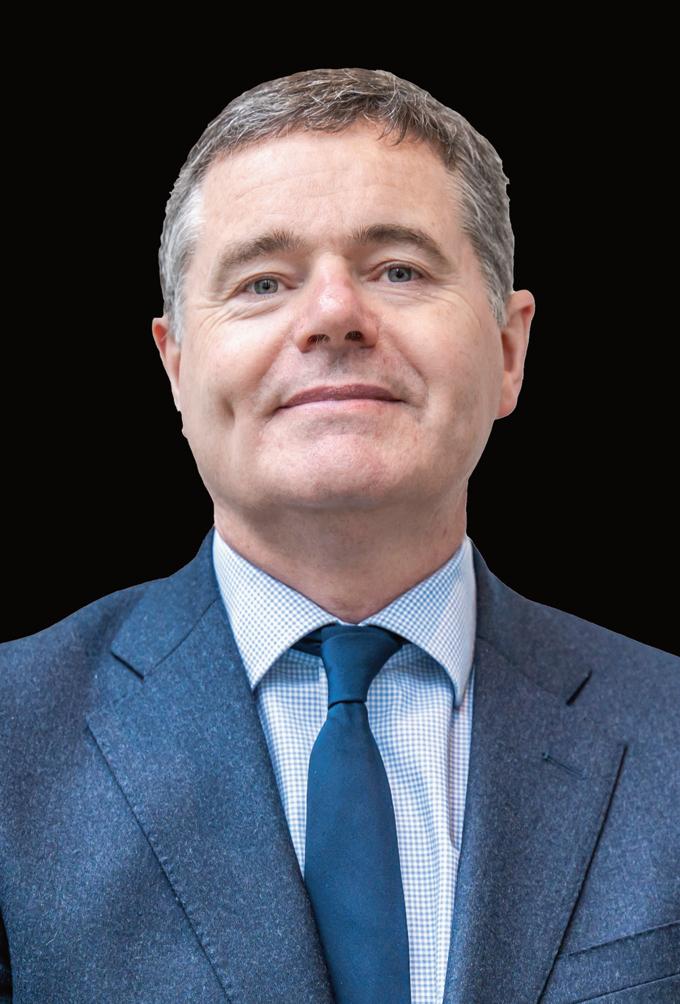
digital government report
129

Empowering public sector success with the Project Foundry
Leading in the public sector demands more than visionary ideas; it requires effective implementation strategies. Balancing business as usual with delivering transformational outcomes across multiple functions, technologies, and initiatives is no easy feat.
At the Project Foundry, we specialise in tailoring solutions to assist senior public sector leaders in achieving their objectives. Our Strategy to Execution transformation model offers an adaptable framework and a repository of best practice tools, tailored to meet you where you stand. We build the skills necessary for transformation, value creation, and successful execution.
As a smart alternative to traditional consulting giants, we specialise in driving transformations, fostering digital prowess, and enhancing execution capabilities. Committed to unlocking the fullest potential of organisations and their leaders, we expedite value realisation, prioritising our clients at the forefront of our endeavours.
Challenges
Did you know that 70 per cent of largescale projects fall short of their goals due to missing crucial elements in the plan? Despite having sound strategies, 67 per cent of companies face setbacks due to flawed execution and a lack of clear vision. In addition, 70 per cent of technology investments fail to deliver expected returns.
Having worked with a diverse clientele spanning various sectors, including life sciences, financial services, technology, Telecommunications, and the public sector, the Project Foundry is uniquely positioned to drive meaningful change and deliver tangible results – ensuring your organisation has the support, skills,
and capabilities to be in the 30 per cent of successful projects. Grounded in design thinking, our methodology optimises business outcomes, ensuring sustainable growth and enhanced capabilities for our clients.
Transformation partnering with clients throughout their journey, we specialise in organisational transformation and future business model development. Collaborating closely with clients, we redefine models for sustainable growth, enhance collaboration, digital and data capabilities, and transformational skills, elevating overall organisational effectiveness. Our change management solutions help deliver and embed operational efficiencies at a tactical or strategic level.
Digital and data transformation transcends technology; it is about your people, supporting changing mindsets, agility, and fostering innovation in organisations. Progressive companies are embracing agility to stay ahead of the curve in an era of rapid change, and that is where the Project Foundry comes in.
130 digital government report Advertorial
We understand that change can be challenging, which is why we are dedicated to facilitating seamless transitions. By aligning structures with objectives and fostering a culture of collaboration, we empower organisations to embrace change and emerge stronger than before.
“At the Project Foundry, we are committed to turning strategic vision into reality. We pride ourselves on fostering a culture of continuous improvement.”
Understanding and leveraging these technologies are indispensable for businesses aspiring to lead in a digitalfirst world.
Cloud advisory
Our Cloud Transformation and Advisory Service provides everything needed to reach your goals. From Cloud Architecture to Cloud Transformation and adoption, we accelerate cloud automation, enhance efficiency, and reduce risk and cost.
Execution
Execution is paramount, and we ensure it is done right. Our meticulously designed plans, coupled with resource allocation, facilitate efficient and effective goal attainment.
In the dynamic business world, achieving effective execution excellence is crucial.
The Value of Service for Our Clients
data products, and how the budget is distributed.
PPM
Our services ensure effective utilisation of PPM technology through process streamlining, organisational change, and technology adoption, enabling sustainable outcomes.
Ongoing support
At the Project Foundry, we are committed to turning strategic vision into reality and delivering value to our clients. We pride ourselves on fostering a culture of continuous improvement. We understand that transformation is not a one-time event but an ongoing journey. With that in mind, we provide ongoing support and guidance to our clients, even after the initial implementation phase, ensuring the project is sustainable and successful.
Our ability to compete in a Fast-Changing Market
Recognising the uniqueness of each organisation, we offer tailored solutions to address specific challenges. Whether it is budget constraints or resourcing challenges, we collaborate with clients to devise solutions that align with their circumstances. Transforming vision into reality is our specialty, and our structured approach, combined with a focus on accountability and clear outcome measurement ensures no detail is overlooked.
Digital enablement
Cutting-edge technology serves as the central point around which modern business revolves. The Project Foundry leverages advancements like AI, robotics, blockchain, and the metaverse to reshape the future of various industries.
Our execution team supports clients in delivering meaningful programmes, projects, and initiatives, driving long-term success.
Data
A data strategy is imperative to ensure that you ask the right questions across the business to utilise your data as an asset. In order to deliver the ‘how’ of unlocking your data using tools such as AI, this is your foundation that needs to be solid. This involves considering strategic alignment, how the use of data aligns with the business strategy and understanding peoples’ expectations of the data and associated services. It also involves determining who prioritises which data product and service is built first, who pays for the development of the
Our commitment to long-term success means that we work collaboratively with our clients to adapt strategies, address emerging challenges, and seize new opportunities as they arise.
With our unwavering dedication, expertise, and personalised approach, we empower organisations to thrive in a dynamic, digital-first world.
Find out more about what we can do for your organisation: E: Info@theprojectfoundry.com

A vision, strategy, and roadmap accelerate strategy to reality Building the case for change for strategy and funding approval Increased net promoter and employee engagement scores Return on investment- cost saving by right sizing your transformation team Reduced costs through efficient processes and automation (15-20%)
customer experience supported by simplified internal processes Clear, measurable KPIs
the
of the transformation Sustainable Supplier Ecovadis Verified
Optimal
to measure
success
digital government report 131 Advertorial
Fresh Thinking

World leading public services: A Danish perspective
Kristian Vengsgaard, CEO of Kombit A/S, an IT company supporting the digital change of Denmark’s municipalities, discusses the values of centralisation and trust in delivering digitalisation of public services.
Denmark sits atop of almost every report and survey on public sector digitalisation, underpinned by the decision to move early as a digital-first nation.
Denmark’s 98 municipalities are the largest by scale and responsibility of the country’s three layers of government, which also includes the State and regions. The economic importance of this layer can be seen by the fact that six out of 10 public servants are employed by the municipalities, while each municipality employs around 10 per cent of its citizens.
Vengsgaard explains that the municipalities have responsibility for much of the public sector work ranging from employment through to childcare,
and public schools, however, a national conversation is ongoing around whether a reallocation of the responsibilities of the regions and the municipalities is required.
Despite being a digital leader, Denmark faces many similar challenges to other European countries with respect to the future of its public services. For example, recognition of an ageing population has opened up a discussion on the ability of the public sector and the availability of personnel to care for the elderly adequately.
“At the heart of this discussion is the technology versus people debate,” explains Vengsgaard, who frames it as the more commonly used Danish term of cold hands versus warm hands.
132 digital government report
Fresh Thinking
Fortunately, discussions are starting to turn to the fact that digitalisation and technology are not ‘cold hands’, but enablers of the right solutions for making the warm hands warmer, and do more warm work than would be possible.”
Alongside a recruitment challenge, Denmark also has rising welfare expectations from its citizens, made more difficult by the fact that the Danish culture has a broad definition of welfare, much of which is largely delivered by the public sector.
In addition, as like most of its European counterparts, the Danish governmental structure and democracy in general is under greater pressure. Despite Denmark recording one of the highest rates of confidence in public services of any EU member state, social agitation and misinformation campaigns have contributed to falling public trust levels in government.
This is happening in parallel with changing security concerns. Vengsgaard says that Russia’s invasion of Ukraine and subsequent changes to European and global security dynamics has destabilised how the Danes consider their security. This instability also relates to cyber security, where cyber has become a central component of warfare.
“As digital people, we need to understand that it is not all about security and developing new products. It is also about understanding that risk is quite different than it used to be.”
Early movers
Returning to the origins of Denmark’s digital journey, Vengsgaard admits that Danish citizens have benefitted from the timing of the Danish Government’s decision to digitalise in the early 2000s because, at the time, digitisation was not a hot political topic.
“Someone had the foresight to see that we could do much of the difficult things without the context of difficult political discussions. We were able to lay some of the groundwork quite early and we have been benefiting from that ever since.”
Some examples of those early moves include:
• digital post: Digital is mandatory for government-citizen interaction;
• NemKonto: All citizens and companies registered in Denmark are required to have a NemKonto, a mandatory bank account to receive payment from the public sector;
• MitID: A resident’s personal key to digital services in Denmark;
• digital income and tax; and
• digital driver licenses, digital health ID, and a digital school/parent communications platform.
Vengsgaard offers three considerations for the delivery of digital public services. The first is the need for an alliance between legislation and IT, working in advance to ensure that legislation is IT and digitise-ready, making it easier to implement and roll out solutions.
The second consideration is to ensure that technology delivers value for citizens. The CEO highlights an existing scenario where the capabilities of technology such as AI are being demonstrated, but these capabilities are not necessarily delivering benefits for citizens and exhibiting transformational change.
This, he explains, is linked to the third point, and the need for public digitalisation to solve global challenges. To this end, he asks the question: “If we have been using digital to do things more efficiently for the past 30 years, where has all that extra time gone?”
“It is an interesting question that we need to pose to ourselves in the next wave,” he states.
“Because while we talk about AI being transformative, how do we ensure that does not mean even more work for us to do?
“We need to ensure that technology and human beings go hand in hand. That is more difficult than it sounds because the potential exists for technology to evolve faster than we can understand it.”
Concluding, Vengsgaard says: “In Denmark, we are struggling on the conversation to digitalise or not digitalise elements of the public service in a very different way than we used to. Similar to our neighbours, we are seeing a higher polarisation of the discussion.
“That means that we, as digital people, need to think about how we talk about this in a way that will continue to focus on the benefits for humans and not for the technology itself.”
digital government report
133
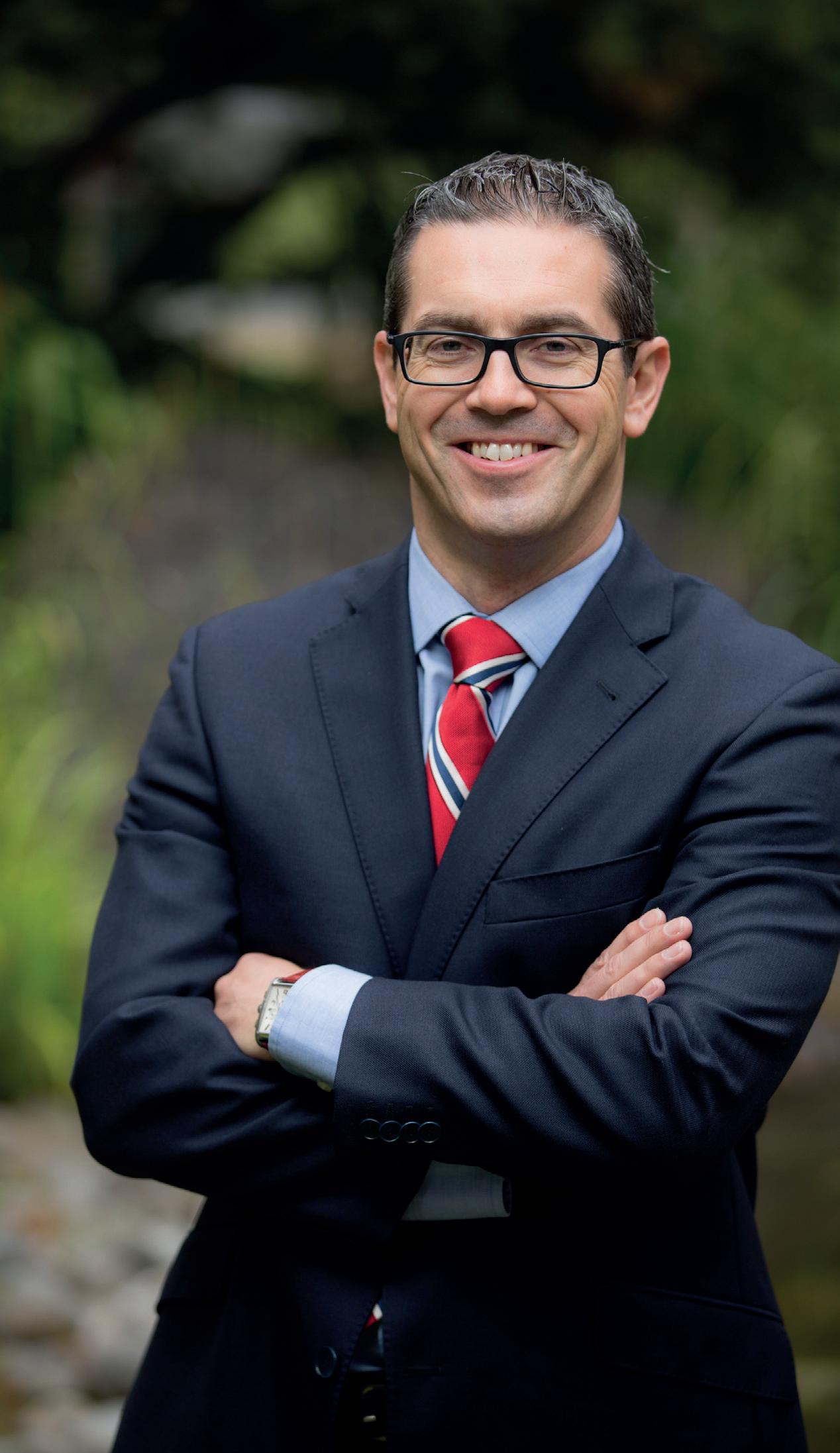

The
role
of
Salesforce in transforming public sector organisations
Find out how Salesforce empowers the public sector with cutting-edge transformation, enhanced citizen engagement, streamlined operations, and robust data security.

In today’s fast-paced technological landscape, the imperative for transformation is more evident than ever. Embracing digital transformation brings numerous benefits, from improved service delivery and operational efficiency to significantly enhanced citizen experiences and engagement. Salesforce stands at the forefront of this evolution, providing public sector organisations with the tools they need to modernise and thrive.
As the engine of the Irish economy, the public sector interacts with and supports thousands of citizens daily. Each citizen has unique needs and preferences, making it challenging to deliver personalised, effective, and scalable services. Data is often scattered across various organisations and silos, while processes remain manual, inconsistent, and reliant on individuals to function smoothly. Decision-making can be hard
due to a lack of trusted data and insights, leading to delays, inactivity, and poor decision-making.
Citizens are increasingly demanding higher levels of service, inspired by the capabilities of commercial organisations. While each government agency has unique needs and missions, they share common requirements for accelerating digital transformation. A scalable and extensible platform is key. Also the ability to quickly stand up environments and easily configure them with low code or no code. Leveraging pre-built data models, processes, templates, and analytics tailored for government use allows for faster implementation. Finally, we must remember that 70 per cent of transformations are driven by people and processes.
Salesforce’s public sector solutions (PSS) is designed to meet the unique needs of the public sector, offering a
rich portfolio of case management applications. Solutions from grants management to license, permit and inspection to composable case management, PSS addresses a wide range of use cases. Its modular, evergreen approach ensures continuous innovation with three upgrades per year, keeping you ahead of evolving requirements, including AI capabilities already available today.
PSS allows you to serve constituents better by:
• deploying IT solutions faster with pre-built components;
• creating new solutions faster with low code tools;
• increasing case worker productivity with automation; and
• reducing time spent on administrative tasks – with AI.
134 digital government report Advertorial
John Stobie, Regional Vice President of Public Sector Sales for Salesforce Ireland.

A recent Salesforce Customer Success metrics survey showed the following results while using PSS:
• 21 per cent faster application development;
• 22 per cent decrease in IT costs; and
• 20 per cent decrease in custom development projects.
In a recent research note, IDC recommended that government agencies consider solutions such as publics sector solutions for many reasons – including customer experience. Additionally, Forrester recently published a Republic of Ireland study showcasing a nine-month payback period for government case management, along with other value drivers.
Ultimately Salesforce’s tools automate routine tasks, manage workflows, and improve data sharing across departments. By connecting disparate systems, data flows seamlessly between departments, minimising errors, and accelerating decisionmaking. This automation frees employees to focus on strategic, valueadded activities, boosting productivity and service quality. Streamlined operations reduce costs, ensuring public funds are used effectively, delivering better value for money.
To increase engagement, Salesforce can unify your communication strategy to allow you to be more proactive. This multi-channel approach means citizens engage with services in a way that suits them best. By consolidating data from
across the organisation and even consuming external data sources into cohesive profiles, agencies can offer personalised services, anticipate needs, and respond proactively. This citizencentric approach builds trust and satisfaction, ensuring that public services are accessible, responsive, and tailored to individual needs. Not only does this enhance service levels, but engaged citizens also use services more efficiently, saving effort for the organization and reducing the overall workload. Salesforce recently helped a number of UK police forces adopt a victim journey approach which has led to significant time savings and enhanced citizen satisfaction.
Data security and compliance are paramount in the public sector, and Salesforce prioritises data protection, adhering to stringent security standards and regulations. With features such as encryption, multi-factor authentication, and continuous threat monitoring, public sector organisations can confidently manage and safeguard citizen data. This enhances trust and credibility while reducing the risk of breaches.
At Salesforce we believe in the principle of think big, start small, scale fast, transforming how public sector organisations approach digital transformation. This strategy enables agencies to envision bold, comprehensive goals while taking manageable, impactful steps toward achieving them.
Thinking big involves recognising the potential for comprehensive transformation. Reimagine service delivery, aim for a future where citizen
engagement is seamless, operations are efficient, and data security is paramount.
Starting small begins with focused, achievable projects. Salesforce’s lowcode and no-code development tools enable public sector agencies to quickly implement solutions for specific issues, such as launching a citizen service portal or automating routine administrative processes. These smallscale initiatives deliver immediate improvements and provide valuable insights and feedback.
Scaling fast capitalises on the agility and scalability of Salesforce’s platform. Once initial projects prove successful, they can be rapidly expanded and integrated into broader systems. This approach ensures that public sector organisations can quickly respond to changing needs and technologies, continuously evolving and improving their services.
In conclusion, embracing this transformation is not merely a strategic choice but a fundamental necessity for delivering efficient, effective, and citizencentric public services. This approach enhances citizen engagement, streamlines operations, improves data security, fosters innovation, enables data-driven decision-making, facilitates collaboration and transparency, and optimises resources in a fast time to value and scalable way.
T: 0800 086 8949
E: jstobie@salesforce.com W: www.salesforce.com
digital government report 135 Advertorial
Fresh Thinking


Ireland continues to exhibit strong digital indicators
The second progress report published for Harnessing Digital, states that Ireland has a leading position in the EU on several enterprise, skills, connectivity, and public services indicators. However, scope for progress remains.
Harnessing Digital: The Digital Ireland Framework, published in early 2022, reflects Ireland’s ambition to continue to be a “European and global digital leader”, and affirms government’s strong commitment to “progressing the digital transformation of our economy and society”.
The second progress report, published by the Department of the Taoiseach in January 2024, states that while positive developments have taken place over the last 12 months, the scope for progress abounds in areas such as driving higher levels of enterprise adoption of AI, cloud and big data, continuing to meet the demand for high quality digital skills across the economy, and progressing
citizen access to digital health records.
The report states that progress towards the State’s national and EU-level connectivity targets through the implementation of the Digital Connectivity Strategy is on track.
“The delivery of fibre to the home broadband is making strong progress, with 70 per cent of premises in commercial areas now upgraded, and over 600,000 premises now have full fibre subscriptions,” the report says, referring to statistics provided by ComReg.
Under Harnessing Digital, the Government has approved the development of legislation to establish
the National Cyber Security Centre on a statutory basis aiming for it to be completed by October 2024 as part of the transposition of the NIS2 Directive.
What is Harnessing Digital?
The Harnessing Digital strategy was developed in line with the EU’s Digital Decade strategy setting out a roadmap to advance the digitalisation of enterprise and public services, enabled by digital infrastructure and digital skills provision at all levels, whilst complementing work towards reaching Ireland’s climate objectives.
136 digital government report
Recognising Ireland’s significant role in enforcing digital regulation, Harnessing Digital reinforces government’s commitment to a modern, cohesive, well-resourced regulatory framework to effectively oversee and enforce existing and new regulations.
Harnessing Digital is designed to institute a cross-government approach to progressing the State’s digital agenda, strong implementation structures under the Cabinet Committee on the Economy and Investment aimed at ensuring “coherent and impactful delivery”.
The report includes regular consultation and engagement with stakeholders, including with industry through the Enterprise Digital Advisory Forum, and with regulators through the Digital Regulators Group.
“Strong political leadership across the broader digital agenda, including at EU and international level, plays a key role in delivery,” the report states.
This cross-government approach, with extensive engagement, is particularly important in the context of the fastpaced evolution of AI, which the report asserts has both potential to enhance Ireland’s socioeconomic wellbeing, enable innovation, and advance productivity, while also bringing risks and challenges. The Government has stated a continued commitment towards an ethical and human rights-based approach to AI that is people-centric, and emphasises fairness, transparency and building public trust, as reflected in the National AI Strategy, AI – Here for Good
While Ireland holds a leading position in the EU on several enterprise, skills, connectivity, and public services indicators, the report affirms that there is work to do to reach our targets in some areas.
The Government has committed to continue to “focus on working to deliver in these areas in particular, to ensure we reach our national, and EU-level digital targets”.
Fresh Thinking
Harnessing Digital: 2023 in numbers
€85 million Digital Transition Fund has helped nearly 300 businesses.
4 new European Digital Innovation Hubs operational: CeADAR (AI innovation hub); FactoryxChange; DATA2SUSTAIN; and ENTIRE.
€2.7 billion National Broadband Plan.
200,000+ premises passed with full fibre broadband.
€10 million committed to a national Quantum Communications Infrastructure network.
2.3 million verified MyGovID accounts.
2 additional commissioners for the Data Protection Commission.
€27.9 million for the DPC under Budget 2024.
Broadband Connection Points now in place at nearly 300 locations.
137 digital government report
Limerick City and County Council: Pioneering digital solutions for a smarter future
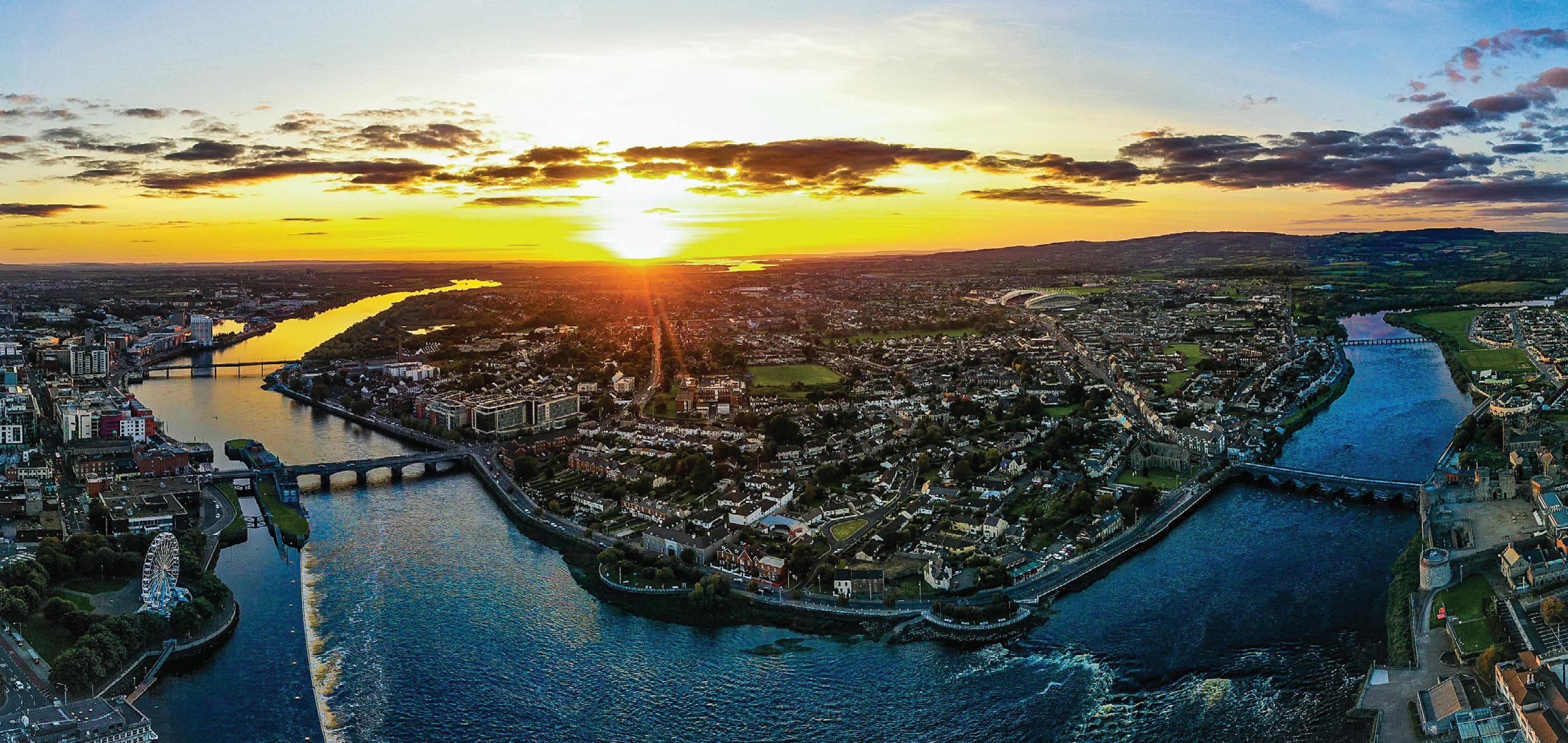
Limerick City and County Council has emerged as a trailblazer in digital transformation, propelling the region into a new era of innovation and connectivity.
Over the past decade, the council has embraced cutting-edge digital solutions, setting the stage for a resilient and forward-thinking city. This article delves into Limerick’s ambitious digital journey, highlighting key initiatives, challenges, and future goals.
A transformative journey begins
The amalgamation of Limerick City Council and Limerick County Council marked the beginning of a transformative journey. Under the leadership of the Chief Executive, a comprehensive change management program was launched to challenge the status quo of local authority operations.
This initiative focused on consolidating customer service operations and implementing a unified digital tool for all
council interactions. A pivotal moment came with the introduction of a customer relationship management (CRM) system, which established the foundation for continued innovation.
Overcoming economic challenges
In the aftermath of the 2008 global economic crisis, Limerick faced significant challenges. The council, alongside local industry leaders, spearheaded efforts to rejuvenate the economy. Today, Limerick enjoys close to full employment across a variety of diverse sectors, has a thriving economy, and a vibrant housing market. With 30,000 students graduating annually from its universities and several large-scale projects underway, Limerick is poised for sustained growth, driven by innovation.
Post-Covid digital transformation
Post-Covid, Limerick City and County Council has embarked on an ambitious digital transformation journey, building on their solid foundations. The focus is on embracing modern technology solutions to meet European and National digital objectives, as outlined in the EU’s Digital Decade plan, Harnessing Digital – The Digital Ireland Framework, and the Local Government Management Agency’s Digital and ICT Strategy. In Limerick, we have a tech-forward mindset and an entrepreneurial spirit that seeks to change the mould of how we are perceived and importantly, how we operate.
138 digital government report Advertorial
River Shannon, Limerick City Credit: Bobby Nowak.
From data-aware to data-driven
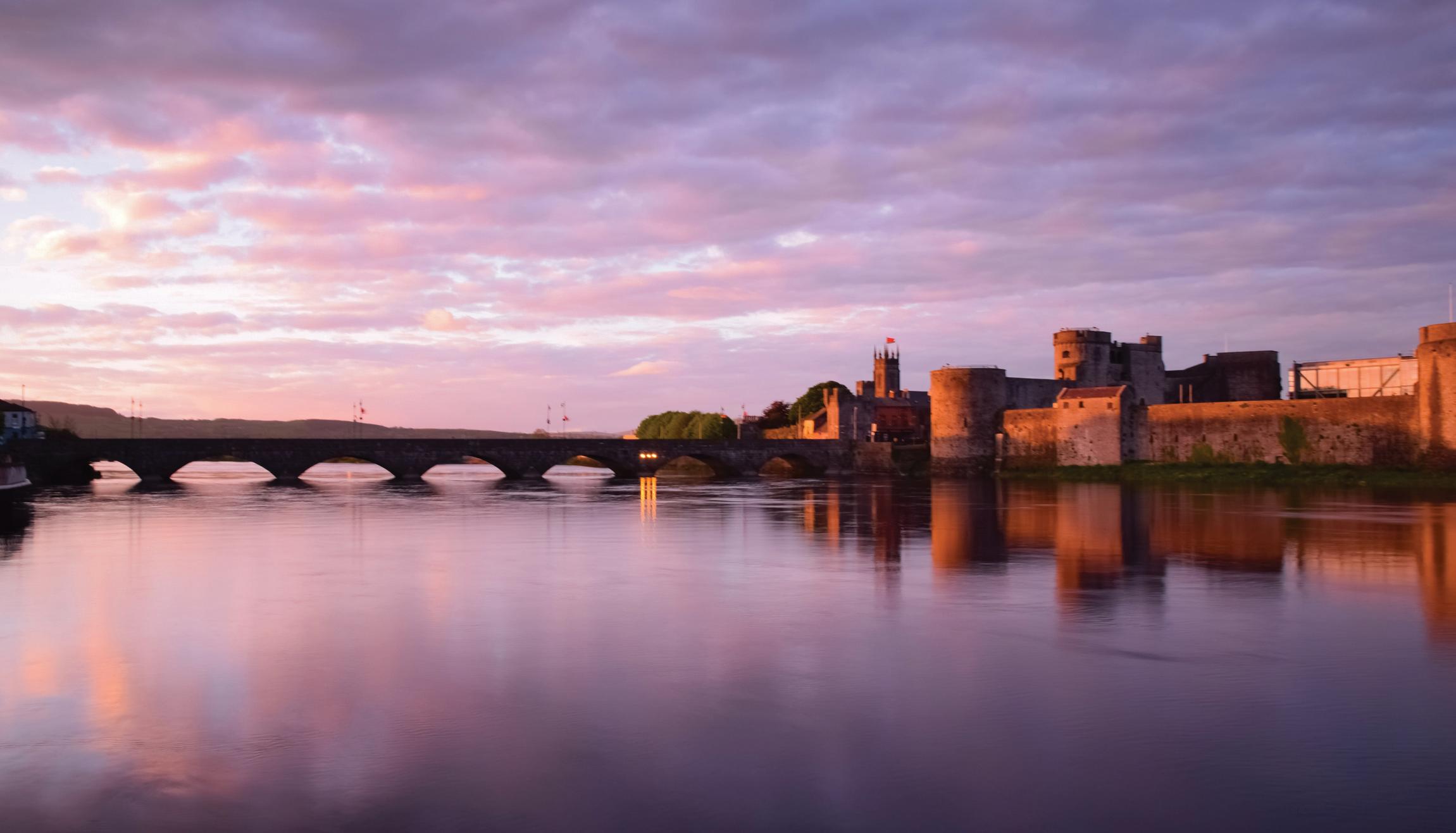
Like all local authorities, we are an information-heavy organisation, and in IT terms, we are currently data-aware. Across our nearly 1,000 services, we use available data to drive service outcomes, but our goal is to transition from being data-aware to data-driven. Being datadriven involves systematically integrating data into decision-making processes and growing a culture where data is central to strategy and operations. This means putting the right data in front of the right people at the right time efficiently, ultimately allowing the organisation to become more proactive and efficient.
Building a data infrastructure
Creating enterprise-scale data and dashboard infrastructure is essential for enhancing decision-making, service delivery, and transparency. This infrastructure integrates multiple data sources, providing a comprehensive view of operations and community needs. It must be robust, scalable, cost-effective, secure, and maintainable. Upskilling the IT team is crucial to managing this sophisticated system, requiring training in cloud services, data strategy, and governance. This process is underway, bringing private sector norms and first hand experience to the table.
Service design and delivery
Digital transformations are complex, requiring harmony between people, processes, and technology. Limerick City and County Council’s focus on service design ensures that digitised processes are optimised first. Our goal is to ensure that the citizen experience can start on the phone, continue in person, and finish over email (or other digital channel). This will also cater for the digitally excluded who should expect that same efficient delivery of their service.
At the core of this is a future lens that will position us for future omnichannel case
management, virtual chatbots, and other technological advancements like AI. This upgrade will enhance our cybersecurity posture and place us in an optimal position to develop new online services, aligning with the council’s digital goals.
Consolidating forms and workflows into centralised platforms reduces confusion and improves efficiency. For IT support, fewer systems to maintain and troubleshoot result in quicker issue resolution and less downtime.
Digitalising back office work will improve service delivery, but more importantly, it has the ability to release capacity from council staff so that they can spend more time doing more valuable work. This in turn can enhance succession planning in a highly mobile work environment, where staff frequently move. It becomes a simpler task to show the new person on the team how to press a button than explain a lot of manual steps. In this age of hyper-automation and AI, the sky is the limit in what we can achieve.
The role of a directly elected mayor
A key differentiator for Limerick is the election of a directly elected mayor
(DEM) in 2024, who will possess executive powers. This pioneering role is expected to transform Limerick, elevating its status both nationally and internationally. The DEM will play a crucial role in driving digital initiatives and fostering a culture of innovation.
Looking to the future
Limerick City and County Council’s journey toward digital excellence is a testament to its commitment to innovation. By embracing enterprisescale solutions and modernising its tech infrastructure, Limerick is setting a benchmark for other cities. The future is bright, with the council’s ongoing efforts promising to enhance the quality of life and economic prosperity for all residents.
As Limerick continues to innovate, the city stands as a beacon of what is possible through strategic digital transformation, paving the way for a smarter, more connected future.
T: +353 61 556000
E: customerservices@limerick.ie W: Limerick.ie
digital government report 139 Advertorial
King John's Castle, Limerick City Credit: Ewan Fenton.
Fresh Thinking

Ireland’s digital governance ranks in OECD top 10
Ireland ranks eighth when comparing to other digital governance across the globe in the 2023 OECD Digital Government Index (DGI).
Despite ranking third as a data-driven public sector and fifth in relation to its digital by design dimension, the State fails to feature in the top 10 regarding two dimensions: Government as a platform and open by default.
The OECD states that the overall best performing countries in the 2023 Digital Government Index include: South Korea; Denmark; United Kingdom; Norway; Australia; Estonia; Columbia; Ireland; France; and Canada.
The index focuses on six “dimensions”.
The first dimension, “digital by design” ranks Ireland fifth globally and focuses’ on digital by design measures “efforts to institutionalise digital government in the machinery of government.”
The second dimension, data-driven public sector measures government’s advancements in developing foundations needed to facilitate data access and
sharing across the public sector. Ranking third, the OECD suggests this is due to scoring well in strategic approach, policy levers, and implementation.
Ireland’s Government ranks 17th when analysing the digital government as a platform dimension, which focuses on “deployment of common building blocks such as guidelines, tools, data, digital identity and software”. The finding suggests that more work is needed in overseeing the adoption of the Government’s identity in the public sector, and development of digital public infrastructure.
Furthermore, the DGI states that Ireland broadly struggles to fully embrace the open by default dimension, as it ranks 13th overall. Open by default measures “the openness beyond the release of open data”. The OECD recommends that countries would benefit from the
development of policy levers, including formal requirements for open government data and stronger monitoring mechanisms.
Ireland ranks ninth when comparing with countries across the world in having a user-driven dimension. This dimension measures “governments’ capacity to place user needs at the core of the design and delivery of public bodies and servants”. Whilst the country ranks in the top 10, recognition in the significance of engaging users in the design of public services and further monitoring of experience of users with public services is needed.
Ireland’s digital government also ranks ninth regarding the proactiveness dimension, which measures “governments’ capacity to anticipate the needs of users and service providers to deliver government services proactively”.
140 digital government report
Fresh Thinking

The OECD states there is significant room to improve governments’ capacity to better use data and AI to anticipate user needs, design and deliver public services.
What is the DGI?
Comprising of 33 countries, the 2023 OECD Digital Government Index (DGI) aims to present findings which “benchmarks efforts made by governments to establish the foundations necessary for a digital transformation of the public sector that is coherent and human-centred”.
Building on a pilot exercise conducted in 2020, the DGI aims to support comprehensive policy reforms in digital transformation of government to increase government productivity, enhance government services and improve people’s lives.
Achieving a high ranking requires a transformation to enable greater interoperability, integration, and collaboration, within and across sectoral boundaries and levels of government, as well as beyond national borders.
On a general basis, countries globally attain overall results in adopting a strategic approach to digital government, and perform worst taking a monitoring approach, highlighting the need to take concrete actions to focus
OECD
on effective implementation of digital government policies, to ensure goals are achieved and stakeholders remain accountable.
Commenting on the report in May 2024, Minister for Public Expenditure, NDP Delivery and Reform, Paschal Donohoe TD said:
“This is a great result not only for digital teams in government but for the people of Ireland. Our digital transformation is increasing productivity, enhancing services and improving people’s lives. The public rightly hold government digital services to the highest standards of safety, security and ease of use and Ireland scores highly in these areas.”
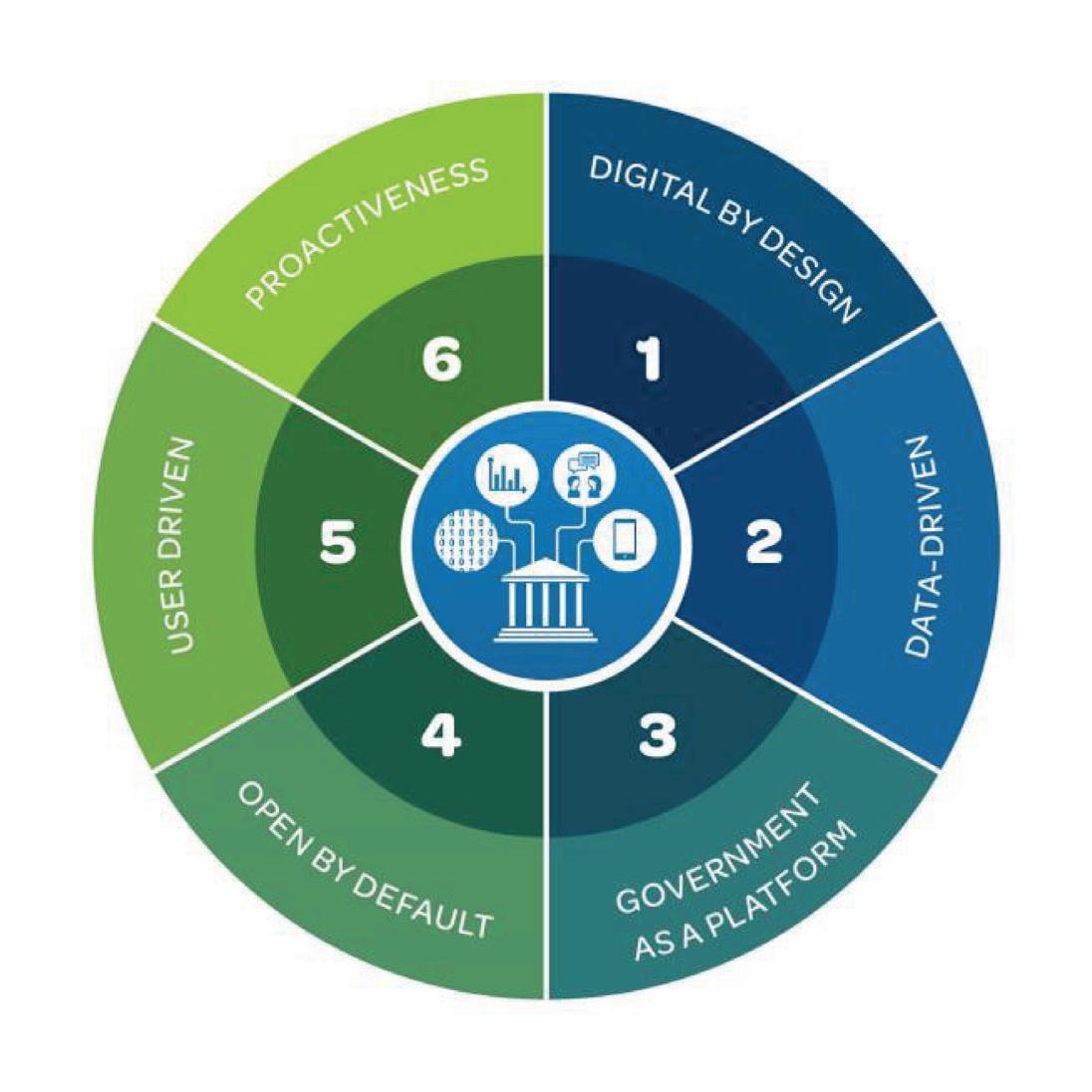
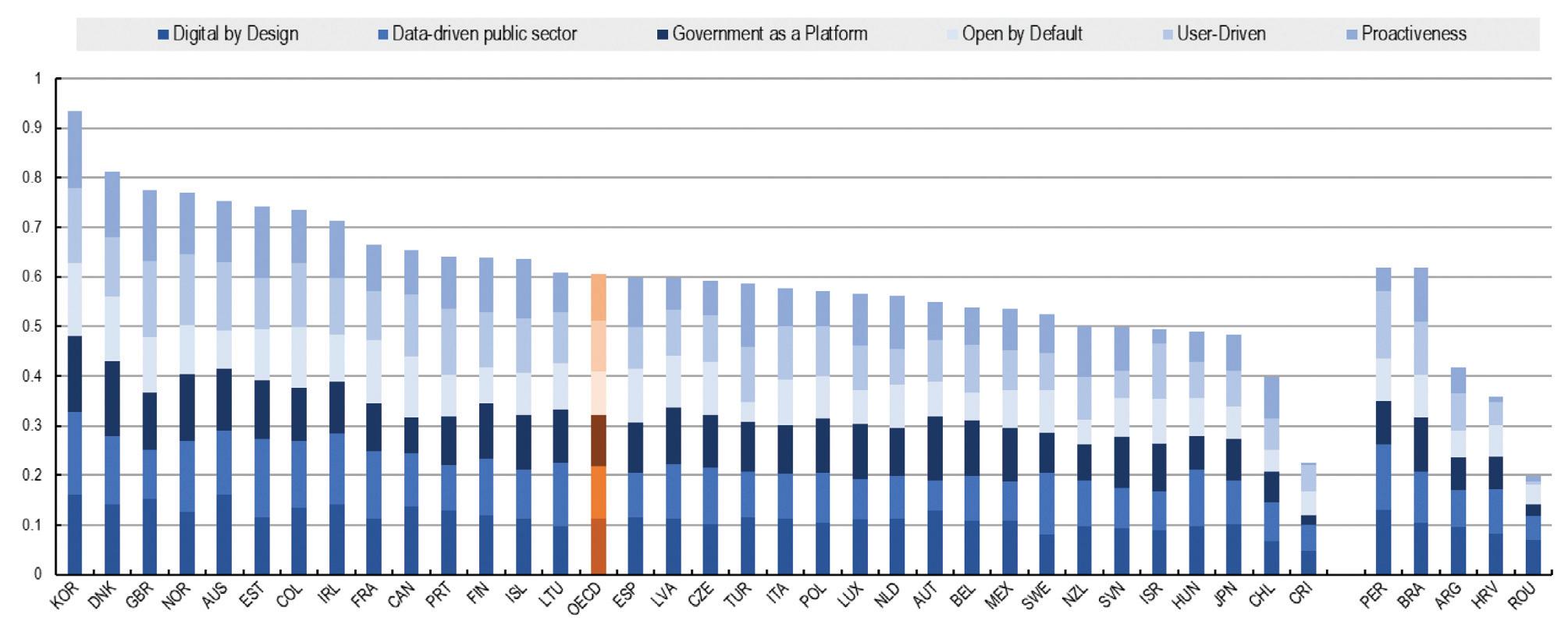
digital government report
141
The six dimensions of the OECD Digital Government Index
Source: OECD, Digital Government Policy Framework
2023 Digital Government Index, composite results by country
Source: OECD, Digital Government Policy Framework.
Setting up for digital success: Public sector transformation with the end user in mind

Digital transformation is no longer the buzzword it once was. It has become an organisational imperative, necessary for continuing to deliver services effectively in an increasingly digital world. It can, however, be a time-consuming and expensive process, making it difficult to justify failures, writes
Ronan Laffan, Head of Digital Advisory, Version
Digital transformation failures still happen on a regular basis. Only last year, an expert evaluation of the UK Government’s commitment to digitise the National Health Service (NHS) found progress to be inadequate. Given the budget constraints facing the public sector and the importance of the services it provides, more needs to be done to ensure the success of its transformation projects.
A key element of this is taking a usercentric approach from the very beginning. Embarking on a transformation project for the sake of it, or for the sole purpose of updating old technology, is not enough. To ensure success, organisation leaders must put people at the centre of their transformation efforts and ensure that any technology introduced is there to serve user needs.
1.
142 digital government report Advertorial
The need for a different approach
Part of the challenge with digital transformation in the public sector is that it often arises out of necessity, rather than a proactive approach to improving services. It is frequently triggered by legislative changes, the need to replace outdated technology, or in response to risk – such as the cyberattack on Ireland’s health service in 2021.
Yet, while this reactive approach may still help with achieving compliance, it overlooks the core of what digital transformation should be about: improving services for citizens. This can often lead to failure in addressing the problems faced by end users, resulting in non-adoption of the new technology, and wasted expenditures and efforts that do not yield the intended benefits.
Additionally, viewing transformation from a purely technical standpoint can severely limit its longevity. Technology is developing at an accelerated pace and if you are upgrading tech solely because it is outdated, chances are it will soon become outdated again.
Of course, that is not to say that the technology is not an important part of the process – it absolutely is – but public service organisations must also consider the holistic experience of end users and how digital services can provide continuous and integrated experiences.
Setting off on the right foot
To improve the chance of success, the digital transformation process needs to be realigned. The capabilities of modern technology have evolved considerably, offering organisations incredible new efficiencies, but to really reap the benefits, organisations must first establish goals linked to business outcomes and user needs; then introduce technology as a means of achieving them.
This will, of course, require research before any transformation is started. Whether this takes the form of surveys or focus groups, organisations should begin by establishing the pain points users are facing, how they can improve the service, and what is needed to deliver that change.
Additionally, businesses need to have a firm understanding of their current IT landscape before implementing any changes. Knowing the ins and outs of their current applications, infrastructure, processes, AI maturity level, and data will provide organisations with a reliable
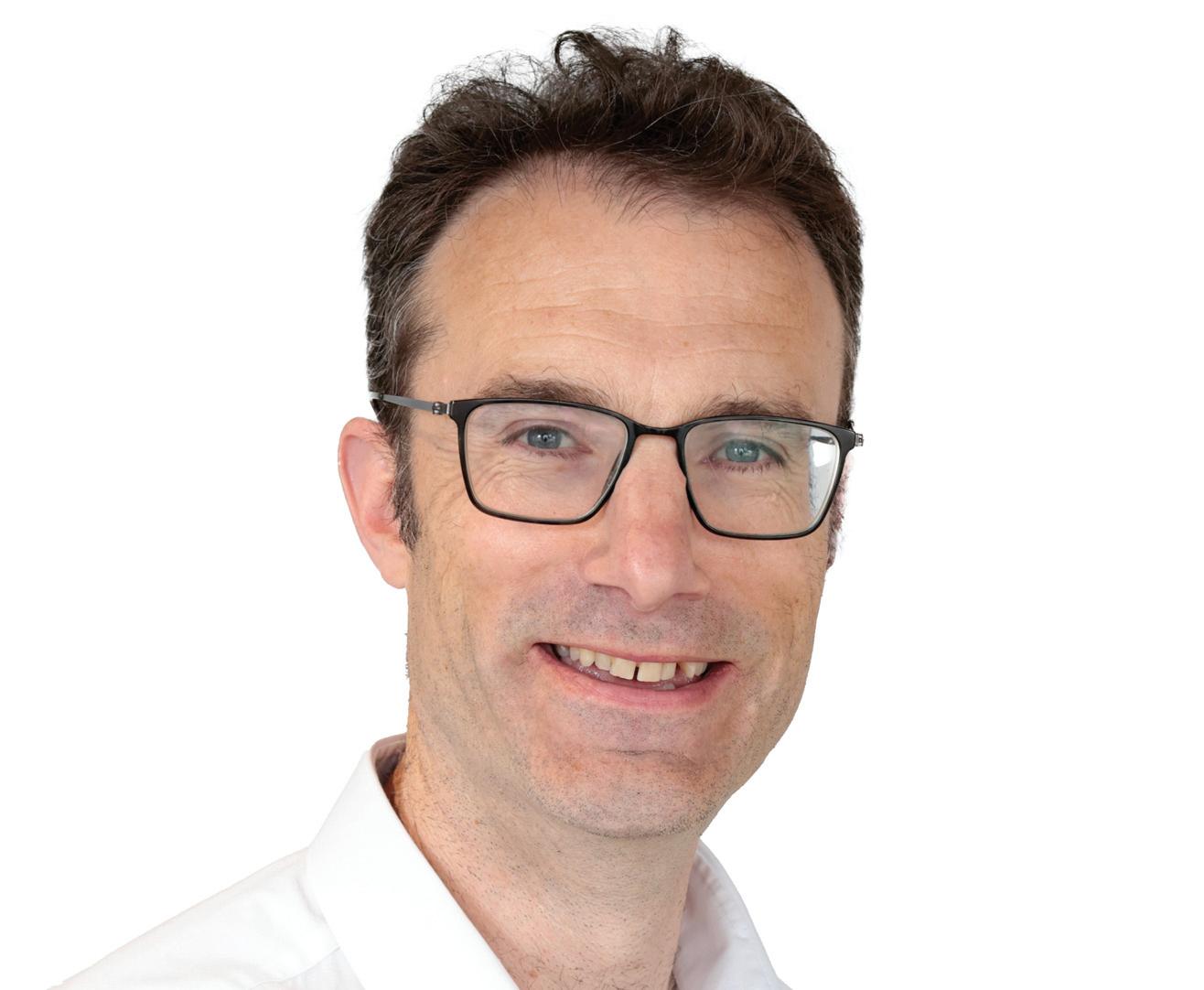
benchmark and a great way to measure future success.
Not only will this help government bodies make more informed decisions now, but it can also encourage a more futureforward approach. Conducting research regularly will highlight how preferences and needs are changing, providing organisations with the insights needed to stay agile and pivot services further down the line.
This approach not only applies to systems used by citizens, but it should also be taken when upgrading services for public sector employees. By involving staff from the beginning of the transformation process, organisations can benefit from their knowledge of current technology and processes –including where any potential bottlenecks might be – and use this to tackle the major challenges they are facing.
The path to success
The success of digital transformation in the public sector hinges on a commitment to address the needs of users, rather than just the integration of new technologies. It requires a user-centric approach from the beginning, so government organisations can pinpoint exactly what the transformation is expected to achieve, greatly mitigating the risk of failure and non-adoption.
Continuous research and feedback from users will help to ensure transformations meet with their needs, as well as putting organisations in a better position to adapt quickly to any future changes.
Furthermore, given the extremely complex, and costly nature of a transformation project, it is crucial to have a full understanding of the IT landscape that is being transformed, including the applications, infrastructure, business processes and data.
Version 1’s enterprise architects play a vital role across its customer base as they help determine and redefine the enterprise IT landscape, establish architecture principles and develop enterprise frameworks to catapult organisations swiftly into the digital age.
If you would like to learn more about how Version 1 and its public sector clients are leveraging Enterprise Architecture effectively, especially in areas like cloud adoption, data management, application development, and optimising business processes, visit: www.version1.com/enterprisearchitecture-round-table/
E: ronan.laffan@version1.com W: www.version1.com
digital government report 143 Advertorial
Fresh Thinking


Managing cyber threats to public services
Jessica Figueras, Chief Executive of cybersecurity consultancy Pionen and Vice Chair of Trustees at the UK Cyber Security Council, talks about the challenges facing public sector organisations in managing cyber threats.
With significant increases in ransomware and phishing attacks, Figueras emphasises that all public bodies are targets of hackers.
“With the use of generative AI, attacks are becoming even more sophisticated. Not so far in the future, we are going to be having deepfakes which are going to make attacks much more sinister,” she says.
Speaking in the aftermath of an intergovernmental conference in early 2024 which focused on controlling the privileged proliferation of commercially focused bad actors, Figueras states that the main challenge is a new generation of hackers who “are being very entrepreneurial and selling the tools that they have developed and their services to other bad actors,” which she describes as “hacking as a service”.
“We are all in the firing line,” she observes, adding: “The harm to citizens that can come about as a result of these threats is something which we cannot ignore. In Australia, for example, there was a very significant breach of private healthcare data, which meant the private medical details of 10 million citizens were posted on the dark web.”
Contrasting the constant advancement of innovation among hackers, Figueras compares this with the pace of cybersecurity action from governments throughout the world.
“Governments and institutions do not tend to move fast,” she says, adding: “We are struggling with the inability to recruit enough skilled cybersecurity professionals we need to do to do the actual work.
“Cybersecurity in the public sector has often suffered from a very piecemeal approach which is inherently reactive. We need to think about a proactive capacity, which evolves each year and is insulated against the winds of change, through budget cycles, and through boom-and-bust economics. The way we are going to do that is by focusing on people, process, and technology.”
Technology
“Cybersecurity is primarily first and foremost a risk management discipline, Figueras asserts. “At the heart of risk management is the idea that we have to not only
144 digital government report

Fresh Thinking
“We live in a world where it is a reality of when – not if –we will face cyberattack.”
Jessica Figueras, UK National Cyber Security Council
know what all of our risks are, we need to know which are most important so we can rank them.”
The main focus, according to Figueras, at the moment for public service organisations is the idea of being secure by design. Looking at new service development, she explains the nature of data-driven cyber defence which is driven by risk.
“It is about understanding intelligence and quickening the pace at which we can pull in information about threats and vulnerabilities and ensuring that we are prepared to respond more quickly.
“To ensure that there is an avenue for this, central agencies, such as the UK’s National Cyber Security Centre, are going to be hearing from –and also increasingly between – governments and trusted international partners, sharing these insights working to defend as one.”
Process
“Almost every large organisation that has been around a while will have accumulated an awful lot of technology over the years and a lot of security controls too,” Figueras contextualises.
With some public sector bodies holding more sensitive citizen data than others, Figueras asserts that there is a need for organisations to ensure that frameworks are developed in a way which is “very specific to the organisation”.
“We live in a world where it is a reality of when –not if – we will face cyberattack. We need to detect incidents and events as they happen so that we can respond to them in real time. We need to be able to recover data and we need to we plan proactively for what recovery means because the warning signs are there.”
People
Figueras says that, within the cybersecurity sector, there is a tendency to “fixate on technology” while not enough focus is placed on “the human beings who actually do the important job of protecting us every day”.
“Amongst cybersecurity professionals, there are high levels of stress of burnout. There are really high levels of mental health challenges. As a result, staff turnover in that sector is high and this is a big part of the reason why organisations in every sector find it really hard to recruit and hold on to their cybersecurity professionals,” she says.
Asserting that cybersecurity professionals are often made “scapegoats” when major incidents occur, she argues: “Professionals need to be valued and supported because we need more of them.
“We need more upskilling, we need to build our capability, and we are not going to do that if we scapegoat, and leave them to their own devices.”
Concluding, Figueras states that adapting a working culture towards supporting people is the key to sustainable success in the cybersecurity sector.
“We are now in a place where we are starting to build security and from the start. To keep this momentum, we need engaged leadership which is accountable and interested in sustainable success while supporting its staff.”
digital government report
145

Geospatial data science: Improving public services

Geospatial technologies offer a practical and cost-effective way to improve public services, writes Vivienne Kelly, Managing Director of Compass Informatics.
Public sector bodies are eager to share data and are open to new initiatives to deliver better outcomes. They face many challenges, however, including inability to access data and concerns about the quality of the data.
Public sector bodies have a wellestablished culture of data sharing and data quality management. More importantly, they are open to new initiatives to harmonise the re-use of data to create efficiencies. That is according to a 2023 survey by the Office of the Government Chief Information Officer (OGCIO). In my experience with
Compass Informatics, working with more than 50 public sector organisations, this is true. There is a genuine appetite among those working in state bodies to take a pragmatic and cost-effective approach to data sharing.
Innovative public sector bodies face challenges, however, in their quest to get the best from the wealth of data that exists. The OGCIO survey found that the potential for data re-use is hampered by the difficulty of accessing the data. In addition, the quality of the data is inconsistent, and duplication can inhibit efficiencies.
Geospatial data science, Geographic Information Systems (GIS) and emerging Earth Observation technologies offer public service bodies an accessible way to overcome these obstacles. Using these innovations, we can take disparate datasets representing real world features and combine them with geographical, environmental, socio-economic and infrastructural perspectives. Furthermore, geospatial data science and earth observation can be augmented by machine learning processes in powerful, cloud computing environments to carry out analysis on big geospatial datasets in a more rapid manner than ever before.
The GeoIntelligence Service provided by Compass Informatics offers a complete process to incorporate disparate datasets from multiple sources, create a geospatial profile and apply machine learning and AI algorithms to earth observation data, delivering deeper insights and near real time change detection directly to an organisation’s existing GIS and business intelligence applications.
Much can be achieved by combining existing data in meaningful ways, without the need to gather large amounts of new data. Because Compass Informatics works across multiple public sector bodies, we are able to identify and access disparate data streams. We are doing just this with Healthy Ireland Local Government, a new initiative in partnership with the Department of Health. We are re-using existing data from across the public sector to build understanding of community wellbeing. The only new data that will be created for this programme will be specific measurements of the impact of community wellbeing actions.
The National Transport Authority (NTA) has also availed of our technical expertise to gain fresh insights by
146 digital government report Advertorial
!"#$%&'()%*+ ,()'&($')-+ ./0


!"#$%&#'()$*'+,)( -.(-&'*+$%-/+#( 0+$+(+*'(1'2( %/&"$)(
<'".&'(#32* > ?(3"* @A3(34
!"#$%&'(&)*+&'&* ,-."/0*-.#1"22(34

3'-)&+$%+#( 4*-.%#'
combining existing datasets. We are combining transport infrastructure data with socio-economic data to allow the NTA to understand how communities access services such as GPs and dentists as well as opportunities for education and employment. This wider lens supports the NTA in planning for more equitable access to public transport.
The problem of inconsistent data quality seems like a wicked one but with our expertise, public bodies have successfully addressed it. We have supported the Marine Institute to develop a data management quality management framework that defines data process quality and provenance. This data management quality management framework is internationally recognised as a benchmark that can be applied across multiple sectors. Creating datasets with strong data quality principles is just one side of the coin. Through a deeper understanding of data provenance, even poorer quality data can be harnessed, as long as the quality is factored in. Addressing data quality is ever more important with the advance of AI.
Thanks to these new data technologies, policymakers, regulators, and planners have access to a deeper understanding than ever before of how real-world features are influenced by their locale. But they can also quantify how changes they make to that locale impact the world around them. The beauty of this new capability is how quickly organisations can see results. We can assess the impact of public service initiatives in a rapid cycle of plan-do-check-act.
Compass Informatics applies machine learning processes to geospatial and earth observation fields, and this enables us to identify changes more rapidly and across a larger area than previously possible.
!"#53&)62(2* 78 9: 9#;")

5+$'##%$'(6,+7'*2( 8/+#2)%)
4+$$'*/( 4*'0%9$%-/ !"#$%&"''()"%*"
We are implementing this approach as lead partners in the Area Monitoring System, an EU initiative of the Common Agricultural Programme and the Department of Agriculture, Food and the Marine (DAFM). In this programme, we combine earth observation processes and satellite imagery to monitor agriculture at a national level. This framework could readily be applied to monitor change across land use, infrastructure, environment and much more.
!"#<3'"))(4"31"* 9(1.#*$".=(1"2

Our experience as partners with multiple public sector organisations has been extremely positive and productive. People in the public sector are, indeed, hungry to innovate by sharing and re-using good quality data, and by augmenting that data. They understand the power of the insights gleaned from this process, how they can use them to inform strategy and
230')#00+ 4$(5#00#0+6+ 7""*'5%&'()0+

4#"7:%/(5'*;%9'( <'#%;'*2($-( '=%)$%/7(365(>( 8/+#2$%9)(+&&)
operations that will benefit the citizen.
Compass Informatics is providing the technical expertise to empower public bodies to realise these ambitions in a cost-effective way.
Compass Informatics
Vivienne Kelly is managing director of Compass Informatics, a geospatial consultancy service, providing expertise in geographic information systems (GIS), data science, custom application development and geospatial data strategies.
T: 01 210 4580 E: vkelly@compass.ie / info@compass.ie W: www.compassinformatics.com
What is geospatial data science?
Geospatial data science is an interdisciplinary practice that seeks to understand why patterns and trends exist in the context of the world around them.
Geographic information systems (GIS) applications can be used to map where features exist and how trends are distributed spatially. Geospatial data science then looks for the correlation and causation trends between them. This way, we can understand the real-life impact of actions taken.
For example, Compass Informatics, working with the Environmental Protection Agency, detailed the potential impact of infrastructural engineering works on overall river quality. This helps us understand how protecting the natural shape of the river can support good river health. By combining data on the impact of engineering works with the data on discharge from industrial and agricultural sources, we can provide a more nuanced understanding of water quality and what can be done to safeguard it.
digital government report 147 Advertorial
Fresh Thinking

Coimisiún na Meán granted investigatory powers
Following the passage of the Digital Services Act 2024, Coimisiún na Meán and the Competition and Consumer Protection Commission (CCPC) have been granted powers to carry out investigations and take enforcement actions, including the imposition of significant financial penalties for non-compliance.
Passed in February 2024 after the Digital Services Regulation came into force in EU law in November 2022, the new legislation designates the organisations as having “competent authority for online marketplaces under the EU Digital Services Regulation”.
The Digital Services Act (DSA) is directly applicable across the EU and applies in full across all EU member states from 17 February 2024.
The original EU regulation aims to regulate online intermediaries and platforms such as marketplaces, social networks, content-sharing
148 digital government report

Fresh Thinking
platforms, app stores, and online travel and accommodation platforms. Its main goal is to prevent illegal and harmful activities online and the spread of disinformation. It ensures user safety, protects fundamental rights, and creates a fair and open online platform environment.
Additionally, organisations for which the DSA applies to are required to:
• provide greater transparency on their services;
• adopt procedures for handling take down notices, informing users in certain circumstances and addressing complaints; and
• refrain from certain practises, such as profiling, and/or improve control for users of their service.
While as an EU regulation it has direct legal effect in EU member states, it was necessary to have national legislation to implement those provisions of the EU Regulation.
In this context, the Digital Services Act 2024 fulfils Ireland’s obligations in this regard and was signed by the President Michael D Higgins in February 2024.
Furthermore, each member state designates a competent authority as their digital services coordinator (DSC). In Ireland, the DSC is Comisiún na Meán, and the Competition Protection Commission (CCPC) is the competent authority for articles related to online marketplaces.
Announcing the commencement, then-Minister for Enterprise, Trade and Employment Simon Coveney TD said: “Enactment and commencement of this legislation has been a priority for me since the Digital Services Regulation was adopted by the EU at the end of 2022. The aim of this regulation is to protect consumers online, make it easier to find and remove illegal content and safeguard the fundamental rights of users –including freedom of expression.
“I am proud that we were one of the first member states to identify and resource our digital services coordinator and Coimisiún na Meán has been preparing for this day since early last year [2023]. I wish both Coimisiún na Meán and the CCPC well in the task ahead.”
Minister of State in the Department of Enterprise, Trade and Employment, Dara Calleary TD said: “The Digital Services Act provides the legal basis for the effective implementation of the EU Digital Services Regulation in a balanced and proportionate manner… Ireland stands ready to play its part in the regulation of the online world.”
“The Digital Services Act provides the legal basis for the effective implementation of the EU Digital Services Regulation in a balanced and proportionate manner.”
Minister of State Dara Calleary TD
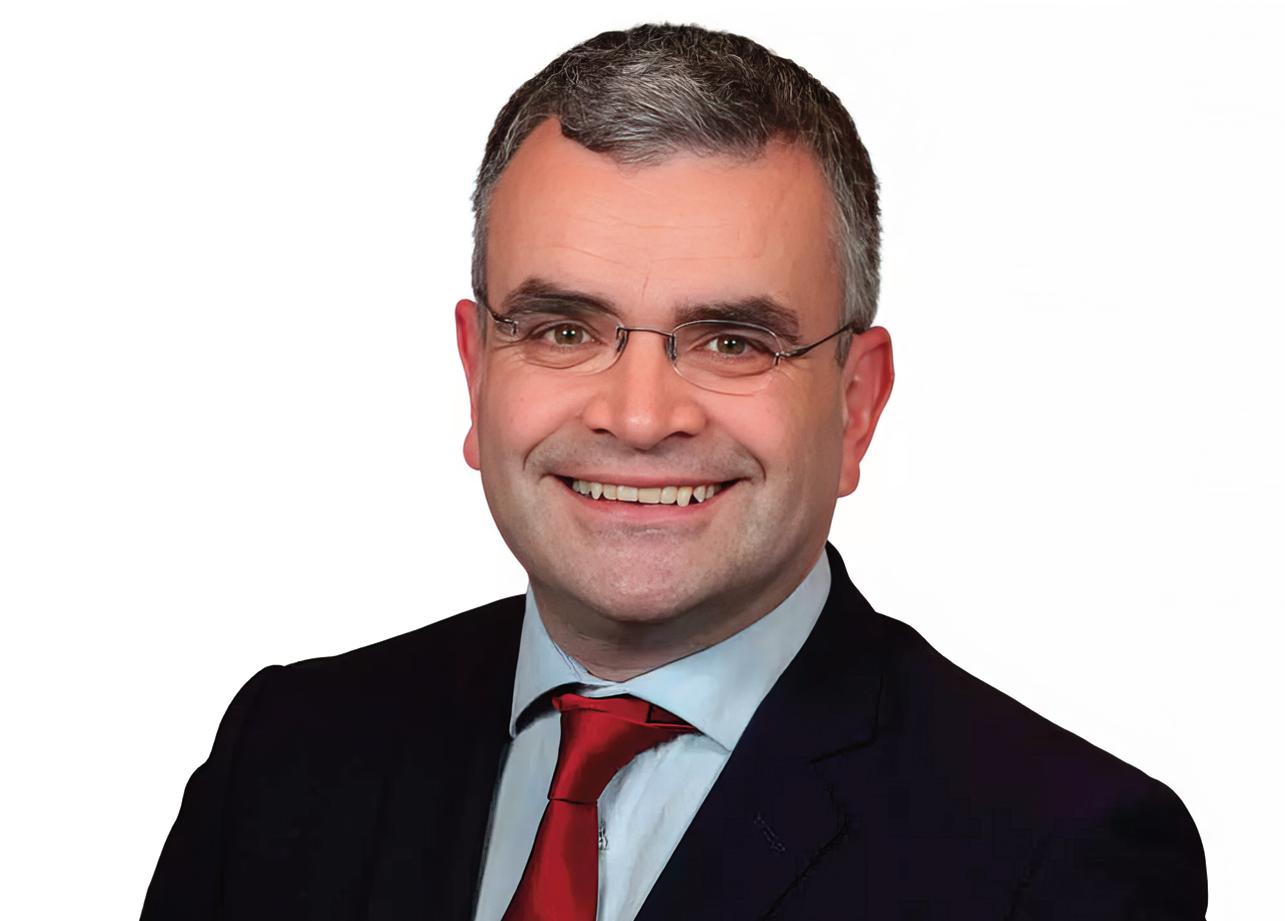
digital government report
149
Embracing technological evolution: A roadmap for Ireland’s public sector
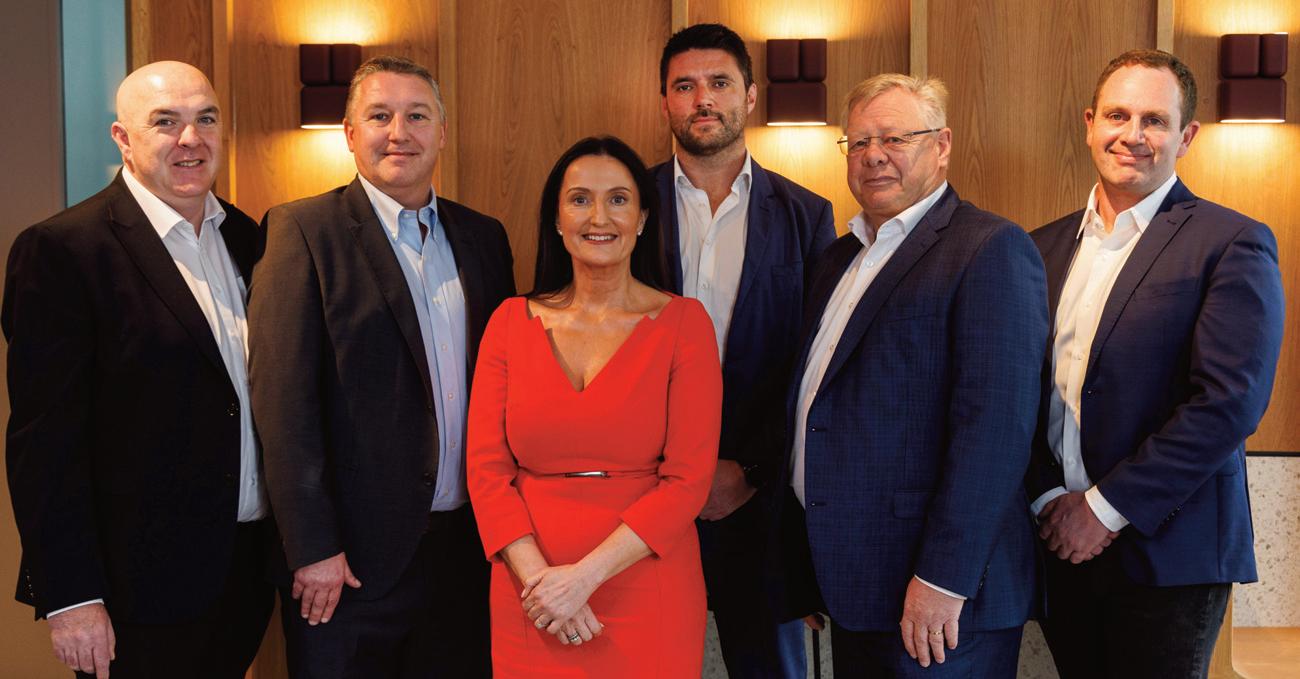
In recent years, technology has become the catalyst for monumental change, reshaping our world and the tech industry itself. The rise of cloud computing, the data explosion, mass digitalisation, and the emergence of generative AI have collectively forged a path of ‘positive disruption’.
This disruption has unlocked countless opportunities but it has also cast a spotlight on the critical need for organisations across all sectors to evaluate their IT investments and ensure they have robust data management and security protocols in place.
The result of this ‘positive disruption’ on the public sector has been, and will continue to be, transformative. Irish citizens are more connected and more data literate than ever before, and in turn more demanding of advanced digital services of the highest quality. This puts increased pressure on all government services. The public sector, as a bedrock of Irish society, must also foster trust with the public to deliver better outcomes,
especially when it comes to data protection and the security of personal information. Add to this the ongoing pressure to optimise costs and efficiencies, enhance customer experiences, adopt emerging technologies, and meet compliance standards.
Subsequently, optimisation is a prevailing theme for public sector CIOs and IT decision-makers, especially when it comes to optimising their existing IT investments, multi-sourced infrastructure and resources. This is why working with trusted IT partners forms such a crucial part of the sector’s wider IT strategy. With a 30-year legacy working with Ireland’s public sector, Ergo brings together
expertise from its six core service areas of digital, cloud and infrastructure, security, license management, productivity, and managed services, offering the collective breadth and depth of IT solutions aimed at digital transformation to optimise the operational models of the sector.
Optimisation of existing investments and infrastructure
Secure, accessible, and compliant architectures are key to public sector innovation, leading to improved services and community outcomes. The strategic implementation of hybrid and multi-cloud management aligns with Ireland’s progressive ‘cloud-first’ ambition.
By adopting a hybrid and multi-cloud framework, public bodies can achieve a balance of cost-efficiency, performance, security, and scalability. This approach not only leverages the strengths of diverse cloud services but also optimises their return on investment by exploiting their existing legacy systems. The deployment of sophisticated tools and strategies is crucial for the effective administration of intricate hybrid and multi-cloud ecosystems, ensuring that data is not merely stored but is also refined for peak accessibility and fortified security. This forward-thinking approach empowers public bodies to remain at the forefront of technological advancement and public service excellence.
Optimisation of data
The technological landscape is in constant flux and organisations are amassing data at an unprecedented rate. The digital transformation journey for the public sector, and the realisation of its full potential, hinge on the ability to optimise data in a manner that ensures security and privacy are compliant, efficient and cost-effective while delivering greater outcomes for citizens.

150 digital government report Advertorial
Pictured (L-R): the leaders of Ergo’s Public Sector Centre of Excellence, John Molloy, General Manager of Northern Ireland, John Clancy, Managing Director of Managed Services, Shelah McMahon, Head of Public Sector, Stephen Foley, Managing Director of Micromail, Derek Kehoe, Managing Director of IT Resourcing, and Brendan Dunleavy, Director of Digital Practice.
This era of data explosion presents a unique set of opportunities and challenges. As data grows in volume, variety, and velocity, we empower the public sector with sophisticated data management strategies, platforms and applications. These encompass comprehensive solutions for data integration, governance and security, mitigating risks while facilitating deep insights into public needs, enabling the public sector to make informed decisions that benefit broader society.
AI augmentation plays a crucial role in this endeavour. By enabling and leveraging AI, we can streamline data analysis and management processes, making it easier for the public sector to access and utilise their data. Our commitment to ethical AI ensures that these advancements are made with a focus on data privacy, bias prevention, and trust and fairness.
Optimisation of industry expertise and trusted partnerships
As Ireland’s largest indigenous IT solutions company, with a strong track record of partnering with the public sector, Ergo deeply understands the challenges facing state bodies as they look to redefine governance and the efficient delivery of public services with the power of technology.
Ergo: A partner for digital government
At Ergo’s Public Sector Centre of Excellence, we are deeply committed to guiding our public sector clients through the ever-changing technological landscape. We are dedicated to harnessing technology’s power, not just for operational efficiency, but to create a lasting legacy of progress and better outcomes.
Our IT experts take a holistic approach towards understanding the unique challenges the public sector operates in and can demonstrate how to use digital solutions to release bottlenecks and drive efficiencies.
We have unrivalled sectoral expertise, with business practices across digital, cloud and infrastructure, security, license management, and productivity, all underpinned by a robust and enterpriseclass managed services offering. Ergo is uniquely positioned to support and partner with the public sector with our expertise in augmented resourcing, consultancy and design, and our alwayson, 24/7/365 managed services. Further, we unify licensing and business value
Ergo’s Public Sector Centre of Excellence
�ligning with �Connecting Government 2030 Connecting Government 2030�
realisation of technology investments with Micromail, one of Ireland’s largest licensing solution partners, an Ergo company and a long-standing partner to the public sector.
Ergo is a team of more than 700 IT professionals across nine offices on four continents. More importantly, Ergo has been very proud to partner with the public sector in Ireland, delivering bespoke solutions to meet its needs.
For more information, please get in touch with Shelah McMahon, Director of Public Sector, Ergo: E: shelah.mcmahon@ergotechnologygroup.com W: www.ergotechnologygroup.com
With a cloud-first, secure-by-design and user-centric approach, we partner with central and local government, education and healthcare to undertake progressive digital transformation for better outcomes
Human-driven Digital Experience
Frictionless hybrid cloud-based platforms and portals for citizens
User-centric design and experience
Enabling citizen engagement over digital channels

Data management strategies with AI powered analytics
Informing greater decision-making for the government
Data-protection and governance to preserve citizens’ trust
1. 4. 2. 5. 3. 6.
Evolving through Innovation
Expert consultancy to future proof citizen needs
Access to industry expertise in emerging tech
Utilising AI for greater e�ciency and innovation
Strengthening Digital Skills Harnessing Data E昀ectively
Enabling government sta昀 to adopt new ways of working
Embracing tech adoption through change management and training
Overcome resource constraints with access to skilled IT talent
Optimising hybrid cloud and full cloud adoption strategy
Using cloud platforms to make service delivery more scalable and agile
Modernising legacy applications
Focusing on Governance and Leadership
Experienced program delivery for greater success
Data security, risk and governance while maintaining user privacy
Sectoral expertise based on decades of public partnerships Government as a Platform
Digital
default
cloud-昀rst | All-of-government approach | New ways of working | Privacy-driven
secure by design
digital government report 151 Advertorial
Alignment with core design principles
by
and
and
AI FORUM
ARTIFICIAL INTELLIGENCE
2024
Thursday 24 October • The Gibson Hotel, Dublin
2021’s AI: Here for Good strategy was founded on three core principles: adopting a human-centric approach to the application of AI; staying open and adaptable to new innovations; and ensuring good governance to build trust and confidence for innovation to flourish. The 2023 progress report outlined the actions taken to date, however, given the significant changes since this strategy was launched, there are some additional actions already under way and others being planned for the coming months. When it comes to AI, the pace of change is now faster than we have ever seen before. What transformative effects will it have on the delivery of our public services?
The release of ChatGPT at the end of 2022 has brought huge focus and meant that AI has really entered the public consciousness and discourse. In March 2024, the European Parliament adopted the Artificial Intelligence Act – the first-ever legal framework on AI, which addresses the risks of AI and positions Europe to play a leading role globally. 2024 has also seen the creation of Ireland’s AI Advisory Council, independent of government, made up of fourteen experts.
Sponsorship and exhibition opportunities
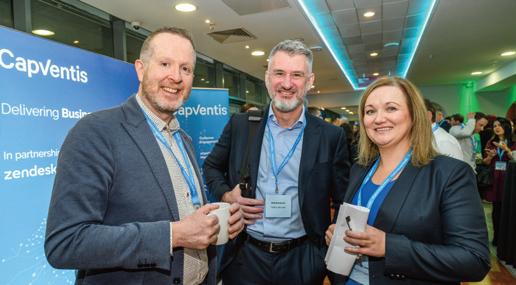

4 Bridging the gap between the public and an understanding of AI
4 Regulating AI amid the rapid pace of evolution
4 Addressing the skills shortage
4 Issues around trust 4 Managing expectations
4 Not a replacement: Supporting and augmenting human capabilities
4
Privacy and security
4 The impact of the digital divide
4 The role of data in AI
4 Embedding AI into existing systems and business workflows
4 The transformational benefits and opportunities
4 Delivering the core principles: trustworthy, people-centred and ethical


There are a limited number of opportunities to become involved with this conference as a sponsor or exhibitor. This is an excellent way for organisations to showcase their expertise and raise their profile with a key audience of senior decision makers from across Ireland’s public services. This interactive conference provides an excellent opportunity for making contacts and networking. For further information please contact Lynda Millar on 01 661 3755 or email lynda.millar@eolasmagazine.ie.






Online www.aiforum.ie Email registration@eolasmagazine.ie Phone +353 (0)1 661 3755 More
examined include:
information available soon! Key issues

The ‘corrosive’ effects of revolving doors
European Ombudsman Emily O’Reilly has warned that revolving doors between the private and public sector can have a “corrosive effect” on public trust, fuelling euroscepticism and undermining EU interests.
O’Reilly, who was Ireland’s first female Ombudsman and Information Commissioner between 2003 and 2013, was speaking on 22 May 2024 after it emerged that Henrik Morch, a director in the Commission’s antitrust arm, had accepted a well-paid role with a New York-based law firm.
O’Reilly said: “The clear impression is that the Commission has allowed one of its senior officials to work for a non-EU company that anticipates major benefits from that inside knowledge.”
O’Reilly’s has stated that she will carry out a probe following the publication of research by the European Parliamentary Research Service, Rules on ‘revolving doors’ in the EU, which has sparked discussion on ‘revolving doors’ in European politics. The report reasserts that rules around revolving doors are not implemented on a consistent basis throughout EU institutions.
Arguably the most prominent recent example of revolving doors is the José Manuel Barroso case (where he
accepted a senior advisory role at banking firm Goldman Sachs after serving as President of the Commission between 2004 and 2014).
Following a probe into this, the European Ombudsman O’Reilly concluded that despite Barroso not breaching EU law, he should “abstain from lobbying on behalf of his then-current employer”.
Allegations of maladministration by EU institutions are investigated by the European Ombudsman.
The ‘cooling off’ period for former members of EU institutions varies from six months to three years: six months for members of the European Parliament; 18 months for presidents of the European Council; two years for members of the Commission, members of the European Court of Auditors and members of the European Economic and Social Committee; three years for the president of the European Commission, and for judges or advocates general of the European Court of Justice.
The cooling-off period for members of high-level ECB bodies is either one year or six months, depending on the type of activity and financial institution the former member intends to join.
In terms of national legislation in member states, in Ireland, there is legislative provision for a two-year prohibition on lobbying in connection with previous employment (a ‘cooling off’ period). In 20 of the other 26 EU member states there is no mandate for people leaving the public sector to engage in a cooling off period, including in France, Germany, and Italy.
European Commissioner for Competition, Margrethe Vestager has stated that it is “really important that people can trust that you cannot work in the Commission and then on the next day, leaving the Commission, that you cannot lobby the Commission or work on the same cases.”
However, the research by the European Parliamentary Research Service outlines that there remains a significant gap, with prominent figures throughout the EU and national governments free to use their insider knowledge to further their own careers.
153 eolas europe eolas europe
José Manuel Barroso, former President of the Commission who accepted a senior advisory role at banking firm Goldman Sachs.
Commissioner Kadri Simson’s vision for European energy

European Commissioner for Energy, Kadri Simson, tells eolas Magazine that the EU’s ambitions for sustainable energy are “where our future lies” and praises progress being made in Ireland in this regard.
“What is happening right now is a renewables revolution,” says Simson. “This decade, the installed capacity of renewable energy in the EU is set to triple and the past two years have set new records for wind and solar power deployment.”
In the electricity sector, the share of renewables throughout the EU has increased from a rate of 34 per cent in 2019 to 41 per cent in 2022 and Simson is optimistic that this will have further increased when figures for 2023 are released.
In 2024, the EU reached an important milestone as energy use from wind surpassed natural gas for the first time, growing by a record 5,500 hours from 2022 levels. Although cognisant of the progress being made, Simson warns against complacency.
“All these good results do not mean that our work is over; more efforts will be required to achieve the targets,” she states.
The EU has introduced a framework which aims to ensure faster and simpler permitting procedures, working in tandem with new rules to reform market design.
“This will help to further integrate renewables in the electricity system. What we need is
154 eolas europe eolas europe
“This decade, the installed capacity of renewable energy in the EU is set to triple and the past two years have set new records for wind and solar power deployment.”
Kadri Simson, Commissioner for Energy, European Commission
a swift and ambitious implementation of the EU framework by member states,” she says.
Renewable energy in Ireland
Simson says that Ireland is “certainly playing its part in keeping up our ambition” in terms of the EU’s broad decarbonisation targets.
“You have set sectoral carbon budgets, you have upgraded your renewable electricity penetration from 30 to 70 per cent. Which is very ambitious in a tight timeframe.”
She adds: “Your plan for a cumulative target of 22GW of wind and solar PV capacity by 2030 will make Ireland a world leader in clean energy. Wind in particular, is one of Ireland’s strengths.
“Ireland already has a lot of vision for harnessing its wind potential. You have earmarked some of your wind for producing renewable hydrogen. You are also investing massively in offshore wind and putting effort into accelerating permitting processes. In this respect, let me commend Ireland for the first auction under the Offshore Renewable Energy Support Scheme.”
Asserting that the performance of the broad wind energy sector in Ireland has “surpassed expectations”, Simson states that the progress made in Ireland so far “marks a promising start for the sector”. Simson, a former Estonian cabinet minister, states that across the EU, renewables have also made “huge strides in transport and heating”.
“In Ireland, what is really encouraging is that heat pumps are now the go to option for new builds. You are also
looking more and more into district heating. This is an efficient way to deliver clean and affordable heat while reducing the load on the energy system.”
On her broad vision for the European energy system of the future, Simson says that “a successful energy transition depends on having strong resilient digital and cyber proof power infrastructure”. “Without an electricity network fit for purpose, we will not achieve our REPowerEU goals to replace Russian fossil fuels, nor reach our net zero targets.
“We especially need interconnected electricity rates. This is important for our security of supply, for integrating more renewables into member states’ energy markets, and for electrifying the energy system.”
The Celtic Interconnector is expected to be completed by 2027, having been awarded the status of project of common interest, meaning it benefits from a number of incentives including substantially EU funding.
On the interconnector, Simson says: “It will link Ireland and France and benefit consumers in the two countries. It will also allow for more flexible exchange of power flows between mainland Europe and Ireland.”
Concluding, Simson says that the term of the 2019-2024 Commission has been “transformative for the EU energy system”.
“Four years ago at the start of this Commission’s mandate, we knew that huge change was on the horizon. We did not realise however, just how far we would go and how ambitious we would become.
“Russia’s invasion of Ukraine proved that we made the right strategic decision to go all in on the energy transition. This is where our long term and actual freedom lies. Now, we must stay the course. Let us continue working towards cleaner, greener, and more affordable energy for citizens in Ireland and all across Europe.”
155 eolas europe eolas europe
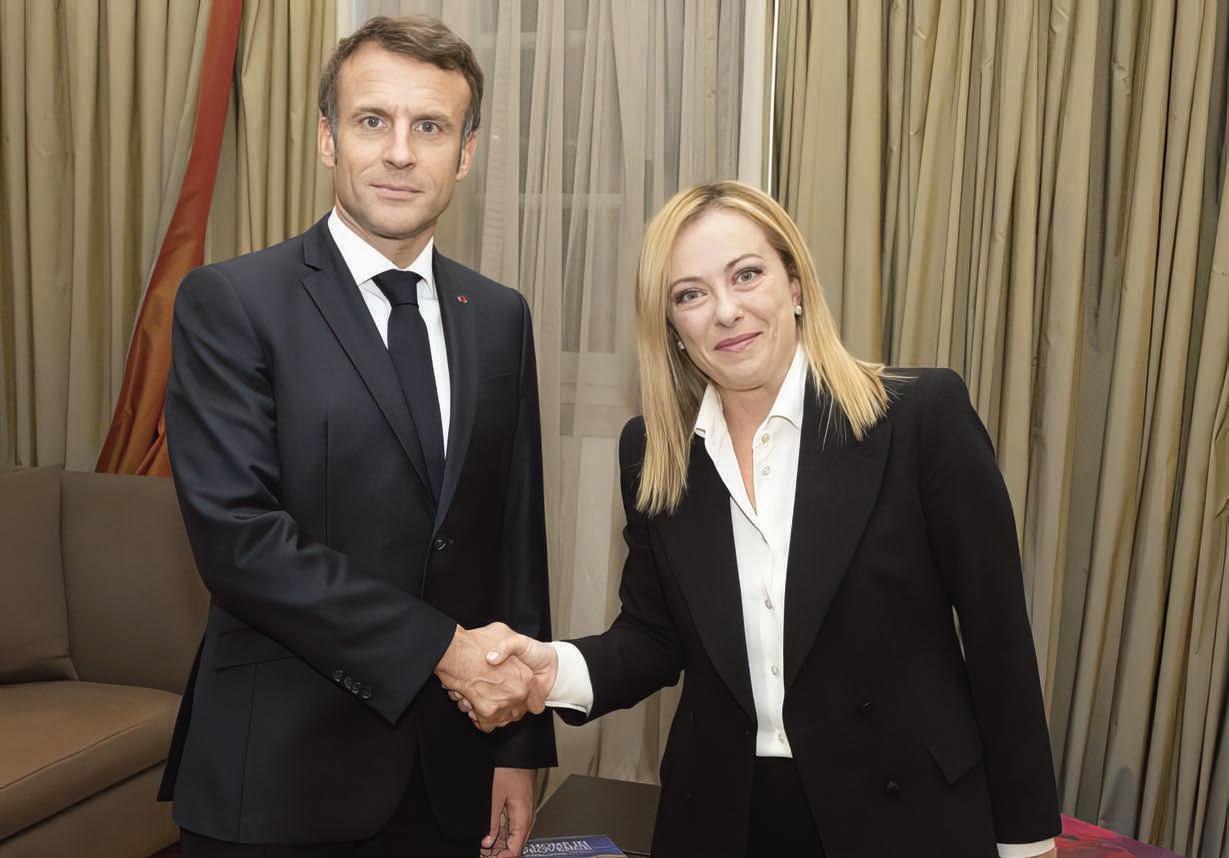

European election 2024: Ireland defies Europe’s rightward shift
Meloni.
Ireland is set to buck the trend of European politics, with the majority of the State’s MEPs likely to continue to be from parties of the centre. Joshua Murray reflects on the European elections both in Ireland and abroad.
At the time of writing, voting has finished in Ireland and first preference totals only show the first preference vote in Dublin as well as turnout in Dublin. Barry Andrews of Fianna Fáil has topped the poll in Dublin in 16.5 per cent of the vote, followed closely by Fine Gael’s Regina Doherty on 16.3 per cent of the vote.
The two other seats up for grabs are set to be battled out between Sinn Féin’s Lynn Boylan, the Green Party’s Ciarán Cuffe, Labour’s Aodhán Ó Riordan, and Independent Ireland’s Niall Boylan, while Independents 4 Change incumbent Clare Daly has an outside chance of victory.
Elsewhere, in the Midlands–North-West constituency, independent left-wing candidate Luke ‘Ming’ Flanagan has topped the poll and will likely be re-elected, while Fine Gael is hopeful of winning two of the five seats up for grabs in the constituency. Sinn Féin stands a chance of winning a seat, but it is possible that neither Chris MacManus nor
156 eolas europe eolas europe
Michelle Gildernew will be elected. Fianna Fáil is hopeful that at least one of its three candidates is elected here, with Barry Cowen having secured the highest number of first preference votes out of the Fianna Fáil candidates.
In Ireland South, where five seats are up for grabs, Fine Gael’s Seán Kelly has topped the poll and been elected while Fianna Fáil’s Billy Kelleher is polling closely behind and is expected to secure a seat. The remaining seats are set to be fought out between independent Michael McNamara, Sinn Féin’s Kathleen Function, Independents 4 Change incumbent Mick Wallace, Green Party incumbent Grace O’Sullivan, Fine Gael’s John Mullins, and Fianna Fáil’s Cynthis Ní Murchú for the three remaining seats.
Across Europe, the European elections have been characterised by a swing to the radical and far-right. While populist right-wing candidate Niall Boylan stands a chance of winning a seat in Dublin, there is no significant swing to the right likely to materialise in Ireland in this election, with farright parties obtaining derisory votes.
Overall, Fine Gael and Fianna Fáil are both likely to win seats in each constituency and one will emerge as the victor of the election. Sinn Féin is in the running in all three constituencies but could find itself squeezed out in the Midlands–North-West and South constituencies, while the Green Party and Independents 4 Change incumbents battle to retain their seats.
As with the local elections, there has been a low turnout for the European elections, with overall turnout at 50.3 per cent. However, the fact that Fine Gael (which is hoping to win its fifth consecutive European election) and Fianna Fáil have been the two strongest parties will be seen as a vote of confidence in the Government.
Europe swings rightward
Across the EU, the broad radical right, among which there are some far-right parties, have been garnering significant levels of support, while centre-right parties have also performed strongly. However, President of the European Commission, Ursula von der Leyen
looks set to have a pathway to remain in charge, with the centre-right/Christian democrat European People’s Party (EPP) emerging as the largest group in the parliament, and the option of either a new ‘grand coalition’ with the Party of European Socialists (PES) or a right-wing coalition with the radical right European Conservatives and Reformists and Identity and Democracy groups.
Most prominent among the success of the far-right has been in France, where the Rassemblement National, Marine Le Pen’s party formerly known as the Front National, has recorded 32 per cent of the vote and comprehensively outpolled President Emanual Macron’s liberal L’Europe Ensemble group. With the prospect of a far-right government in France, Macron has taken the bold decision to dissolve the National Assembly and challenge the far-right to defeat his party in a general election.
The results have also had ramifications in Belgium, where the Prime Minister Alexander De Croo has resigned after his moderate Flemish nationalist party recorded just 6 per cent of the vote while right-wing nationalists in Flanders and Wallonia emerged victorious.
Other countries where the radical and farright has polled strongly include Austria, Italy, Greece, and the Netherlands.
While the rise of right-wing populism in Britain led to the UK’s withdrawal from the EU, it is unlikely that this phenomenon will be repeated throughout the rest of the continent. What could emerge, however, is a loosening of support for some of the EU’s core values, such as open borders and the eurozone, with the bulk of far-right support emanating from anti-immigration sentiment.
Populist politics has flickered in Ireland on the left and right, but in the rest of Europe it has taken a firm hold and is now a dominant themes in many European democracies, meaning that a significant period of flux is to come in European politics.
This issue of eolas Magazine went to print on 11 June 2024.
157 eolas europe
europe
eolas
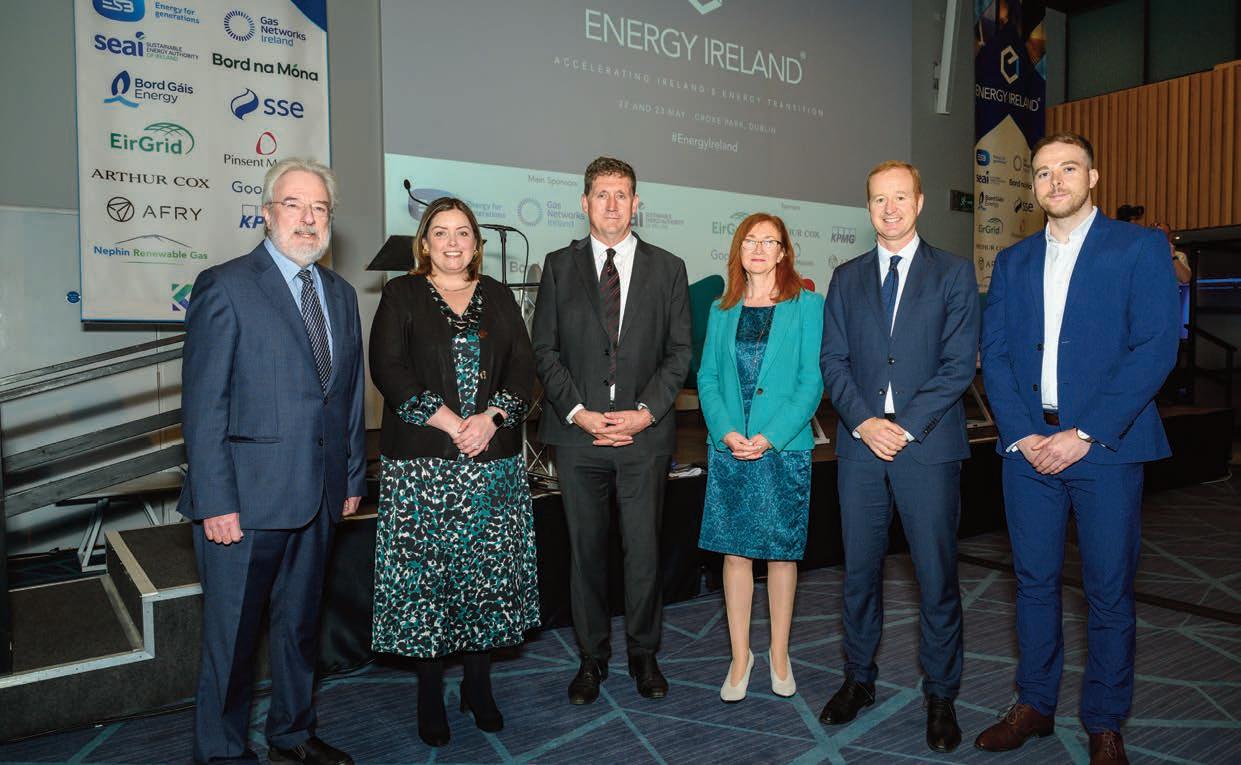
Energy Ireland 2024

Energy Ireland 2024 took place on 22-23 May at Croke Park, Dublin. Over 300 delegates attended the two day event which was opened with an address from both Minister Eamon Ryan TD and thenMinister Deirdre Hargey MLA. Delegates in attendance heard from over 40 speakers, both visiting and local, from organisations including the European Commission; the Department of the Environment, Climate and Communications; SEAI; ESB; ESRI; Commission for Regulation of Utilities; Bord Gáis Energy; Gas Networks Ireland; National Gas UK; and University of Oslo.

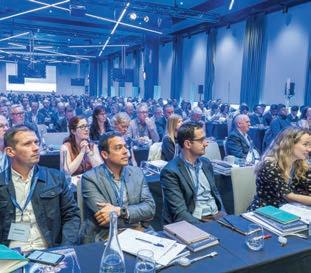
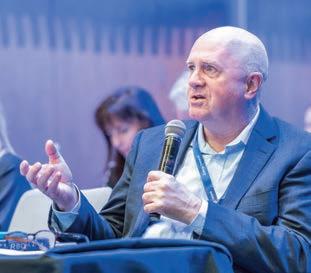

 (L-R): J Owen Lewis, IIEA Working Group on Climate and Energy; then-Minister Deirdre Hargey MLA; Minister Eamon Ryan TD; Aoife MacEvilly, CRU; William Walsh, SEAI and Ciarán Galway, eolas Magazine
Brian Ó Gallachóir, UCC addresses the crowd.
Dave Kirwan, Bord Gáis Energy; Nicola McSweeney, Gas Networks Ireland; Klair Neenan, SSE Airtricity; John Reilly, Bord na Móna and Marguerite Sayers, ESB.
Campbell Scott, Virgin Media Ireland; Catherine Lonergan, Bord Gáis Energy and Teresa Purtill, Bord Gáis Energy.
Energy Ireland 2024 crowd.
(L-R): J Owen Lewis, IIEA Working Group on Climate and Energy; then-Minister Deirdre Hargey MLA; Minister Eamon Ryan TD; Aoife MacEvilly, CRU; William Walsh, SEAI and Ciarán Galway, eolas Magazine
Brian Ó Gallachóir, UCC addresses the crowd.
Dave Kirwan, Bord Gáis Energy; Nicola McSweeney, Gas Networks Ireland; Klair Neenan, SSE Airtricity; John Reilly, Bord na Móna and Marguerite Sayers, ESB.
Campbell Scott, Virgin Media Ireland; Catherine Lonergan, Bord Gáis Energy and Teresa Purtill, Bord Gáis Energy.
Energy Ireland 2024 crowd.
158 conference report
Neil Walker, Walker Consulting asks a question.



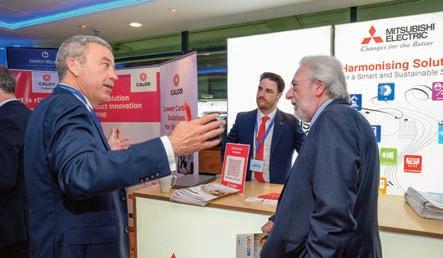
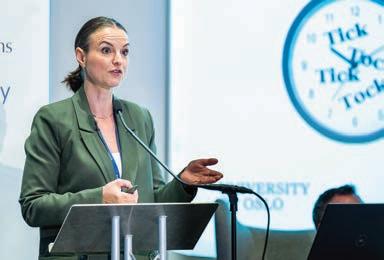

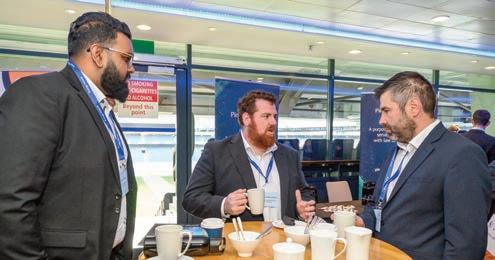

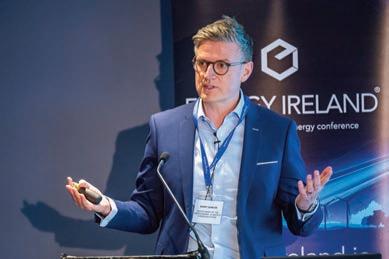
 Claire Madden, Bord Gáis Energy; Niamh McGovern, Arthur Cox and Karen Doyle, Gas Networks Ireland.
Jonathan Speers, Dalcour Maclaren asks a question.
Catherine Banet, University of Oslo addresses delegates.
Linda Clarke, Goodbody and Lucy McCauley, KPMG.
Delegates visit the Solarport exhibition stand.
Delegates visit the Mitsubishi Electric exhibition stand.
Daniel Grewan, Mace Consultancy Ireland; Daniel Pineda Ovalle, Mace Consultancy Ireland; and Patrick Liddy, Demand Response Association of Ireland.
Katie Petherbridge, National Gas UK and Harry Molloy, Tynagh Energy.
Calor exhibition stand.
Claire Madden, Bord Gáis Energy; Niamh McGovern, Arthur Cox and Karen Doyle, Gas Networks Ireland.
Jonathan Speers, Dalcour Maclaren asks a question.
Catherine Banet, University of Oslo addresses delegates.
Linda Clarke, Goodbody and Lucy McCauley, KPMG.
Delegates visit the Solarport exhibition stand.
Delegates visit the Mitsubishi Electric exhibition stand.
Daniel Grewan, Mace Consultancy Ireland; Daniel Pineda Ovalle, Mace Consultancy Ireland; and Patrick Liddy, Demand Response Association of Ireland.
Katie Petherbridge, National Gas UK and Harry Molloy, Tynagh Energy.
Calor exhibition stand.
159 conference report
Barry Quinlan, DECC addresses delegates.
public affairs eolas

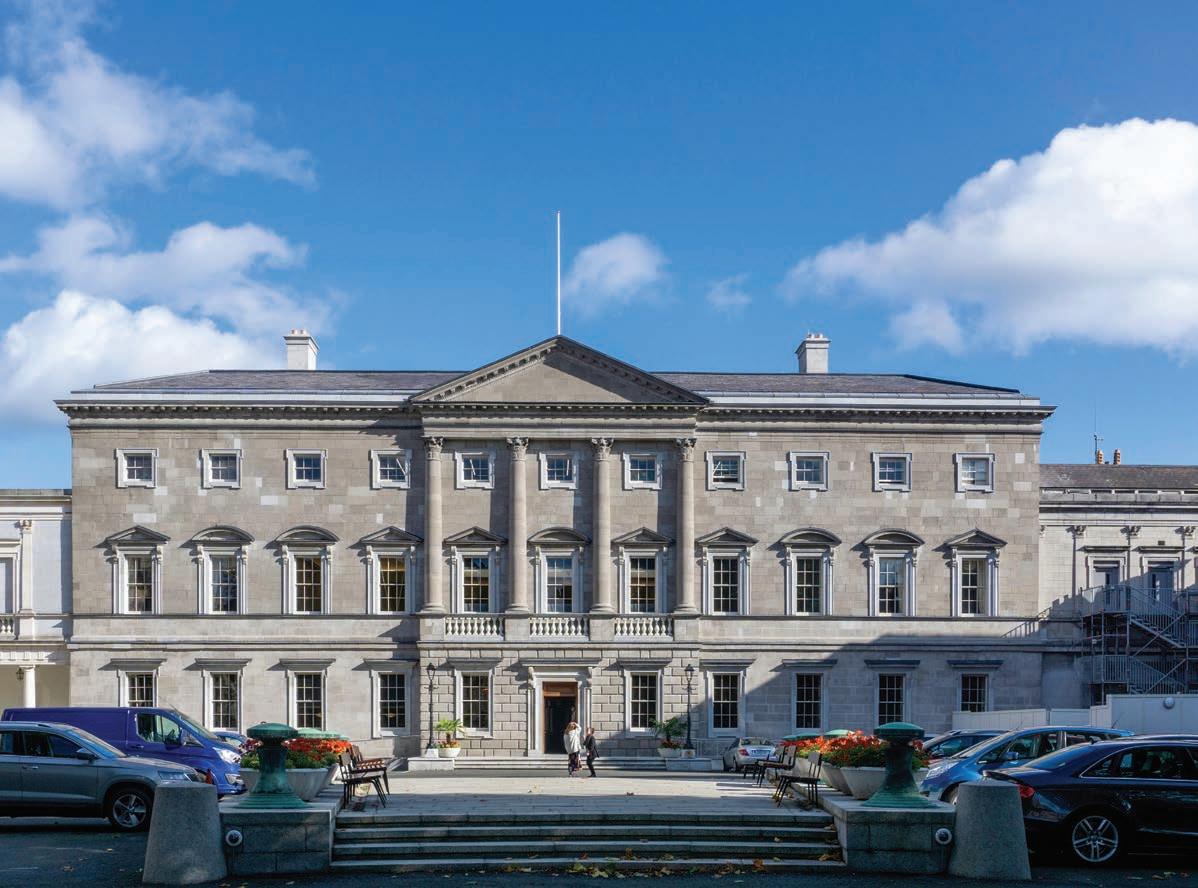
Safeguarding participation in public life
An Oireachtas task force has recommended that the Houses of the Oireachtas strengthens collaboration with law enforcement amid a rise in abuse against members and concerns about their safety.
The Task Force on Safe Participation in Political Life state that due to the health of democracy relying on equal and diverse representation, proposals within a report have been produced to “safeguard and support participation and promote civil discourse in political life”.
Published in May 2024, the report makes a suite of recommendations to tackle increased abuse aimed at those in involved in political life.
The report is produced in tandem with a UCD academic survey of Oireachtas members and staff published in February 2024, which found that there is a high prevalence of abuse against both – 94 per cent and 72 per cent respectively. The survey found that such abuse has a negative impact on Oireachtas members and political staff, who are reported as feeling anxious and afraid (89 per cent and 75 per cent respectively).
Within the report, the task force recognises that abuse in political life is increasing due to the “anonymity provided by digital platforms, and often driven by misogyny, sexism, racism, and intolerance”.
From this analysis, the task force recommends a “strategic and coordinated approach” to address this challenge. Specifically the task force recommends that the Houses of the Oireachtas leads in
160 eolas public affairs

“Reporting
public affairs eolas
should become the ‘norm’, with clear mechanisms established for this purpose and a ‘zerotolerance’ approach applied across the criminal justice system, political life, and civil society.”
Task Force on Safe Participation in Political Life
coordinating a sustained response, in partnership with relevant stakeholders, through the establishment of a Senior Officials Oversight and Implementation Group (SOIOG).
To safeguard those involved in political life, the report recommends that the Houses of the Oireachtas reviews and strengthens security arrangements and ensures mechanisms are put in place for enhanced cooperation and information sharing with An Garda Síochána (AGS). In this regard, a memorandum of understanding is scheduled to be agreed in November 2024.
The task force also recommends that the Houses of the Oireachtas produce an opt-in social media monitoring service in 2024 to monitor and report online threats and harassment for Members.
The report acknowledges that “members of the Houses of the Oireachtas have a responsibility to… facilitate robust but respectful debate through their interactions in Dáil and Seanad Éireann and wider political debate”.
Consequently, the existing codes of conduct for TDs and senators are recommended to be reviewed, commencing in autumn 2024.
Regarding the role of AGS, the report also highlights the need for a “structured and coordinated intelligence-led approach” in discharging its responsibilities, providing crime prevention advice, and responding appropriately to reported incidents.
The Houses of Oireachtas, in conjunction with AGS, aims to facilitate information sessions on workplace security measures, with the first session commencing in the Dáil in autumn 2024.
The report states: “Reporting should become the ‘norm’, with clear mechanisms established for this purpose and a ‘zero-tolerance’ approach applied across the criminal justice system, political life, and civil society.”
To implement this, a forum with representatives from social media companies, Coimisiún na Meán and AGS is tabled to meet in autumn 2024 on the collective response of online abuse.
A rising trend
Political violence has increased in recent years throughout Europe, with Germany’s Federal Police (BPOL) publishing a report which indicated that there were around 60,000 politically motivated crimes committed in 2023, with culprits predominantly emanating from the far-right.
Holger Münch, the president of the Federal Criminal Police Office stated: “Politically motivated criminality has almost doubled within the last 10 years and continues to increase,” and continued, “parts of the population are tending towards radicalisation. These tendencies include attempts to delegitimise the state and its monopoly on violence.”
A February 2024 publication by the European Parliamentary Research Service stated that 85 per cent of European female parliamentarians are subject to psychological violence, with 15 per cent subjected to physical violence.
Following publication of the report, the Ceann Comhairle of Dáil Éireann, Seán Ó Fearghaíl TD, stated: “Democracy must allow for debate, disagreement and different opinions however, when disagreement strays into abuse and intimidation, this stifles healthy debate and must be challenged.”
161 eolas public affairs
public affairs eolas


Local elections 2024: Government parties reassert themselves and Sinn Féin misses its opportunity

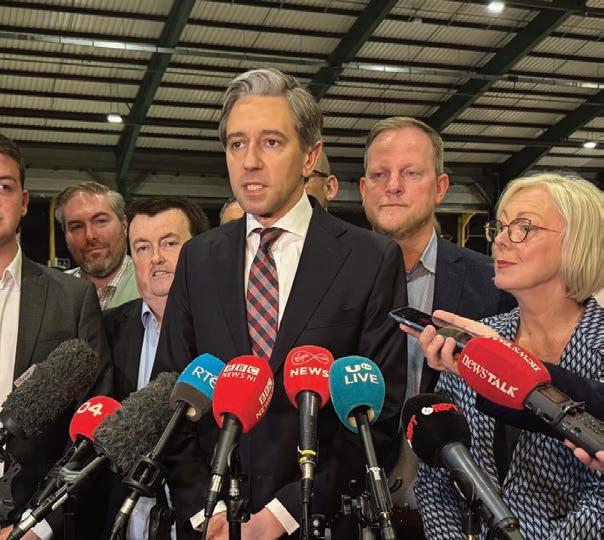

The 2024 local elections have presented the ultimate paradox: Although the government parties have all recorded declines in their share of first-preference votes and lost seats, and the main opposition party has gained votes and seats, the Government parties are the undoubted winners and Sinn Féin is the undoubted loser of this election. Joshua Murray reflects on the 2024 local election results.
At the time of print, Fine Gael is confirmed to have won the popular vote on 23 per cent, ahead of Fianna Fáil by less than 1,000 votes State-wide, while Fianna Fáil is likely to emerge as the largest party by seats won for the third consecutive local election. The local elections have been disappointing for Sinn Féin, strong for independents, and satisfactory for other Oireachtas parties.
While there has been no shift towards
support for the Government – with Fine Gael, Fianna Fáil and the Green Party generally either consolidating their existing seats and recording marginal losses – there has been a fragmentation in support for the opposition, with support expressed in opinion polls shifting away from Sinn Féin and predominantly towards independents and, albeit on a smaller scale, smaller parties.
Local elections differ from general elections in that there is a need for much more nuance in political strategy than in general elections, and this partially explains why Fine Gael and Fianna Fáil, the parties with established networks, members, and a history of victory, have managed to navigate the complicated course of council elections so successfully. It is a dynamic often defines by personality over party.
162 eolas public affairs


This has been an election where apathy has arguably been the true winner, with a total turnout of 49.3 per cent recorded at the time of writing, among the lowest ever in the history of local elections in the State. While people who voted for government parties will be generally satisfied in policies being rolled out by the coalition parties (albeit without those parties attracting any new support), the opposition has not been able cohesively to motivate those disaffected or unaligned voters.
Interesting is that the differentiation in turnout in the 2020 general election (62.9 per cent) and the local elections – a gap of 13.6 per cent – mirrors closely with the level of Sinn Féin’s underperformance in the local elections compared with opinion polling (the party had been polling on average at 25 per cent prior to voting).
Essentially, it is possible that many who voted for Sinn Féin in 2020 stayed at home in 2024, while most of those who voted for Fine Gael, Fianna Fáil, and the Green Party came out to vote for them again.
The Government parties have interpreted
the results as a vote in confidence, with Taoiseach Simon Harris TD asserting that “the Irish people do not believe they live in a failed state… The Irish people do not believe in all of the negativity and the ‘rah rah rah’ but [what] the Irish people want is pragmatic delivery”.
Although Fine Gael has positioned itself strongly in these elections under its new leader, the Taoiseach says he is no rush to take his party’s success to back to the people before the end of the Government’s term in March 2025.
“The Irish people do want change. They want credible change. That is the sort of change I am offering with Fine Gael and our coalition colleagues.
“[The public] want me to bring energy not just to the campaign trail, but to also solving some issues, including ones that have seemed intractable in the past, and that’s my absolute determination.”
Fine Gael also emerged as the largest party in Dublin City Council for the first time ever, giving the new Taoiseach a further confidence boost. However, by vote share, Fine Gael has in fact recorded

its lowest vote share in a local election since 1991.
Tánaiste and Fianna Fáil leader was keen to play up the election as being about the “Sinn Féin collapse”, a characterisation which is not technically true as Sinn Féin has not ‘collapsed’, but underperformed.
For the Fianna Fáil leader, the election was a case of consolidation and, at the time of print, the party stands a chance of a poll-topping local election for the third consecutive time. Fianna Fáil’s 22.9 per cent is hardly a vintage performance for the once-dominant party, but Martin currently stands as the most popular political leader in the State and he was satisfied that the party’s performance was “better than expected”, in spite of this technically being Fianna Fáil’s worst ever local election results by popular vote.
Martin was keen to emphasise that “local election results do not correlate with general election results”, and effectively unveiled the plans for the remainder of this government’s term, stating that he wants to see “an effective budget”,
4 public affairs eolas 163 eolas public affairs
Taoiseach Simon Harris TD celebrates with Fine Gael’s Louise Fenelon Gaskin, who was elected in Greystones, County Wicklow.
public affairs eolas
Local elections 2024
*Figures at the time of print, 11 June 2024.
mirroring comments by his coalition counterpart Simon Harris that the Government will see out its term until March 2025.
Minister for Housing Darragh O'Brien said Fianna Fáil was “satisfied” with the party’s performance and that government parties had done “much better than predicted”.
Fianna Fáil has largely held out in rural Ireland, but this success has been mirrored with flickers of disappointment with the party coming in fifth place in Dublin City Council, a chamber where it was the largest party prior to polling.
Nevertheless, Martin has once again defied the odds to deliver a better-thanexpected result for Fianna Fáil, and he will be hopeful that with some new faces emerging (including a new generation of the Haughey family) from these local elections, that Fianna Fáil will be able to springboard some of them into the Dáil when the people vote in the next 10 months.
Sinn Féin underperformance
Undoubtedly the most dominant theme is Sinn Féin’s massive underperformance and misjudgement in this election. The
joint-largest party in the Dáil, Sinn Féin had hoped to more than double its seats in local government but has remained a disappointing third place (fourth if you include independents) and polled around half of both Fine Gael and Fianna Fáil, and less than one-quarter of the combined total of the Civil War parties.
Sinn Féin president Mary Lou McDonald TD went to great pains to stress that her party would run enough candidates to emerge as the largest party in local government, however, although the party has made modest gains on its 2019 results (19 more seats at the time of print), these results are disastrous for a party which is aiming to lead government in the next year.
The party is set to win around 12 per cent of the popular vote, meaning it has barely improved on its results from 2019 (9.48 per cent) – an election which was perceived as disastrous for Sinn Féin –and stands significantly below its 2014 results (15.2 per cent) when the party was led by Gerry Adams.
In Dublin City Council, where the party was aiming to become the largest party (a feat it achieved in 2014), Sinn Féin made only one gain and came third, behind Fianna Fáil and the Social Democrats.


McDonald has ruled out resigning as leader of Sinn Féin, and has stated that the party will “regroup” and “reflect”, acknowledging that while “we have made modest gains”, that “we haven’t had the sort of day we had hoped for”.
While McDonald helped sweep Sinn Féin to a shock poll-topping performance in the 2020 general election, and the party continues to perform strongly in the North, Sinn Féin has now – in two local elections and two European elections –significantly underperformed. However, it is worth remembering that in 2019, McDonald’s leadership was also under question after the last local election results. Sinn Féin followed this up with a general election victory (by popular vote) only nine months later.
Unlike the other main parties, Sinn Féin has the immediate task of refocusing its energy for the Westminster general election in the North on 4 July 2024. After this however, the party has a similar timescale – with a general election by March 2025 at the latest – to turn back the tide, and arguably McDonald’s future leadership of the party will depend on a rebound in support for the next general election.
Opposition realignment
The story of swings in this election has been a potential realignment within
164 eolas public affairs
Party Seats won Vote share (first preference) % Vote swing (first preference) % +/Fine Gael 242 23 -2.3 Fianna Fáil 244 22.9 -4 Sinn Féin 100 11.8 2.3 Green Party 23 3.6 -2 Social Democrats 35 3.5 1.3 Labour Party 56 5.3 -0.4 PBP-Solidarity 13 1.5 -0.4 Independent Ireland 23 2.8 New party Independents and others 201 18.3



opposition, with the swing away from the government parties falling into the hands of independents and smaller swings to the Social Democrats and Independent Ireland.
Independents have been the victors outside of the Government parties, with independents (along with minor parties) willing over 28 per cent of the vote, a figure which, if replicated in a general election, would undoubtedly result in them having an important role in government affairs, a phenomenon which has manifested in the current Dáil with a number of independents voting for the Government in confidence motions.
The ideology of these independents elected varies significantly, with one farright activist elected in Dublin, while in the southwest three members of the Healy-Rae family were elected to Kerry County Council as localist candidates.
The Green Party has lost a considerable amount of its popular vote, and is down on its 49 seats won in 2019, but according to Ciarán Cuffe, who himself is hoping to retain his MEP seat for Dublin, the Green Party “did not get the kicking” that was predicted.
Under the radar has been the rise of the Social Democrats, who have almost doubled their 19 councillors won in 2019, and are an undoubted presence in Irish politics. The Social Democrats even emerged in second place in Dublin City Council, ahead of both Sinn Féin and Fianna Fáil. Their performance is so profound that former Labour Party leader Pat Rabbitte has called for a merger between the two parties, a move which has been repeatedly ruled out by Social Democrats’ leader Holly Cairns TD.
23 members of Independent Ireland, a new right-wing party led by three TDs elected as independents have been elected to councils, a significant achievement in what was the party’s first election.
Elsewhere, the Labour Party and People Before Profit-Solidarity recorded some gains, particularly around Dublin, and both will be satisfied with their results in what was broadly a difficult election for the left.
Despite polling showing that immigration was to come to the fore as a political topic, and with significant number of candidates on the far-right running, only
two candidates for far-right parties won any seats, and while independents –including many who are socially conservative – have been elected, a minimal number of these were elected on a far-right or anti-immigrant ticket.
General election to come
If these results were to remanifest, both in terms of respective vote share and turnout, in a general election, than the three party leaders would be almost certain of reassuming their roles in government beyond March 2025.
However, the general election will bring housing back to the fore as a topic of discussion in a manner not possible in a local election, and turnout will also be significantly higher, meaning that although this has been an encouraging election for the Government, there remains a lot of uncertainty as to whether the ‘grand coalition’ will maintain its presence in Government Buildings.
This issue of eolas Magazine went to print on 11 June 2024.
public affairs eolas 165 eolas public affairs
Sinn Féin president Mary Lou McDonald TD said that the party will “regroup” after its disappointing results.

 Credit: Ron Mader
Credit: Ron Mader
Recent reports on the public finances of a united Ireland have estimated the transitional cost in a range from €400 billion to €25 billion over the first two decades of the new state coming into existence.
In evidence presented to the Oireachtas Joint Committee on the Implementation of the Good Friday Agreement, I set out why the recent Institute of International and European Affairs (IIEA) report which stated that the initial costs of a united Ireland would be €20 billion per annum over 20 years is wildly inaccurate, as the report contains significant errors and is based on entirely unreasonable assumptions.
The IIEA report is not a worst-case scenario; it is just wrong. There is
The fiscal position in the early years of a united Ireland
While the northern economy is weak relative to the Republic, the cost of unity will be contingent on the speed of convergence with the Republic, writes John Doyle, professor in the School of Law and Government and Vice President of Research, Dublin City University.
insufficient room here to look at every element, but a few key highlights, indicate a very different outcome is much more likely.
The IIEA report adds over €4.2 billion per annum to the cost of unity, by increasing public sector wages to the levels in the Republic but makes no allowance for the taxes (which would be overwhelmingly at the higher rate of 40 per cent), PRSI (4 per cent) and pension contributions (typically around 10 per cent) to be paid on that increase.
Correcting this error reduces the real cost of salary increases by €2.2 billion per annum. There are similar difficulties with the IIEA’s welfare and pension estimates, and it makes no allowance for those increases being paid over some agreed
period of time, as the costs of living also converge.
The IIEA report uncritically uses the published UK Government subvention figure of over £12 billion as the starting point for the fiscal balance of a united Ireland, half of which relates to debt and pensions. While the UK Government could legally cancel pensions, the question is whether it would be politically expedient to do so. No such threat was made for example during the Brexit negotiations, as regards UK officials who had worked for EU institutions, in fact a new post-Brexit agreement was signed with Ireland to maintain the cooperation on pensions and ability to move in either direction without loss of pension, which see thousands of Irish people receive UK
public affairs eolas 166 eolas public affairs

pensions based on years of contributions in the UK.
The IIEA even assumes that if the UK Government abandoned such pensioners, including to military and police veterans, health workers and others, that the Irish Government would then volunteer to pay £2 billion per annum for UK state debt, for which it has no legal liability whatsoever.
There are also technical ways in which the UK allocates central UK expenditure outside of Northern Ireland to its various regions, or allocates taxes, which would reduce the transferred subvention very significantly. In the full report submitted to the Oireachtas Committee, a detailed analysis of the existing subvention shows that the opening deficit for Northern Ireland in a united Ireland, before any new policy decisions, would be just €1.5 billion, taking account of issues such as debt, pensions, defence, and tax changes.
Finally, the IIEA report excludes any analysis of economic growth during the 20 years after unity. It assumes that with the same political system, back inside the EU, and similar policy frameworks, education system and tax regime, that Northern Ireland would not economically converge with the Republic. This is a very unlikely outcome.
Why would Belfast continue to perform so much worse than counties Cork and Kerry with the same EU access, policies, education, and tax system? As a larger city, Belfast should do better and take pressure off the Dublin region. Likewise, Derry and the wider northwest should see economic benefits, with new investment and without the impact of the border.
The economy in Northern Ireland is weak. Wages are much lower than the Republic, educational outcomes are poorer, and waiting lists in the health system are much
worse. Significant additional investment is therefore needed. However, it needs to be gradual to avoid creating massive inflationary pressures.
Allowing for an increase in public expenditure in Northern Ireland, of €1 billion in year one, to increase salaries and pensions, invest in education, and improve public services, would require Ireland to borrow three-quarters of 1 per cent of GNI* to cover that combined €2.5 billion per annum deficit – a readily affordable figure.
That investment into Northern Ireland would increase each year for some time as salaries increase, as the economy could absorb it and as the cost of pensions, for example, gradually transferred to Ireland, but it would also be gradually re-couped in tax revenues, as the northern economy begins to grow and to reflect the living standards and wage levels in the Republic.
The ongoing cost of unity will be determined by the rate of economic growth in Northern Ireland, and the speed of convergence with the Republic. In the last 20 years, the central European states joining the EU all experienced growth rates of between 1 per cent and 3 per cent per annum above EU averages, allowing for clear convergence in living standards with the western states.
If the currently weak Northern Ireland economy began to converge with the Republic, with growth of 2 per cent per annum above its post Good Friday Agreement experience inside the UK, this would cover the costs of transition –including increasing public sector salaries, state pensions, and welfare payments –and end the fiscal deficit in approximately 10 years, after which the North would run a surplus.
“The ongoing cost of unity will be determined by the rate of economic growth in Northern Ireland, and the speed of convergence with the Republic.”
 John Doyle, Vice President of Research, Dublin City University
John Doyle, Vice President of Research, Dublin City University
public affairs eolas 167 eolas public affairs
public affairs eolas


From college dropout to Taoiseach: Simon Harris TD
Rapidly moving to secure his position as Fine Gael leader, and consequently Taoiseach, Simon Harris TD now seeks to reinvigorate his party with a ‘new energy’ ahead of the coming general election. Ciarán Galway tracks the rise of the most powerful man on the island.
Having joined Young Fine Gael at 16, Simon Harris later dropped out of DIT in the first year of his journalism and French degree to pursue a career in politics. In fact, his first ever job was working as a parliamentary assistant for former Tánaiste Frances Fitzgerald – regarded as an early mentor – who was then opposition leader in the Seanad.
In his first foray, Harris attracted the greatest percentage of first preference votes of any local election candidate in the State when he was elected to Wicklow County Council in 2009. Two years later, he was elected to the 31st Dáil to represent Wicklow at the age of 24, achieving 8,726 first preference votes
or 12.4 per cent of the total.
In the following two general elections, in 2016 and 2020, he would attain 15.7 per cent and 12.3 per cent of first preference votes respectively.
As ‘baby of the Dáil’, Harris was selected, as was tradition within Fine Gael, by the party to nominate Enda Kenny for Taoiseach and utilised his maiden speech in the Dáil on 9 March 2011 to do so. “It is a great honour, as the youngest member of the 31st Dáil, to rise formally today to nominate Deputy Enda Kenny as the next Taoiseach of this country,” he said, adding: “Deputy Kenny will bring to the office of the Taoiseach integrity, honesty and a work rate which simply
cannot be surpassed.” Thirteen years later, Harris would be elected Taoiseach himself.
First tenure as Health Minister
Having previously been appointed as Minister of State at the Department of Finance with responsibility for the Office of Public Works, Public Procurement, and International Banking in 2014, Enda Kenny then selected Harris as Minister for Health in May 2016. At just 29 years old, he is still the youngest person to have held that office.
Succeeding Leo Varadkar – a qualified doctor – in the portfolio, it was a decision


168 eolas public affairs

which blindsided almost everyone. He had not been involved in the drafting of his party’s health policies or the health component of its programme for government.
From the outset, Harris was regarded as an archetypal ‘blueshirt’, something which was not always assumed of Leo Varadkar. Similarly, a devoted follower of party dogma, he has studiously avoided the sort of off-piste remarks which typified his nonconformist predecessor.
Writing in 2016, erstwhile Fine Gael TD and government minister, now broadcaster, Ivan Yeats argued: “The appointment of Simon Harris to the searingly hot seat of Health Minister has all the appearances of a serious political mistake.”
For decades, the Department of Health has been regarded as a particularly treacherous portfolio. “What does this 29-year-old raw recruit, with a journalism degree [sic], know about the complexities of acute hospital care or tertiary medicine? What skills or experience has he to draw on to deal with a myriad of vested interests, protecting administrative empires and massive budgets?” Yates asked.
However, his performances as a member of the Public Accounts Committee and Minister of State in the Department of Finance distinguished him. Yeats described him as “Fine Gael’s shooting star” and suggested that his performance as a running mate for Deirdre Clune during the 2014 European elections (which saw Harris fail to get elected) “marked him out from other backbenchers”.
During a Committee of Public Accounts special debate on vote management in the HSE – which Ambrose McLoughlin, then-Secretary General, Department of Health and Tony O’Brien, then-Deputy Chief Executive Officer, HSE were called to – in October 2012, a 25-year old Harris remarked: “While the meeting got off to a rocky start on both sides, I believe we need to – I do not think there is a parliamentary word for it – chillax... If the witnesses want to come in here and stonewall, that will not work. If people here want to grandstand, that is not serving the interests of the taxpayer either.”
public affairs eolas

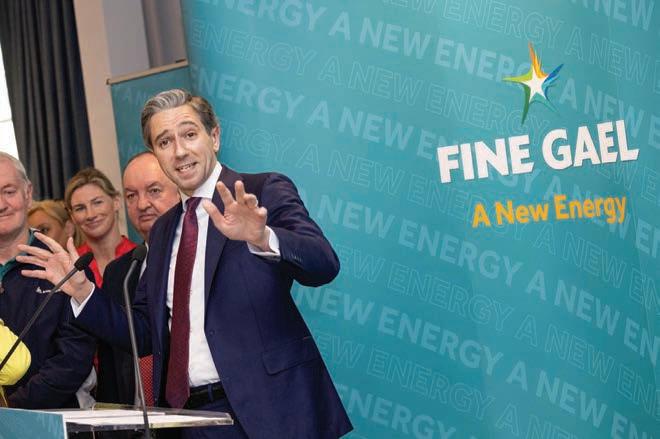
Similarly, in one typical insight into his party’s self-cultivated image of prudence, responding to eolas Magazine in late 2018, then-Health Minister asserted that “the days of blank cheques are over” for the HSE.
2017 leadership contest
During the previous Fine Gael leadership election, in May 2017, Simon Harris endorsed Simon Coveney TD in his contest with Leo Varadkar – one of just 10 Fine Gael TDs and the only cabinet member to do so. Despite this, after his triumph over Coveney, Varadkar reappointed Harris as Minister for Health in his cabinet – allegedly at the petitions of Coveney.
Second tenure as Health Minister
Incredibly, given his 2011 opposition to abortion, he emerged as a leading political advocate in the Yes campaign to repeal the Eighth Amendment, his pivot earning several media plaudits and effectively eclipsing his leader. Accruing significant political capital temporarily –and only just – shielded him from several other crises across his remit.
2019 was a turbulent time for the minority Fine Gael government. In December, Harris’ former cabinet colleague, the then-Housing Minister, Eoghan Murphy, narrowly survived a Social Democrats motion of no confidence by 56 votes to 53, with 35 (mostly Fianna Fáil)
abstentions/absences. Harris himself had already weathered a Sinn Féin-tabled motion of no confidence the previous January (58 to 53, with 40 abstentions/absences) in relation to National Children’s Hospital budgetary overruns.
Then in early 2020, planning to utilise the Rural Independents group’s Dáil speaking time, then-independent TD for Cork South-West, Michael Collins, proposed to move a motion of no confidence in the then-Minister for Health, Simon Harris, by 5 February.
Speaking on RTÉ’s Morning Ireland, Collins suggested that there was an “unprecedented crisis” in healthcare and argued that “someone must be held accountable”.
Five days later, on 14 January, thenTaoiseach Leo Varadkar visited Áras an Uachtaráin and signed a request that President Michael D Higgins dissolve the 32nd Dáil. The proclamation of dissolution was duly signed, and a general election date was set for 8 February.
In the context of the Fine Gael government’s confidence and supply arrangement with Fianna Fáil – whereby the opposition party agreed to abstain in key votes – it was no longer certain that the Government commanded the minimum number of votes (56) to win.
General election
While Varadkar regarded summer 2020
169 eolas public affairs 4
public affairs eolas
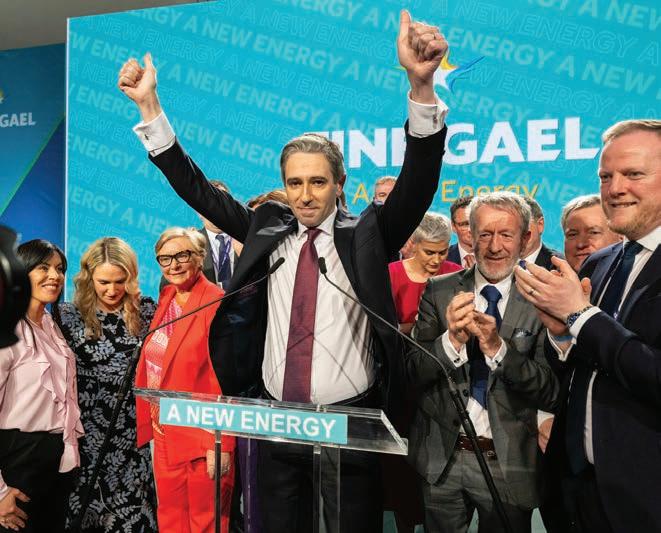
as “the right time” for a general election, he was forced to “acknowledge that circumstances had changed”. Speaking on RTÉ Radio 1’s This Week in advance of the dissolution, he said: “The arithmetic in Dáil has changed and that is the reality of that. So I have made a decision.”
In that moment, it appeared as though the health portfolio minefield had finally shredded the wily Harris, who had made several policy delivery commitments which did not transpire in his tenure –not least the delivery of the national children’s hospital.
Instead, health policy escaped the intense scrutiny which might have been forecast ahead of General Election 2020, obscured by cross-party consensus on Sláintecare (the plaudits of which belong to the Oireachtas Committee on the Future of Healthcare led by the Social Democrats’ Róisín Shortall TD) and with the housing crisis taking centre stage.
Covid pandemic and caretaker minister
Incredibly, while performing disastrously and winning only 35 seats – its lowest share of the popular vote since the 1948 election – compared to 50 in 2016, both Harris and the caretaker Fine Gael Government had a Lazarus-like revival, with the popularity of each (initially alongside then-Taoiseach Varadkar) soaring during the early months of the Covid pandemic.


The onset of Covid and subsequent participation in the triparty coalition masked the fact that Fine Gael had been beaten back into third place by Sinn Féin (which missed out on becoming the largest party by one seat) and spared Varadkar’s leadership.
Harris himself so successfully cleansed his image during the early months of the Covid pandemic – in the time between the general election in early February 2020 and the formation of government in late June 2020 – that the role of his underperformance in provoking the dissolution of the Dáil was effectively obliterated from popular memory.
Social media
Throughout his time as caretaker minister, Harris meticulously utilised social media platforms (acquiring an impressive 100,000 followers on Twitter by December 2020) to promote government and HSE public health messaging. Infamously, the black mirror of immaculate messaging cracked when he incorrectly advised: “Remember this is coronavirus Covid-19 – that means there have been 18 other coronaviruses.”
Prior to government formation in June 2020, eolas Magazine recorded: “Having [barely] navigated the CervicalCheck scandal, championed the successful repeal of the Eighth Amendment, and
weathered the worsening health crisis more generally, he now spearheads the response to Covid-19.
“In doing so, Harris appears to have successfully manoeuvred from a near untenable position to career-defining performance as [caretaker] Minister for Health.”
Perhaps the source of his exceptional media savvy, Harris has been accompanied by his media advisor and now his chief of staff, Sarah Bardon – a former Irish Times political journalist –since August 2018.
Meanwhile, recent additions to his inner circle include government press secretary Chris Donoghue – a former Newstalk reporter who most recently served as ministerial advisor to Simon Coveney from 2017 until 2024 – and deputy government press secretary, Ciara Phelan, a former journalist with the Irish Examiner
On social media, Harris has 240,000 followers on X, 191,000 on Instagram, and 100,000 on TikTok. In comparison, Tánaiste and Fianna Fáil president, Micheál Martin TD, has 196,000, 49,000, and 19,000 followers across the same platforms.
Life after health
Following the triparty government’s formation, Harris moved into a newly created portfolio at the Department of Further and Higher Education, Research, Innovation and Science where he sought to advance education, skills, and lifelong learning as “the most robust, transformative and lasting means to future-proof our country’s economic and social wellbeing”.
For a seven-month stint from December 2022 to June 2023, he served as Justice Minister in place of his long-time rival, Helen McEntee TD during her maternity leave. A competent performance enhanced his public persona and was in stark contrast to McEntee’s perceived handling of the portfolio.
Leadership
Unlike in 2017, the 2024 Fine Gael leadership contest was a one-horse race. Upon Varadkar’s shock retirement on 20 March 2024, only Harris was ready, and he burst out of the traps. In a
170 eolas public affairs


masterful shock and awe blitz, he surpassed even Varadkar’s pre-emptive strike in 2017, rapidly accumulating the public endorsement of most of the Fine Gael parliamentary party within 24 hours of announcing his candidacy on 21 March.
Party titans, Simon Coveney and Paschal Donohoe, as well as prospective candidates Helen McEntee and Heather Humphreys, all ‘graciously’ excluded themselves. By the nomination deadline on 24 March, Harris was the only candidate, and he was confirmed as leader at a party meeting in Athlone, County Westmeath
Party trajectory
Perhaps given the short lifespan of the current government, some prospective leaders decided that it was not the most politically opportune moment to lead the party.
Fine Gael’s recent electoral performances in general elections have not been good. It has retreated from 76 seats in 2011, to 50 in 2016, to 35 in 2020. In terms of total first preference votes this is a dramatic decline from 36 per cent, to 26 per cent, and then to 21 per cent.
However, his reality combined with zero cabinet experience, did not perturb ‘also ran’ Jennifer Carroll MacNeill TD who subsequently found herself once again excluded from a seat at the top table despite her obvious ambitions, allied to a blistering performance as MC of the party ard fheis on the weekend before Harris was elected Taoiseach.
Energy
In his own address at the Fine Gael ard fheis, his first as leader – replete with obligatory Seamus Heaney quote –Harris asserted that it was “the honour of my life to lead this great party”. In keeping with the conference theme – ‘a new energy’ – he insisted that he would “bring energy and renewal to this party”. It was hard to avoid the implication that Fine Gael itself is cognisant that it had either run out of energy or was in possession of the ‘wrong’ energy under the previous leadership.
Speaking to delegates after the conclusion of Harris’ speech, there was
widespread and genuine enthusiasm for the new leader. One Fine Gael veteran told eolas Magazine: “He is the finest man to take the stage for us since Garrett FitzGerald.”
Once the Dáil reconvened after its Easter recess, Simon Harris was nominated by deputy leader, Heather Humphreys TD, and elected Taoiseach on 9 April 2024, winning by 88 Tá to 69 Níl. In replacing Leo Varadkar TD as leader of Fine Gael and Taoiseach, Harris also unseated his predecessor as the youngest ever Taoiseach in the history of the State.
“My message is simple: I want to work every day to improve the lives of all in this country,” he declared.
The following day, his absence –ostensibly to conduct phone calls with national leaders – from Leader’s Questions in the Dáil was widely criticised by the opposition. “In his first day on the job he is a no show. He is as láthair,” Sinn Féin President Mary Lou McDonald TD observed.
Reshuffle
Meanwhile, the much-anticipated shuffle of Fine Gael’s cabinet seats failed to exemplify the much promised ‘new energy’, though there were several changes among the junior ministers. Most surprisingly, as she had hinted from the ard fheis stage, McEntee remained in situ as Justice Minister allegedly at the behest of Frances Fitzgerald.
Both in their late 30s, Harris opted to keep his rival close, expending significant political capital among party and coalition colleagues on her reappointment; a decision which belied the Minister’s performance to date.
Policy platform
Demonstrating a archetypal belief in the neoliberal interpretation of equality of opportunity, Harris utilised a speech at the 101st commemoration of Michael Collins and Arthur Griffith at Glasnevin Cemetery in 2023 to most clearly delineate his ideology.
There he advocated for a new social contract which “recognises the need to create true equality of opportunity – that no matter who you are, where you live or what your parents did before you, you can reach your full potential”.
Faced with the challenge of reestablishing Fine Gael in the European centre-right Christian democrat mould and redressing the party base – the fiscally conservative middle classes. To date, his stated policy priorities exhibit classic Fine Gael tendencies.
Polls and local elections
Having assumed the reins of power with around 11 months until a general election must be held in March 2025, Fine Gael’s performance in the June 2024 local and European elections was keenly observed.
While Fine Gael achieved its worst percentage share of first preference votes in a local election since 1993, paradoxically, it is also the first time that the party has topped the poll by popular vote in a local election since 2009.
Despite his protestations to the contrary – “to anybody who thinks this party is tired, to anyone who thinks this party lacks energy, you ain’t seen nothing yet” – after 13 years in power, Fine Gael had, until now, appeared to be running out of political dynamism.
To date, 11 of the party’s sitting TDs have confirmed that they will not contest the next general election. For party veterans and those with ambitions outside of parliamentary politics, the prospect of potentially languishing on the opposition benches for five years is too unpalatable.
With a hung Dáil all but inevitable, government formation could take several months. However, even if he lingers on as caretaker Taoiseach in the interim, Harris could still potentially hold the record for the shortest cumulative time served as Taoiseach, at least for the foreseeable future.
Having said that, aggregated opinion polling published by Ireland Votes suggests that Fine Gael is projected to achieve around 20 per cent of the vote in the coming general election, and seat projections based on those figures indicate that the party could stand to gain several seats compared with 2020. Harris’ mettle is set to be seriously tested, quite possibly as soon as autumn 2024.
public affairs eolas 171 eolas public affairs
public affairs eolas


The Troubles(ome) history of British policy in Northern Ireland
As an academic historian, I have serious reservations about the socalled ‘public history’ of British policy in Northern Ireland announced recently by the British Government, writes Marie Coleman, Professor of 20th century Irish history at Queen’s University Belfast.
An Expert Advisory Group (EAG) has been appointed to oversee the process and hire five historians to write this history. The absence of leading scholars of ‘the Troubles’ from the EAG is notable. None of the authors of recent books on subjects including negotiations to end the conflict, government censorship of media coverage, and the role of the British army, are on the EAG. If they were not invited it begs the question ‘why not’? If they were asked and turned it down that is a significant vote of no confidence in the project.
There are no academics currently working in Northern Irish universities, nor any from a northern Catholic and/or nationalist background, on the EAG. If the experts so far have refused to take part how much success will the EAG have in recruiting
suitably qualified candidates to fill five posts?
Ethics
A glaring error of omission in the published Terms of Reference of the EAG is any reference to ethics. To comply with standard norms of ethics and integrity in research, academics are expected to “keep clear accurate records to allow for verification”. This project will have “the opportunity to access otherwise closed materials which may never be released”. In such circumstances, how can any of the work be verified if nobody else ever sees the documents again?
Ethical approval would also be required if any oral history element is involved, which
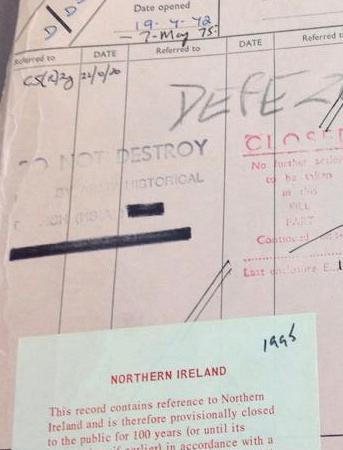
would be an expected methodology in such a contemporary subject. The controversial ‘Boston College tapes’ project is a spectre that haunts research into ‘the Troubles’ and is now widely used by those of us who teach ethics to university students as an example of how not to conduct research.
‘Public history’
The project calls itself a ‘public history’, but it is no such thing. ‘Public history’ is a recognised subdiscipline of academic history, defined by the United States’ National Council on Public History as ‘the many and diverse ways in which history is put to work in the world. In this sense, it is history that is applied to real-world issues’.
172 eolas public affairs



“The EAG and the Northern Ireland Office are at pains to point out that this project is not part of the Legacy Act... It is undeniably part of the legacy process.”
Marie Coleman,
School
of
History, Anthropology, Philosophy and Politics, QUB
For this project to qualify as a ‘public history’ one, it would need to embed a public history element, such as close collaboration from the outset with an institution like a museum, in its core methodology. Plans to engage ‘with media outlets, community groups, and the wider cultural sector to promote public awareness and understanding of the period of the Northern Ireland conflict’ does not qualify this project to call itself ‘public history’.
‘Official history’
If this is not a ‘public history’ what is it? It is an ‘official history’, part of a long-standing British government series dating back to 1908. The EAG has asserted its independence and intention to reject any efforts of government control. Yet, there are ways in which governments exert control over official histories about which the group can do little.
The publication of Michael Howard’s official history of strategic deception in intelligence operations during the Second World War was held up on security grounds by Margaret Thatcher and could not be published until after her resignation as Prime Minister. If the Northern Ireland project were to encounter a similar obstacle a scholar could be left with no published work after five years of research, with seriously adverse effects on career advancement.
Governments can also control the narrative through restrictions on the time period studied. Keith Jeffery’s official history of MI6 concluded in 1949 because the head of MI6 considered the Cold War too sensitive to cover. Conveniently, this avoided any serious discussion of the defection of the Cambridge spies. It is notable that the Terms of Reference of the EAG
refer only to studying British policy ‘during the conflict in Northern Ireland’, with no definition, chronological or otherwise, of what that means.
Legacy Act
The EAG and the Northern Ireland Office are at pains to point out that this project is not part of the Legacy Act. Yet during the debate on the bill in the House of Lords in May 2023, Dean Godson (Lord Godson) sought to have it included, a move supported by Paul Bew (Lord Bew), current co-chair of the EAG. The project was announced publicly in the same week that the Legacy Act came into force. It is undeniably part of the legacy process.
Many academics are dubious of the EAG’s confidence about being given “full and unfettered access to all materials”. Even if this is given, the Legacy Act’s denial of the same access to the families of victims is deeply problematic and in the view of some scholars at least, unethical.
The British Labour Party is likely to repeal significant sections of the Legacy Act and the current government is trying to have much of its infrastructure in place to make that task difficult. It is hard to escape the sense that this project has been rushed through hurriedly to get it set up in time. Little else could account for how poorly thought-out its provisions are.
If it is to continue, action is required immediately to clarify its title, delineate its chronological coverage, and produce a robust ethical framework. Then it will be matter of individual choice for scholars whether the lure of privileged access to archives outweighs qualms about the concurrent denial of that access to the families of ‘Troubles’ victims.
public affairs eolas 173 eolas public affairs

TRADE UNION DESK
Crafts: The bloodline of the economy
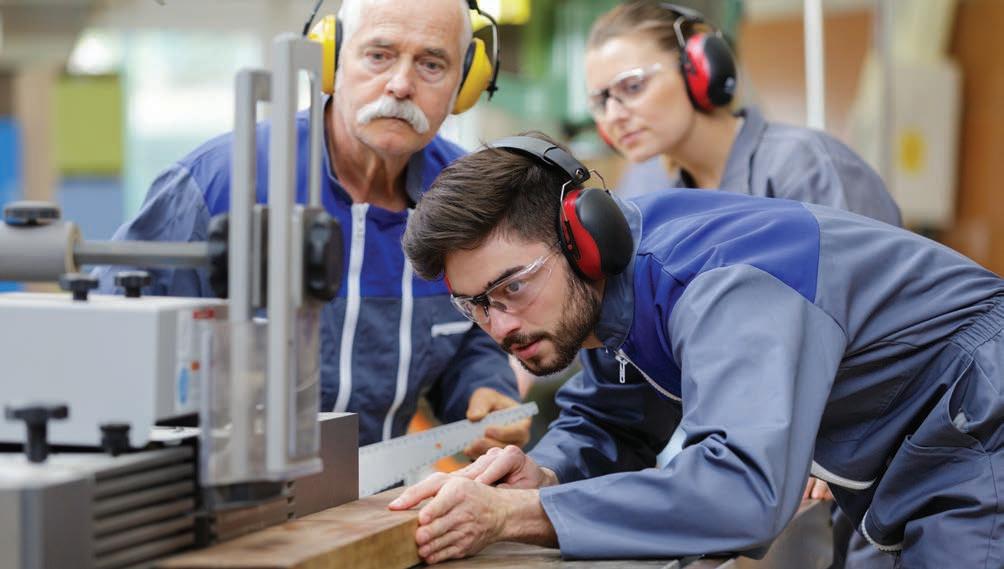
Connect’s new National Craft Apprentices Survey is a first of its kind in that it is driven by apprentices, writes Brian Nolan, Assistant General Secretary of Connect Trade Union.
Connect Trade Union is Ireland’s largest craft union. The craft system is the bloodline for not just industry but also the economy, and while the Department of Further and Higher Education, Research, Innovation and Science may be claiming ‘huge success’ with apprenticeships, there is much to be addressed in order to retain a world-class apprenticeship system.
It has been obvious for some time now that while others have tinkered with the apprenticeship system to the detriment of the world class reputation, there is one voice, one opinion that is being ignored, that of the apprentices.
The National Craft Apprentices Survey will go live and be available to all craft apprentices throughout June, July, and August 2024 so that they might have their say.
The data collected from the survey will be compiled to develop a report from apprentices highlighting the positives and negatives of the current handling of apprenticeships along with the need for change.
This report will form the discussion with real stakeholders of apprenticeships at the National Craft Apprenticeship Summit, which is to be held in conjunction with the Unions Biennial Delegates Conference later in 2024.
In advance of the survey launch, a sample group of approximately 4,000 apprentices received the survey and the preliminary feedback highlights two leading areas of concern:

public affairs eolas 174 eolas public affairs


“The craft system is the bloodline for not just industry but also the economy.”
Brian Nolan, Assistant General Secretary of Connect Trade Union
1. Below minimum wage
Entry level rates of pay for apprentices – which are below the National Minimum Wage and allowed for within the legislation – must change. The union has reports of non-union companies paying as low as €5 per hour to some apprentices.
In addition to this, over 28 per cent of apprentices are 21 years of age or older when they commence an apprenticeship and many have dependants of their own. This is being flagged as a real deterrent for attracting and retaining workers in apprenticeship. Efforts by the union to have the Minimum Wage Act amended are ongoing.

2. Delays within the apprenticeship system
Whether a delay in being registered as an apprentice by an employer or a delay in accessing off the job phases is seen as huge factor for apprentices deciding whether to complete the programme. Apprenticeships that were typically described as a minimum of four years have in some cases exceeded six years to complete.
The survey digs deep into the experience of each apprentice in the workplace and the off the job training and that union would encourage every apprentice to take part. There were approximately 23,000 craft apprentices in the system at the end of 2023 and now they have a place to share their experiences to bring about change.
The survey can be found at www.connectunion.ie where apprentices can also join
The statutory apprenticeship programme continues to evolve. However, Connect Trade Union has voiced its concerns over the direction it is now taking.
Since 2016, 48 new apprenticeships have been created under a new consortia-led model which, according to the most recent end of year figures for 2023, account for little more than 2,000 apprentices. Yet, the proposal being tabled is to move craft apprenticeship from a tried and tested model of success to this same failing model.
We would urge Minister of State Patrick O’Donovan TD [with responsibility for apprenticeship], not to make the same mistake as his predecessor, the now Taoiseach Simon Harris TD and instead listen to what apprentices and stakeholders in apprenticeship have to say following this survey and report.
public affairs eolas 175 eolas public affairs


Palestinian Ambassador: ‘The people of Ireland see us’

I was warmly welcomed at the Taoiseach’s office in Government Buildings as the Ambassador of the State of Palestine. This was the first time that a Palestinian Ambassador has attended the Taoiseach’s office. It is an honour to represent my country and my people in Ireland, the great country and nation, writes Jilan Wahba Abdalmajid.
During my time as the representative of Palestine in Ireland, Irish officials never treated me differently to any other ambassador, a gesture that was always appreciated. I did not think they could treat me even better, but my welcome at the Taoiseach’s office was a momentous occasion for me as a Palestinian and as the first Ambassador of the State of Palestine to Ireland.
The recognition of the state of Palestine by Ireland has been on the government's horizons and programme for a number of years. In 2014, Dáil Éireann voted unanimously in favour of a motion submitted by Sinn Fein calling the government to recognise the State of Palestine. It had since been on the manifesto of most of Ireland’s political parties.
Ireland has been consistent in calling for justice and human rights in the international platforms, playing a key role in the EU in supporting the Palestinian cause, voting in both 2012 and May 2024 in favour of the UN General Assembly’s recognition of Palestine as a full member. Ireland took a very significant step in recognising the State of Palestine in May 2024. In its message of recognition, the Government of Ireland said that Ireland recognises the State of Palestine in the spirit of peace and believing that the two state solution is the only way for peace and security for both Palestinians and Israelis.
This solution led by Ireland as the first EU state member to declare that this solution to the conflict in the Middle East had to be based on a fully sovereign State of Palestine, independent and of coexisting
with Israel. This policy position was introduced in 1980 by then-Minister for Foreign Affairs, Brian Lenihan. It took Ireland many years to have this recognition implemented.
On 21 January 1919, the first Dáil issued a Message to the Free Nations of the World, calling for Ireland’s recognition by the ‘free nations of the world’. Ireland pleaded for the international recognition of its independence, stressing its national identity, historical struggle, and its right to self-determination and justice. On 28 May 2024, Ireland used the same language to support our calls for the recognition of Palestine as a state.
It is the first step that will be followed by many more to enhance this recognition. Our aim is to build a country free, sovereign and democratic, and to be among the nations of the world as a full member state at the United Nations, equal in rights and responsibilities.
We will invest in strengthening the already remarkably strong bonds between the Irish people and the Palestinians. We shared a common history of oppression, colonisation, and starvation. Both nations experienced a denial of statehood and endured a long struggle for independence. Today, I trust that we must work together of the basis of creating a better future for our children. We want the future to remind us that these bonds evolved over the years in practical ways for the prosperity of both nations.
The recognition by Ireland on the 28 May is a clear and direct message of the Palestinian people’s right to selfdetermination. It gives hope and sends a
strong message that we are not alone, that the people of Ireland see us. Some may say that this recognition is merely symbolic, but I want to make it clear as I trust that this is a genuine and vital step in our path and aspiration for freedom and independence.
On this same day 60 years ago, the Palestinian Liberation Organisation (PLO) was created. The PLO is the legitimate representative of the Palestine people. The 28 May 1964, is the day that our people, supported by the Arab states, started our battle for recognition amongst the free nations of the world. Our aspiration for freedom has never faded and will not end until we achieve an independent and sovereign state of Palestine.
The Irish nation knows the strategic value of statehood being recognised and accepted on the world stage and within international institutions.
In addition to the very strong government initiatives and statements made over the past few months, the strength of the connection between our people has been evidenced by the extent of the solidarity demonstrated by hundreds of thousands of people across the island of Ireland. It has been strong, it has been powerful, it has been consistent and steadfast, and we truly appreciate it.
Our wish is to be recognised as a state like any other; to control our own affairs and speak for ourselves on the international stage, Ireland recognises this wish. Ireland recognises the State of Palestine to live in peace, security and dignity.
public affairs eolas 176 eolas public affairs





























Digital Events Publications www.eolasmagazine.ie FEATURE YOUR ORGANISATION GET IN TOUCH CONTACT: Sam Tobin E: sam.tobin@eolasmagazine.ie • T: 01 661 3755 UPCOMING REPORTS IN THE SEPTEMBER 2024 ISSUE Booking deadline 15 August 2024 Justice • Future of Gas • Water eolas Magazine is Ireland’s leading business and public policy magazine which reaches over 10,000 decision-makers and influencers in government, the public sector, the private sector, and the voluntary and community sector. Setting the pace Fexco’s Martin Ryan Informing Ireland’s decision-makers... Health • Technology and innovation Education Energy advocates for all-island vision’ for Decade of delivery Jacobs’ Kate Kenny Informing Ireland’s decision-makers... Hydrogen Procurement • Workforce of the future discusses future Secretary public service as an Hydrogen Creating better societies AWS’ Mark Finlay Informing Ireland’s decision-makers... Artificial intelligence Infrastructure and construction • Retrofitting Abdalmajid discusses Rosemary Keogh members’ services provides an
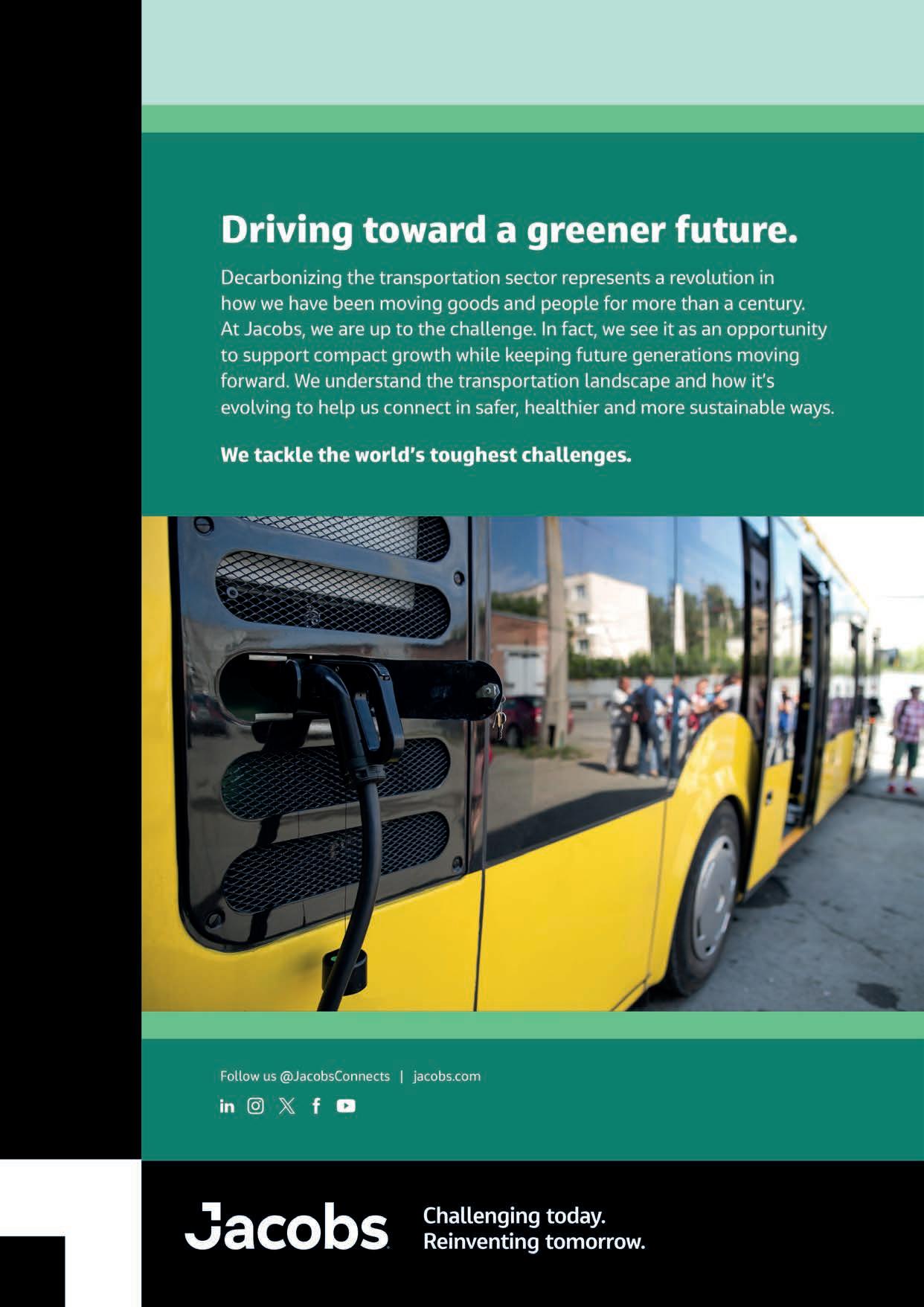













































































































































































































 An Garda Síochána
Ireland’s NaƼonal Police and Security Service
An Garda Síochána
Ireland’s NaƼonal Police and Security Service















































































































 (L-R): J Owen Lewis, IIEA Working Group on Climate and Energy; then-Minister Deirdre Hargey MLA; Minister Eamon Ryan TD; Aoife MacEvilly, CRU; William Walsh, SEAI and Ciarán Galway, eolas Magazine
Brian Ó Gallachóir, UCC addresses the crowd.
Dave Kirwan, Bord Gáis Energy; Nicola McSweeney, Gas Networks Ireland; Klair Neenan, SSE Airtricity; John Reilly, Bord na Móna and Marguerite Sayers, ESB.
Campbell Scott, Virgin Media Ireland; Catherine Lonergan, Bord Gáis Energy and Teresa Purtill, Bord Gáis Energy.
Energy Ireland 2024 crowd.
(L-R): J Owen Lewis, IIEA Working Group on Climate and Energy; then-Minister Deirdre Hargey MLA; Minister Eamon Ryan TD; Aoife MacEvilly, CRU; William Walsh, SEAI and Ciarán Galway, eolas Magazine
Brian Ó Gallachóir, UCC addresses the crowd.
Dave Kirwan, Bord Gáis Energy; Nicola McSweeney, Gas Networks Ireland; Klair Neenan, SSE Airtricity; John Reilly, Bord na Móna and Marguerite Sayers, ESB.
Campbell Scott, Virgin Media Ireland; Catherine Lonergan, Bord Gáis Energy and Teresa Purtill, Bord Gáis Energy.
Energy Ireland 2024 crowd.









 Claire Madden, Bord Gáis Energy; Niamh McGovern, Arthur Cox and Karen Doyle, Gas Networks Ireland.
Jonathan Speers, Dalcour Maclaren asks a question.
Catherine Banet, University of Oslo addresses delegates.
Linda Clarke, Goodbody and Lucy McCauley, KPMG.
Delegates visit the Solarport exhibition stand.
Delegates visit the Mitsubishi Electric exhibition stand.
Daniel Grewan, Mace Consultancy Ireland; Daniel Pineda Ovalle, Mace Consultancy Ireland; and Patrick Liddy, Demand Response Association of Ireland.
Katie Petherbridge, National Gas UK and Harry Molloy, Tynagh Energy.
Calor exhibition stand.
Claire Madden, Bord Gáis Energy; Niamh McGovern, Arthur Cox and Karen Doyle, Gas Networks Ireland.
Jonathan Speers, Dalcour Maclaren asks a question.
Catherine Banet, University of Oslo addresses delegates.
Linda Clarke, Goodbody and Lucy McCauley, KPMG.
Delegates visit the Solarport exhibition stand.
Delegates visit the Mitsubishi Electric exhibition stand.
Daniel Grewan, Mace Consultancy Ireland; Daniel Pineda Ovalle, Mace Consultancy Ireland; and Patrick Liddy, Demand Response Association of Ireland.
Katie Petherbridge, National Gas UK and Harry Molloy, Tynagh Energy.
Calor exhibition stand.










 Credit: Ron Mader
Credit: Ron Mader
 John Doyle, Vice President of Research, Dublin City University
John Doyle, Vice President of Research, Dublin City University





























